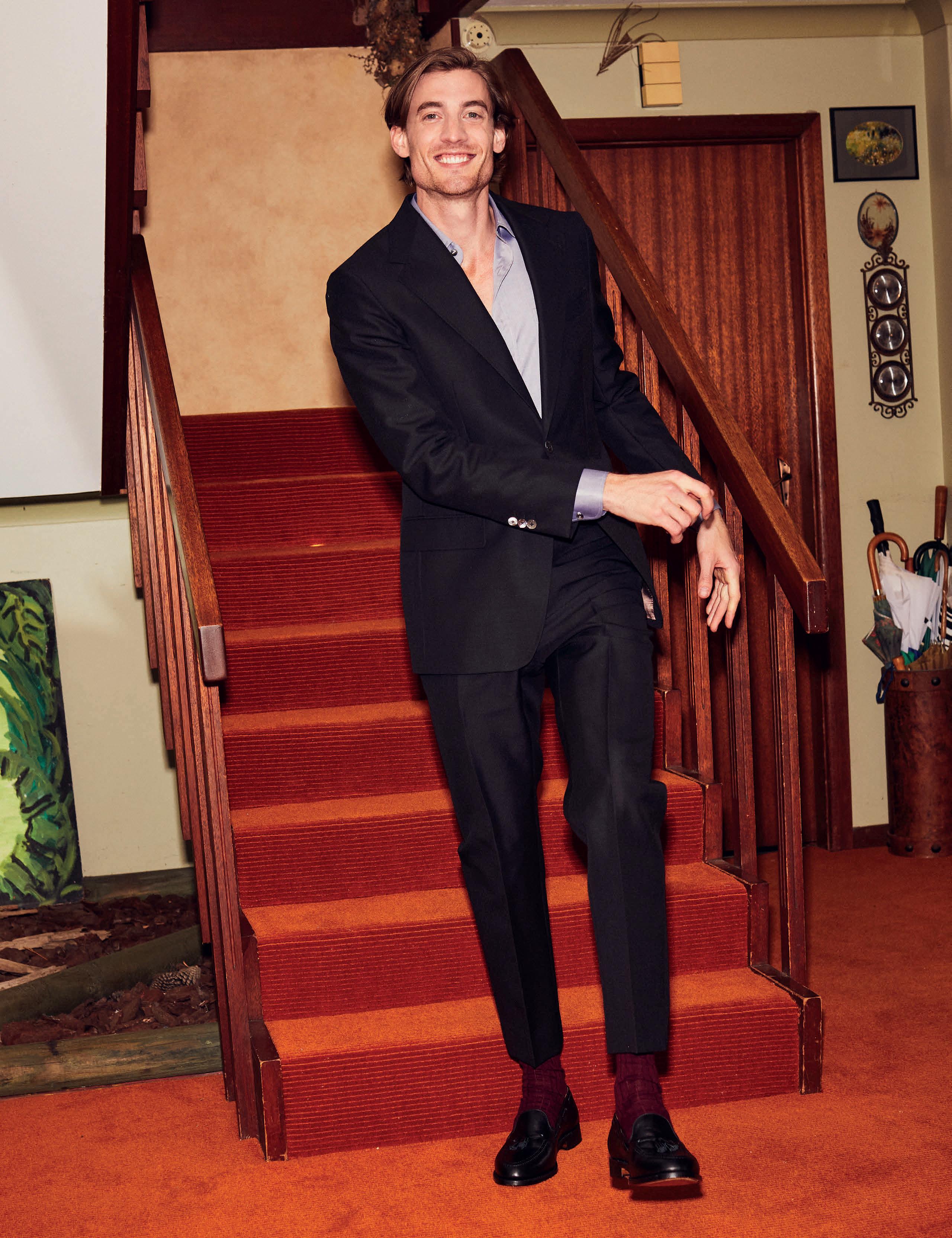THE PRO BONO AWARDS

FITZROY LEGAL SERVICE: THE FIRST SIX MONTHS, 50 YEARS AGO
RECKLESSNESS AND THE CRIMINAL LAW

THE PRO BONO AWARDS

FITZROY LEGAL SERVICE: THE FIRST SIX MONTHS, 50 YEARS AGO
RECKLESSNESS AND THE CRIMINAL LAW
Featuring essays from the Hon Ken Hayne AC KC, Gavin Silbert KC and more
PLUS: All the glitz and glamour of the 2023 Victorian Bar Dinner
If you are one of the many Australian home owners facing the fixed rate cliff this year, it is crucial you prepare now to put yourself in the best position.
As Australia’s only mortgage broking service exclusively for lawyers and barristers, we understand the lending landscape with a specific legal focus and use this expertise to achieve the best solution for you.
Official partner of the Victorian Bar. Members receive $500 cashback at loan settlement.*
(02) 9030 0420


Around Town
2023 Silks Bows Ceremony 10
The generosity of allies: a report 12 from the 2023 Victorian


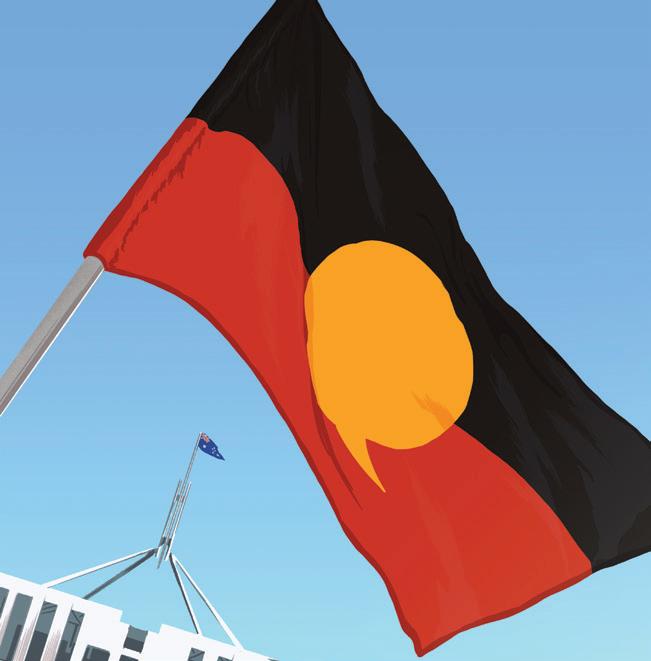


38 The case for KEN HAYNE
42 The case against GAVIN SILBERT
46 The High Court, faith, and the virtue of charity
DANIEL AGHION AND RABEA KHAN
48 Recklessness and the criminal law NICK GADD
50 Surprised by joy: reflections on life as President of the Court of Appeal
MAREE NORTON AND EMMA POOLE
53 The more things change, the more they stay the same
KRISTINE HANSCOMBE
54 Ranitha Gnanarajah: international woman of courage
MEMBERS OF THE OCTOBER 2018 READERS GROUP
56 Fitzroy Legal Service: the first six months, 50 years ago
BENJAMIN LINDNER
Bar Lore
60 Battel acts
ROBERT LARKINS
Back of the Lift
62 Adjourned Sine Die
64 Silence All Stand
67 Gonged!
67 Vale
Boilerplate
74 A Bit About Words
JULIAN BURNSIDE
76 Language Matters
PETER GRAY
78 Music Review
ED HEEREY
82 Restaurant Review
VBN EDITORS
Editors: Banjo McLachlan, Luke Merrick, Maree Norton, Jesse Rudd VBN Committee: Edward Heerey KC, Stephen Warne, Ashlee Cannon, Harry Forrester, Sandip Mukerjea, Joel Silver, Emma Poole, Alexander Di Stefano, Lara O’Rorke, Michael Wyles
Contributors (in alphabetical order): The Hon Paul Anastassiou KC, Elizabeth Bennett SC, His Honour Judge Brookes, Julian Burnside AO KC, Julie Buxton, Alex Campbell, Ashlee Cannon, Terry Casey KC, Georgina Costello KC, Maureen Daly, Julia Frederico, Felicity Fox, Nick Gadd, Sue Gatford, Janine Gleeson, Timothy Goodwin, the Hon Peter Gray AM, Kris Hanscombe KC, Edward Heerey KC, the Hon Ken Hayne AC KC, Rabea Khan, David KelseySugg, Caroline Paterson, Neil Rattray, Jesse Rudd, Robert Larkins, Elle Nikou Madalin, Carly Marcs, Julian Murphy, Maree Norton, Justin O’Bryan, Emma Poole, James Samargis, Gavin Silbert KC, Anna Svenson, Peter Willis SC, Raini Zambelli
Photography/Images (in alphabetical order): Darcy Campbell for Red Crush Media, Eugene Hyland, Felicity Fox, Haim Kadar for Magnet Me, Irene Dowdy for ID Photography, Neil Prieto, Peter Bongiorno
Publisher: Victorian Bar Inc., Level 5, Owen Dixon Chambers East, 205 William Street Melbourne VIC 3000.
Registration No: A 0034304 S
The publication of Victorian Bar News may be cited as (2023) 173 B.N. Opinions expressed are not necessarily those of the Bar Council or the Victorian Bar or of any person other than the author.
Advertising: All enquiries, including requests for advertising rates, to be sent to: Matthew Reddin, Victorian Bar Inc., Level 5, Owen Dixon Chambers East, 205 William St, Melbourne, VIC 3000. Tel: (03) 9225 7111
Email: matthew.reddin@vicbar.com.au
Illustrations, design and production: Guy Shield – guyshield.com
Printed by: Southern Impact – southernimpact. com.au
Contributions: Victorian Bar News welcomes contributions to vbneditors@vicbar.com.au

As long time readers, first time editors of Victorian Bar News—some with experience on the Bar News committee, some without— we are delighted and a little nervous to take on the legacy of editors who have gone before us. And to do so at an interesting time in the life of our Bar, and our nation.
Unsurprisingly, the calling of a referendum on Indigenous recognition in the Constitution—the 45th referendum since Federation and the first in over 20 years—has sparked strong and divergent views within the Bar. We are a community of professional arguers, after all. By the time this issue is published, we will all have had an opportunity to vote in a poll as to whether or not the Bar should formally support the proposed constitutional amendment. Debate on the appropriateness of doing so has featured in the mainstream media, at times in a way that may have made members on both sides of the debate feel at odds with colleagues, despite close working relationships and friendships.
Within these pages you will find articles exploring and recording debate on the proposed amendment of our Constitution. We begin with a piece prepared by members of the Indigenous Justice Committee, reflecting on the nature of the Constitution generally— as both a “compromise” and a “blueprint for the good life”—and the road that has led Australia to consider this particular constitutional amendment. Next, two prominent
members of our Bar have taken the time to explain the reasons they will be voting “yes”, in the case of the Hon Ken Hayne KC, or “no”, in Gavin Silbert KC’s case.
We don’t pretend that these articles represent the full range of views on the subject, however we hope that they fairly reflect many of the key arguments and considerations on either side of the debate. We ask that you read these pieces in the spirit in which they are intended: as a contribution to an important constitutional debate of our time. The coverage offers each of us an opportunity to gain a better understanding, not only of our own position on the Voice, but also of why some friends and colleagues might cast a different vote on polling day.
This edition of Bar News also celebrates the ways in which we have come together, as colleagues, friends, and as part of our broader community. We feature an article on the Criminal Bar Association conference, at which members mixed gin with discussions on important developments in criminal law, and the need for positive strategies for dealing with vicarious trauma.
International Women’s Day provided an ideal occasion for the unveiling of two new portraits—of the Hon Justices Kenny and McMillan—in the Peter O’Callaghan Portrait Gallery. On 4 May, 48 new barristers joined our ranks; they introduce themselves in our Readers’ Digest piece. Most recently, on 26 May, we came together for a night of chatter and taffeta at the annual Bar Dinner.
As we welcome the appointment of Chief Justice Mortimer to the Federal Court, we also feature a profile on recently retired President of the Court of Appeal, the Hon Chris Maxwell, who again highlights the importance of collaboration and collegiality. And see Carly Marcs’ piece about how a few emails to members of the Bar and Bench helped to raise over $34,000 for Giant Steps, a specialist school for
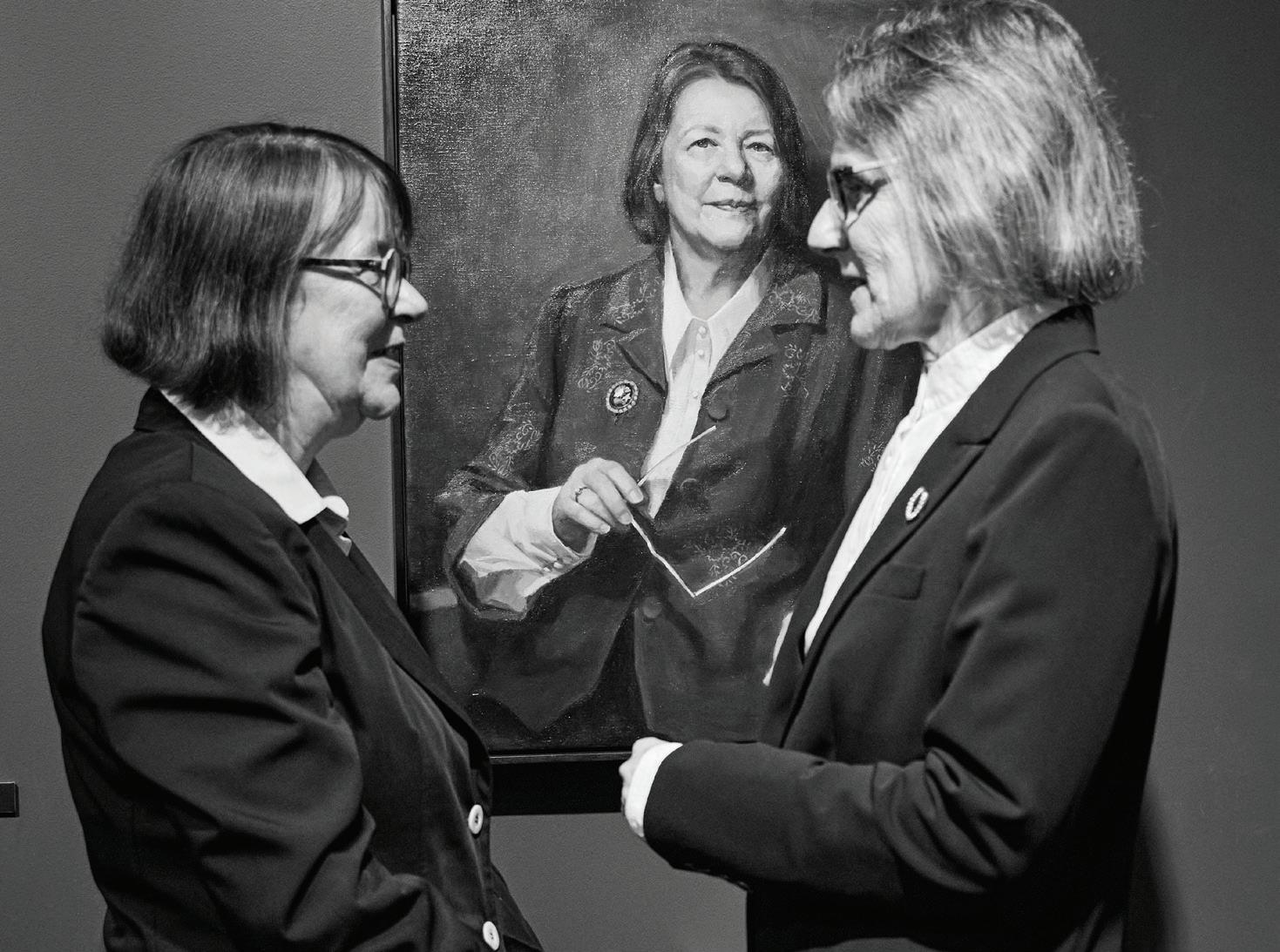
International Women’s Day provided an ideal occasion for the unveiling of two new portraits—of Justices Kenny and McMillan—in the Peter O’Callaghan Portrait Gallery.
children on the autism spectrum.
As usual, members have been generous in providing diverse and thought-provoking pieces for publication. We encourage you to take the time to read a piece written by Daniel Aghion KC and Rabea Khan about a recent High Court decision in which religious concepts of charity and equity, “tzedakah” and “zakah” featured in Justice Edelman’s consideration of the administrative law concept of legal unreasonableness. And don’t miss Robert Larkins’ piece on the (surprisingly recent) history of trial by battle. Regular contributors, the Hon Peter Gray and Julian Burnside KC, have provided pieces on matters dear to many of us: grammar and (leading and non-leading) questions.
Recognising the vice of all work and no play, Ed Heerey KC’s music review challenges us to listen to some new music this winter, and provides his tips on artists worth checking out. And in a throwback to journalism of days gone by, we eds offer up a review of Marion following a recent “working lunch”
at that fine Fitzroy establishment.
Thanks to all those who have contributed to this issue, including the Committee and Bar Office staff who have worked hard to bring it to you. Thanks in particular to Sharni Doherty, whose assistance has been invaluable. Like us, Sharni and many other members of the team are new to the role. We thank all involved for their patience as we learn the ropes. Special thanks must go to our professional contributors, Guy Shield and Peter Barrett, without whom this publication might well be printed and stapled on a BCL printer, with emojis and pixelated photos featuring heavily on the front and back covers, and unformatted text in between. It takes a village.
PS Readers might note the absence of regular features of Bar News, such as Letters to the Editors and the quotable quotes of Verbatim; unfortunately our inbox has been starved of such content of late. Please do write to us in the coming months if you have feedback on this edition or access to a choice piece of transcript: vbneditors@vicbar.com.au.
SAM HAY
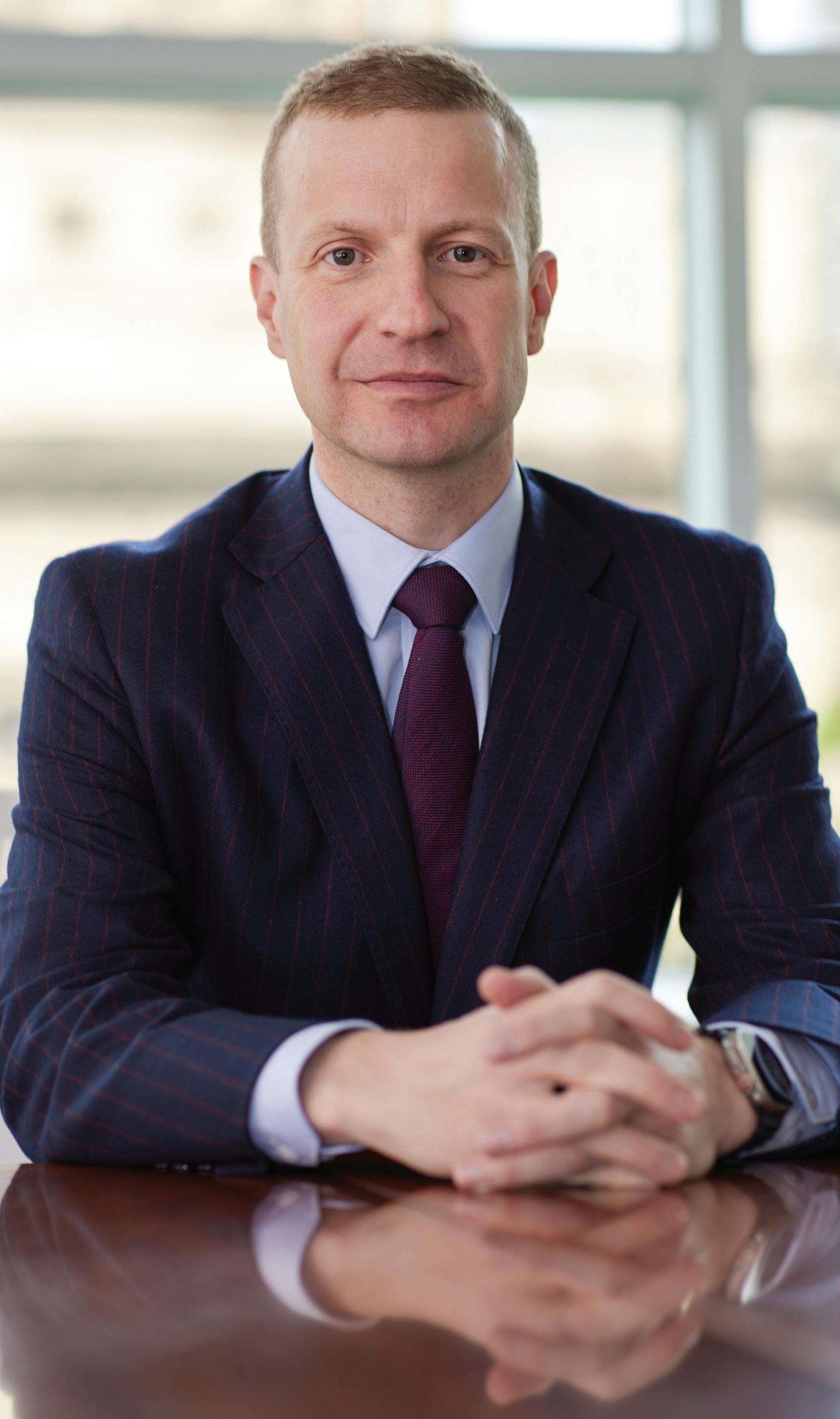
As predicted in the last issue of VBN, since I took on the role of President in November, things have been busy. At times, they have been quite intense. I wanted to take this opportunity to express a few thoughts about our college that have occurred to me over the last six months.
First, we are a group of highly intelligent, articulate and motivated people. As you would expect, there are many different views held at the Bar. Many members hold their views passionately and they are not at all afraid to express them. From a Bar Council perspective, that can be challenging at times, but there is no doubt it should be celebrated. Despite the stereotypes that can easily be called to mind, we are far from a group of homogenous conformists. Whatever may have been the case 50 years ago, there is real diversity of thought amongst our current membership.
Second, those differences of opinion can lead to lots of disagreements. Just as in the community, some of those disagreements run deep. However, despite some people speaking at times in overbroad and apparently uncompromising terms, we always find our point of equilibrium. Some issues take time to resolve, but they do resolve, and we move on to the next thing.
Third, despite the frequency and fervour of some of our debates, there is almost always present a core level of respect between those on opposite sides of an argument. Some members disagree with
the way in which others go about things, or with what has been said or done in the heat of a debate, but in almost all cases that core level of respect for one’s fellow member of counsel remains.
Fourth, we have both formal and informal mechanisms for deescalating disputes amongst our 2,200 practising members. Those mechanisms no doubt exist in most complex organisations. However, to my observation at least, our Bar seems to be particularly adroit at deploying just the right mechanism— and just the right people—to resolve internal tensions. That is no doubt because we are an association of professional problem solvers. Nonetheless, it is worth noting that we seem to be particularly good at maintaining our fundamental unity. Come what may, we hold together.
Fifth, the media and the public seem to be very interested in our
We remain one of the strongest Bars in Australia, and we remain the first choice for practitioners who have talent but limited means who want to come to the Bar and make a go of it.
internal goings on. I suppose that is to be expected given the important role we play in civil society. In light of this reality, to my mind at least, it is always best if we try to resolve our differences internally, out of the media spotlight. In fact, that is almost always how things are resolved. That is not to say that there is never a role for members to engage with the media, particularly on important matters. There is certainly a place for that. There is, however, much to be said for picking up the phone to air differences directly with fellow barristers when the need arises. That approach is much more likely to keep things within bounds and preserve and enhance relationships upon which our college is based.
Finally, when considering all of this, I think it is important to remember that the Victorian Bar is much bigger than any single one of us, or any small group of us. A review of our history reveals that we have weathered many controversies of a variety of different types for over 180 years. We are still together, we remain one of the strongest Bars in Australia, and we remain the first choice for practitioners who have talent but limited means who want to come to the Bar and make a go of it. That is all worth celebrating. And it is worth continuing to do the necessary work to resolve our differences in our idiosyncratic but ultimately very effective way.
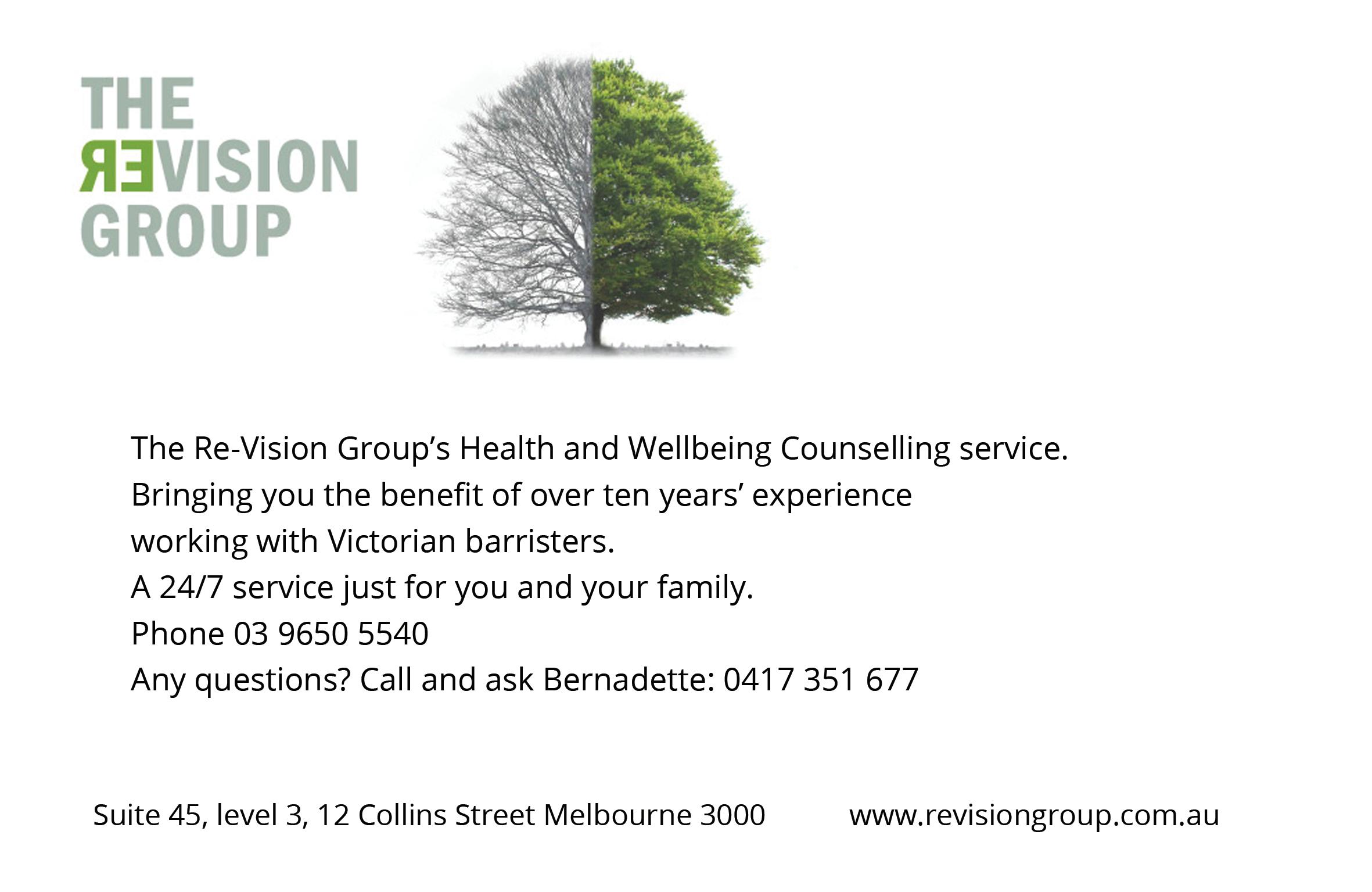
Favourite fictional lawyer?
Lionel Hutz, for being a perfectly cromulent lawyer.
Historical case you would like to have argued?
Jarndyce v Jarndyce (or real-life equivalent Jennens v Jennens), for a lifetime of reliable work.
Best piece of advice you learnt in the readers’ course? Submissions should convince the reader through the use of nouns, not adjectives.
Reading with?
Andrew Meagher. Ultimate career goal as a barrister?
Uphold the proper administration of justice, finally stop renting (not necessarily in that order).
Favourite fictional lawyer?
Annalise Keating (How to Get Away with Murder). A fierce and multifaceted character who leaves a lasting impact.
Historical case you would like to have argued?
Al-Kateb v Godwin: no person seeking asylum should be indefinitely detained.
Best piece of advice you learnt in the readers’ course?
Where appropriate, get in and then out quick with your cross-examination.
Reading with?
Shivani Pillai.
Ultimate career goal as a barrister?
At this point, I don’t really have one. I am riding with the waves.
Favourite fictional lawyer?
Hannah Stern from The Split. What a woman. What a show.
Historical case you would like to have argued?
CBA v Amadio (1983). Interesting case particularly given where we are with banking regulation and unconscionable conduct 40 years later.
Best piece of advice you learnt in the readers’ course?
Justice Stynes’ three Ps: Preparation, Perseverance and Personality.
Reading with?
The wonderful
Naomi Hodgson. Ultimate career goal as a barrister?
Fulfilling work alongside great people.
Each edition, we reach out to the latest cohort of readers to get to know them better
Favourite fictional lawyer?
Lizzie Bennet re-cast as an aspiring barrister in Pride and Premeditation (a trashy and delicious read as long as you’re not too precious about Jane Austen).
Historical case you would like to have argued?
I wouldn’t attempt to argue any historical case just yet!
But I would love to have been able to attend some of the famous negligence cases to watch that law being made.
Best piece of advice you learnt in the readers’ course?
Jim Peters’ advice to “stay calm in the tempest of disaster and solve the problem”.
Reading with?
Patrick Over.
Ultimate career goal as a barrister?
To nerd out on the law and then spend school holidays with my family.
Favourite fictional lawyer?
Gomez Addams from The Addams Family. He doesn’t talk about his job.
Historical case you would like to have argued?
The prosecution of The Angry Penguins for the Ern Malley hoax.
Best piece of advice you learnt in the readers’ course?
Always write down your legal argument by hand. Reading with?
Leana Papaelia.
Ultimate career goal as a barrister?
Make the law less incomprehensible to those who need to understand it most.
Favourite fictional lawyer?
Elsbeth Tascione from The Good Wife—strategic, underrated, and funny.
Historical case you would like to have argued?
The Diesel Williams Court of Appeal case—to try and right a historical wrong.
Best piece of advice you learnt in the readers’ course?
Work-life balance is key— barrister code for “try and only work six days a week”.
Reading with?
Tom Smyth.
Ultimate career goal as a barrister?
Do interesting work with interesting people and get paid well for it.
Favourite fictional lawyer?
Betty Anne Waters from Conviction (even though it’s based on a true story…).
Historical case you would like to have argued?
Somerset v Stewart (1772) 98
ER 499: what a precedent to be involved in setting?!
Best piece of advice you learnt in the readers’ course?
That this is the best job we’ll ever have.
Reading with?
Gabi Crafti (I know, I’m very lucky!).
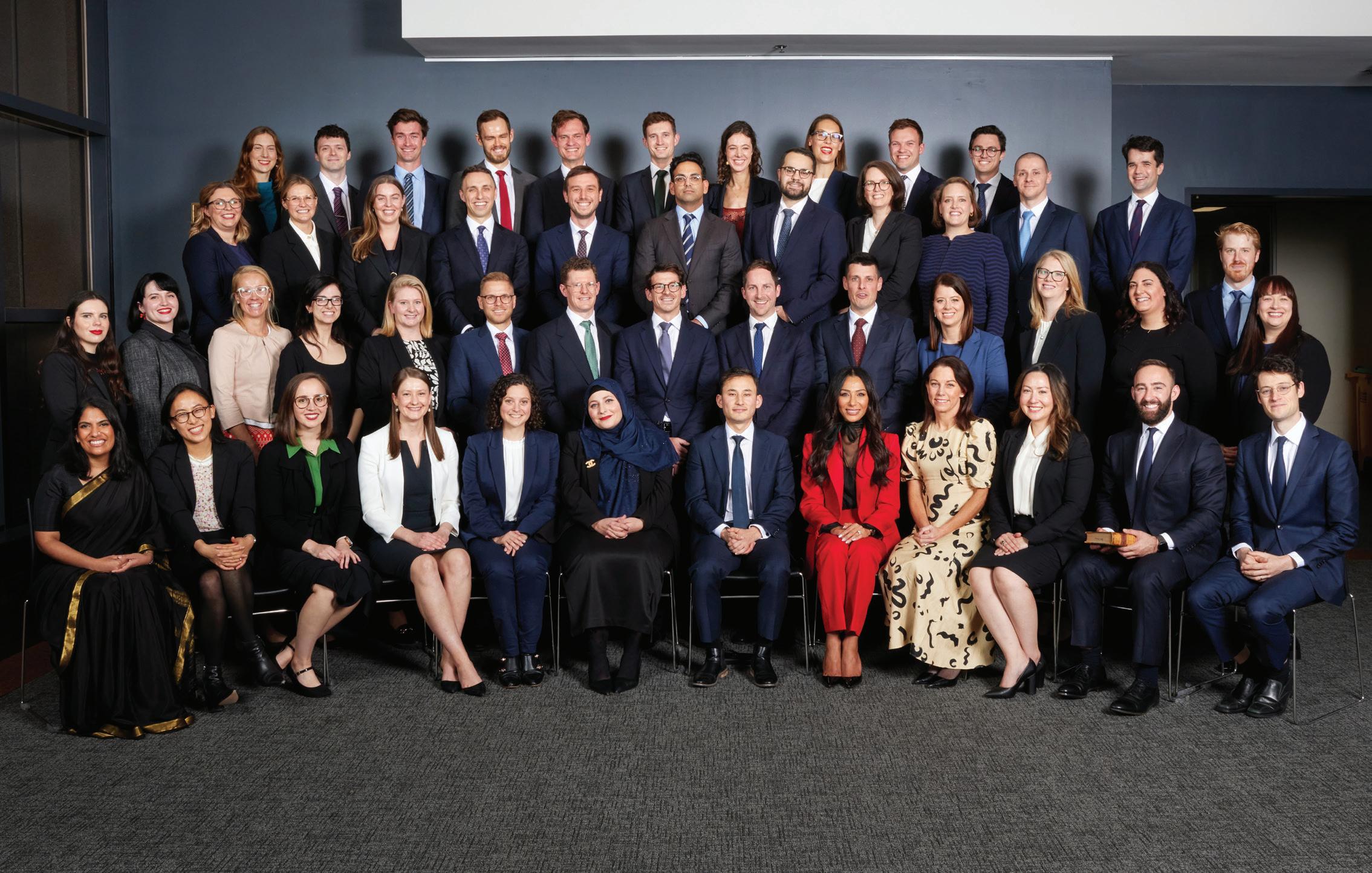
Ultimate career goal as a barrister?
To do what I love and make the world a bit brighter in the process.
Favourite fictional lawyer?
Lieutenant Daniel Kaffee because I love the movie!
[A Few Good Men.]
Historical case you would like to have argued?
Waltons Stores (Interstate)
Ltd v Maher because it was the first case that I read at university which created a sense of curiosity and love of case law.
Best piece of advice you learnt in the readers’ course?
The lows are never as low, and the highs are never as high.
Reading with?
Kane Loxley.
Ultimate career goal as a barrister?
Make it through the first year.
Favourite fictional lawyer?
Jackie Chiles [Seinfeld].
Historical case you would like to have argued?
Marbury v Madison for its unmatched constitutional significance and high stakes political drama.
Best piece of advice you learnt in the readers’ course?
Preparation, preparation, preparation.
Reading with?
Paul Liondas.
Ultimate career goal as a barrister?
Some combination of satisfaction and competence.
Blashki
Favourite fictional lawyer?
Dennis Denuto— it’s the vibe!
Historical case you would like to have argued?
I would have loved to work with my grandfather, Ron Castan, on the Mabo case.
Best piece of advice you learnt in the readers’ course?
Treat everyone with respect and kindness—it’s a small world.
Reading with?
Damien McAloon, a generous and inspiring mentor.
Ultimate career goal as a barrister?
To contribute to the great institution of the Victorian Bar throughout a long and fulfilling career.
Favourite fictional lawyer?
Gerri Kellman [Succession]. Historical case you would like to have argued?
Whatever dispute caused section 8(c) of the Summary Offences Act 1966 (Vic) to be enacted (criminalising the driving of a goat harnessed to a vehicle through a public place).
Best piece of advice you learnt in the readers’ course? Being a witness is far more terrifying than being a barrister (even in a moot).
Reading with?
Andrew de Wijn. Ultimate career goal as a barrister?
To have many leatherbound books and for my chambers to smell of rich mahogany.
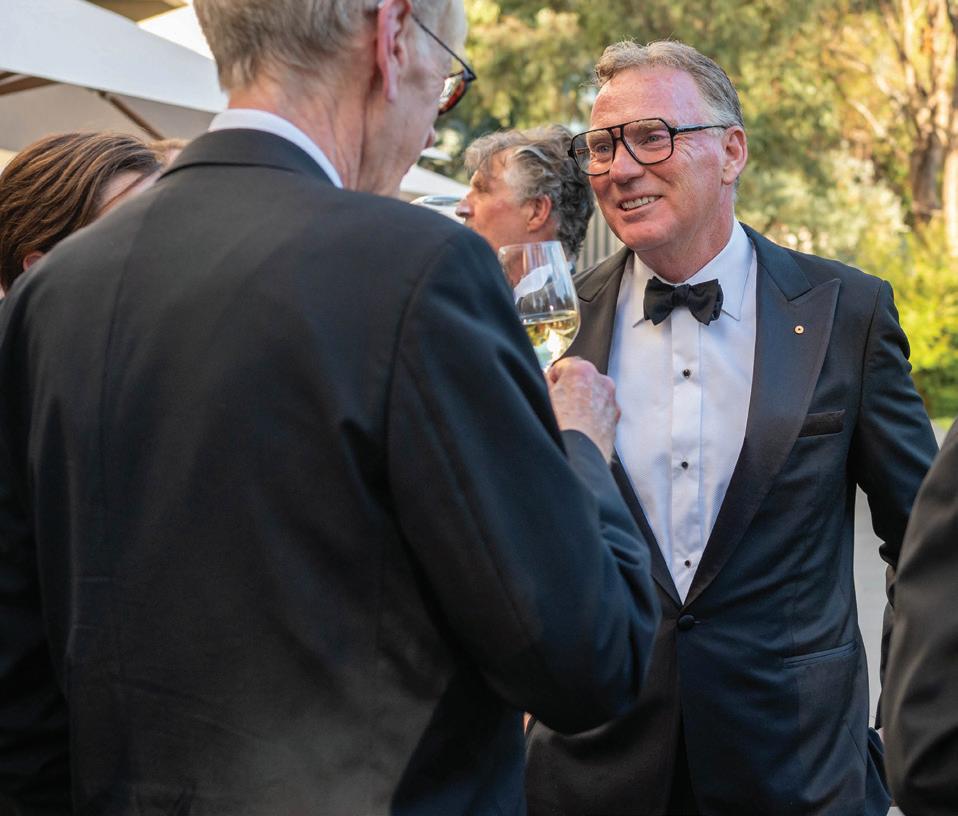

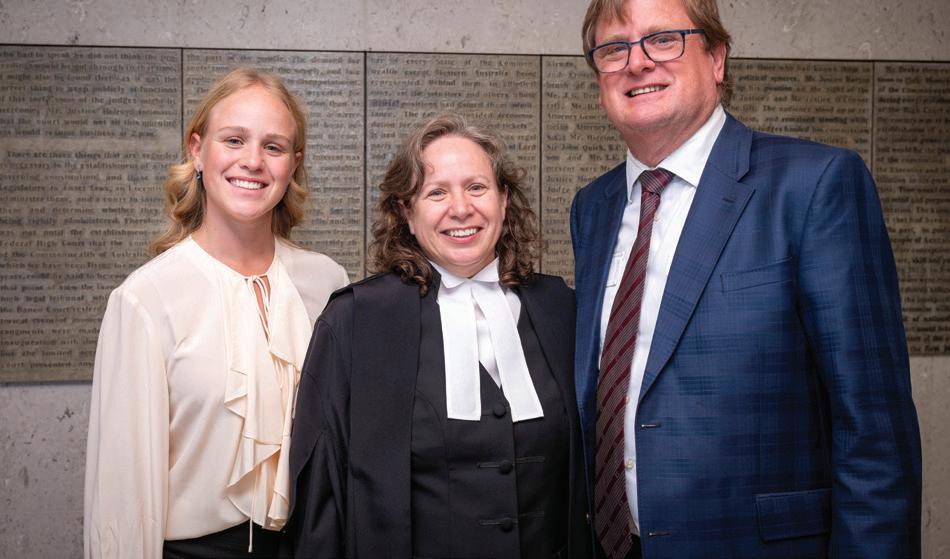
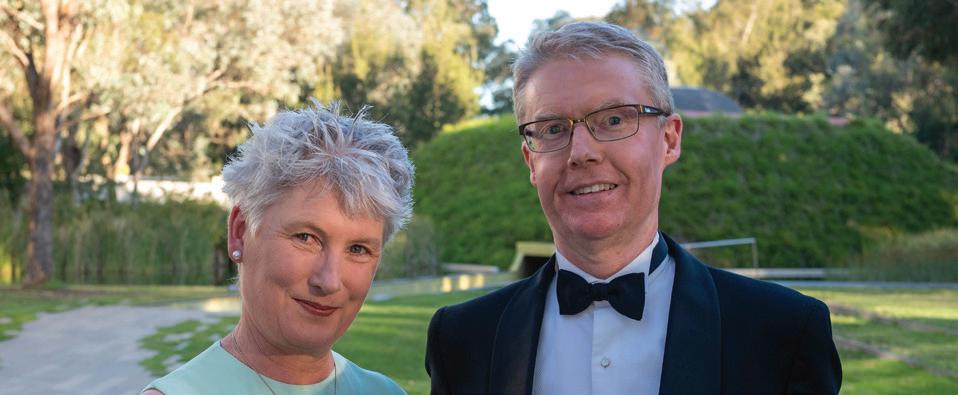
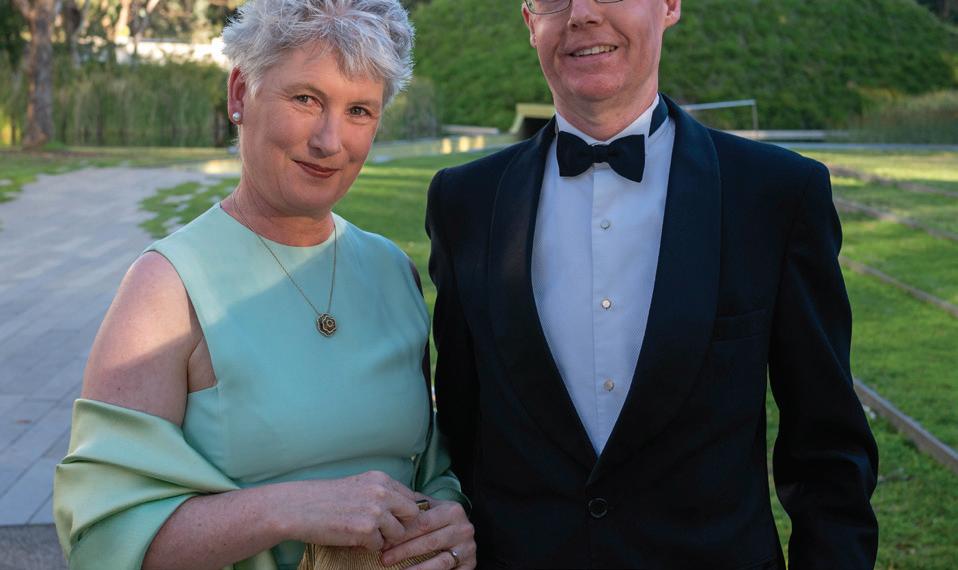
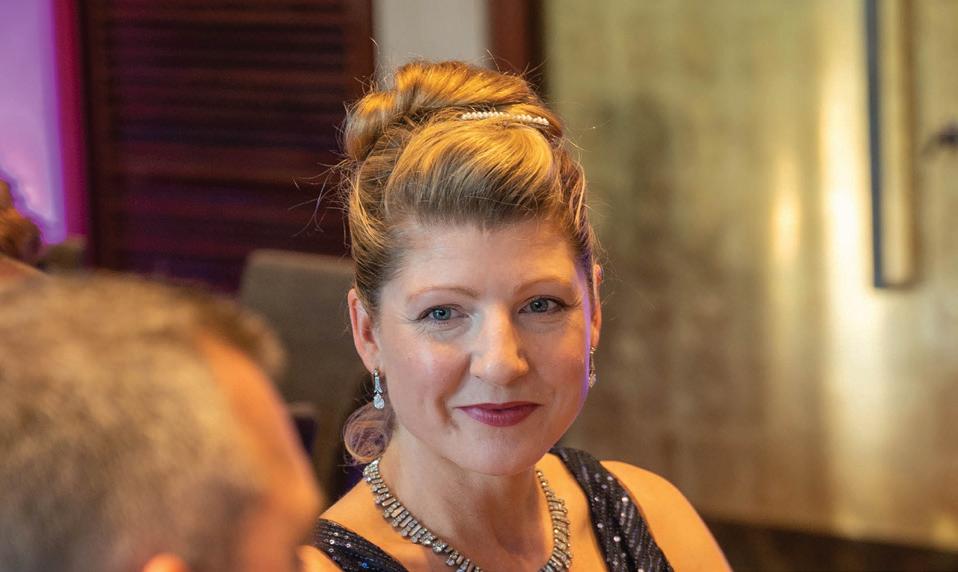
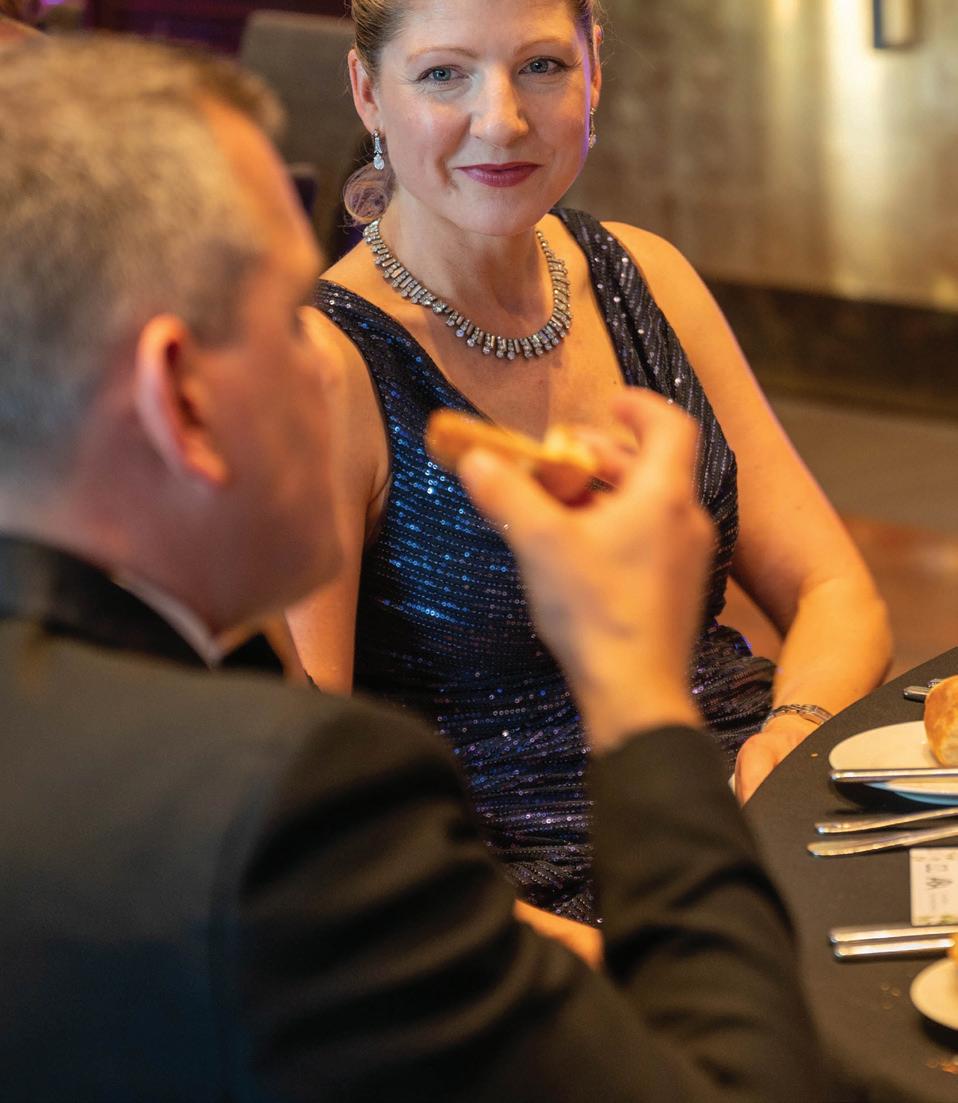
Our newest silks attended the Silks Bows Ceremony at the High Court in Canberra on 6 February 2023. Mark Costello SC gave the keynote address on behalf of the all-new silks and the Hon Chief Justice Kiefel AC addressed the new silks in response.
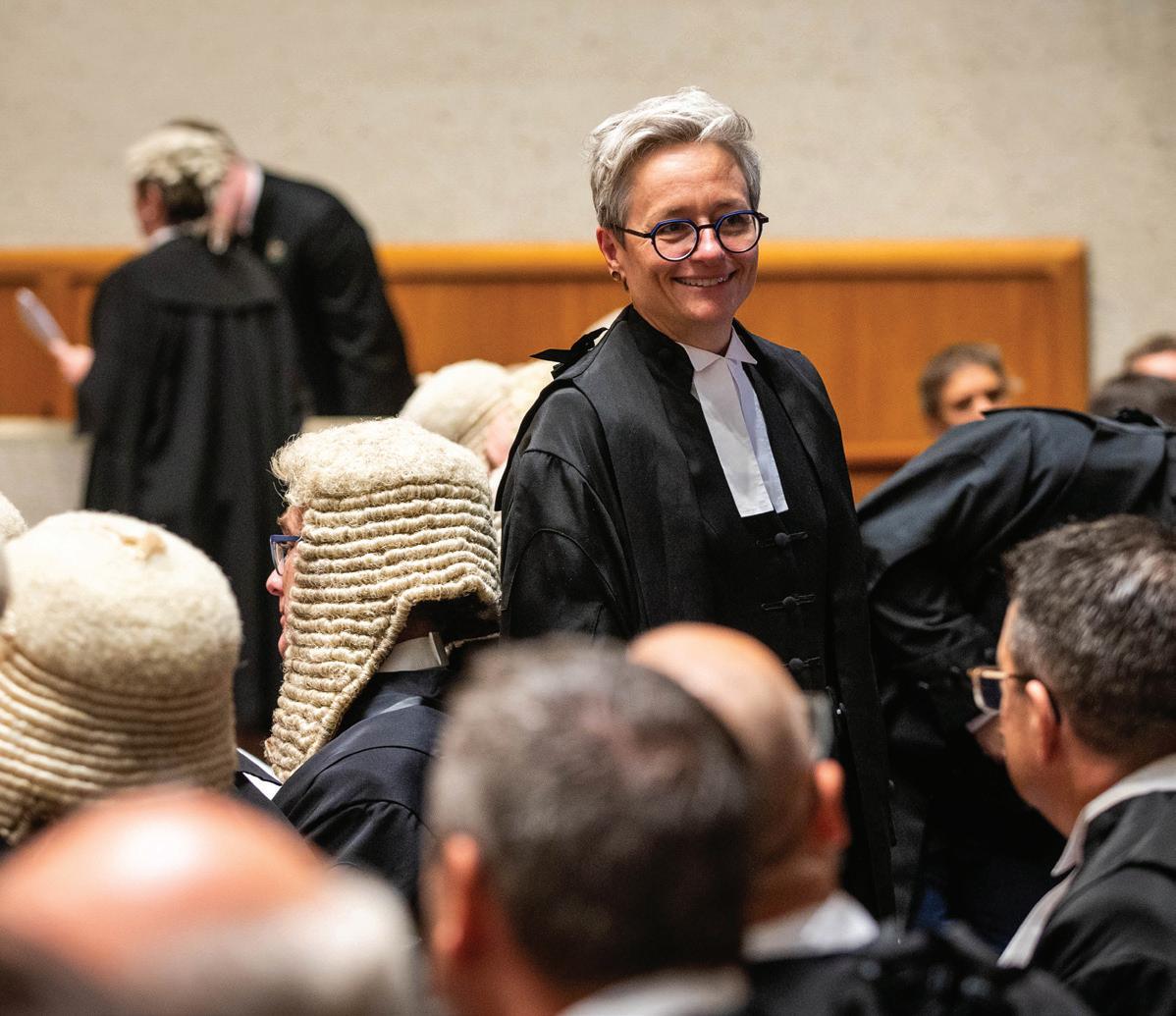
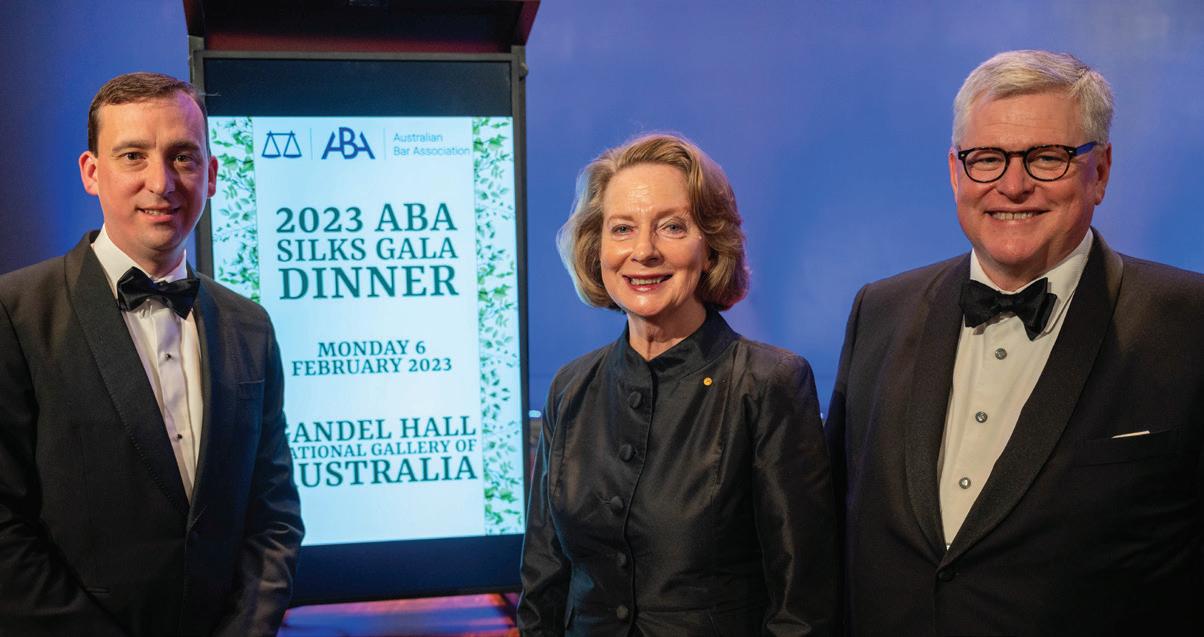
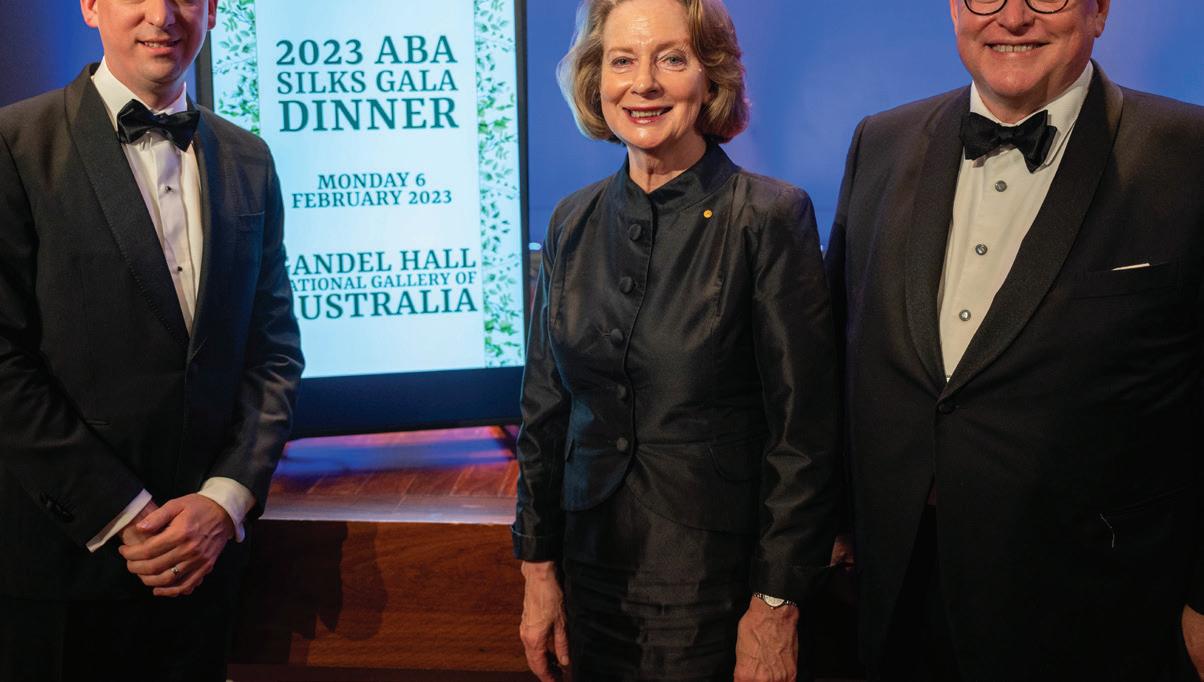




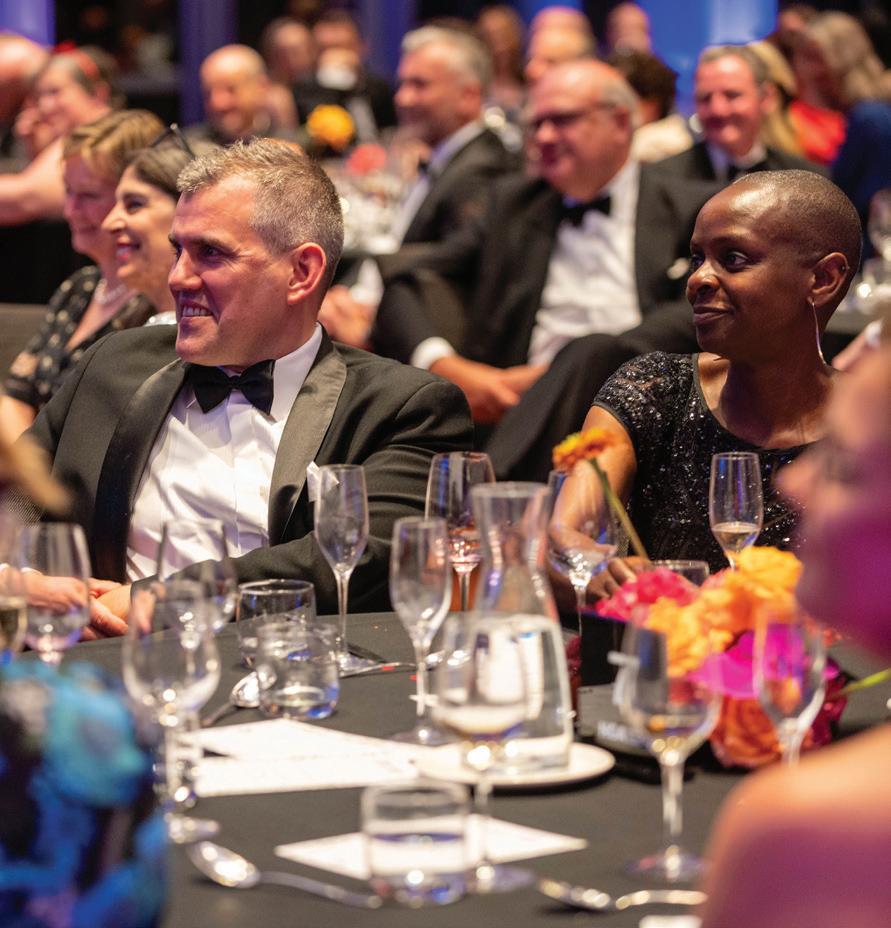
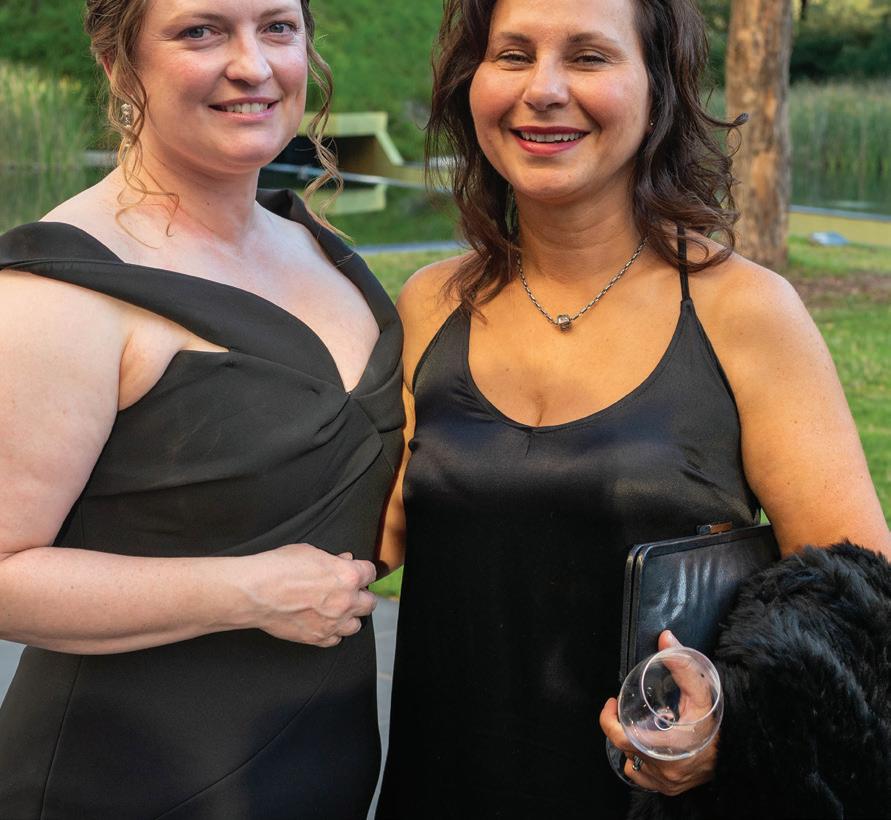

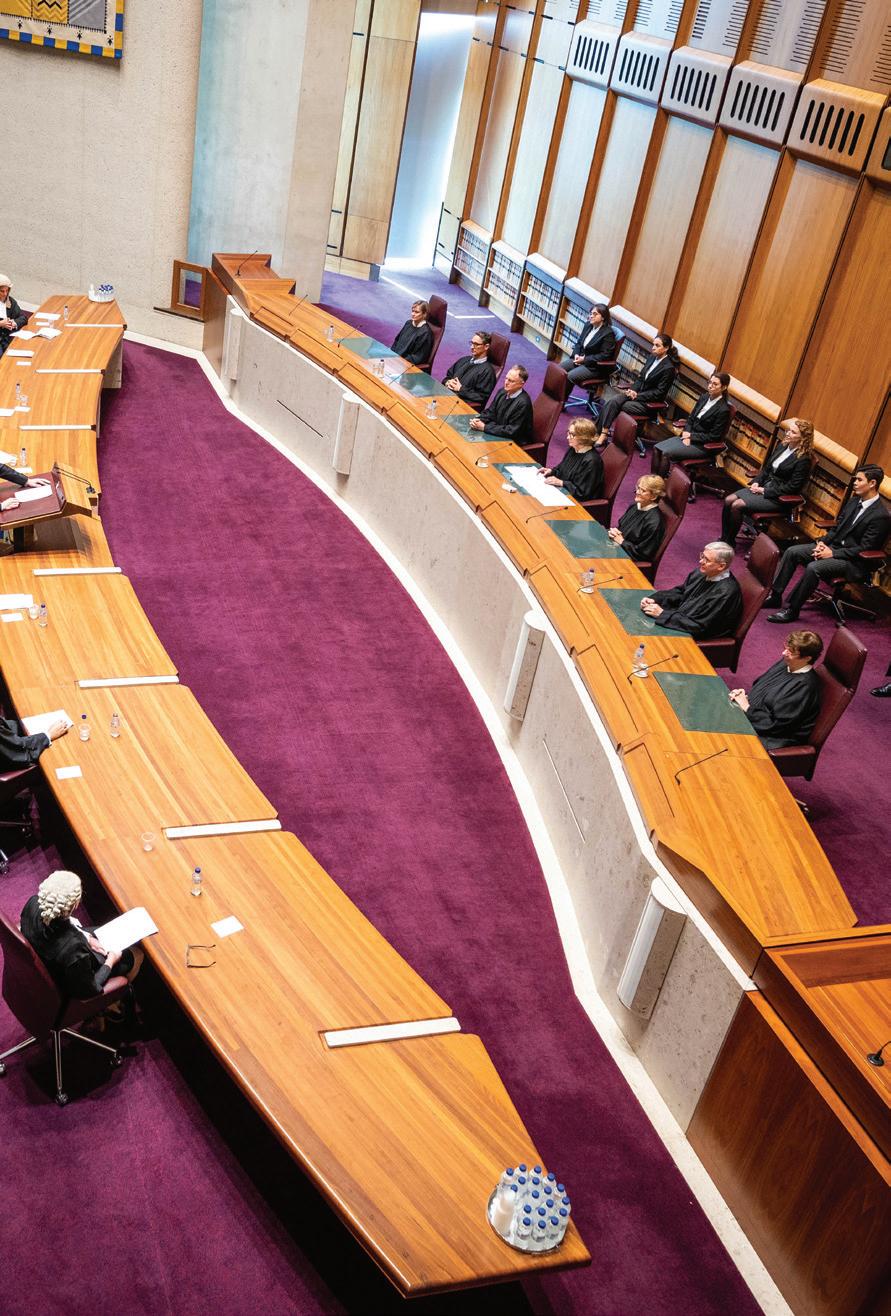
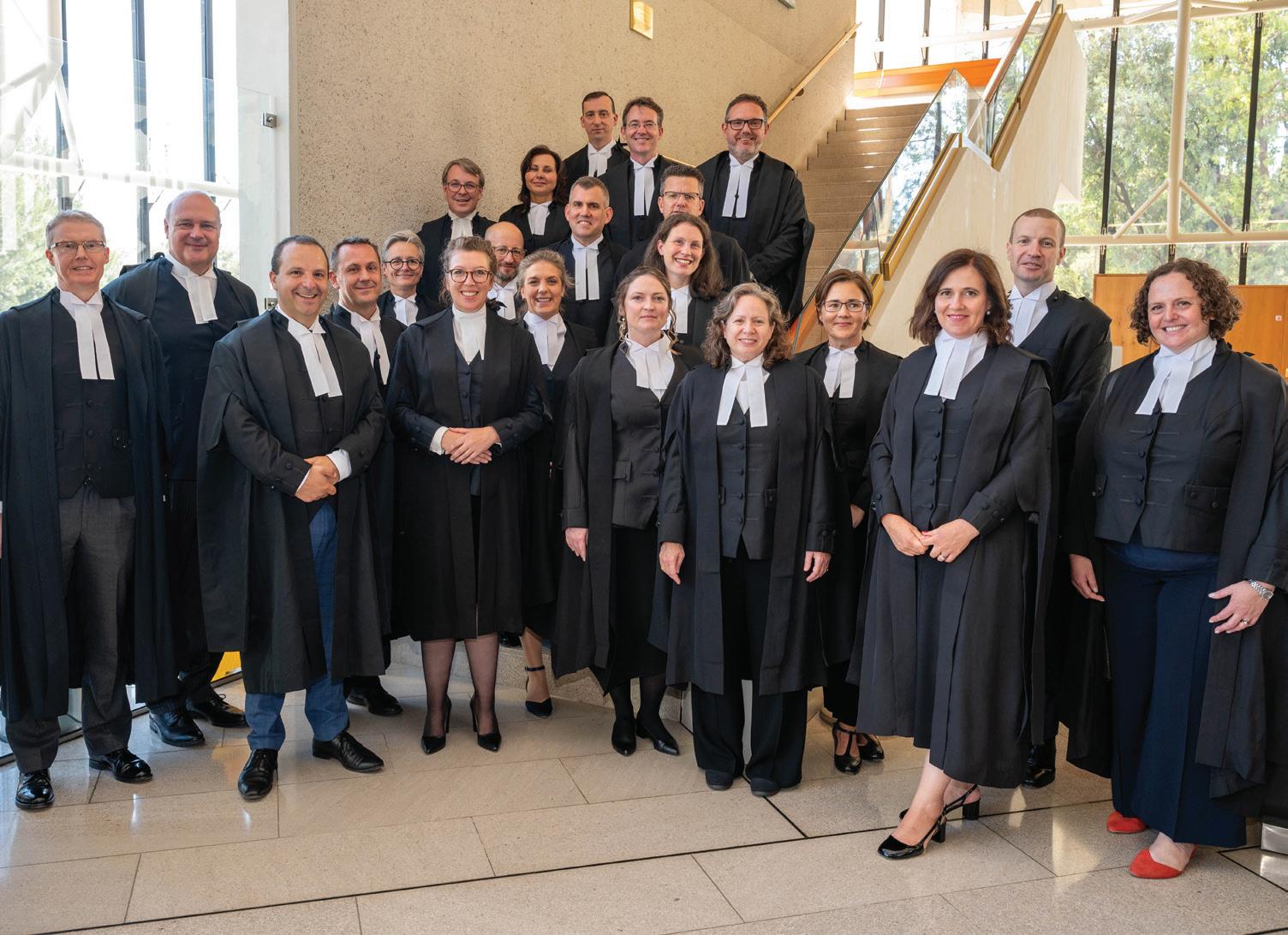
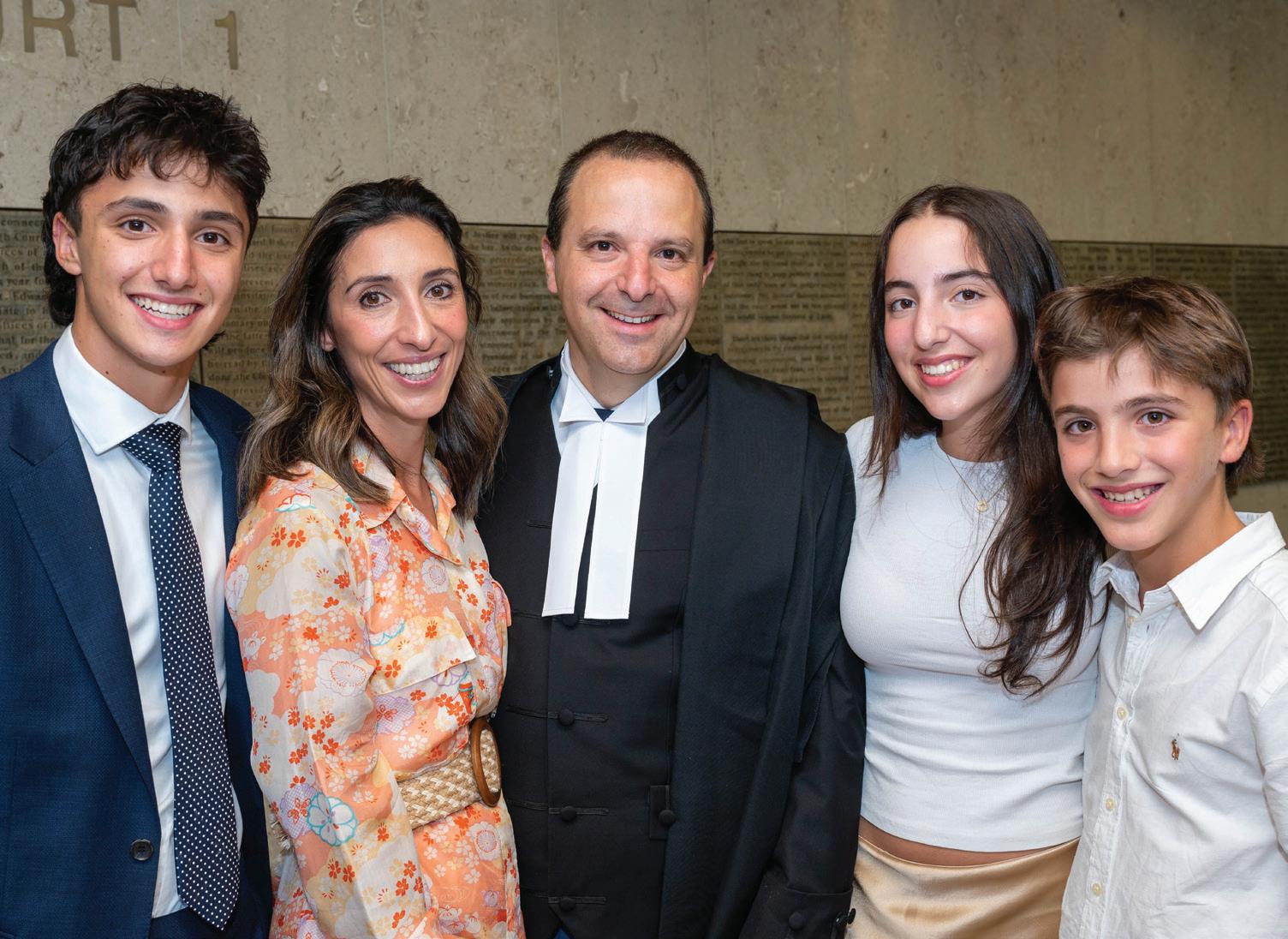

DAVID KELSEY-SUGG AND ALEXANDER CAMPBELL
The Bar’s biennial Pro Bono Awards were announced on 21 March 2023 at a very well attended event in the Peter O’Callaghan QC Gallery. Guests and award nominees were met with a warm welcome by the chair of the pro bono committee, Matthew Harvey KC, who singled out for praise the efforts of committee members Chris Lum and Laura Hilly in organising the event. The awards recognise the contribution of members of the Victorian Bar who provide pro bono assistance through the Bar’s Pro Bono Scheme (administered by Justice Connect), the Court Schemes, community involvement and individual commitment.
Justice Kristen Walker of the Court of Appeal gave a well-received speech celebrating the pro bono work performed by members of our Bar. Her Honour highlighted the rewards of pro bono work: the opportunity to help those in need; the chance to broaden one’s skills and knowledge; possible enhancement of a barrister’s reputation and visibility within
the legal community; personal fulfilment and satisfaction; and sometimes a “pleasant and unexpected” income bump. Her Honour also paused to reflect on the challenges that can attend pro bono work, observing:
… many of you will undertake pro bono work for a group of which you are a member: indigenous people, people with disabilities, or the LGBTQI community, for example.
The emotional weight of taking on such work can be much greater than in the context of other work, and the psychological toll can be significant. It is important in such contexts to pay attention to your own wellbeing.
And this is also a reason why it is important that it is not always, or only, the members of such groups who undertake such work. The generosity of allies is significant, and I want to acknowledge everyone here who has undertaken pro bono work in this manner. Thank you.
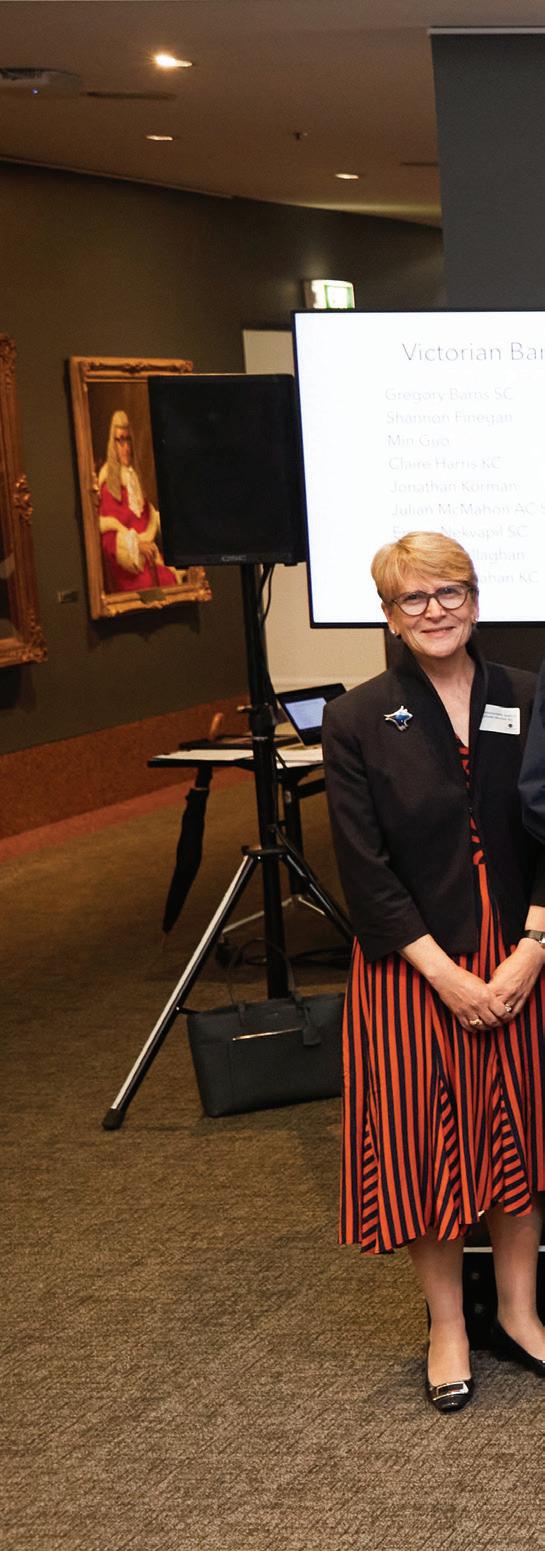
Among the award presenters were distinguished guests including Justices Gordon and Steward of the High Court, Justice (now Chief Justice) Mortimer of the Federal Court, Chief Justice Alstergren of the Federal Circuit and Family Court, Justice Croucher of the Supreme Court, President of the Victorian Bar, Sam Hay KC, Ron Merkel KC and Uncle Jim Berg. Uncle Jim Berg, an Elder of the Gunditjmara people of South-Western Victoria, presented the eponymous award “for outstanding pro bono advice or advocacy that enhances access to justice for First Nations clients either nationally or in Victoria” to Tim Farhall. Tim has acted in numerous pro bono matters for First Nations clients, including discrimination matters and matters arising out of deaths in custody. He has also advised community legal centres and non-government organisations on issues affecting First Nations people. The depth and breadth of Tim’s pro bono work are impressive.
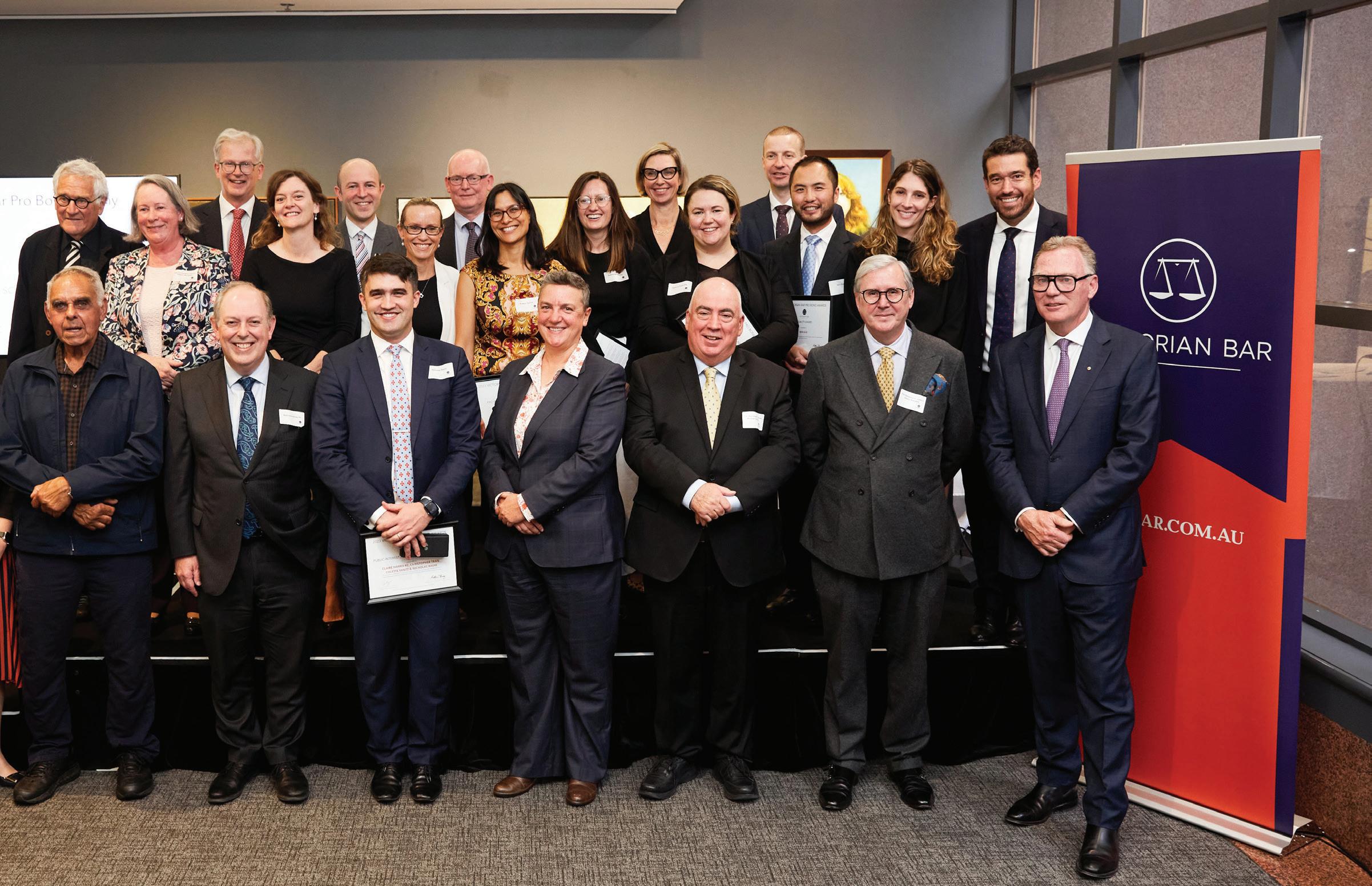
Ron Merkel KC presented the award named in his honour to Juliet Forsyth SC, for her outstanding work in a lengthy and complex rehearing in the Queensland Land Court, on behalf of a landowner group who objected to the expansion of a coal mine in the Darling Downs. In presenting the award, Ron reminded those in attendance that his master was none other than Neil Forsyth QC, Juliet’s father. With a smile, Ron hinted that some things perhaps were meant to be.
The 2023 Victorian Bar Pro Bono Trophy was awarded to Julian McMahon SC in recognition of his longstanding commitment to pro bono service. Julian’s pro bono record would be known to many. He has acted recently for Australians facing the death penalty overseas and for Fitzroy Legal Service at the coronial inquest into the death in custody of Veronica Nelson, a Gunditjmara, Dja Dja Wurrung, Wiradjuri and Yorta Yorta woman.
Julian’s efforts also ensured rigorous and thorough representation of the Parumpurru Committee of the Yuendumu Community at the coronial inquest into the fatal
shooting of Kumanjayi Walker. It was fitting that the trophy was presented to Julian by 2021 winner Matthew Albert, himself a winner of this year’s Pro Bono Team Excellence Award.
True to form, Julian first thanked and congratulated everybody else. Reflecting on the volume of pro bono work undertaken at the Victorian Bar, he observed, “it makes you feel pleased, if not delighted, to be a member of a Bar that is quietly doing [so much pro bono work] … It’s an honour to be named among so many people who have done such extraordinary things”.
There is a long history of members of the Victorian Bar acting pro bono. All members of our Bar who undertake pro bono work, including those who won or were nominated for an award in 2023, deserve to be congratulated. It is not only litigants who appreciate the assistance of pro bono counsel. To return to the words of Justice Walker, legal representation enhances the quality of the arguments that are put, and this is of great assistance to courts and other decision-makers.
The winners of the 2023 Pro Bono Awards were:
» The Victorian Bar Pro Bono Trophy –Julian McMahon AC SC
» The Daniel Pollak Readers Award –Katharine Brown
» The Ron Castan AM QC Award –Tim Jeffrie
» The Susan Crennan AC KC Award –Alison Umbers
» The Ron Merkel KC Award –Juliet Forsyth SC
» The Public Interest / Justice Innovation Award – Claire Harris KC, Christopher Tran, Colette Mintz and Nicholas Baum
» The Debbie Mortimer SC Award –Gemma Cafarella
» The Uncle Jim Berg Award –Tim Farhall
» The Equality Award – Min Guo
» The Pro Bono Team Excellence Award –Peter Willis SC, Matthew Albert, Angel Aleksov and Evelyn Tadros
Descriptions of the work done by the winners, and a full list of those nominated for the 2023 awards, are available on the Victorian Bar’s website.
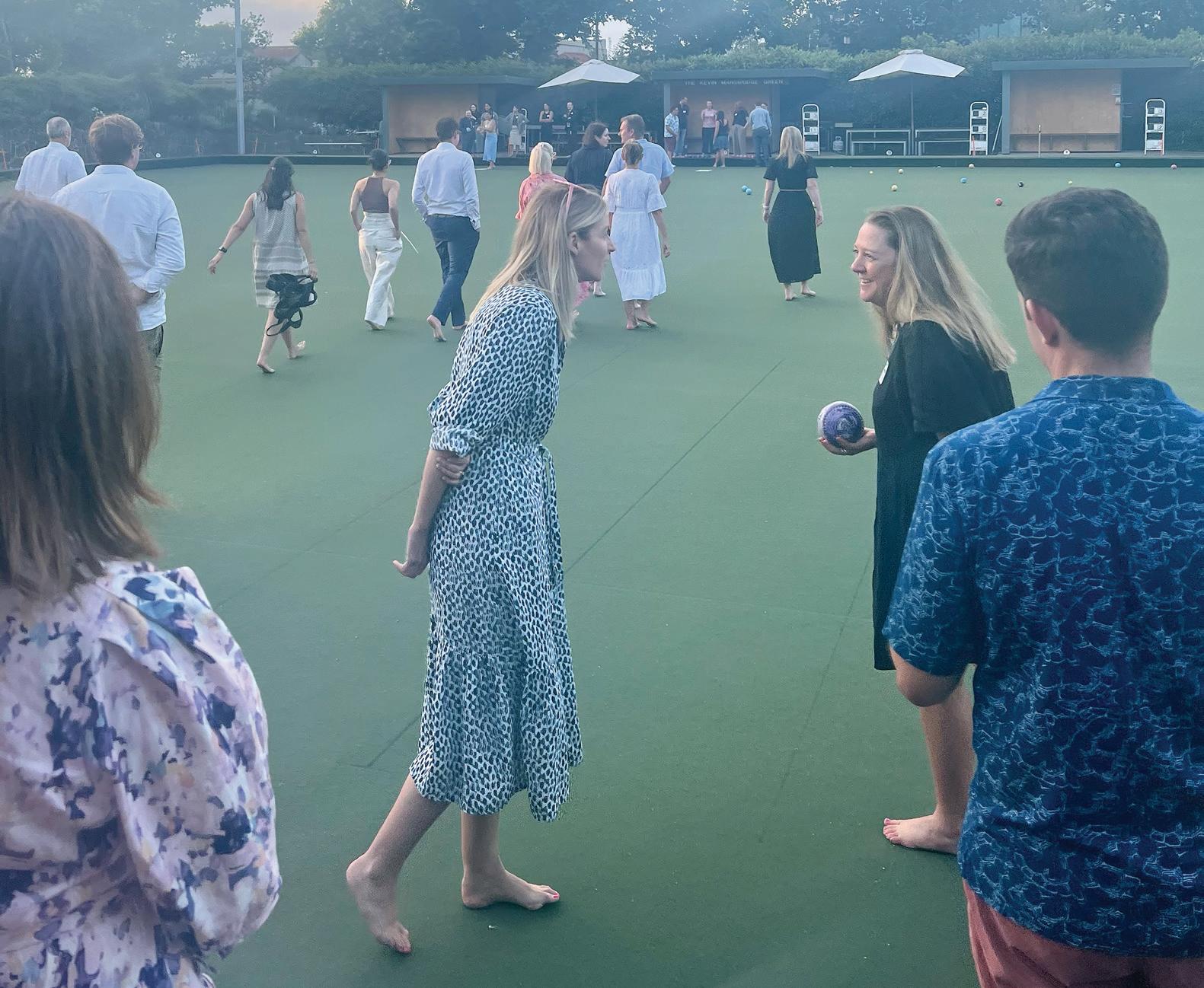
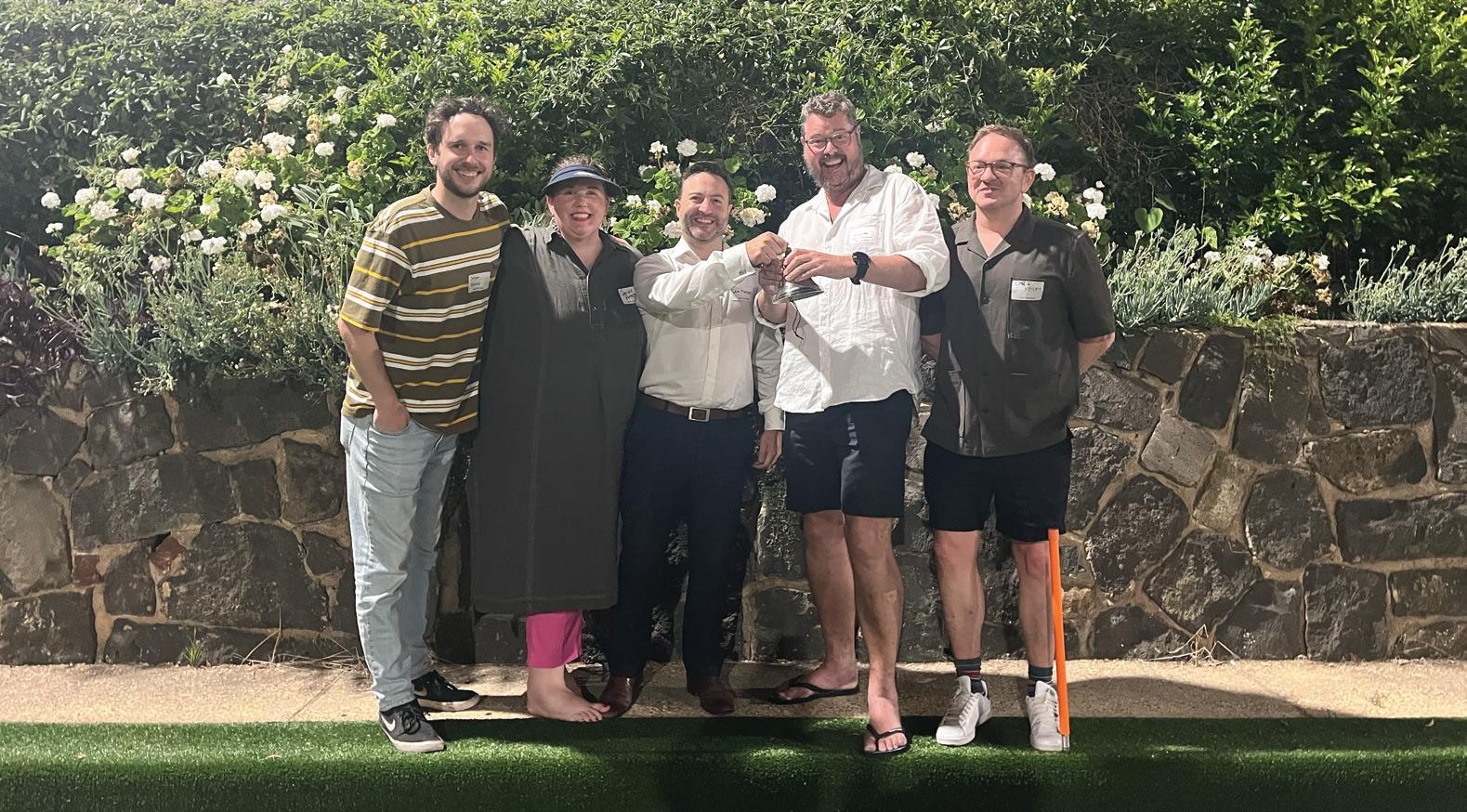
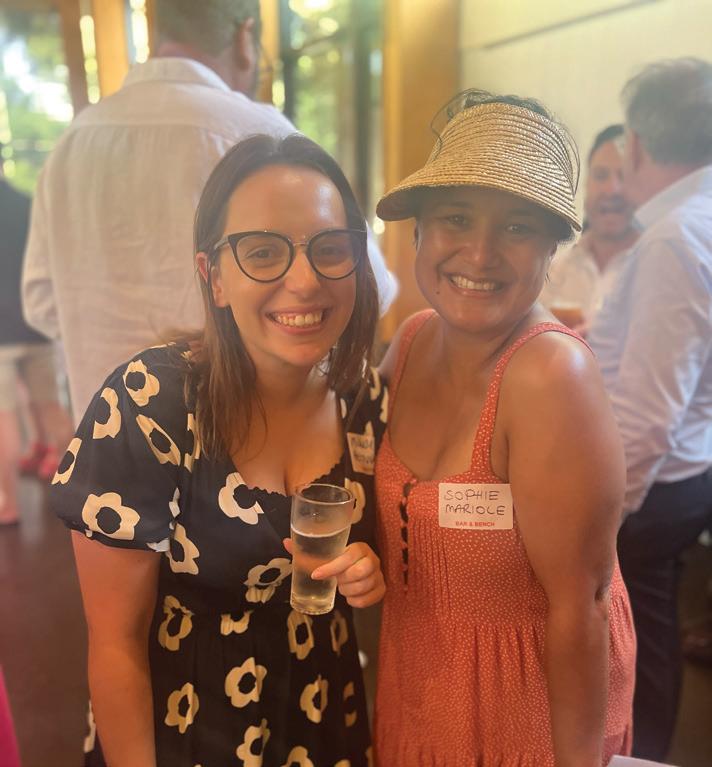
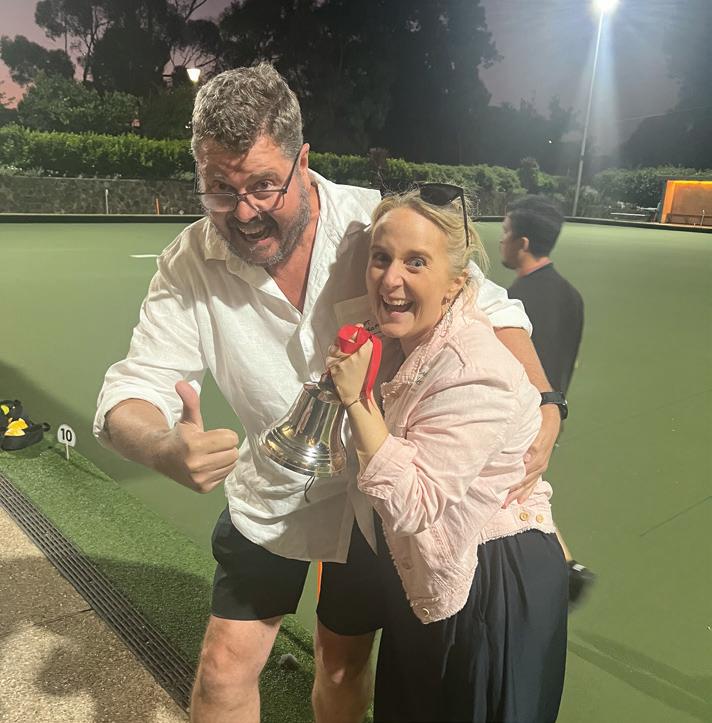

CAROLINE PATERSON
On Friday, 17 February 2023, around 220 family law barristers, solicitors, judges and judges’ associates attended the Family Law Bar Association’s 6th annual Flagstaff Bell Barefoot Bowls event. After a day of extreme heat, the Calippos and watermelon slices offered for dessert after the spit roast dinner were an absolute hit. The “Bar and Bench” team had a convincing win to reclaim the Bell from the solicitors. As the sky turned purple and the sun went down, Sam
Marash, partner at Kenna Teasdale Lawyers, presented the Bell to the Bar and Bench captain, Geoff Ambrose.
This event has become the customary way we open our social program each year. It is particularly popular with judges’ associates, who attend as guests of the FLBA—our way to thank them for the hard work they do to support their judges and also the profession, to keep the court lists running smoothly. Next year’s Flagstaff Bell will be held on Friday, 16 February 2024.
RABEA KHAN
On 29 March 2023, the Victorian Bar held its annual Iftar Dinner, co-hosted with the Australian Intercultural Society (AIS).
The dinner is one of the annual events organised by the Equality and Diversity Committee of the Victorian Bar. The holy month of Ramadan is a time when Muslims fast, abstaining from food and water, from sunrise to sunset. An “iftar” is the meal that breaks the fast at the time of the sunset prayer. It was the fourth time the Victorian Bar had held this event in Ramadan with the AIS and it was also the fourth time the event had sold out.
The distinguished guests at the dinner included their Honours Judges Gaynor, Robertson and Tsikaris, President, Sam Hay KC, and the Executive Director of the Australian Intercultural Society, Ahmet Keskin.
The night included a thought-provoking conversation between barrister Yusur Al-Azzawi and Mohammad Chowdhury. Mohammad Chowdhury is the author of the book, Border Crossings: My Journey as a Western Muslim. In line with the themes of the book, Mohammad shared his experience as a Western Muslim in a post-9/11 world and his journey in reconciling the British, Asian, and Muslim sides of his identity.
As is the tradition of an iftar, the conversation was followed by the adhaan (call to prayer) and the breaking of the fast. The dinner was well attended with a diverse array of guests, including members of the judiciary, Victorian Bar members of all seniorities, lawyers, law students and members of the Muslim community. The annual interest in this event highlights both the value of the legal profession reflecting the community it serves and the enthusiasm from our Bar to celebrate its diversity.
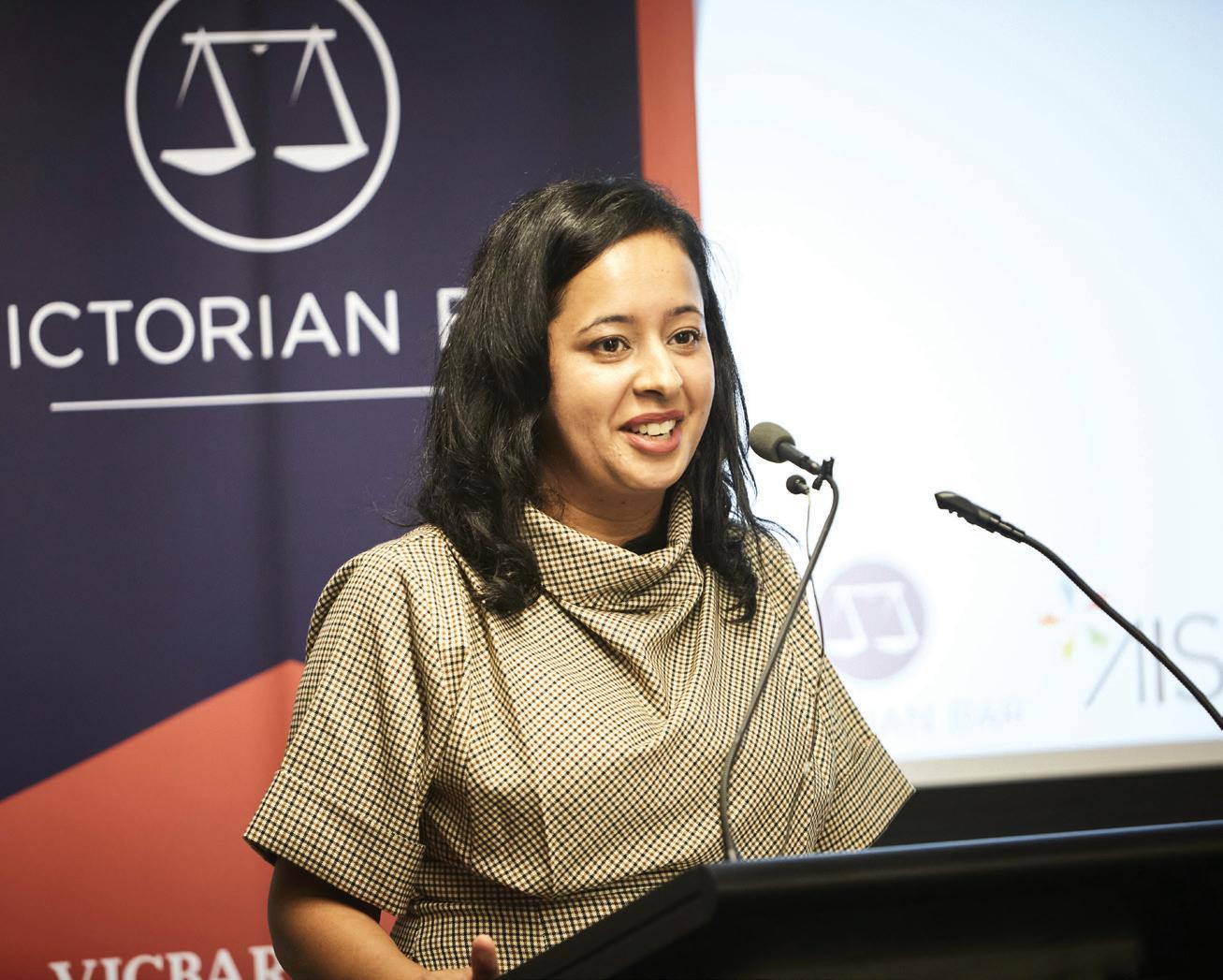
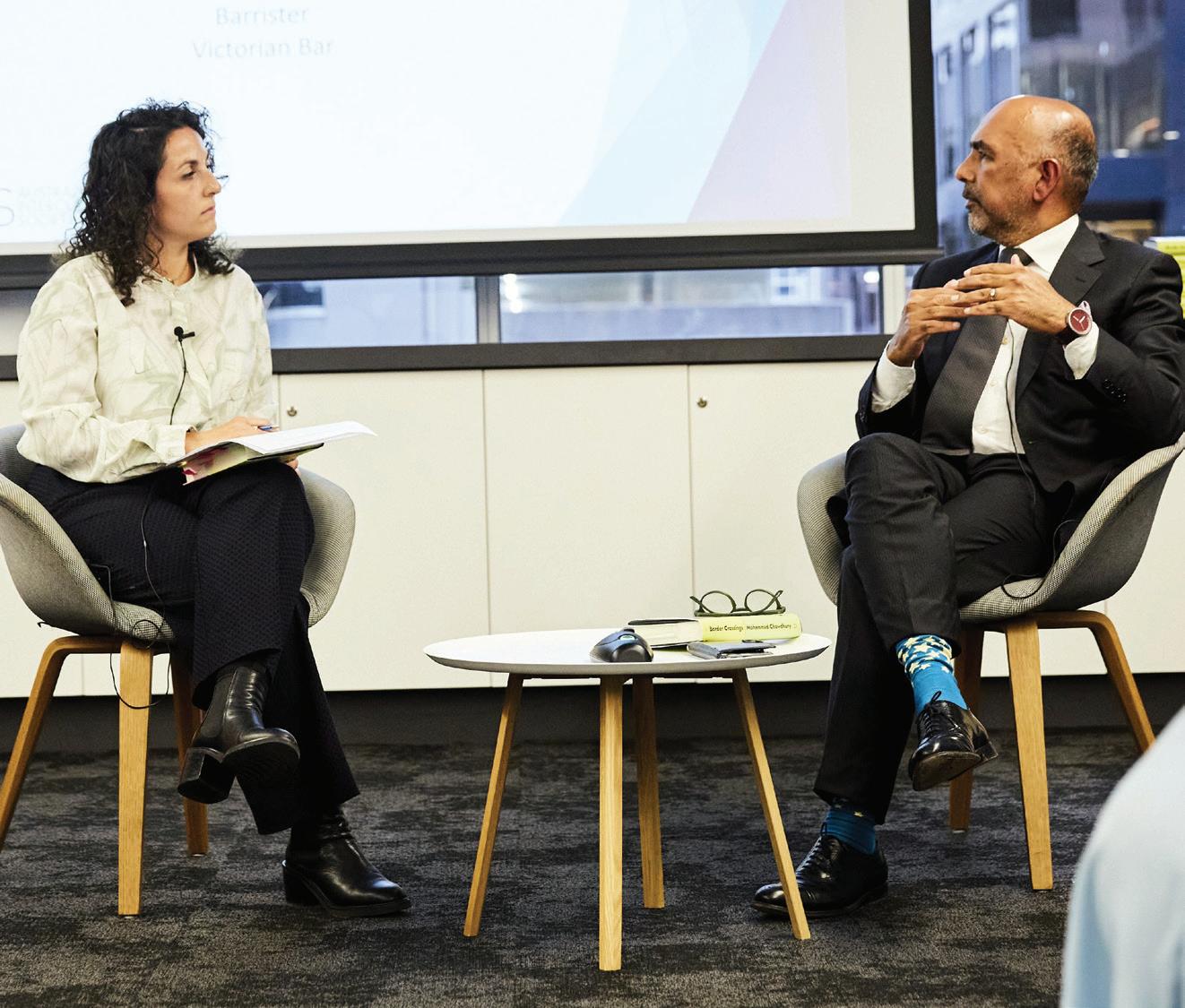
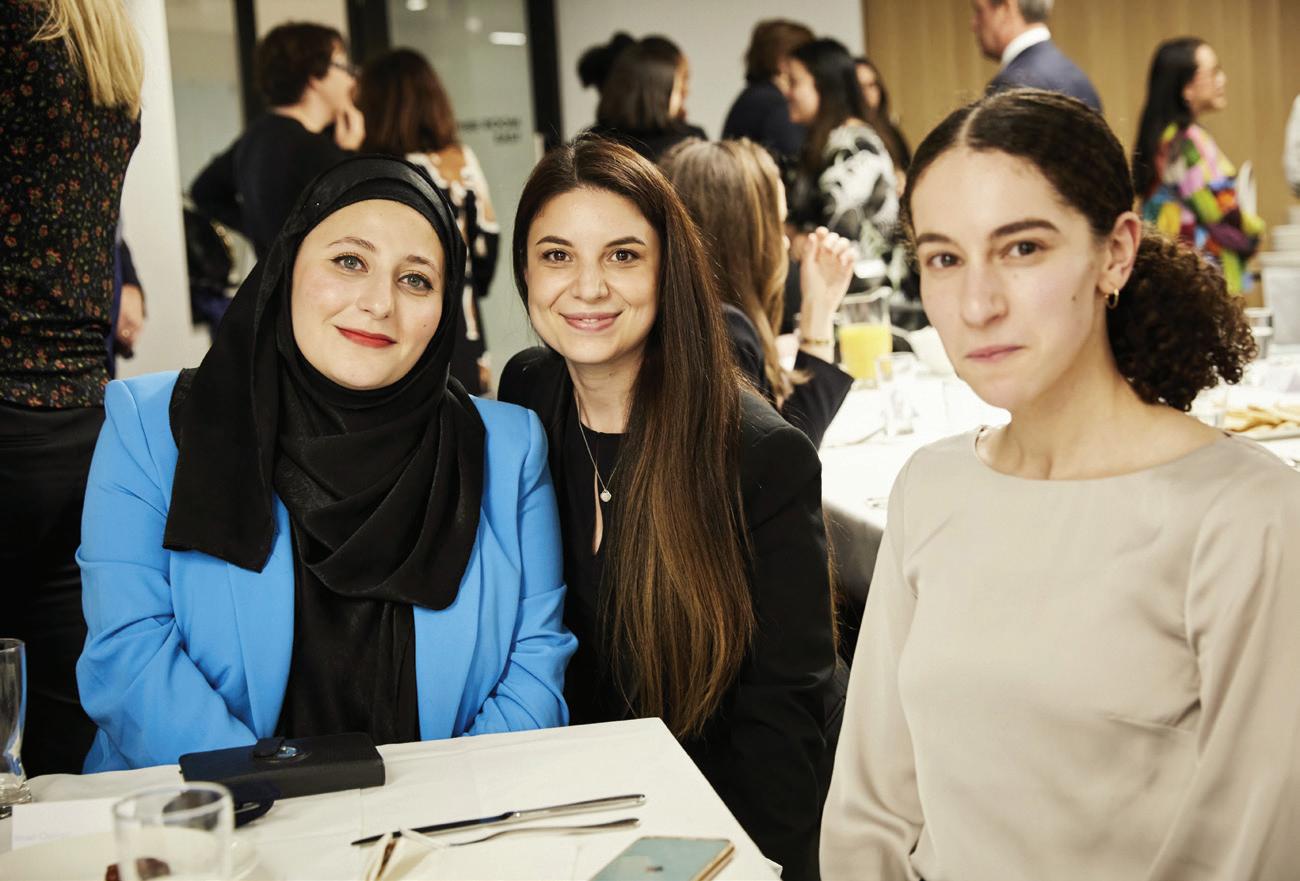
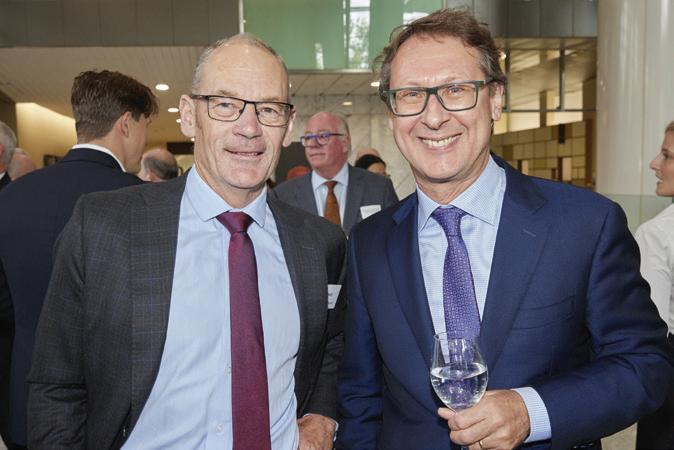
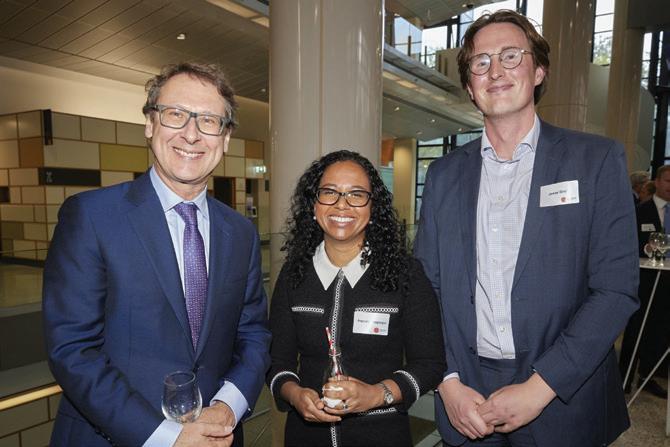
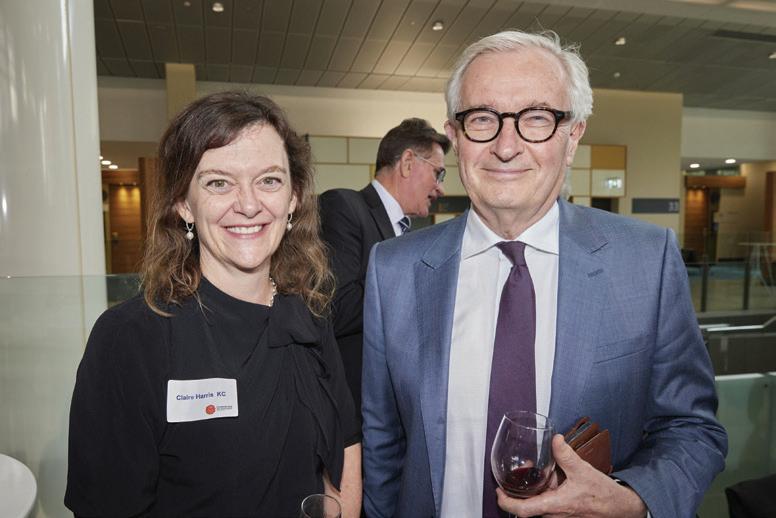


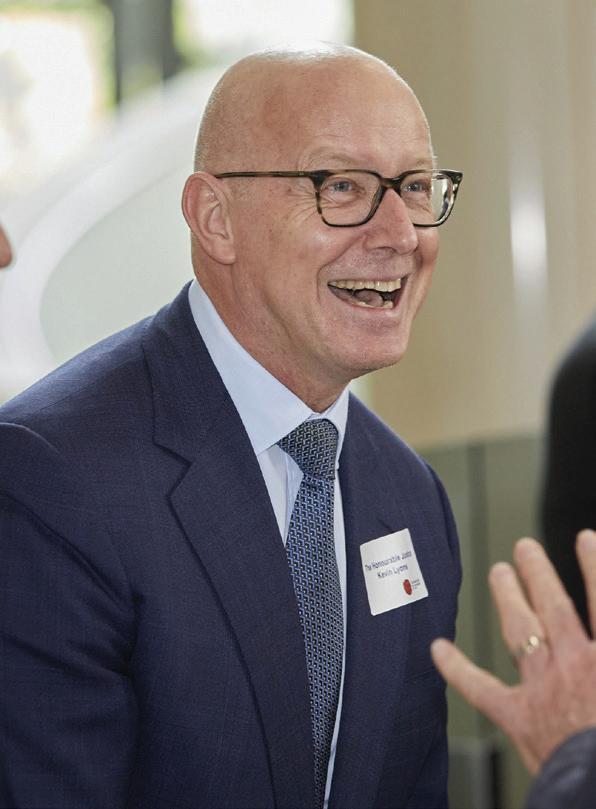
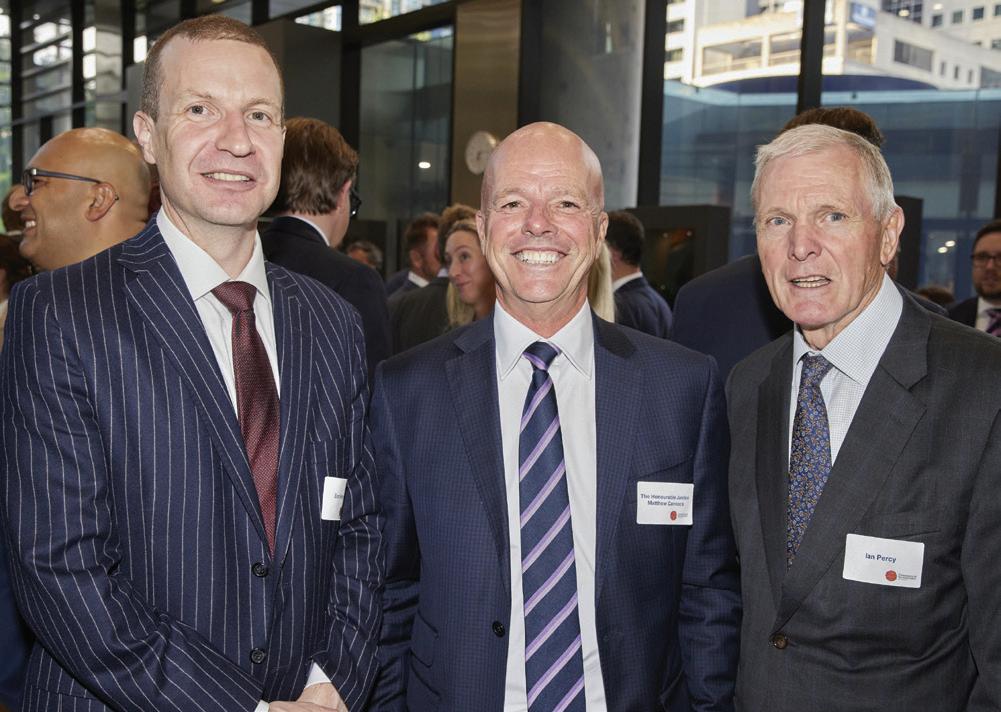
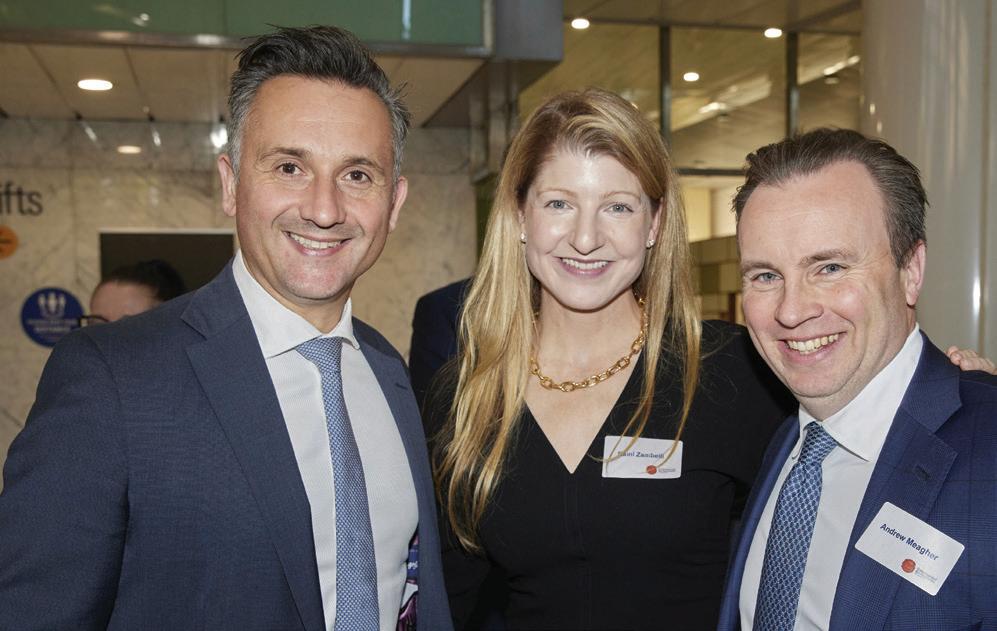
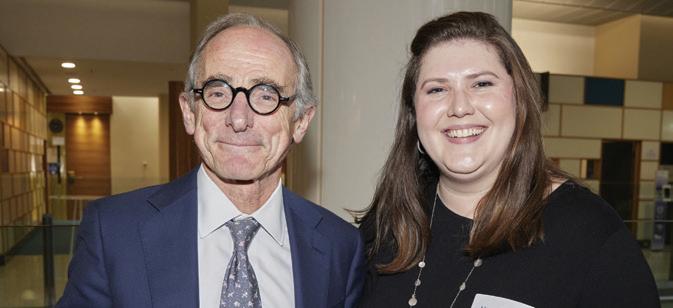
Wednesday 8 March 2023 saw the return of the Commercial Bar Association’s annual cocktail party.
Graciously co-hosted by the Chief Justices of the Federal Court of Australia and the Supreme Court of Victoria in the capacious foyer of the Commonwealth Law Courts building, the function coincided with Chief Justice Allsop’s last Melbourne sitting before his retirement, and we were privileged to have him spend the early part of his evening with us.
Over 200 counsel and members of the judiciary, in-house counsel and commercial solicitors as our invited guests celebrated the opportunity to gather once again post-pandemic for a fabulous evening of cocktails and canapés.
The Chief Justices welcomed all attendees and reflected on our practices returning to a new normal following the lifting of lockdowns and returning to court in-person where
possible. Chief Justice Allsop commended CommBar as an institution worthy of emulation in other states. Chief Justice Ferguson celebrated the fact that the profession and the judiciary were once again able to congregate and empathised with the challenges confronted by each of us in dealing with the last few years on both an individual and professional level.
CommBar President Stewart Maiden KC welcomed all attendees and took the opportunity to launch an exciting new initiative for CommBar: an underwritten internship for law students. Work experience is a crucial aspect in preparing a person for legal practice and in introducing them to the job market, and the new program is designed to assist those students whose personal circumstances might prevent them from taking unpaid work.
A great night was had by all, with the consensus being that it is good to be back.
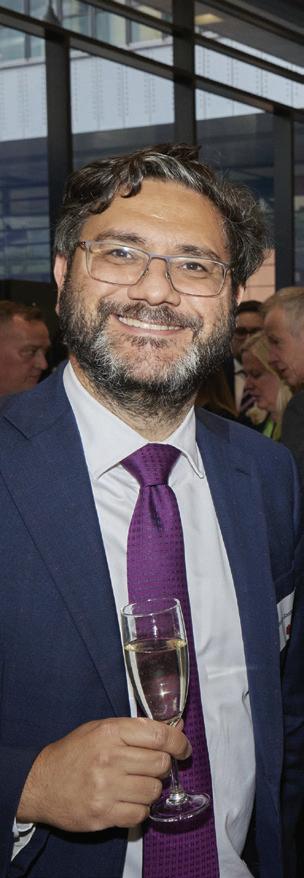
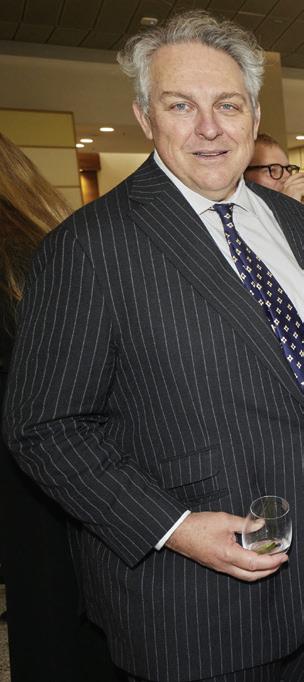
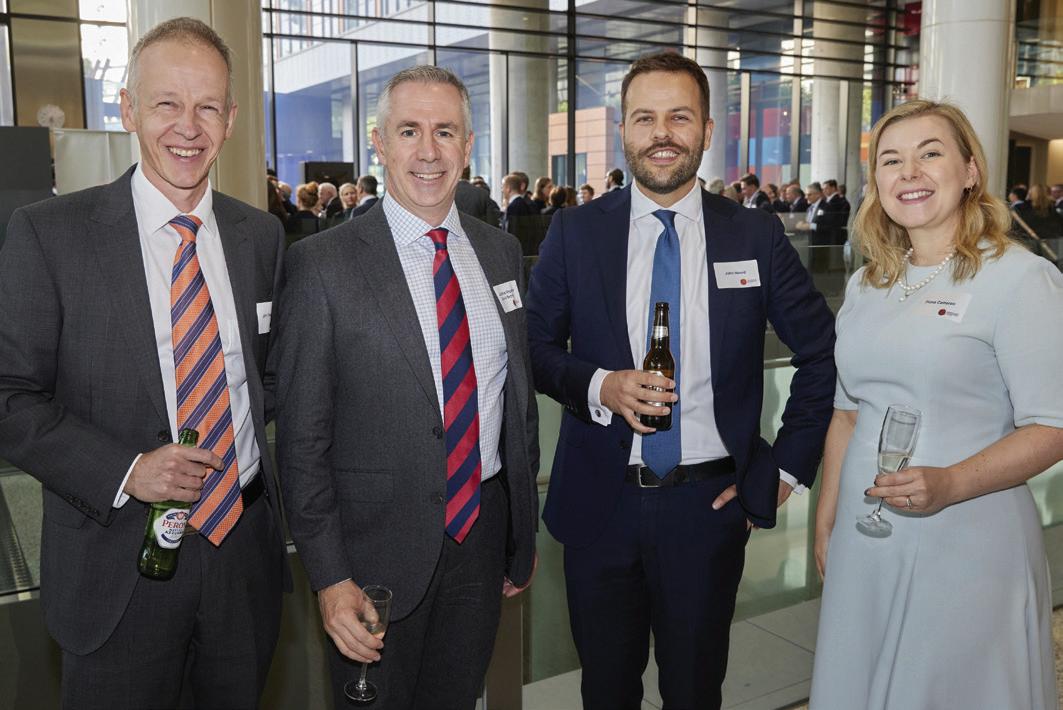

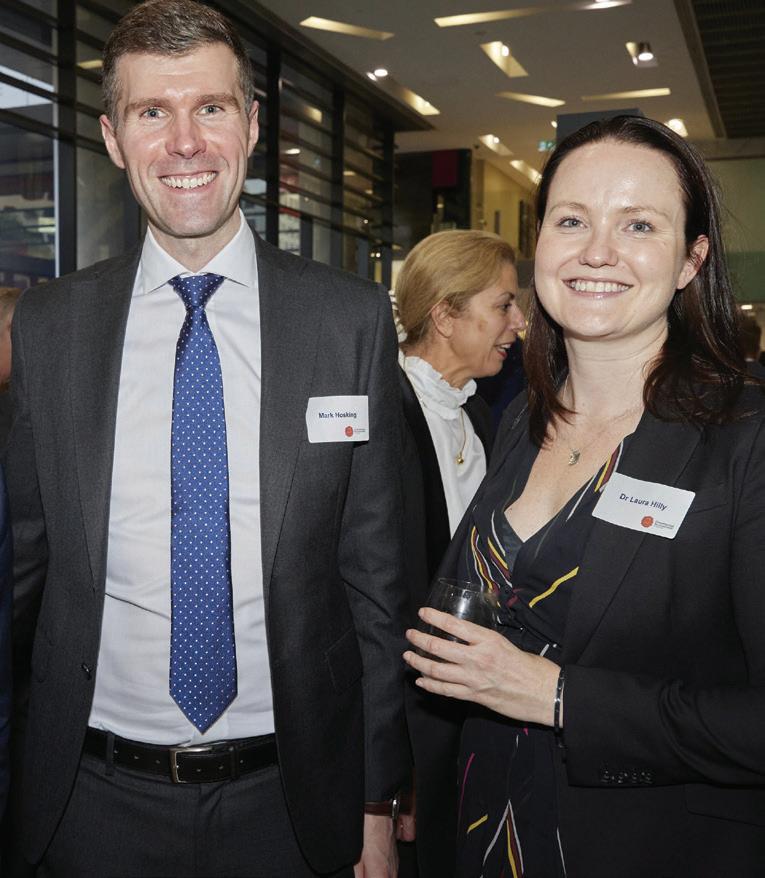
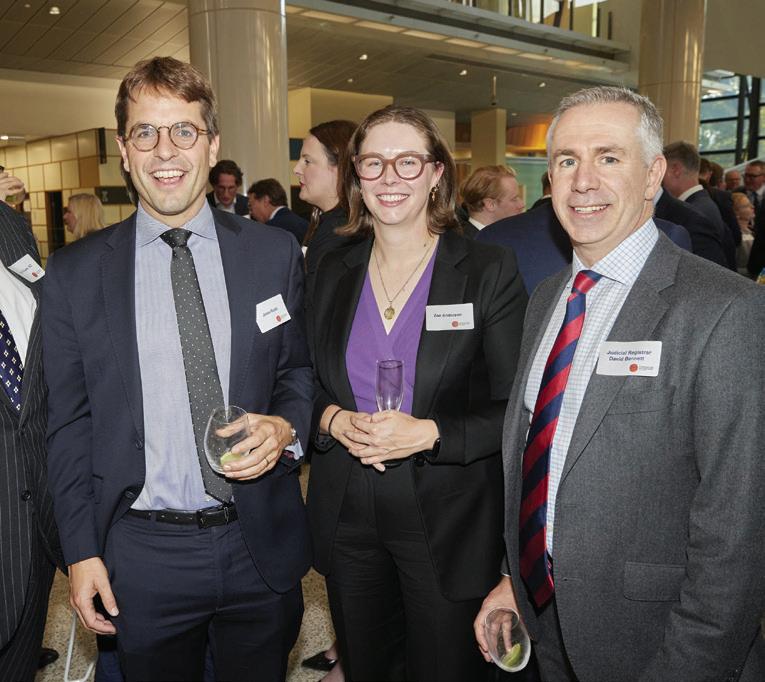
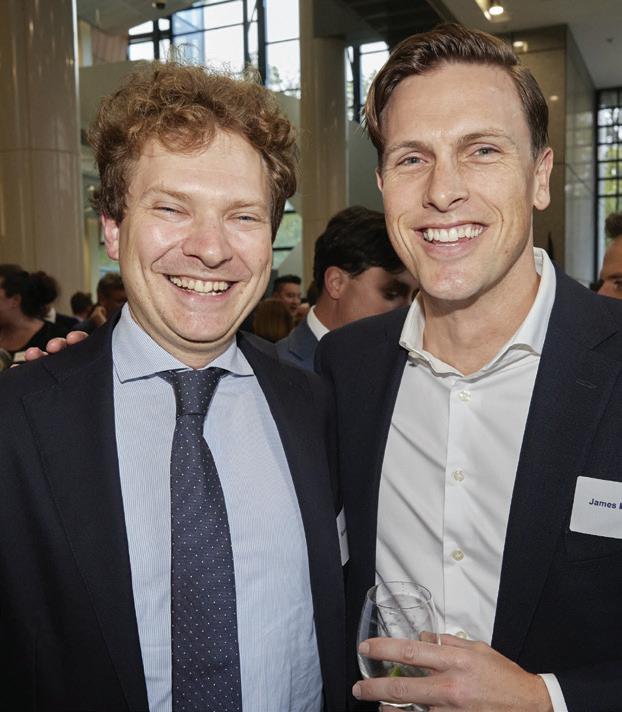
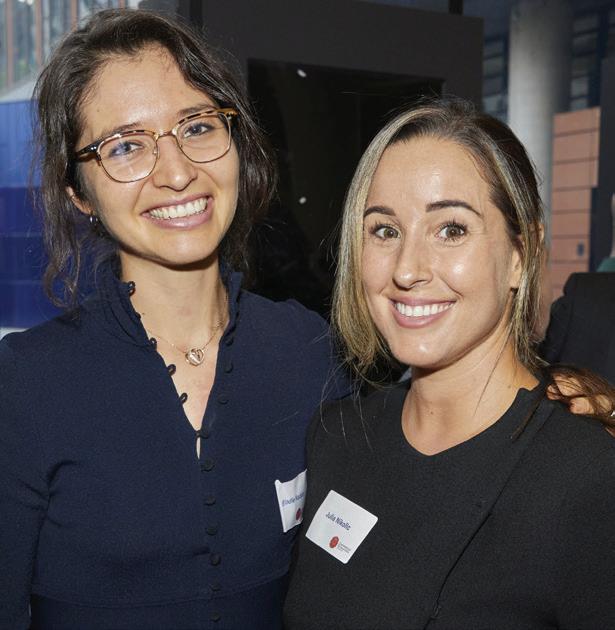
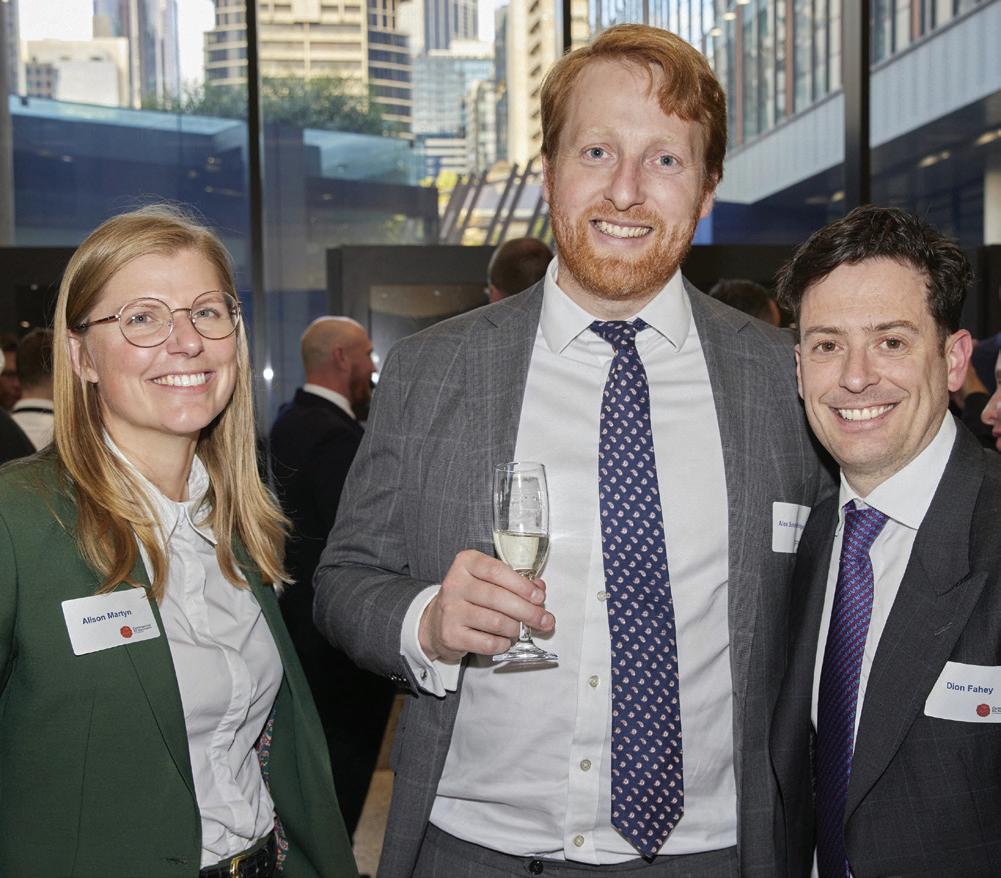
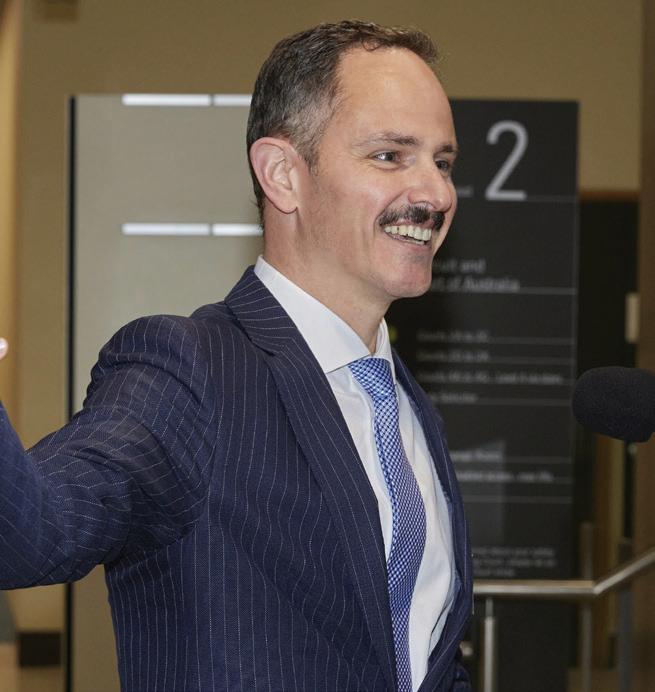
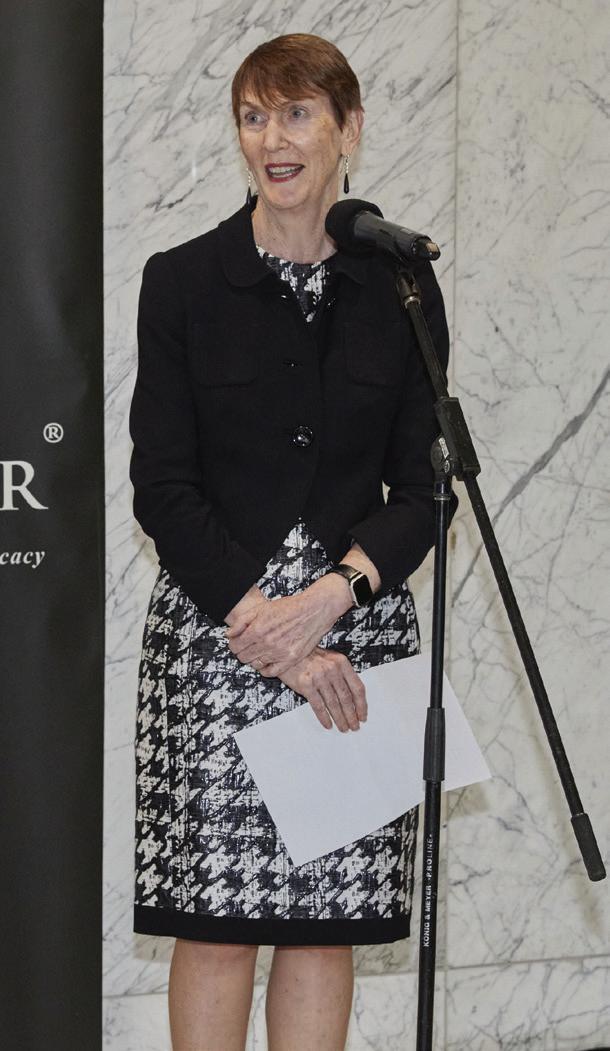

1. Nick Hopkins KC and The Hon Justice O’Bryan 2. The Hon Justice O’Bryan, Premala Thiagarajan, James Gray 3. Sam Hay KC, The Hon Justice Connock, Ian Percy 4. John Tesarsch, Judicial Registrar Bennett, John Heard, Fiona Cameron 5. Rowan Minson, James Waters 6. Chief Justice Ferguson 7. Claire Harris KC, Chief Justice Allsop 8. Mitchell Grady, Sam Rosewarne KC, Hamish Redd 9. Dr Drossos Stamboulakis, Kieran Hickie 10. The Hon Justice Lyons 11. Nik Dragojlovic Raini Zambelli, Andrew Meagher 12. Dion Fahey, Clare Exell, Jillian William, Alexandra Folie 13. Elodie Nadon, Julia Nikolic 14. Chief Justice Allsop 15. The Hon Justice O’Callaghan, Lisetta Stevens 16. Timothy Goodwin, Mark Hosking, Dr Laura Hilly 17. Alison Martyn, Alex Solomon-Bridge, Dion Fahey 18. Paul Hayes KC, Jesse Rudd, Zoe Anderson, Judicial Registrar Bennett 19. Stewart Maiden KC 20. Ian Horak SC, Lara O’Rorke, Amanda Storey
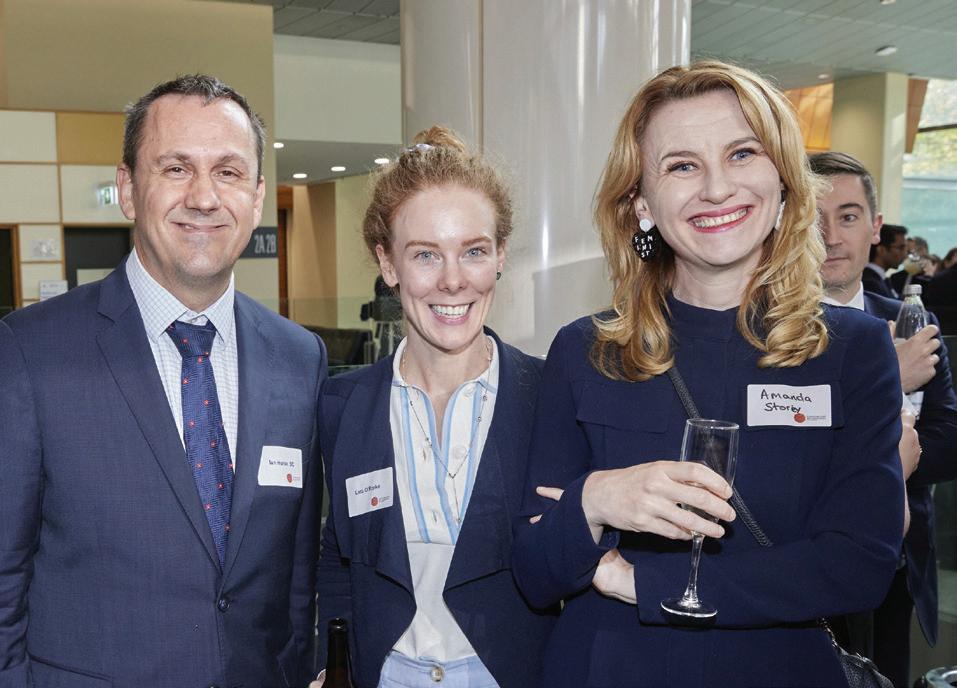
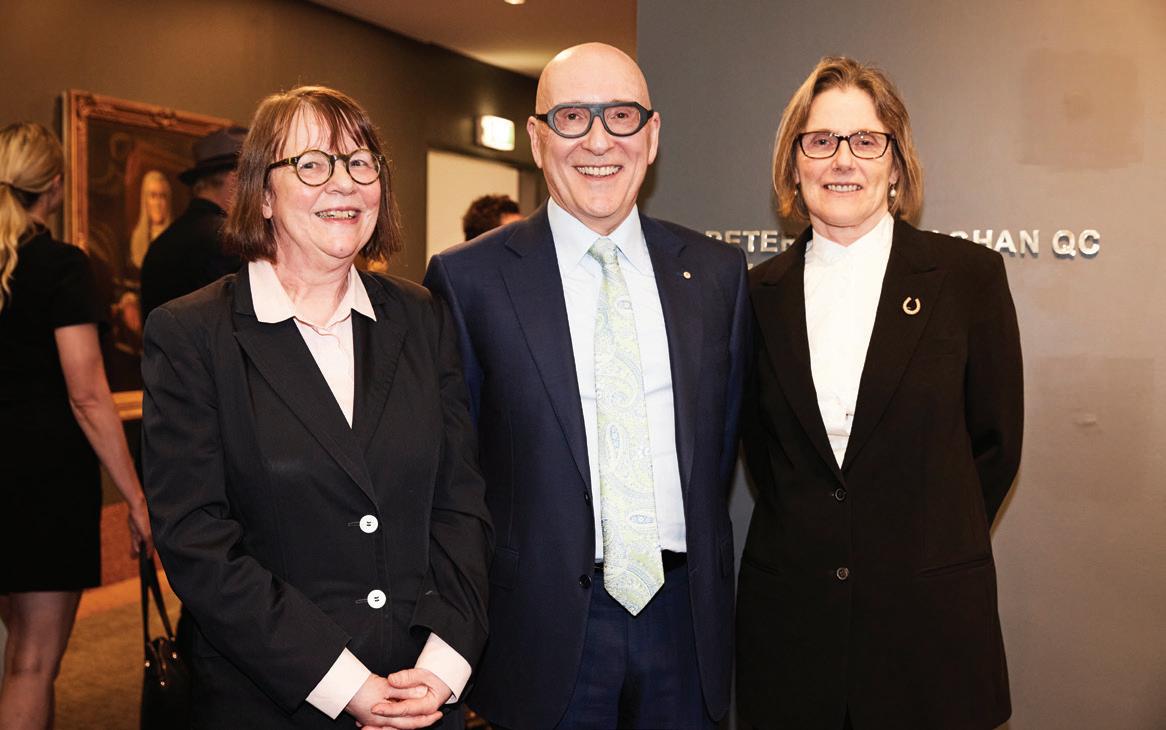
PETER WILLIS
“Close your eyes and imagine a tram journey up Glenferrie Road 50 years ago, full of jostling school students …”. With these words, Peter Jopling KC transported a large gathering of friends and colleagues to the origin stories of the Hon Sue Kenny and the Hon Kate McMillan, who attended schools a few metres apart, became friends at law school, signed the Bar Roll together on the evening of 12 March 1981, and had parallel distinguished careers as members of the Bar and judges.
The occasion was the official unveiling on International Women’s Day, 8 March 2023, of striking portraits of each in the Peter O’Callaghan QC Gallery.
Their Honours’ careers are well rehearsed in the pages of Victorian Bar News and the Bar history. Their remarks in reply to Jopling’s imaginative and fulsome launch are

worth recording. Kate McMillan first recorded her delight at the “wonderful portrait” by Queensland based artist, Jenny Watson, who was present for the launch:
Her commission began at the start of the lockdown. She had to make do with photographs, chats over the phone and one face-to-face meeting.
I felt an immediate connection with her, and I hope she did with me. Her portrait of me is striking, yet subtle— not that many would ever describe me as subtle. Jenny has captured the younger and older me, heading towards what I would describe as my forthcoming blue sky thinking period.
Kate McMillan then recalled her role as Chair of the Bar’s Arts and Collections Committee:
I inherited a lacklustre art committee—there were a few very
good portraits in the collection, with the rest being more average. A stocktake of inventory revealed a collection of about 30 portraits; two were missing—one was subsequently found behind a door in the Bar office, and the second was run to ground somewhere at Melbourne University.
One of my lasting achievements before finishing as Bar Council Chairman was to appoint Peter Jopling as the head of the Arts and Collections Committee. He remained in charge until his retirement last year, that is, from 2006 to 2022. Without Peter’s contribution to the formation and development of the Peter O’Callaghan Gallery, there would be no gallery at all, 60 plus portraits would not exist, and all who walk
through Owen Dixon Chambers would not enjoy the privilege of seeing such a remarkable display, as well as the snapshot of the history and traditions of the Victorian Bar.
Sue Kenny first thanked her portraitist, who painted a work of detail, depth and honesty:
Marie Mansfield’s work speaks for itself. Her kindness, patience, empathy made the sitting a lovely, though humbling, experience.
Justice Kenny, too, then reflected on the gallery and what it displays. She recalled that on signing the Roll, she and Kate McMillan were among just 20 women of 700 members of the Bar.
She noted how the Bar has evolved but is still not as diverse as contemporary Australian society:
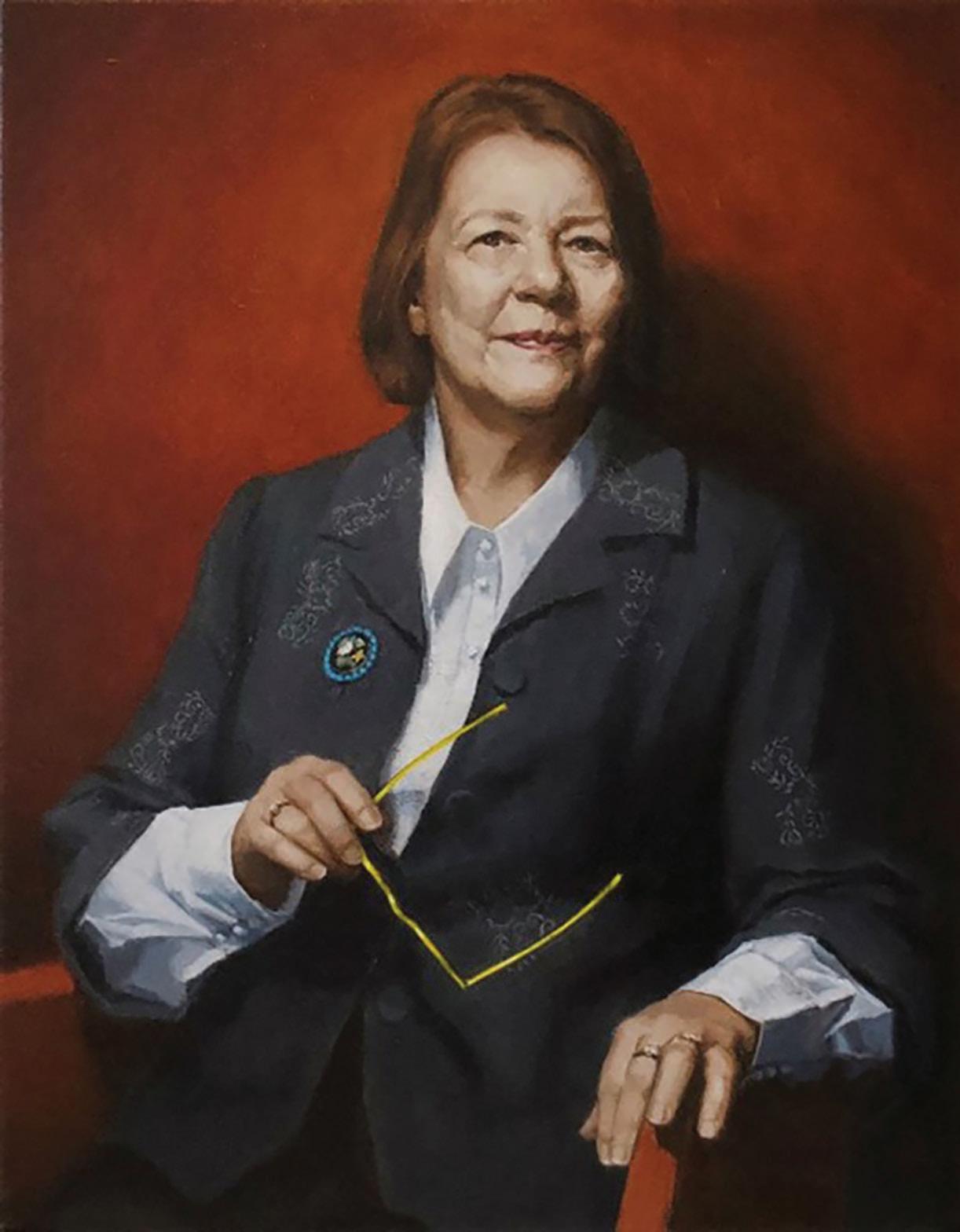
Why is this so? The principle of ‘merit’ is often said to be a cornerstone of the Bar … One problem may be the ideal of merit itself. The ideal can be dangerous: it is not always referable to relevant and objective criteria. If the criteria are wrong, the ideal can effect unjust discrimination, which is damaging for the Bar and the administration of justice.
This gallery can, and I think is, playing a crucial role in addressing this problem. Its portraits show that outstanding barristers are diverse, save that they strive to be expert in law, ethical, and actors in the common good.
There are two things I love about the gallery. First, it shows us that not all barristers look the same. Nor do they share the same heritage, life experience or worldview. Second,

the gallery gives us a powerful visual history of how we are evolving. It shows us that diversity makes us stronger.
We are indebted to those with the imagination and dedication to institute and maintain the gallery, and to the Bar for supporting them.
And if Kate and I are rather astonished by what has occurred, we are also very touched.
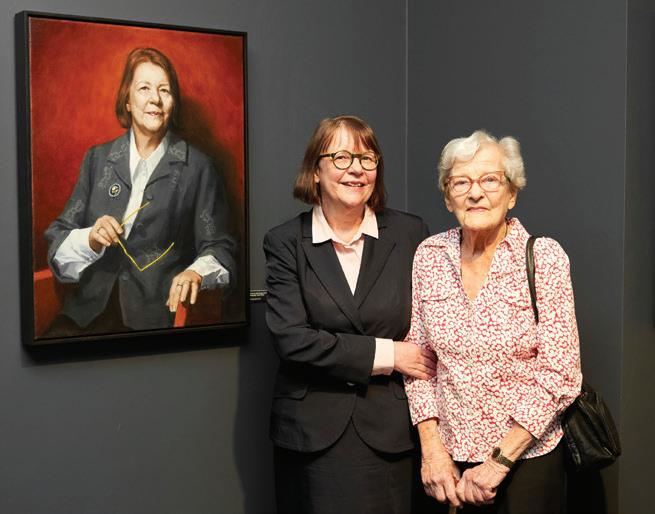
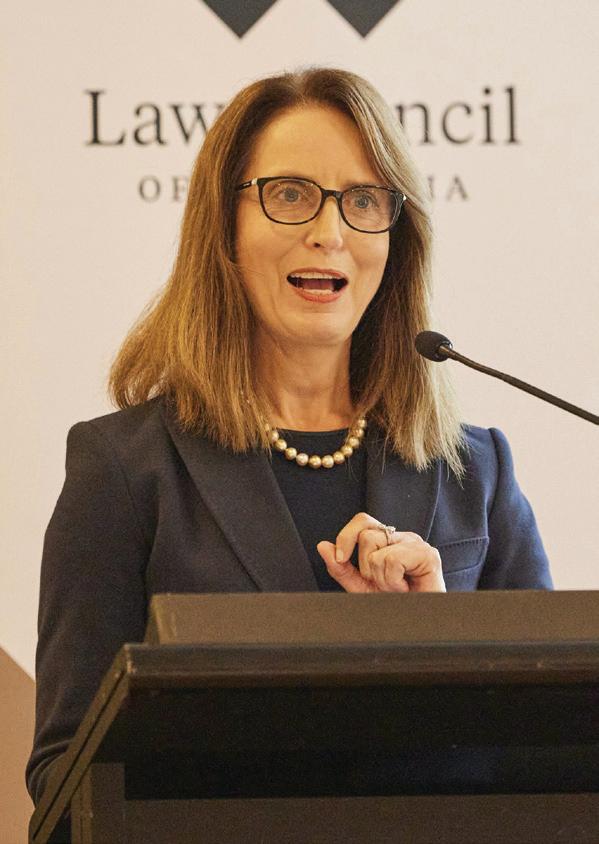
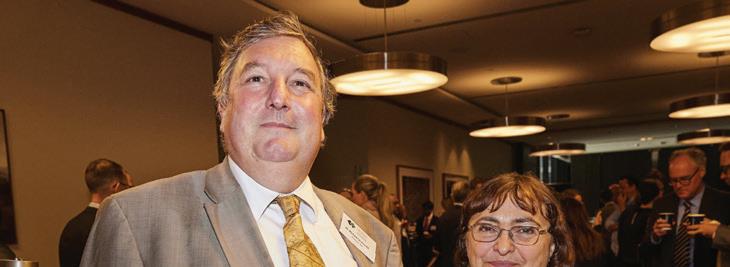
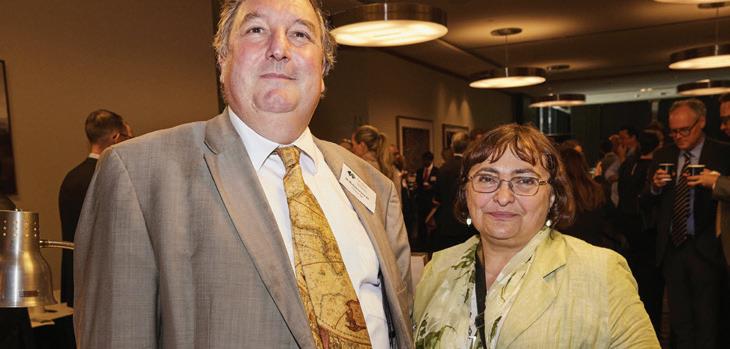
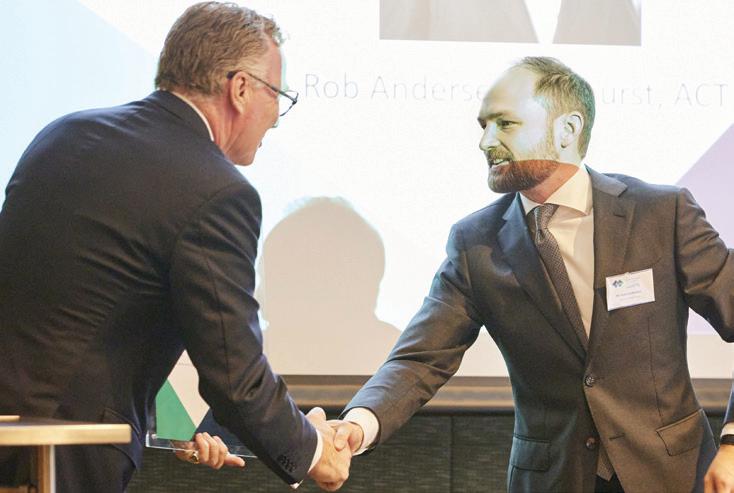
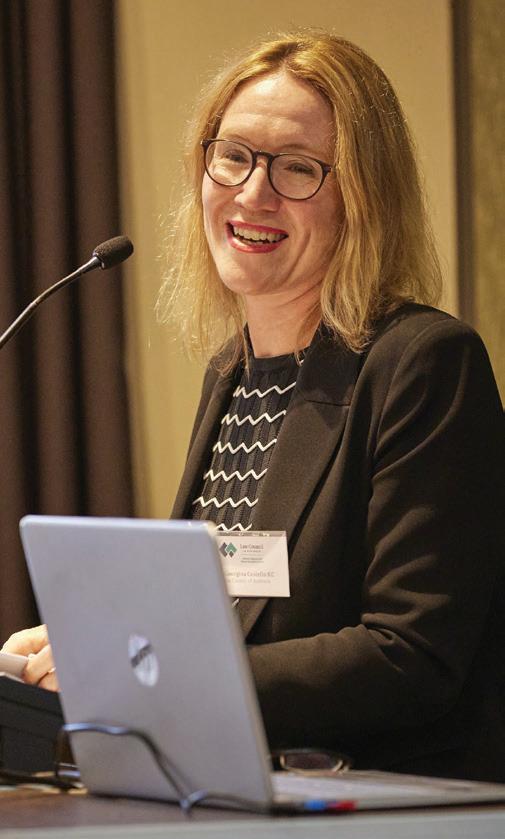
GEORGINA COSTELLO
Under the joint banners of the Law Council of Australia and the Victorian Bar, solicitors, barristers, tribunal members and judges arrived at the Essoign Club in February 2023 for the opening drinks function of the inaugural Commonwealth Law Conference. The theme of the conference was coherence and connection in federal law, and focused on federal law issues at a time of enormous change and challenge. Attendees flew in from around Australia to make connections with new colleagues and think about common issues across diverse areas of federal law.
With pressing issues in federal law ripe for discussion, conference delegates heard speakers talk about the impending abolition and planned rebirth of the Administrative Appeals Tribunal, the start of a federal anti-corruption commission, the coming referendum on the Voice, potential solutions to the ever-growing backlog of migration cases in the federal courts, and emerging issues in tax, industrial and class action cases.
Bar President Sam Hay KC kicked off the conference opening drinks function with warm remarks to welcome the assembled conference delegates. The balance of the conference continued in
style at the RACV Club in Bourke Street and culminated in a pleasant Friday lunch for all who attended.
A highlight of the conference was the presentation of the inaugural Young Federal Litigator of the Year award to solicitor Rob Andersen by Chief Justice Alstergren of the Federal Circuit and Family Court of Australia. Mr Andersen is a senior associate in the dispute resolution practice at Ashurst in Canberra. Competition was fierce for the award with nominations received from around Australia. Ultimately, the accomplished Mr Andersen prevailed. His career so far includes successfully defending the Commonwealth against a claim by staffers in Senator Lambie’s office who alleged their employment was terminated in breach of the general protections provisions of the Fair Work Act and work for the National Disability Insurance Agency in appeals to the Federal Court.
Speakers at the conference included the Attorney-General Mark Dreyfus KC, Justices Perry and Murphy from the Federal Court, Justice Nichols from the Supreme Court, Deputy Presidents of the AAT Bernard McCabe and Peter Britten-Jones, plus an abundance of

eminent lawyers including Craig Lenehan SC, the Hon Chris Jessup KC, Ingmar Taylor SC, Kate Eastman SC, Daniel McInerney KC, Valerie Pereira, Andrew Cope, John Emmerig and Professor Mary Crock. The conference was both timely and on trend as conference attendees digested fascinating presentations on class actions, industrial law, appeals, tax cases, migration law and both merits and judicial review between delicious food, coffee and drinks.
Justice Perry’s keynote address focused on the role of artificial intelligence, with her Honour cautioning against the use of chatbots in legal work in a witty and erudite presentation. During the class actions session, Ben Slade and John Emmerig presented current research on the quantum of recoveries of damages and funding costs in class actions. Peter Woulfe, Chair of the LCA’s Federal Dispute Resolution Section, Dr James Popple, Law Council CEO, and LCA president Luke Murphy also gave excellent presentations to the assembled audience.
Thanks go to the Law Council’s Federal Litigation and Dispute Resolution Section and the Victorian Bar for organising and hosting the event which was a sell-out and is hoped to be the first rather than the last time the LCA and the Victorian Bar arrange a conference focused on federal law. With a new Chief Justice of the Federal Court appointed soon after the conference, the stage is set for the next conference to continue the conversations and collegiality in Victoria and around Australia in our federal profession.
With COVID lockdowns far behind us, the Criminal Bar Association (CBA) headed down to the RACV Club, Healesville on 3 March 2023 for its biennial conference. Over 100 barristers, ranging from readers to well-established silks, attended for a weekend of discussion, learning, and golf.
The conference commenced on Friday evening, with a gin masterclass at Four Pillars Distillery. While the CBA hasn’t been able to formally award CPD points for learning the difference between ‘Old Navy’ and Shiraz gin, the night certainly set the tone for a weekend of catching up with old and new colleagues.
The Saturday CPD sessions commenced with learnings and encouragement from the heads of criminal jurisdictions across the Magistrates’, County and Supreme Courts. While the courts are still facing significant backlogs, much is being done behind the scenes to reduce unnecessary delays in the criminal justice system. It’s not just the courts working on implementing new strategies at reducing delays—attendees were also reminded of the importance of respectful and productive resolution methods, both in and out of court. The CBA is in ongoing discussions with the courts, and welcomes feedback from members on any concerns which ought be raised with the relevant jurisdictions.
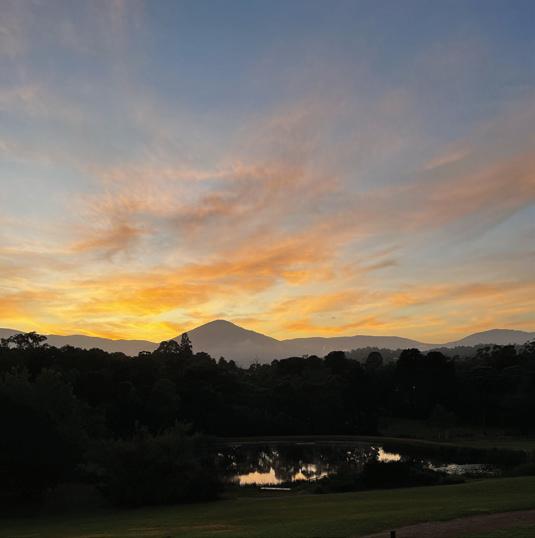
The relationship between psychology and law has taken on a significant role in sentencing and, increasingly, postsentence detention regimes. We were lucky to ‘test the friendship’ between psychology and law with Dr Joel Godfredson. Courts, and counsel, are reliant on the opinions of psychologists in many aspects of their work, and so we are grateful to Dr Godfredson for this frank and informative session.
While it may have been a while since many attendees had entered a classroom, Justice Beale took us ‘back to basics’ with a hearsay masterclass. Detailed written submissions have taken on a more dominant role in advocacy, and a thorough working knowledge of how best to use the Evidence Act to your advantage is essential in setting the tone for your submissions. The importance of a detailed analysis of legislative regimes was also highlighted on Sunday with Shaun Ginsbourg taking attendees through the extended liability provisions within the Criminal Code
Despite consistent chatter threatening to remove committal proceedings from Victoria, they were certainly not forgotten at the conference. Attendees shared their experiences, with discussion around the room certainly highlighting a range of approaches to committals. It was a tough gig for presenters to be the last in the Saturday afternoon slot, as attendees looked forward to letting their
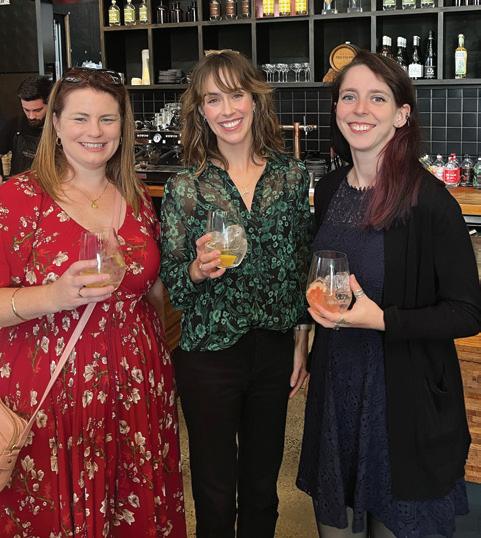
hair down to the tunes of our very own Jim Shaw’s band, Bridgetown!
The work of the Judicial Commission of Victoria (JCV) has been highlighted in the media recently, and the CBA was lucky to have Amber Harris, formerly of the JCV, and more recently back at the Victorian Bar, to remind attendees of the important role that the JCV plays, and the avenues available to members.
The CBA continues to be acutely aware of the impact that a busy criminal practice can have on its members.
Sunday morning gave attendees a chance to reflect and develop positive strategies for addressing vicarious trauma.
Peter Chadwick KC gave the concluding session for the weekend, presenting a paper on the much debated Human Source Management Bill. Peter’s forceful presentation reminded all attendees of the importance of a barrister’s independence, the strict rules of ethics, and particularly the unique position criminal barristers are often placed in owing to the nature of their practice:
The independence of the Bar is such an integral aspect of a barrister’s professional obligations and the rule of law itself, that a barrister should owe no allegiance to anyone or anything other than to the court and their client in accordance with the Bar rules.
Acting as a registered human source to a law enforcement agency carries with it so serious a risk to a barrister’s independence that counsel is likely to be confronted with major ethical difficulties should he or she become an informant even against individuals who are not clients.
With those sage words ringing in our ears, we concluded a most successful and enjoyable weekend conference. Thanks to all of those who organised, and all who attended.
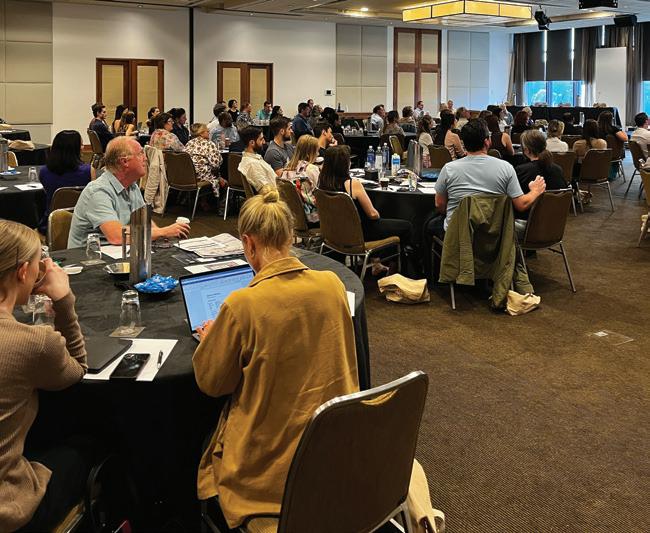
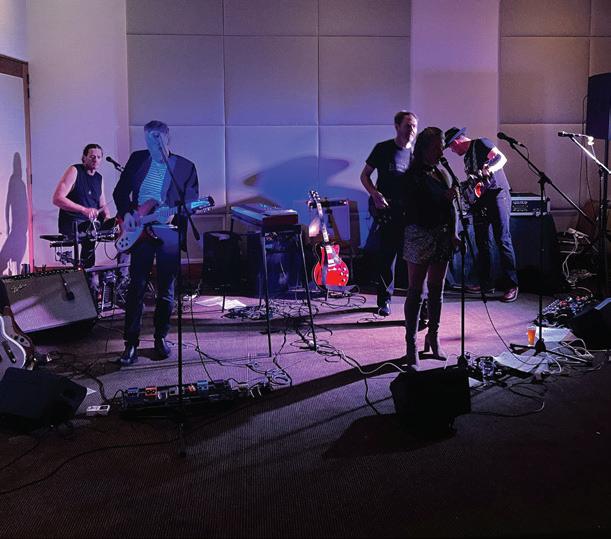
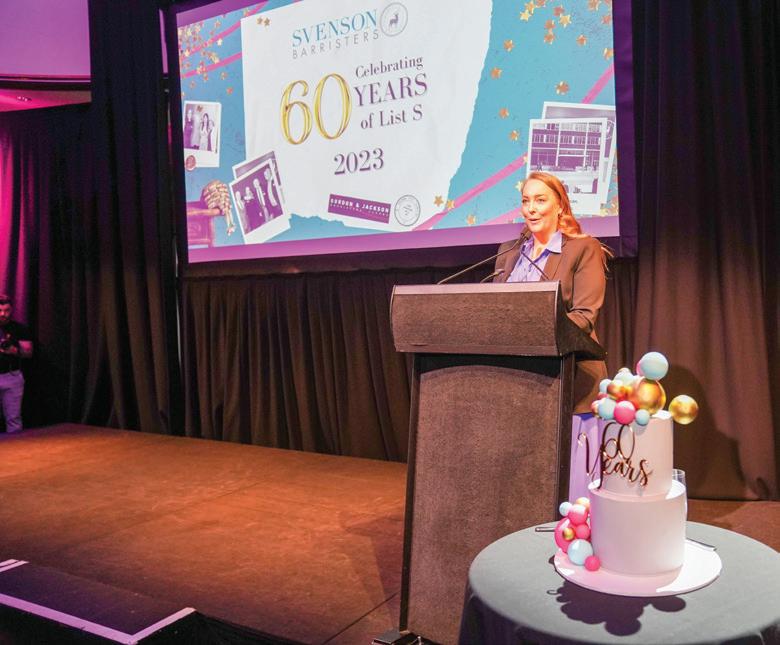
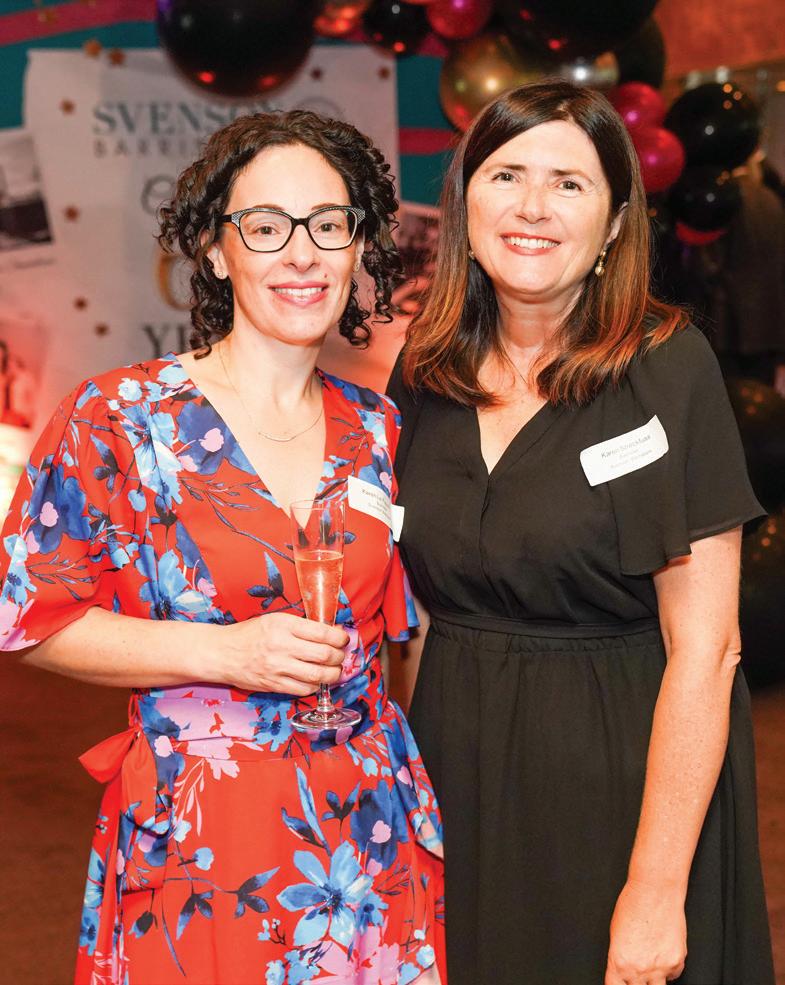
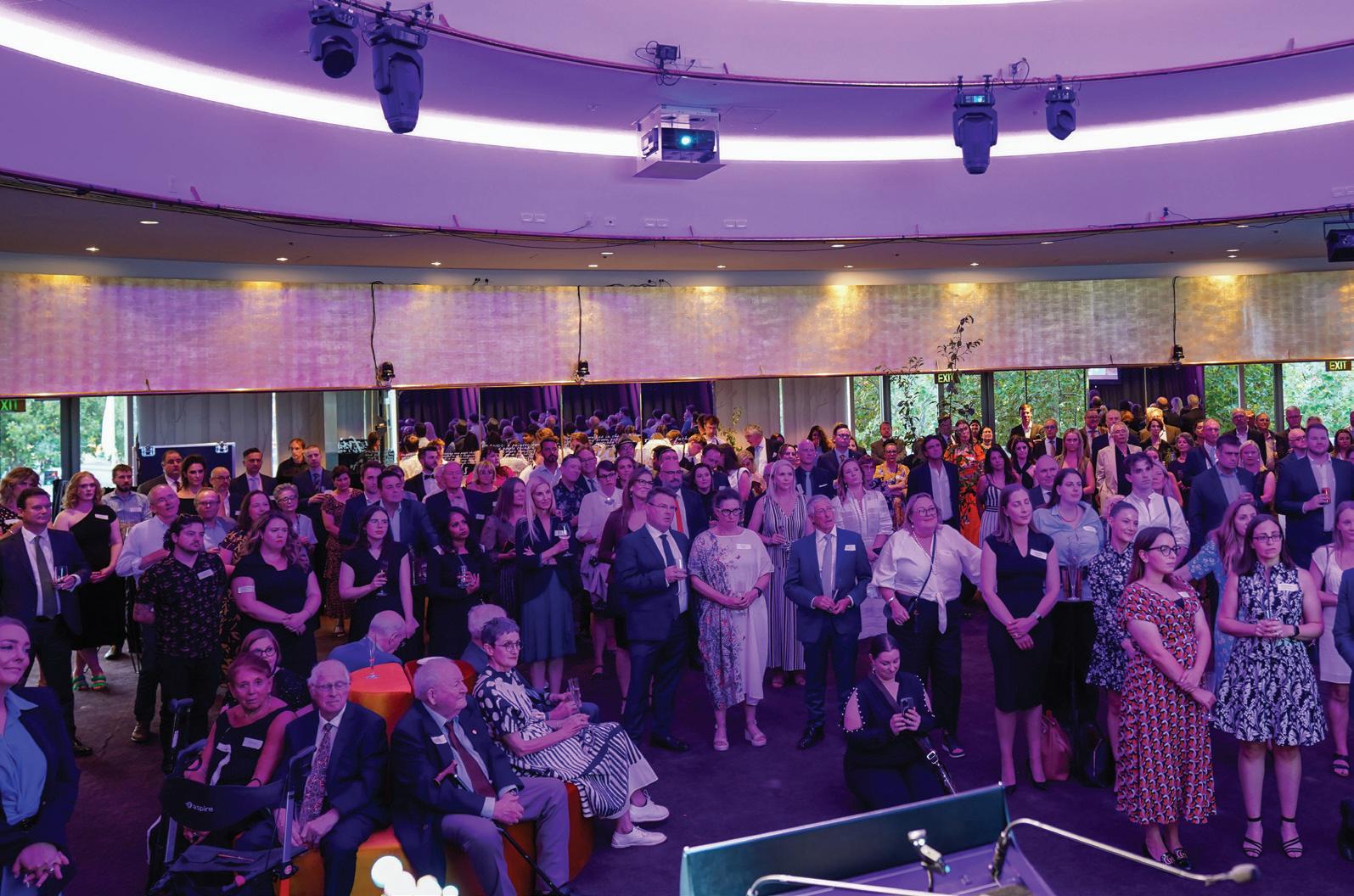
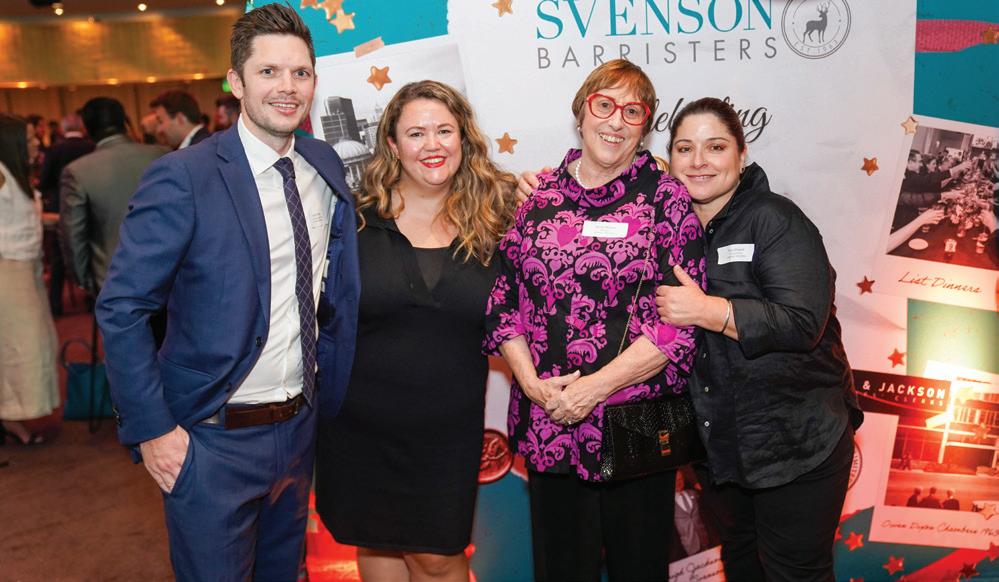
ANNA SVENSON
On Friday 24 February 2023 Svenson Barristers hosted a very special party at the Arts Centre Melbourne to mark 60 years of List S at the Victorian Bar.
The event brought together current members, alumni and judicial members, as well as current and former staff and solicitor and industry guests. We were delighted to welcome former head clerks, Ken Spurr (now aged 91!) as well as Ross Gordon to the event.
Instead of lengthy speeches, our audience enjoyed a polished video montage of memories and messages from members of our List community, past and present.
The List was established in 1963 by Ken Spurr, when he was in his early 30s.
We have always regarded ourselves as “the friendly List”, and over our rich 60-year history we have valued community, collegiality, success and friendship.
Interwoven into the fabric of List S are the clerking business and staff who support the barristers. Many staff have worked
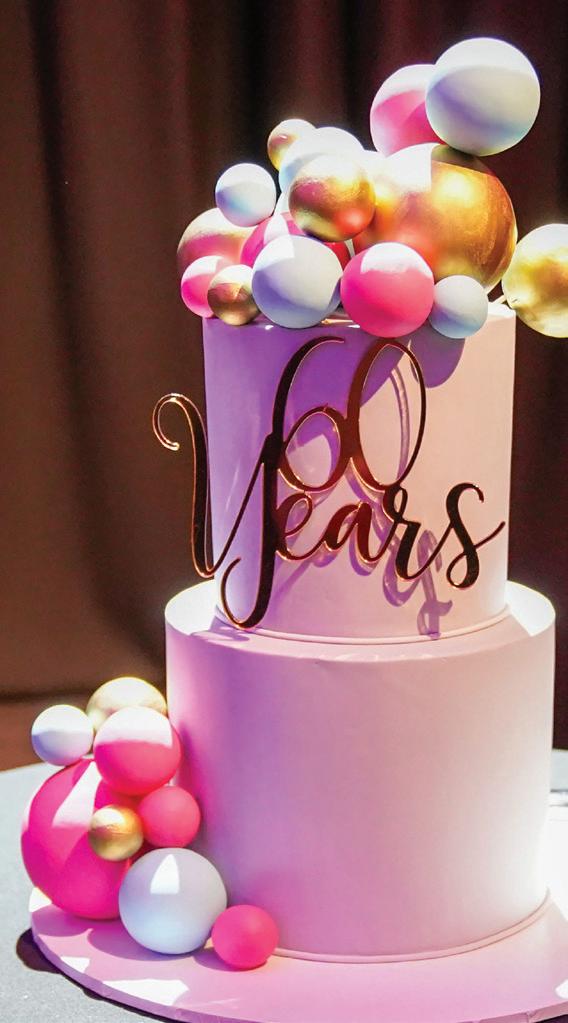
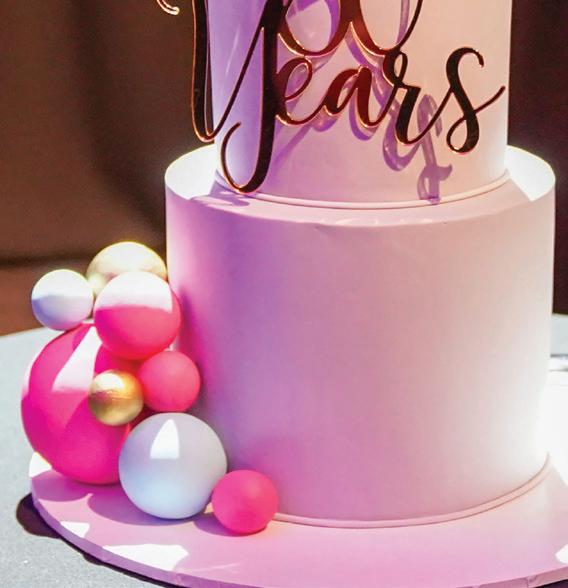
harmoniously with the List for decades showing incredible dedication, fierce protection and great love and admiration for their barristers. The clerks and team become the career partner to the barristers—cheering them on every step of the way through their very long careers, as they forge their practice at the Bar, from reader to retirement.
Solicitors through the years will have known List S under its various solicitor-facing clerking identities: first as Spurr’s List beginning in 1963, then as Gordon & Jackson Barristers Clerks from 1996 to 2016, and now as Svenson Barristers. The principal clerks become the markers in time, depicting the various eras of the List over the decades.
As the founding clerk of List S, it’s Ken Spurr whose name gives us our identity (“S for Spurr”). Our current Svenson Barrister logo embraces the List S identity, showcasing it in the emblem adjoining the Svenson Barristers text, paying homage to Ken Spurr’s original seal.
Here’s to many more wonderful years for List S!


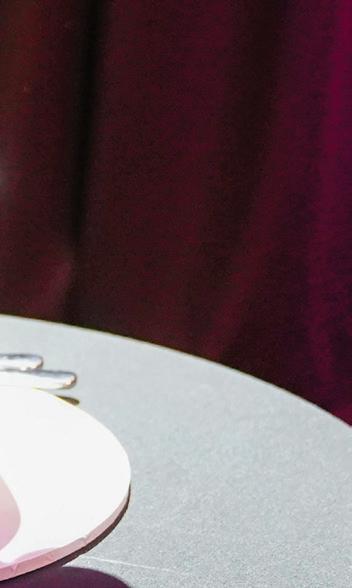
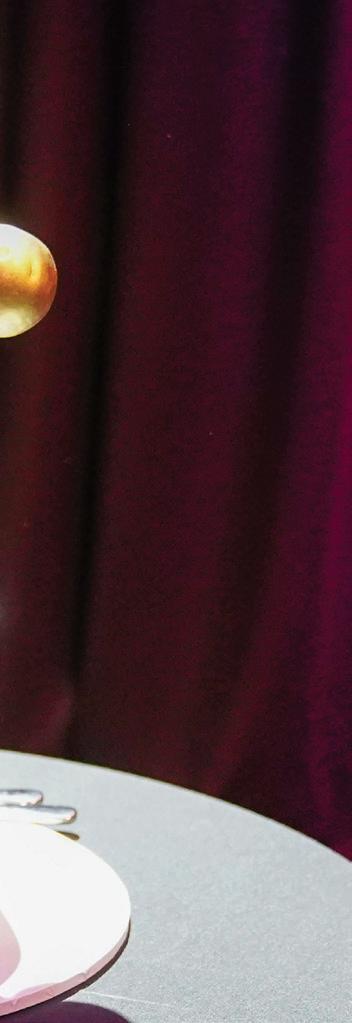



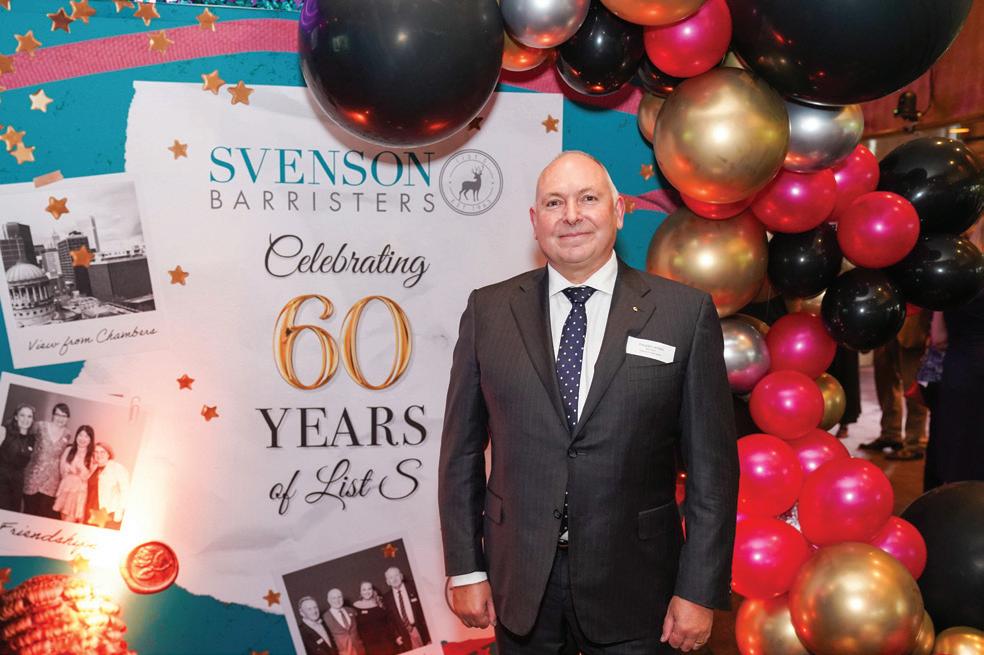
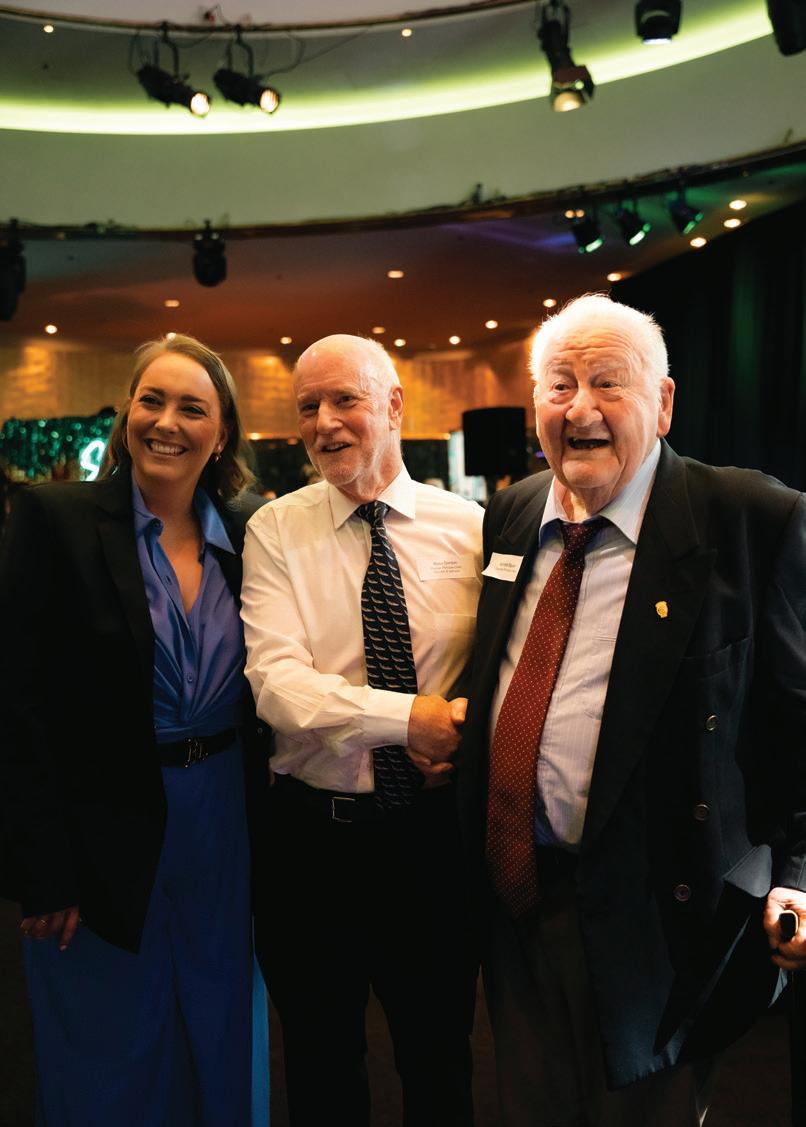
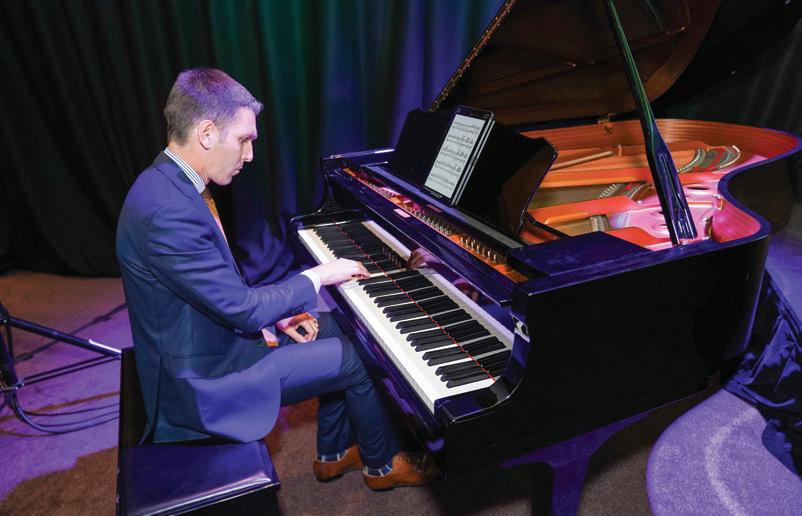
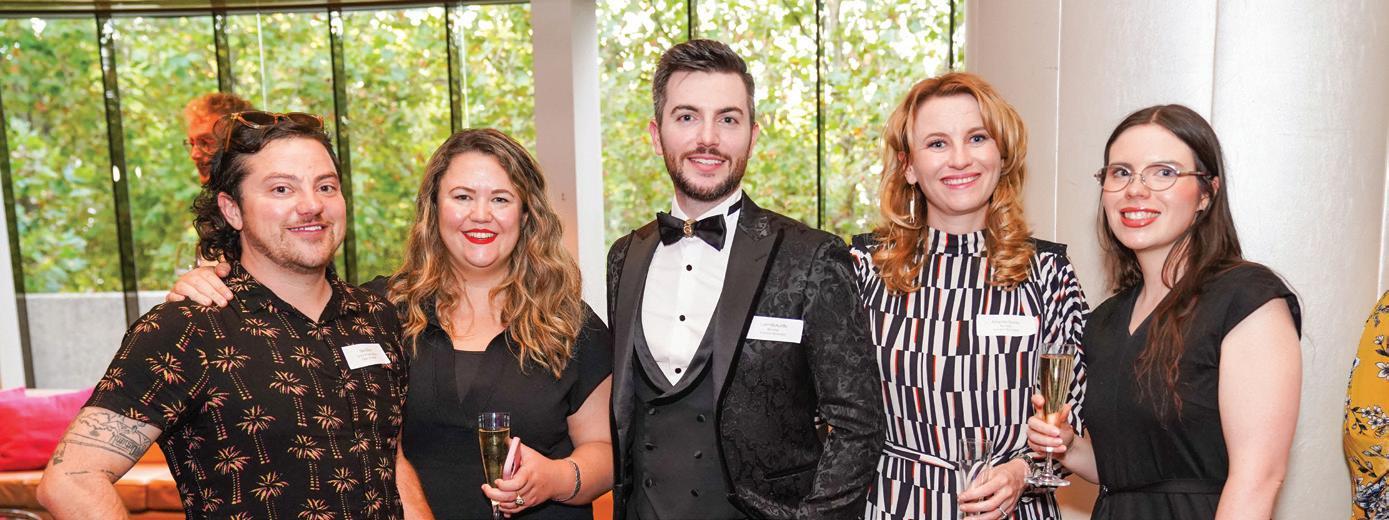
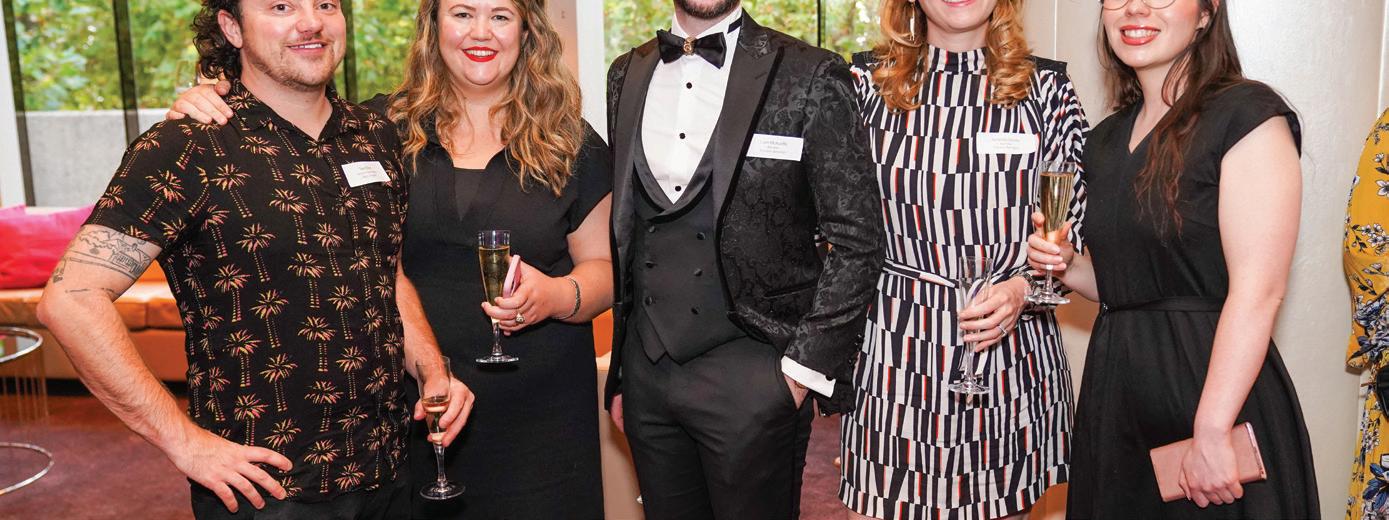
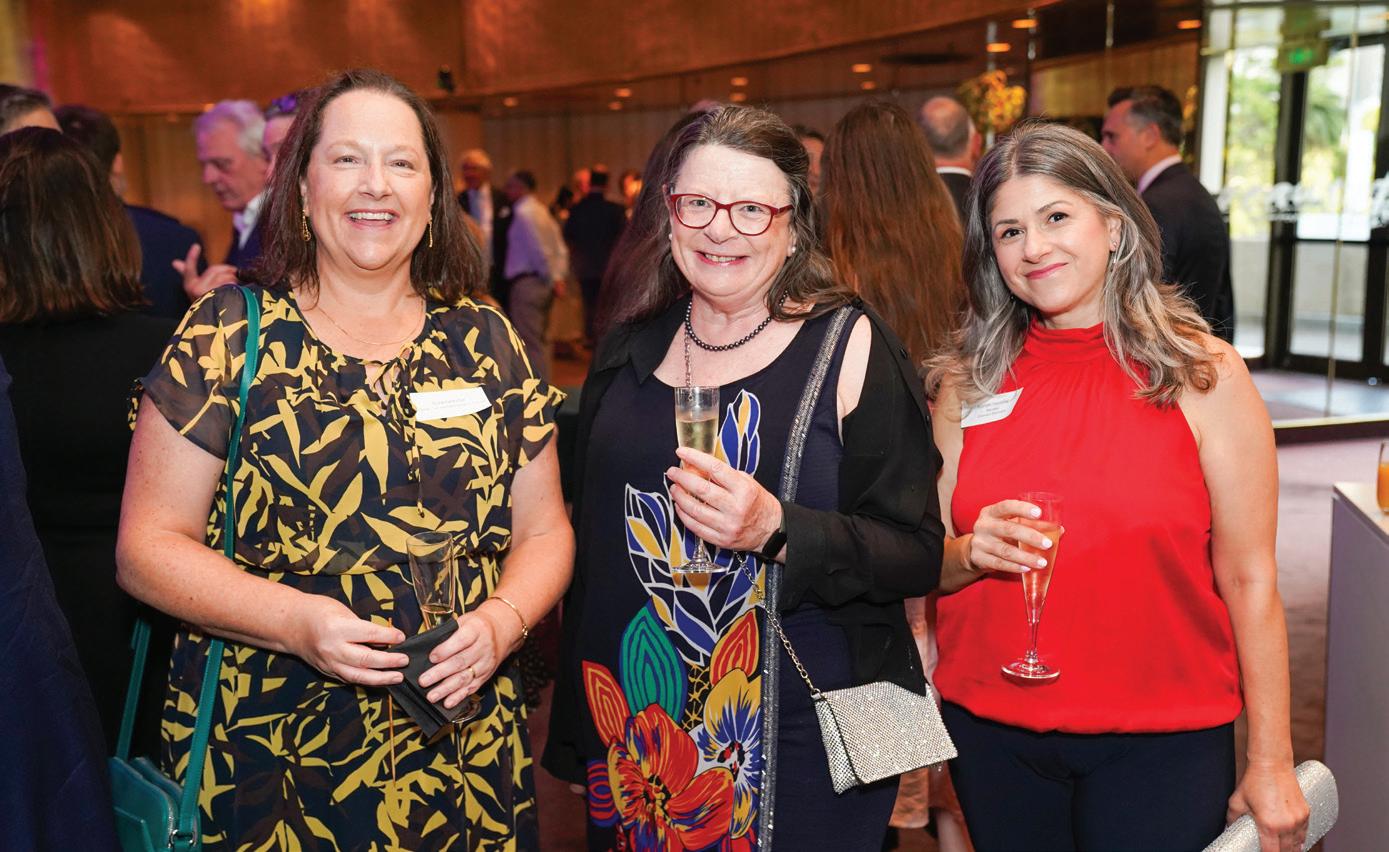

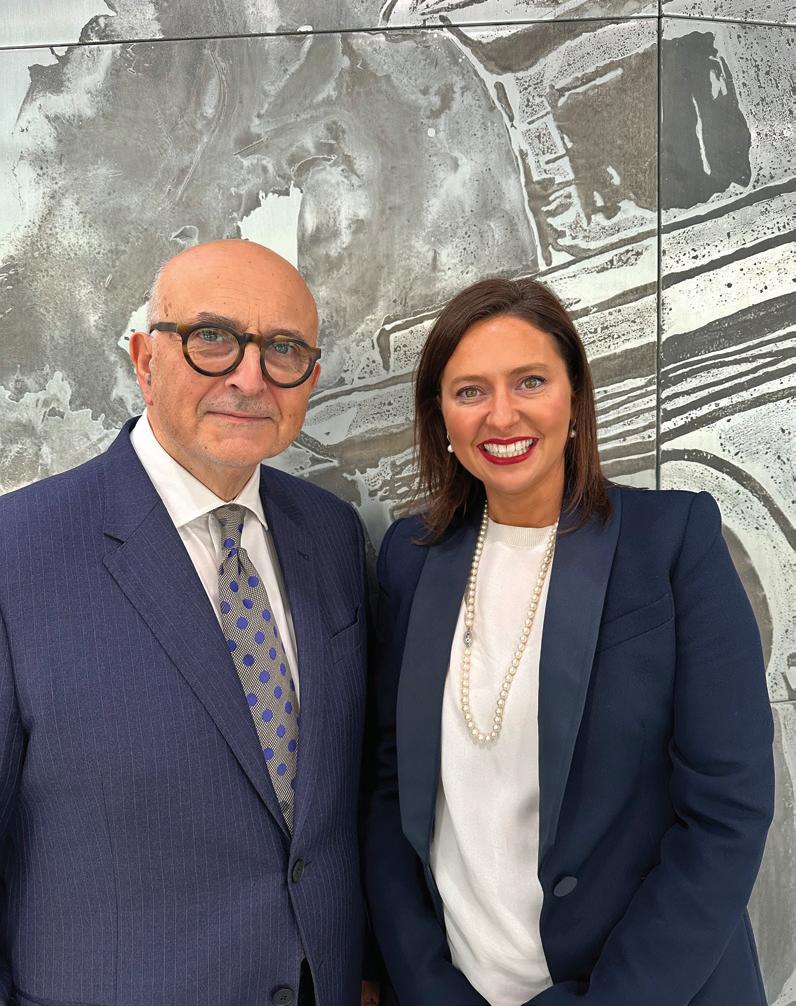
CARLY MARCS
As a fairly innumerate barrister, preoccupied with matters of criminal law, fundraising has never been in my skillset. But my seven-year-old son, Louis, is fortunate to attend a very special school called Giant Steps, which educates children on the autism spectrum. Being a member of our community school necessarily involves fundraising, because the life-changing trans-disciplinary and individualised program that Giant Steps offers each student is labour and resource intensive. For the first time in the history of Giant Steps in Melbourne, we managed to get a wonderful fundraising event off the ground, literally—a stair climb involving 96 floors and 1,700 steps. Whilst registering for the event and setting up my donation page, I received an email from an address I have come to know and cherish since 2012 when I spent time at the County Court of Victoria as strategic adviser to the much-loved former Chief Judge, Michael Rozenes KC.
The email’s author was Judge Gucciardo of the County Court. Over the past 13 years, Judge Gucciardo has regularly shared his musings on life, love, literature, philosophy, art and all the things that make life rich and meaningful, with his dedicated readership of aptly titled “Ciceronians”. In this forum, Judge Gucciardo shares stories and content from authors and thinkers he admires. The messages are educative (they always feature a bit of Latin that I have to admit putting through google translate), thought provoking and often uplifting. Significantly, in the 13 years of Cicero, Judge Gucciardo has preserved his emails as a special space for pondering the bigger questions. He has never solicited or used his vast database for any other purpose.
Without thinking, I hit reply and shared my newly established fundraising page with Judge Gucciardo:
Long time. I hope this finds you well. Please don’t hesitate to say no if this request is a little too much but I was thinking about your regular email musings (which I thoroughly enjoy) and how broad your reach is. I was wondering how you might feel about sharing my fundraising efforts below?
Judge Gucciardo kindly shared my request with his database, which includes sitting and retired judicial officers. Matt Parnell and Sharon Noorman from Parnell’s Barristers also shared my request with the entire list, and I distributed the link to my own networks at the Bar.
What happened next is a testament to the generosity and collegiality of the Bench and our Bar. Donations rolled in from far and wide. At the time of writing, I have managed to raise over $34,000. I have been humbled and deeply moved by the extraordinary generosity of barristers and judicial officers. I could never have expected such generous donations and messages of support and encouragement.
Life as a special needs parent can be challenging, but sometimes, also uplifting. For every angry stranger glaring at me in the supermarket because my son has touched their pumpkin whilst stimming1, there are barristers and judges supporting him and me and thereby erasing any shame we might sometimes experience.
When we come together as a legal community, we can do amazing things. Words like gratitude and appreciation can’t convey how this has made me and my family feel.
1 A self-stimulatory behaviour.


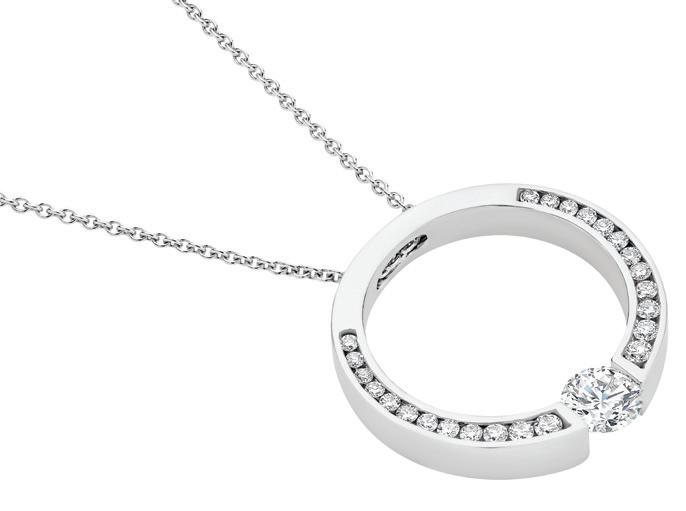




PLAZA BALLROOM, MAY 26 2023
This year’s Bar Dinner was held at the Plaza Ballroom, on a chilly night in late May. Undeterred by strong winds, members of Bar and Bench donned their best for a night of canapes and conviviality.
This year’s event featured pared-back formalities, overseen by MC Elle Nikou Madalin. A welcome by Bar President Sam Hay KC was followed by a thoughtful and amusing speech by the Solicitor-General of Australia— the Bar’s own Dr Stephen Donaghue KC—who was himself welcomed and thanked by Vice-Presidents Georgina Schoff KC and Elizabeth Bennett SC. Ably assisted by his “junior”, ChatGPT, Dr Donaghue KC deftly stitched together musings on the dilemma presented by an invitation to speak at the Bar Dinner and sincere comment on the upcoming referendum, also offering words of support and wisdom to the newest members of our ranks. Threats to embark on an exploration of vehicle usage charges and section 90 of the Constitution came to nothing.
Amusing though the speeches and toasts were, guests also enjoyed the opportunity for extended mingling and catch-ups that the new program offered. And then there was the dancefloor, fuelled by the music of Emmerson Dodge, feat. Georgia Caine and Peter Wallis KC on vocals, Chris Brodrick (guitar/vocals), Andrew McRobert (guitar), Ed Heerey KC (bass), Justin Wheelahan (keyboard), the Hon Justice McNab (saxophone) and Bar News’ very own Peter Barrett on drums. But enough of the details, we know it’s really all about the photos…


1. Adam Awty, Amanda Utt, the Hon Ken Hayne AC KC, Chief Magistrate Justice Hannan 2. Kylie Evans, Jenny Firkin KC, Meg O’Sullivan KC 3. Natalie Campbell, Helen Tiplady 4. Chief Judge Kidd, the Hon Justice Steward, Anthony Howard AM KC 5. Gisela Nip, Michael Thomas, Nicholas Petrie, Yusur Al Azawi 6. Elizabeth Bennett SC, David Shavin KC, Georgina Schoff KC 7. The Hon Jack Rush AO RFD KC, Antony Berger, Dr Michael Rush KC 8. Johannes Angenent, Raph Ajzensztat, Maria Pilipasidis SC, Brendan Johnson, Ian McDonald KC 9. Elle Nikou Madalin 10. The Hon Associate Justice Steffensen, Sam Hay KC, Raini Zambelli



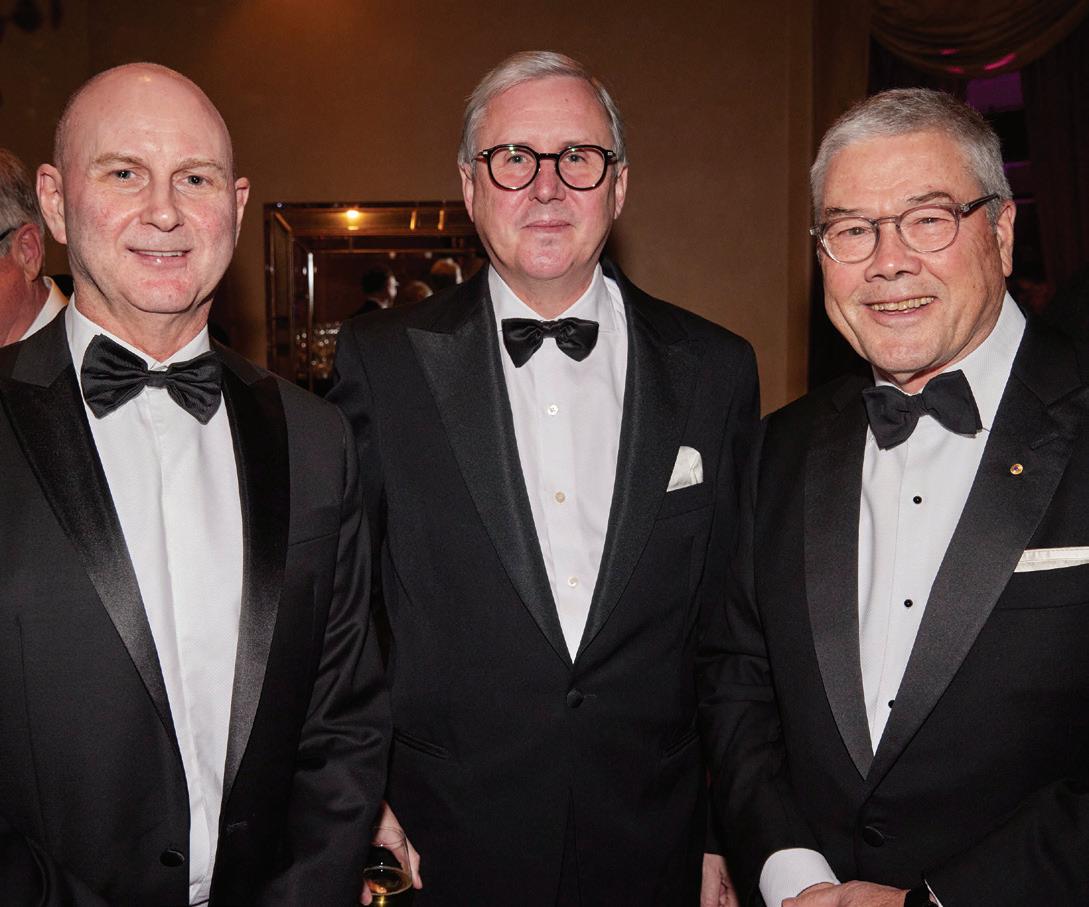
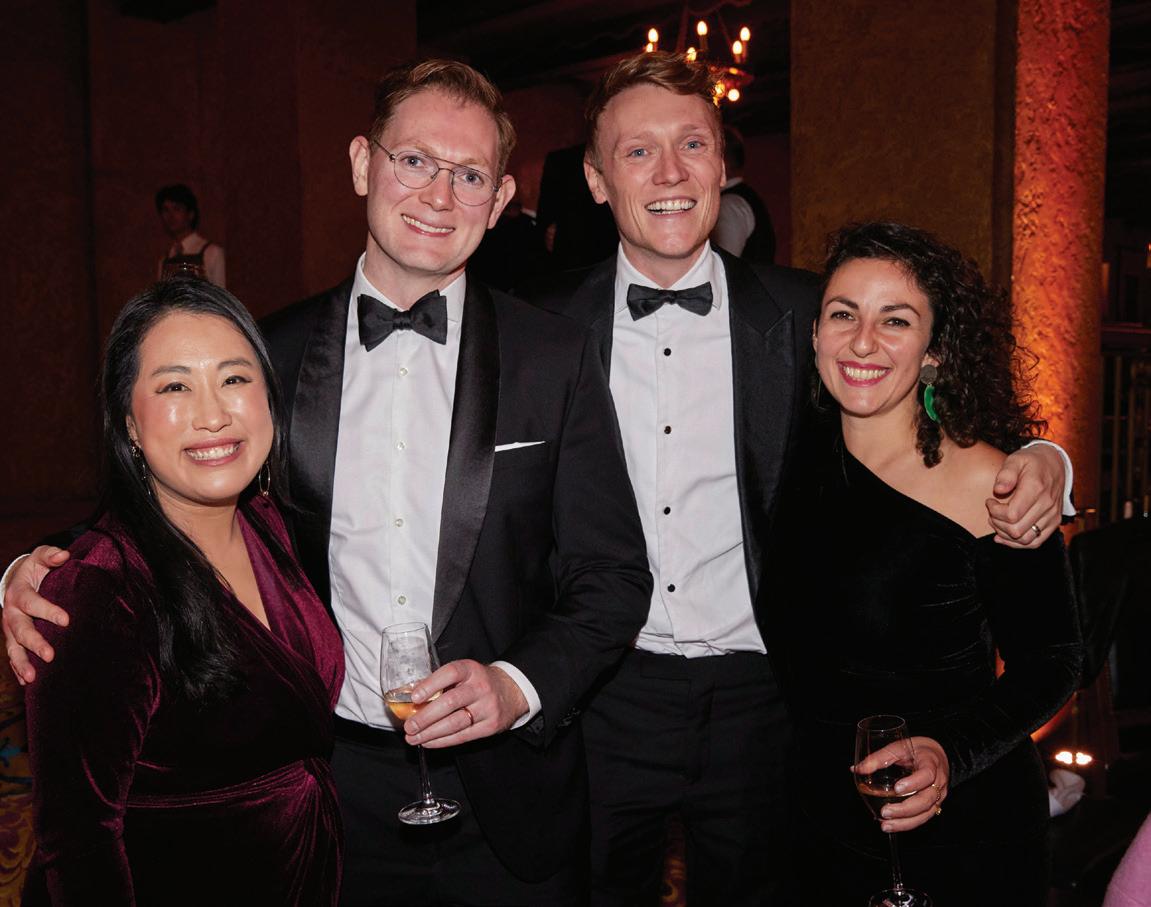
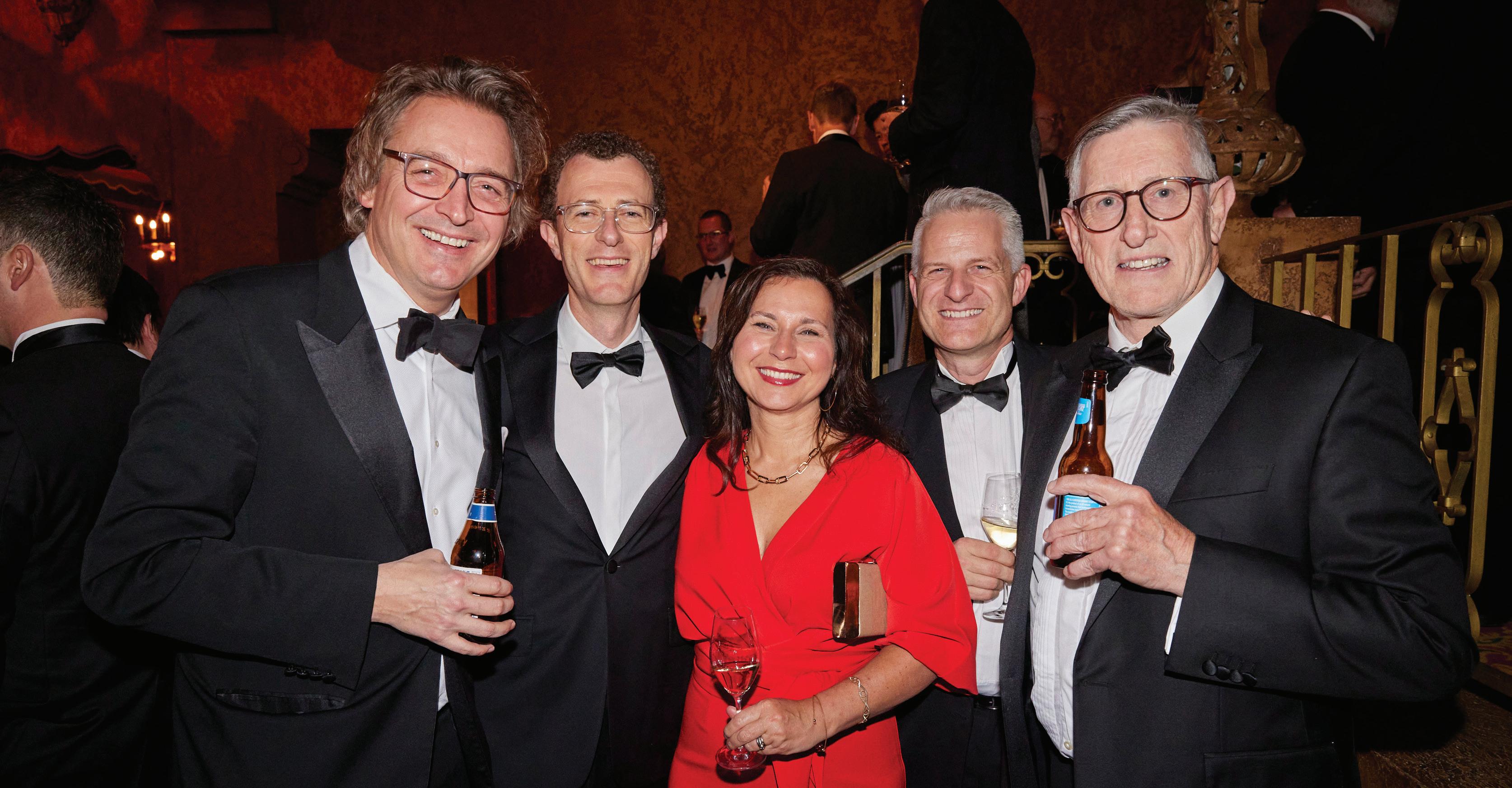

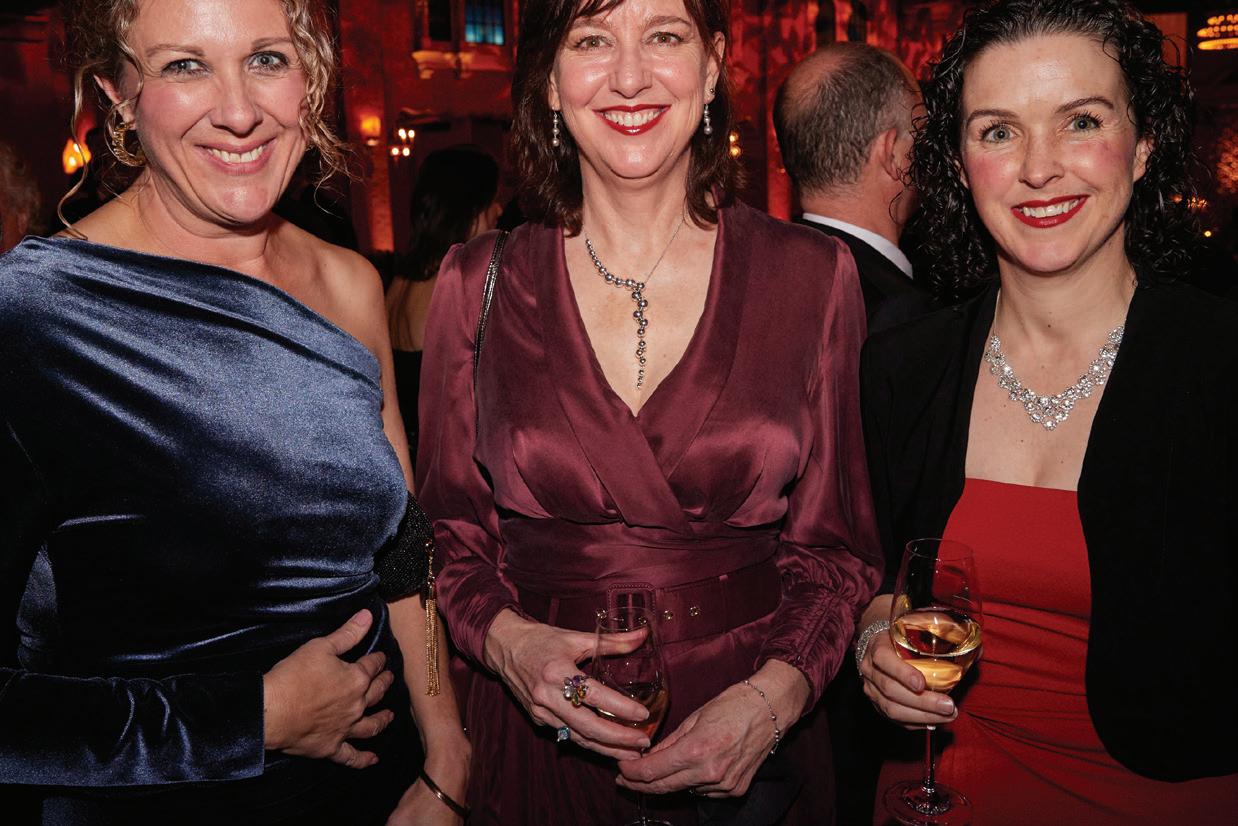
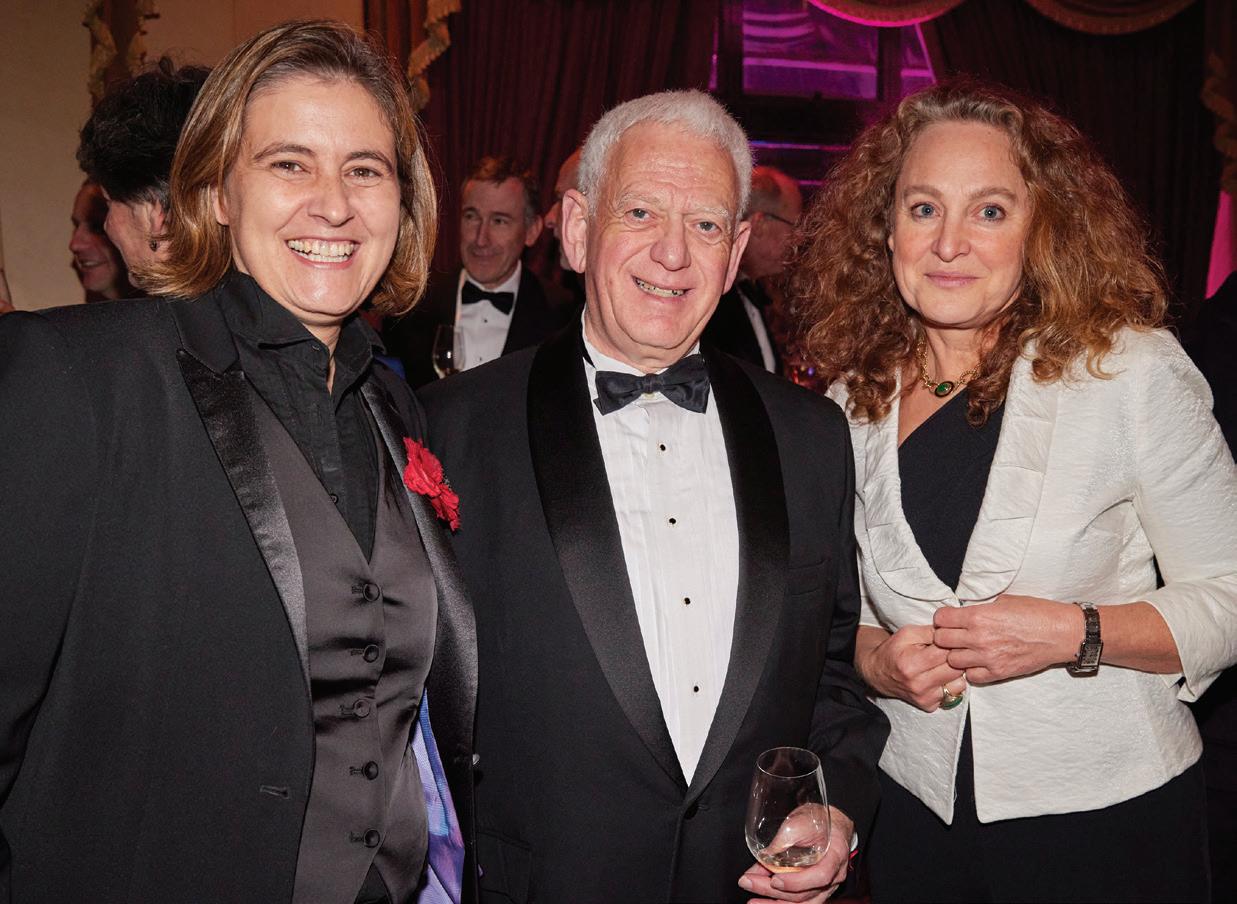

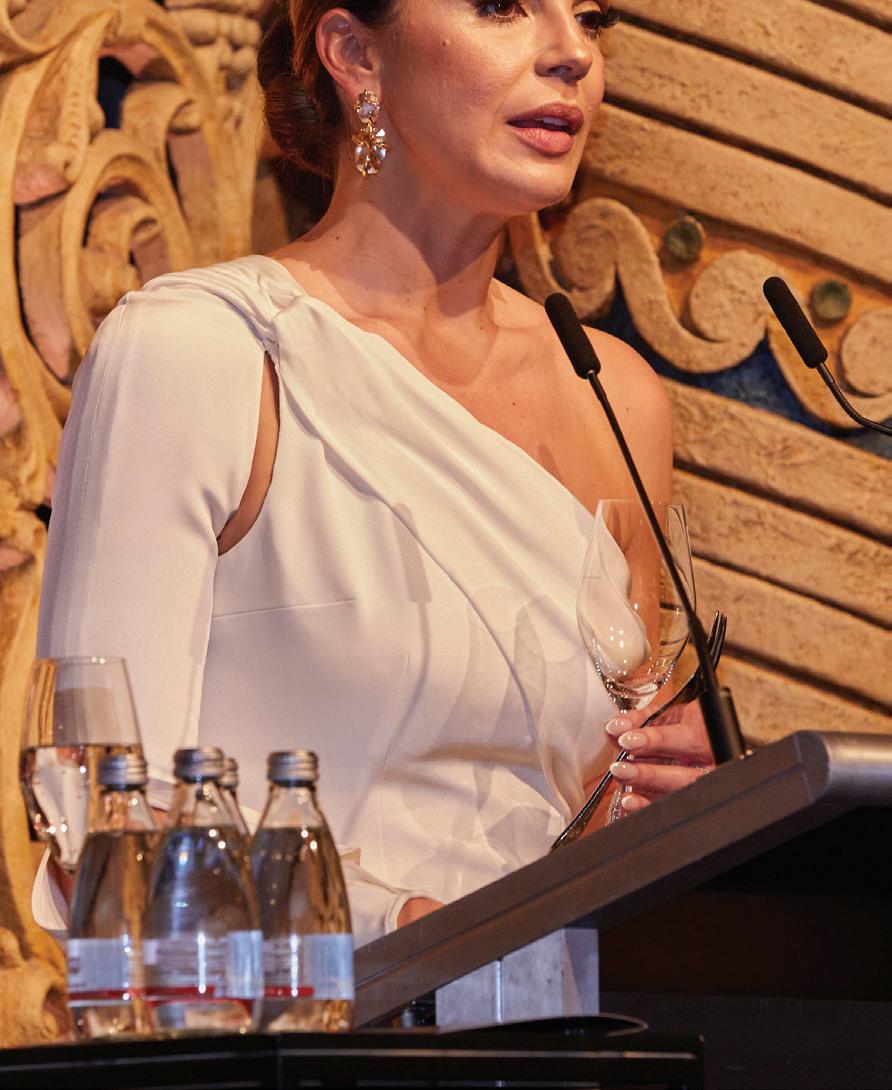

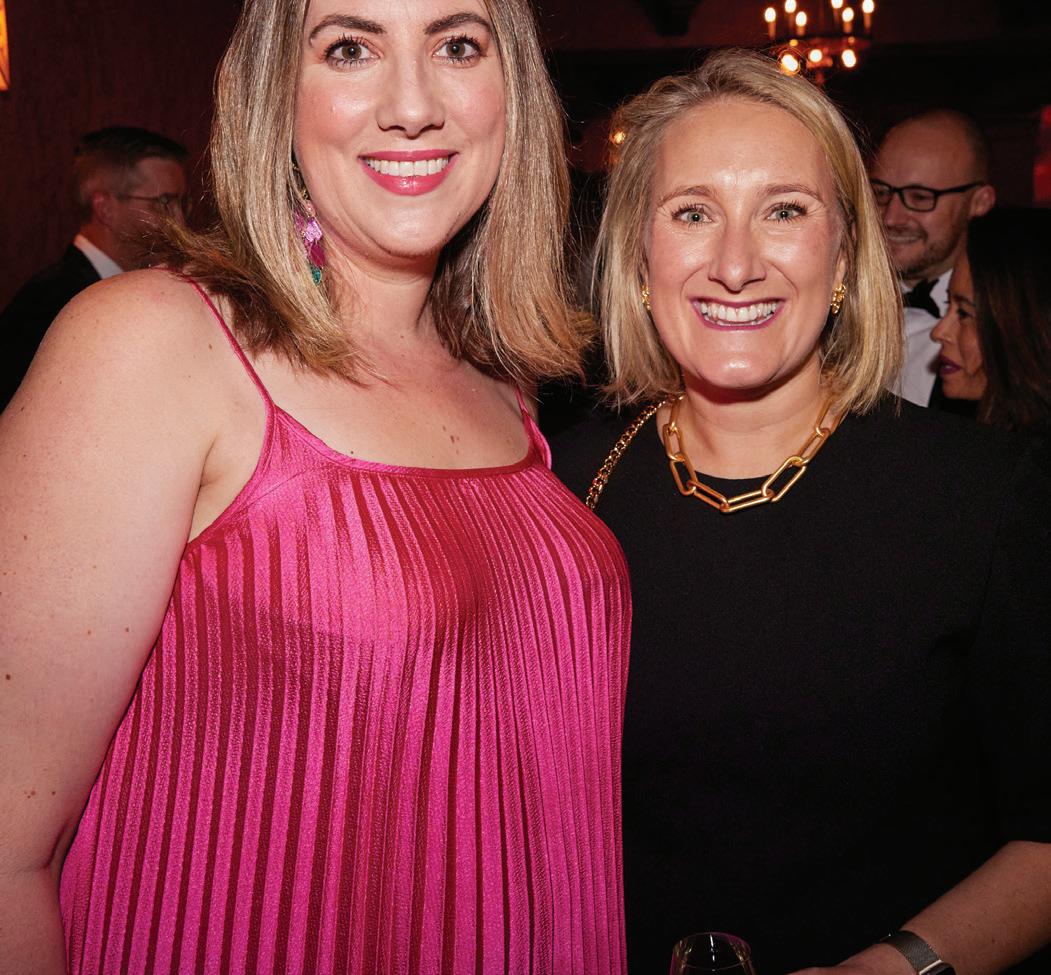
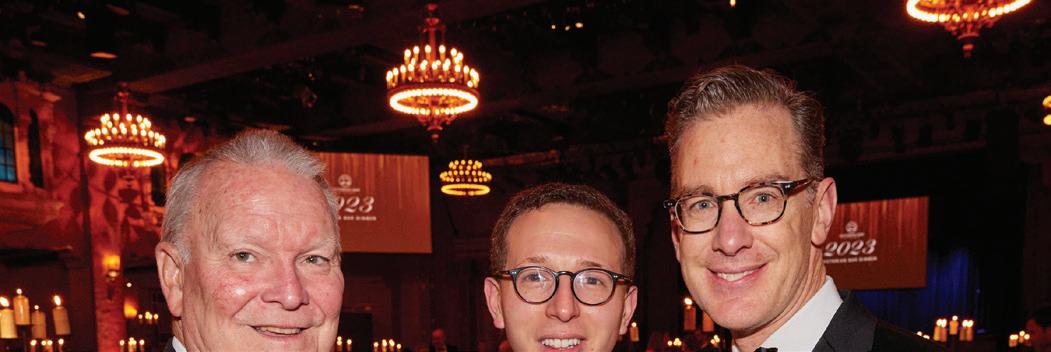
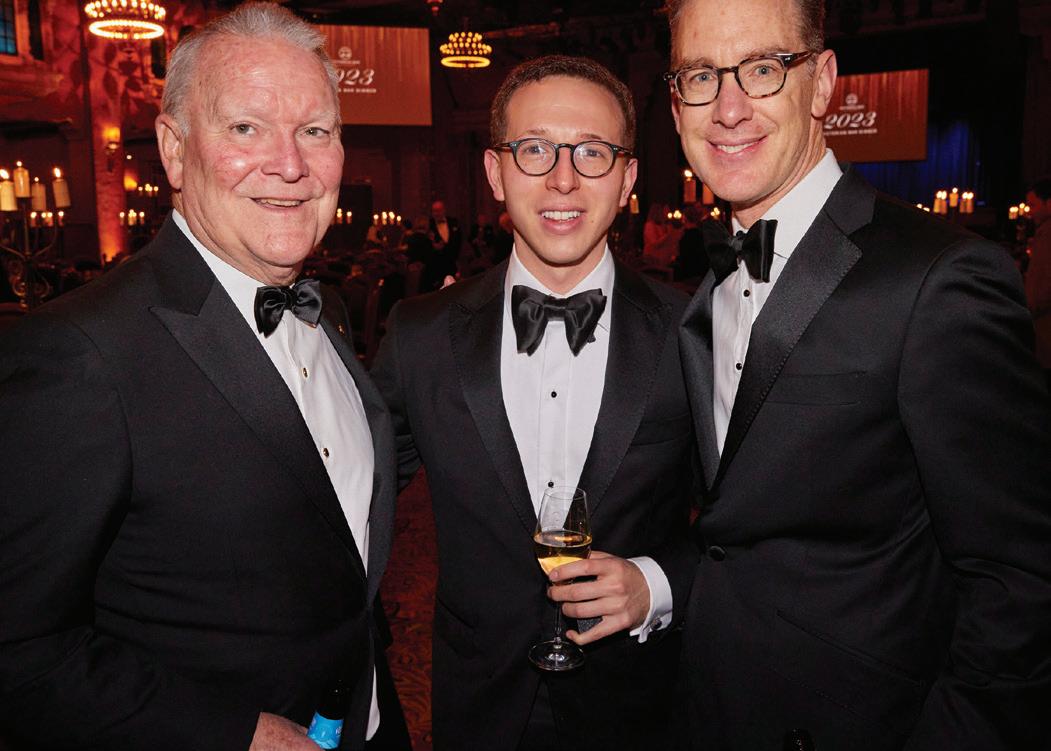
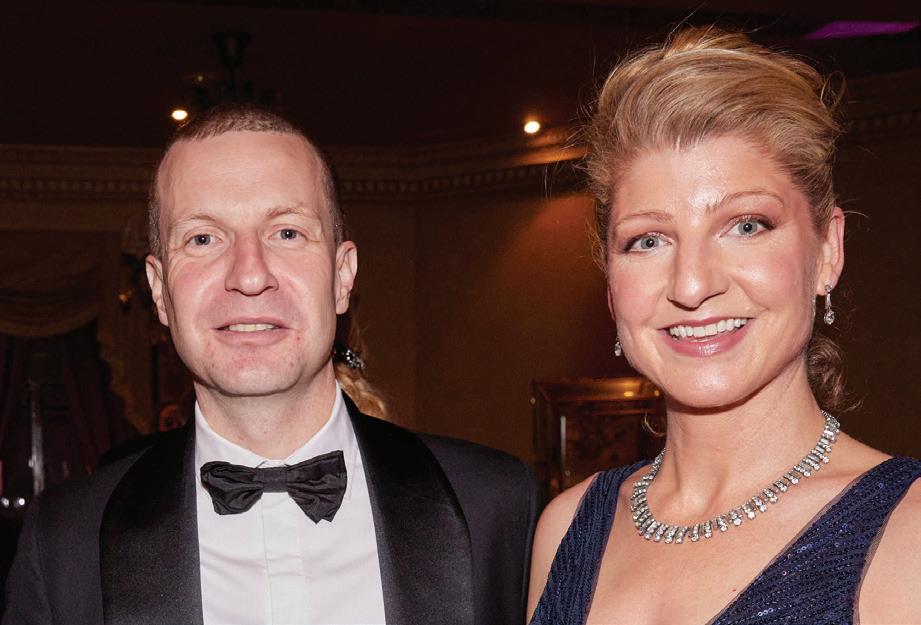
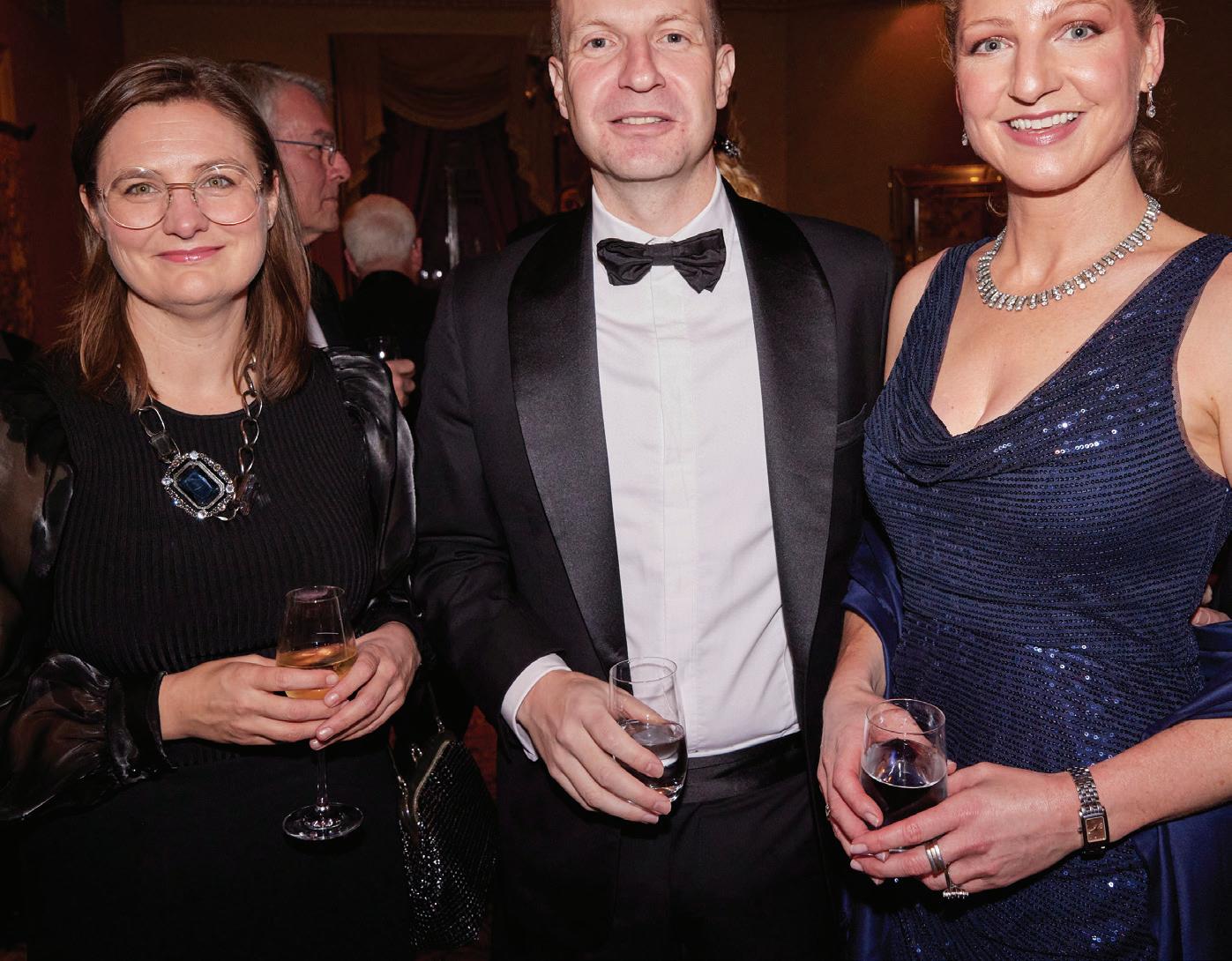

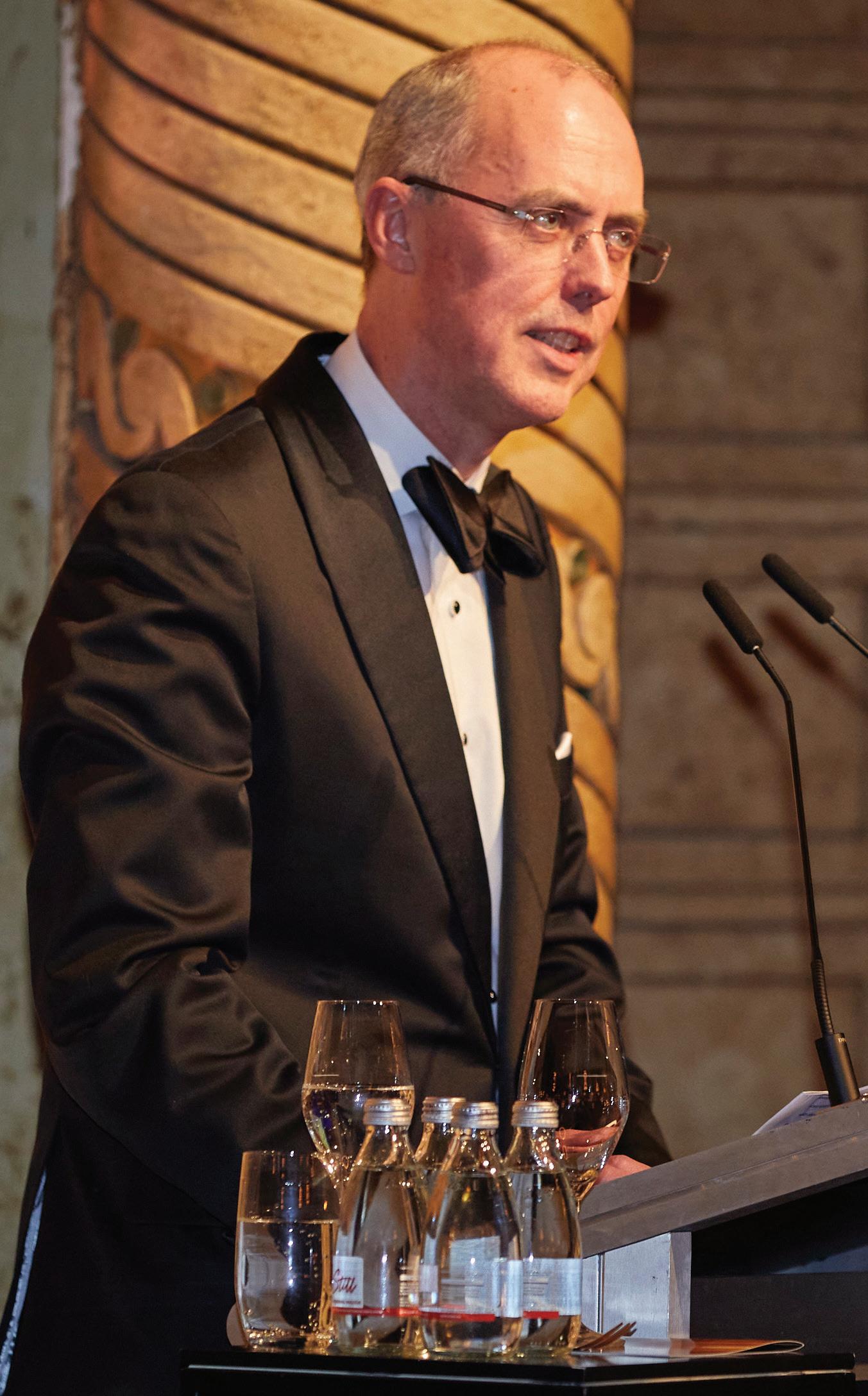

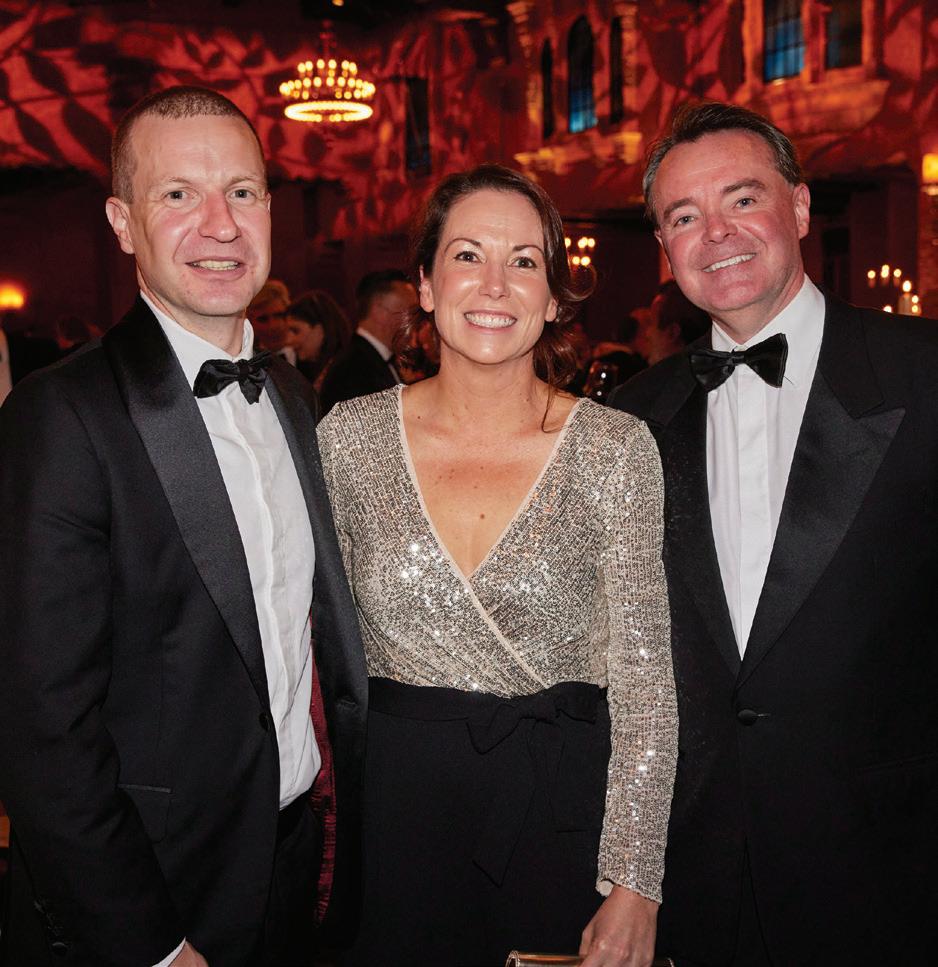
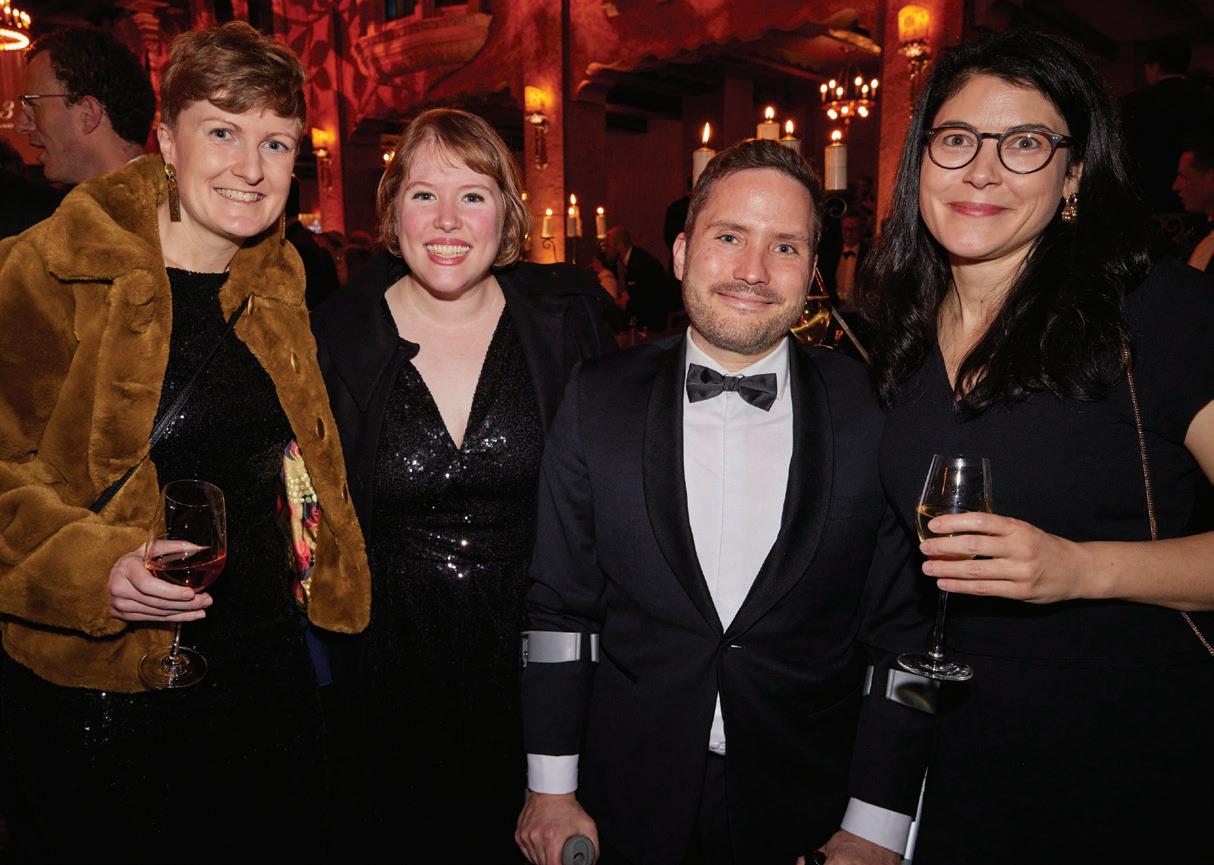

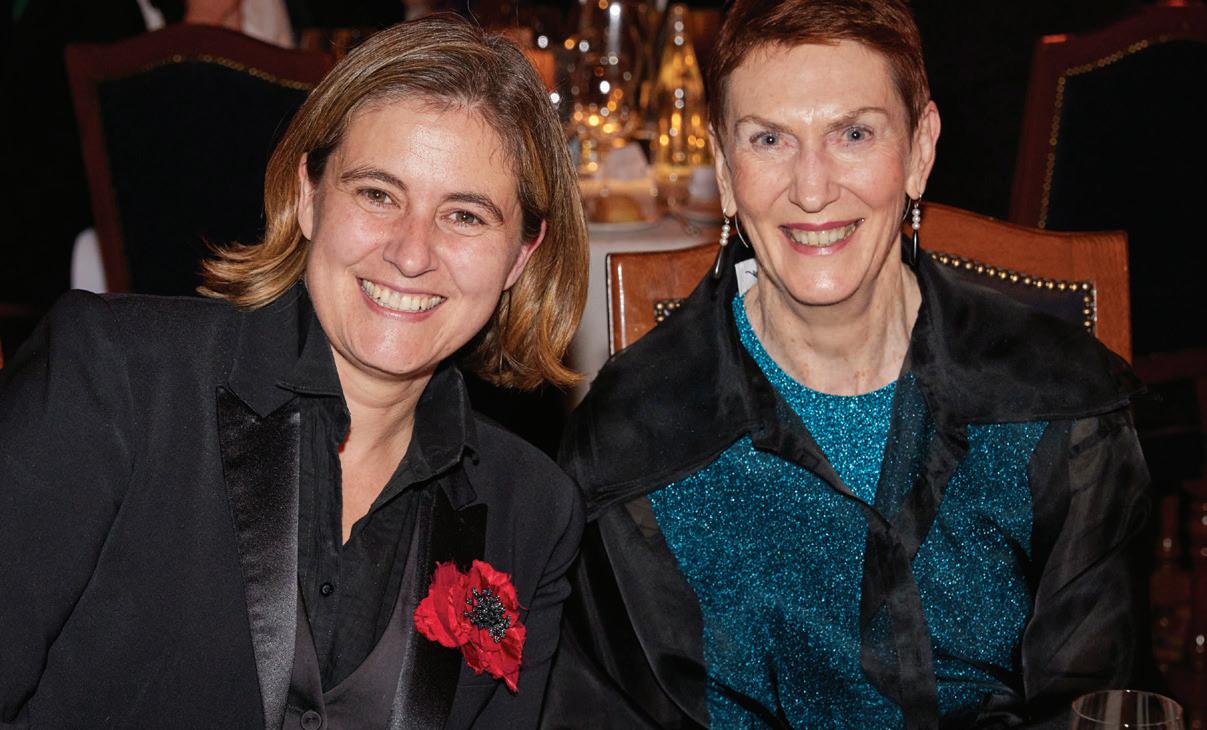
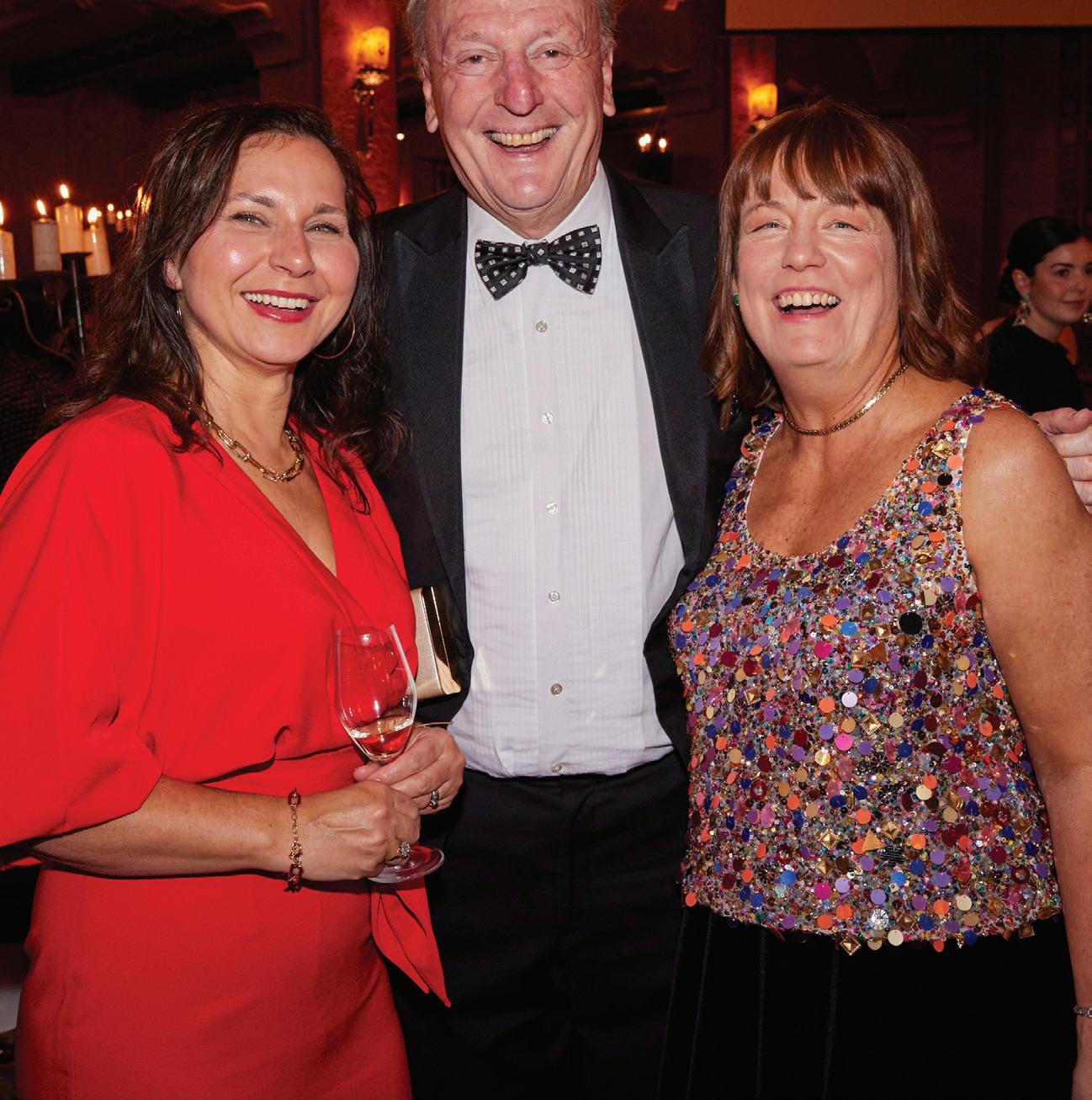
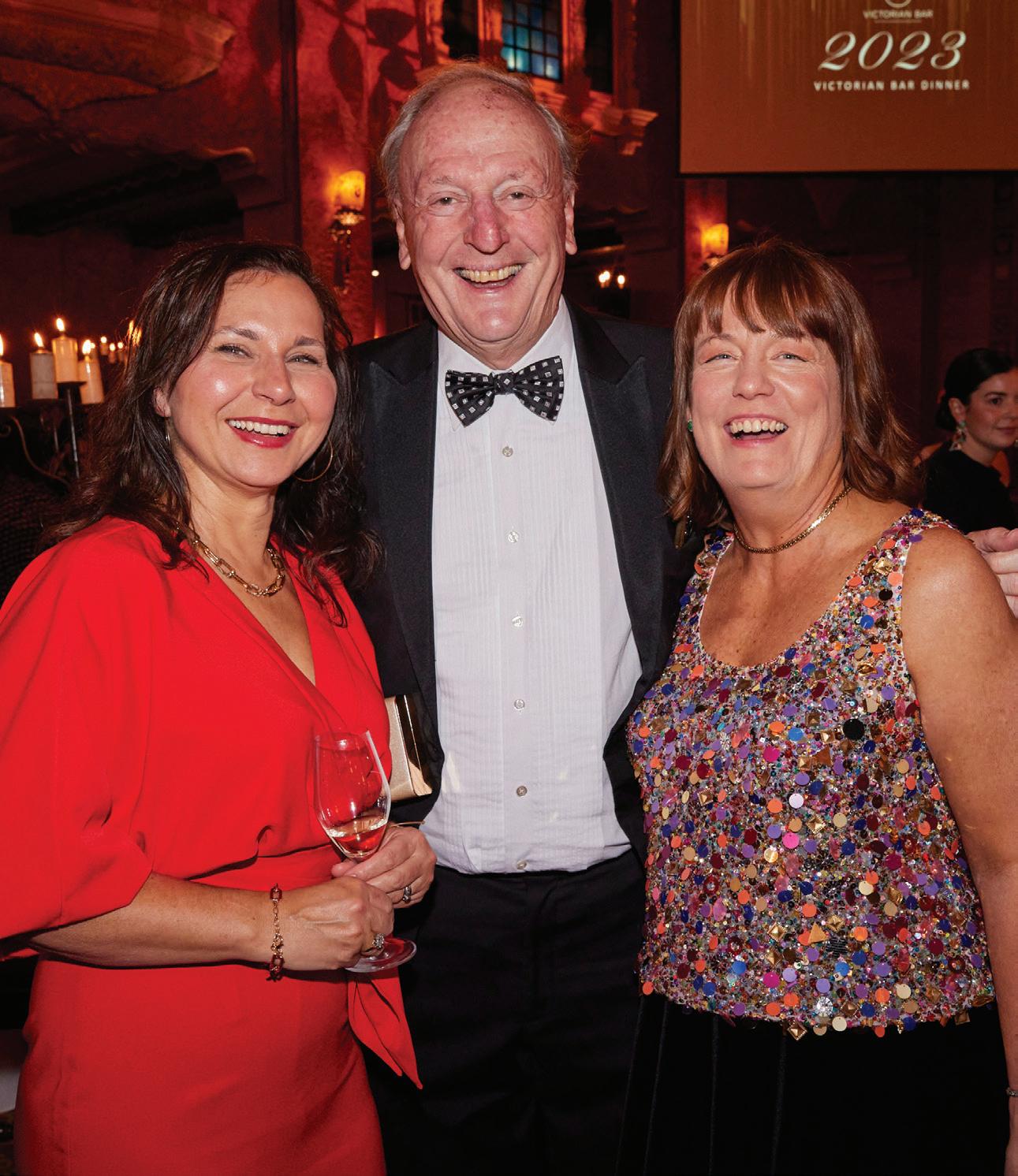

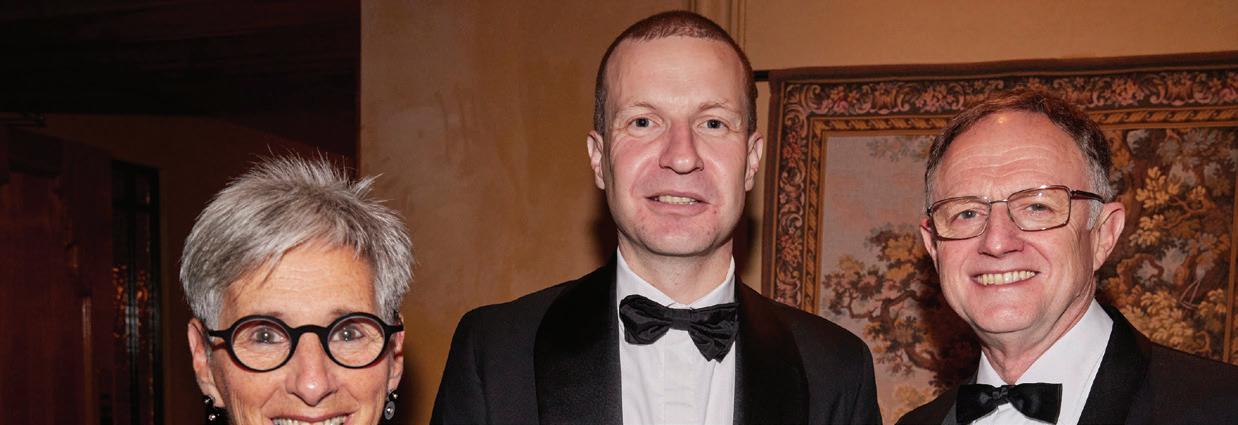
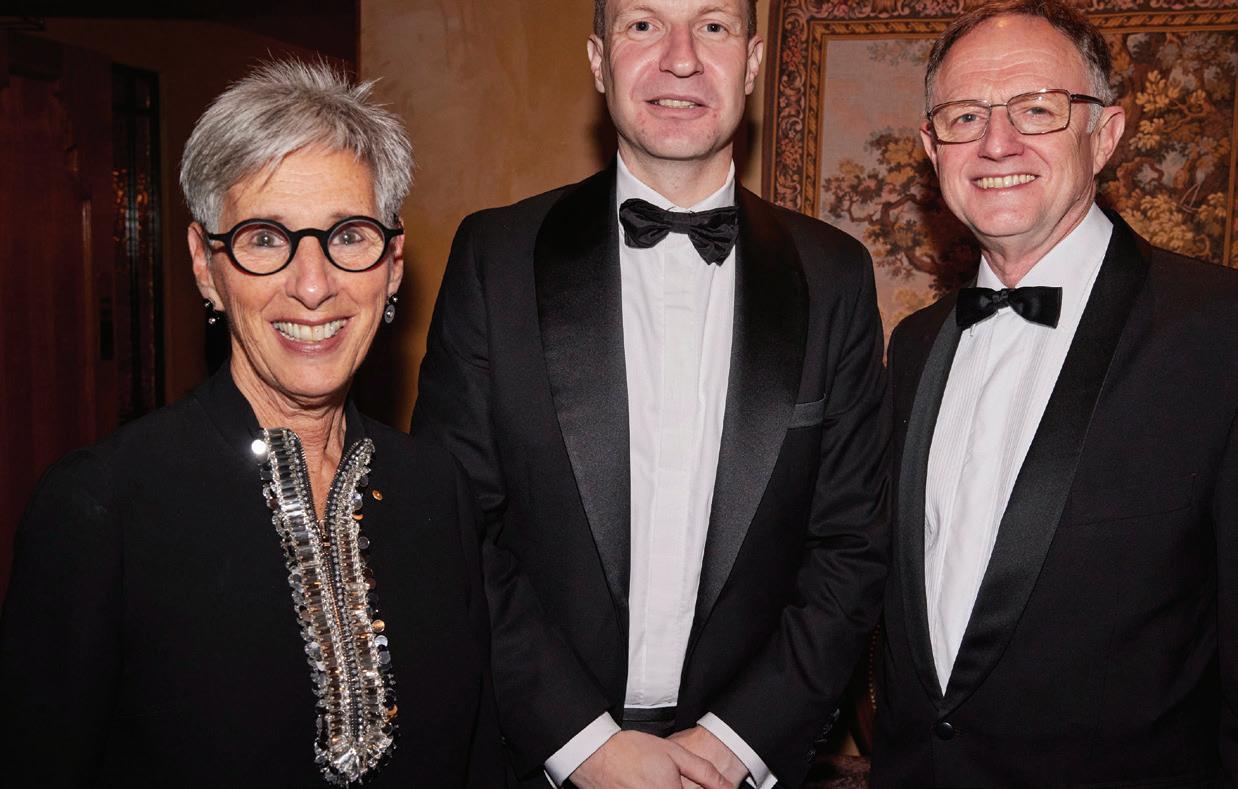
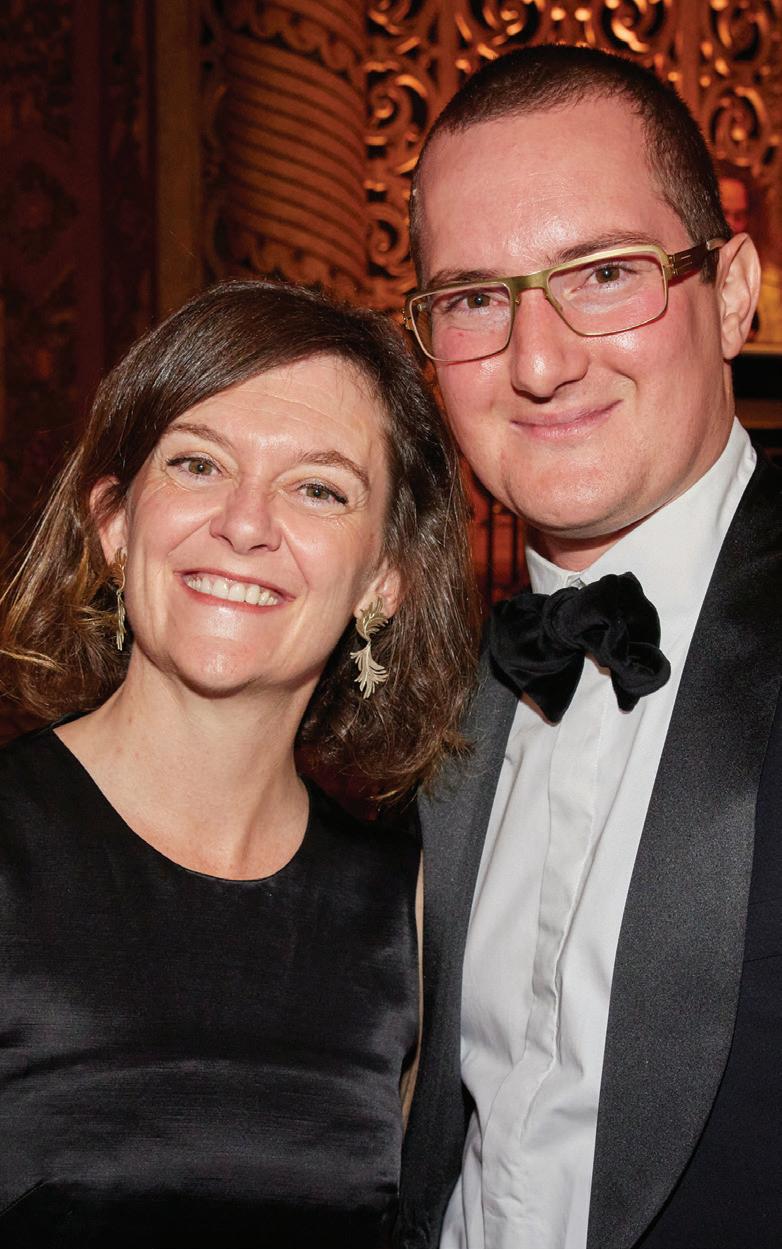

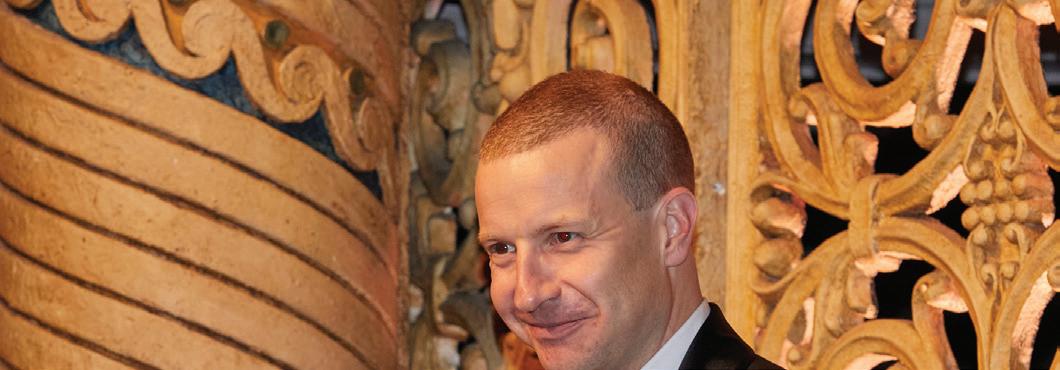
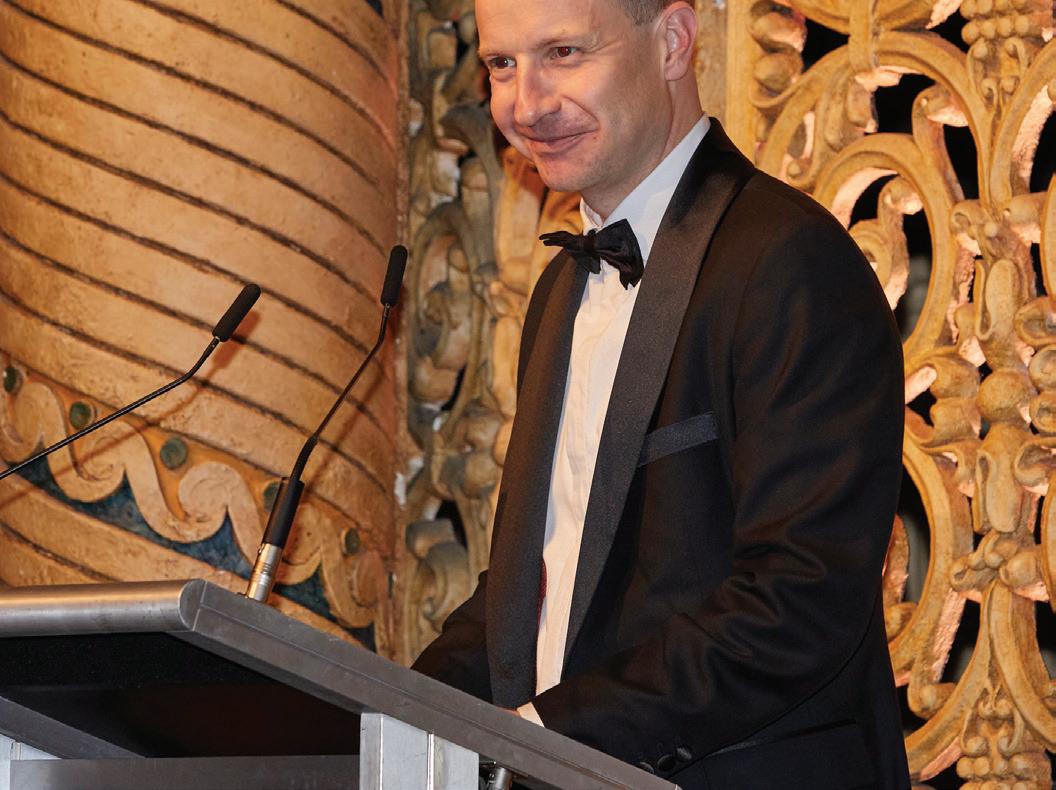
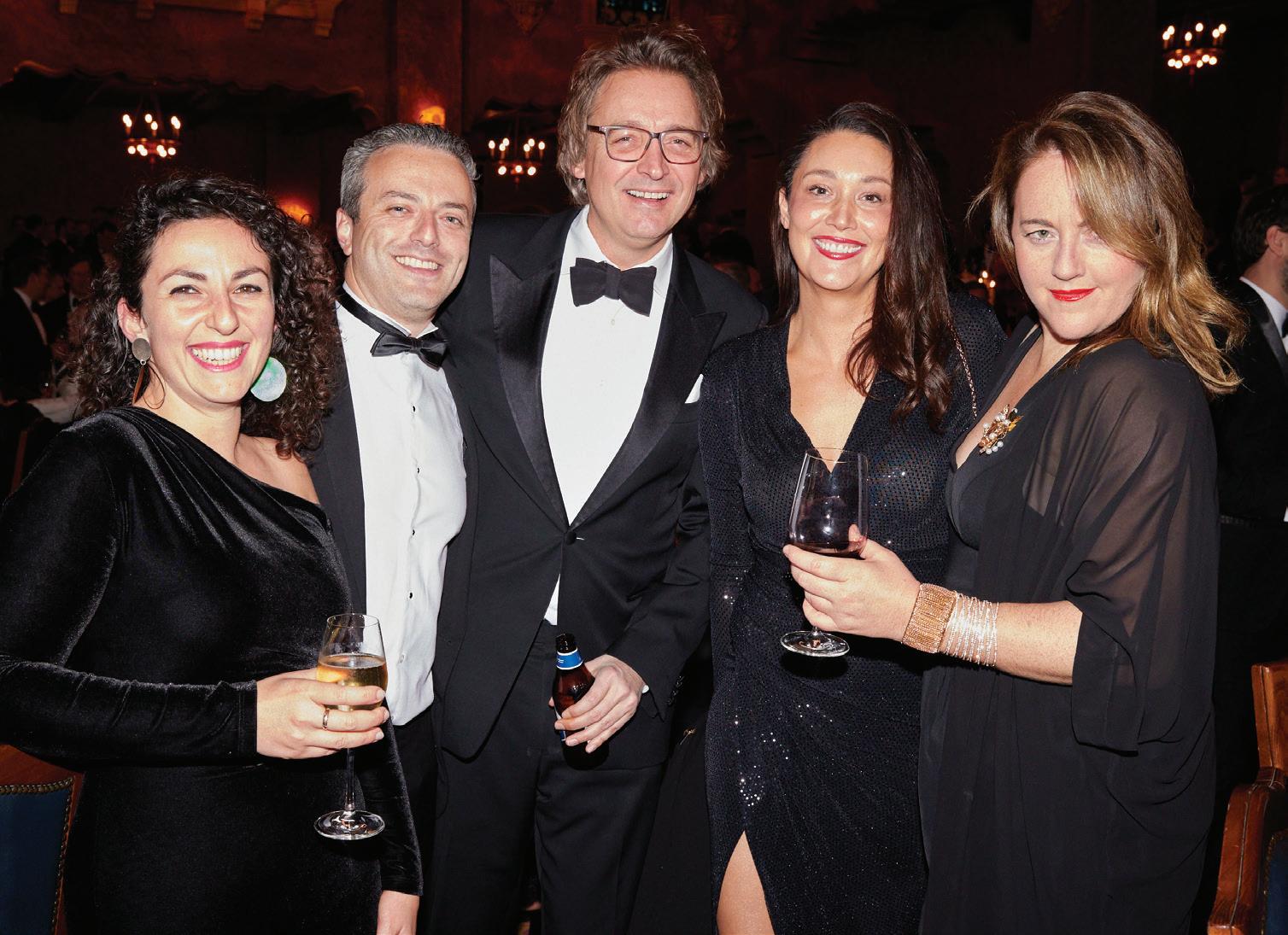


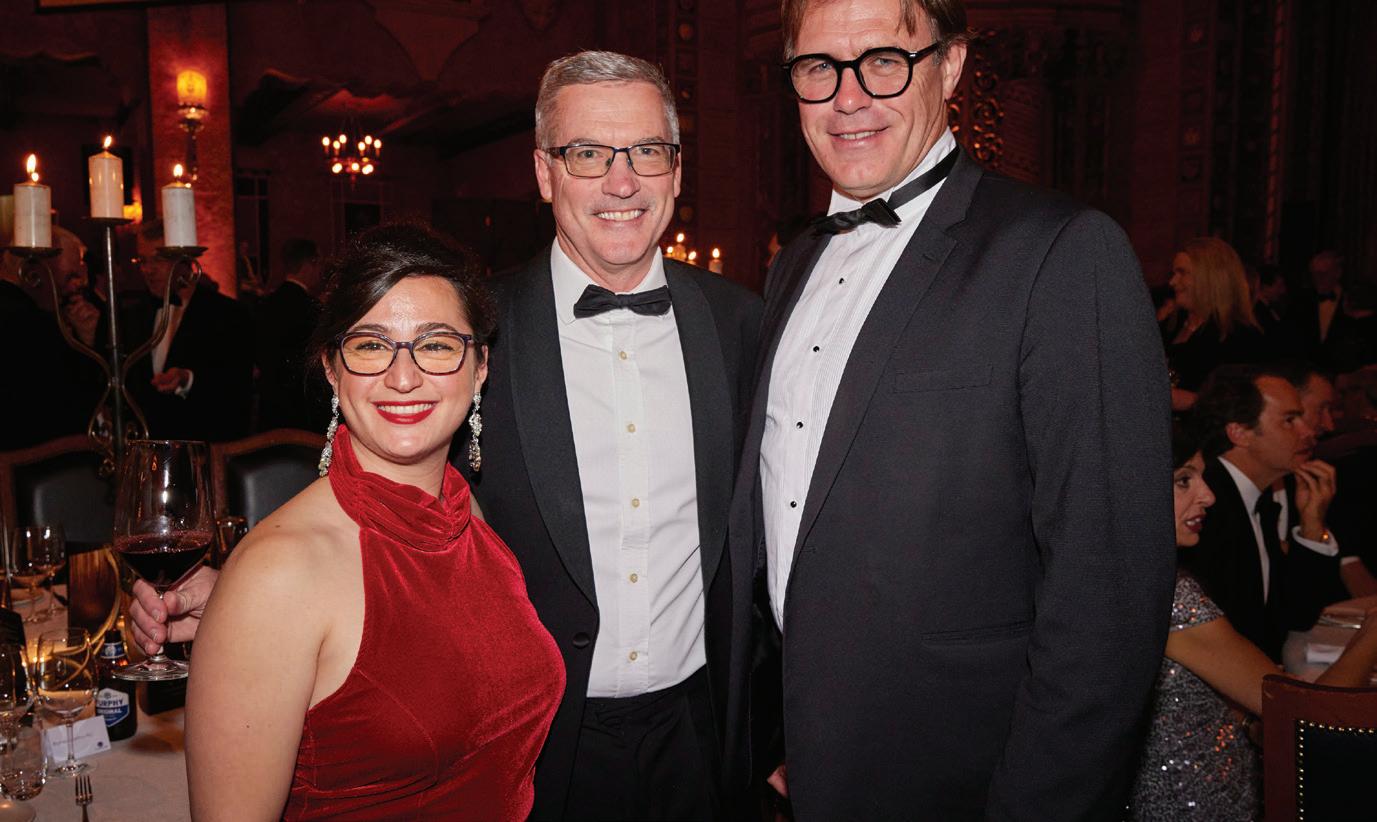
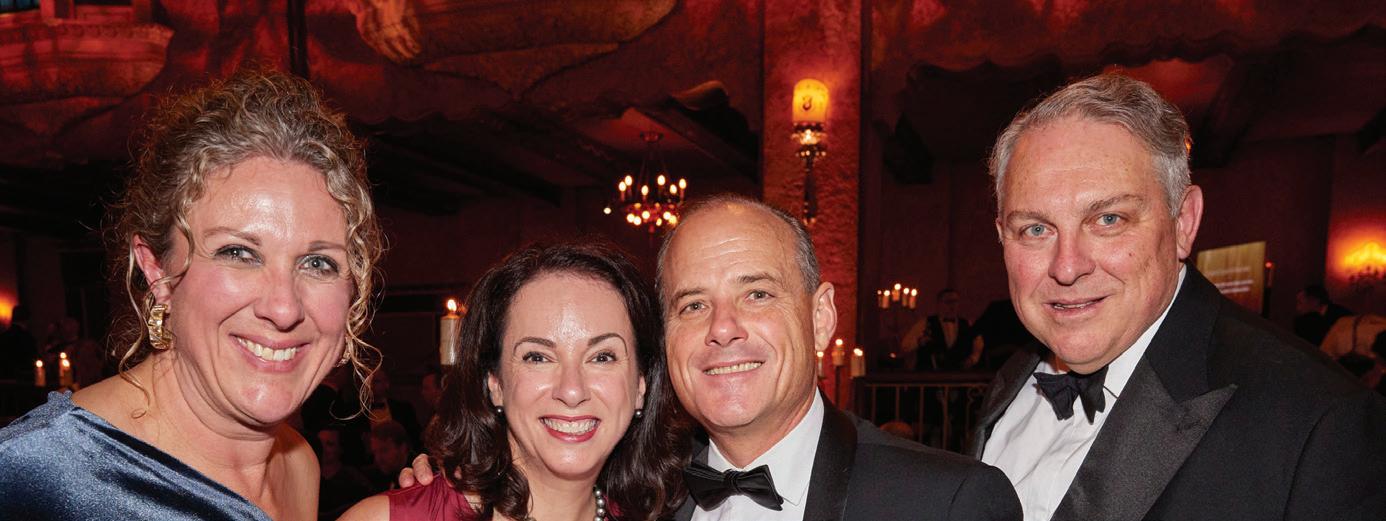
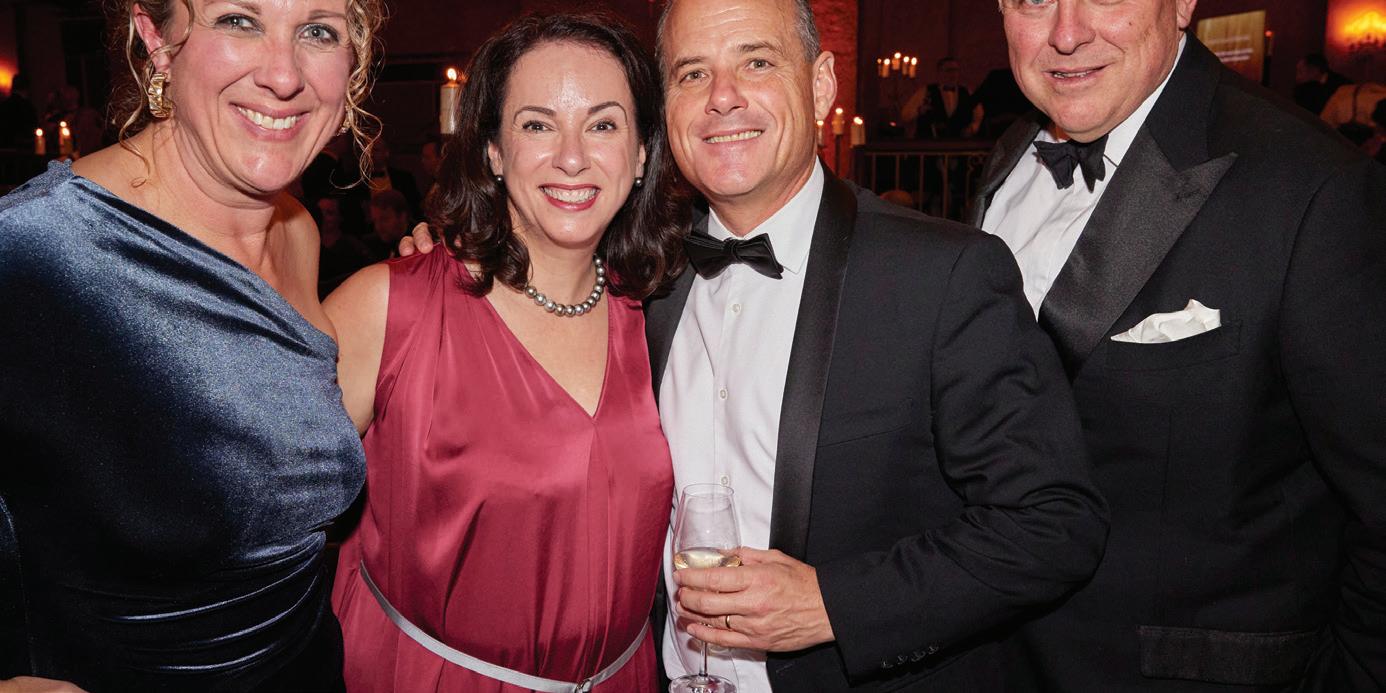
1. Nawaar Hassan, Richard Dalton KC, Shane Lethlean 2. John Karkar KC and The Hon. Gregory Howard Garde AO RFD KC 3 Georgina Schoff KC, Dr Stephen Donaghue KC 4. The Hon Mark Dreyfus KC MP, Sam Hay KC, the Hon Linda Dessau AC CVO 5. Kylie Evans, Lisa Hannon KC, Damien O’Brien KC, Paul Hayes KC 6. Claire Harris KC, Maree Norton 7. Laurence Fudim, Rhiannon Saint, Olivia Callahan, Pinar Tat, Cheryl Richardson, Jade Ryan 8. Amanda Utt, Georgina Costello KC, Georgina Schoff KC, Catherine Boston 9. Rachel Amamoo, Maya Narayan, Edwina Smith, Monika Pekevska, Katherine Brown, the Hon Chief Justice Ferguson 10. Felicity Fox, Hamish McAvaney, Edward Moore 11 David Heaton, Dr Sue McNicol AM KC, the Hon Ken Hayne AC KC
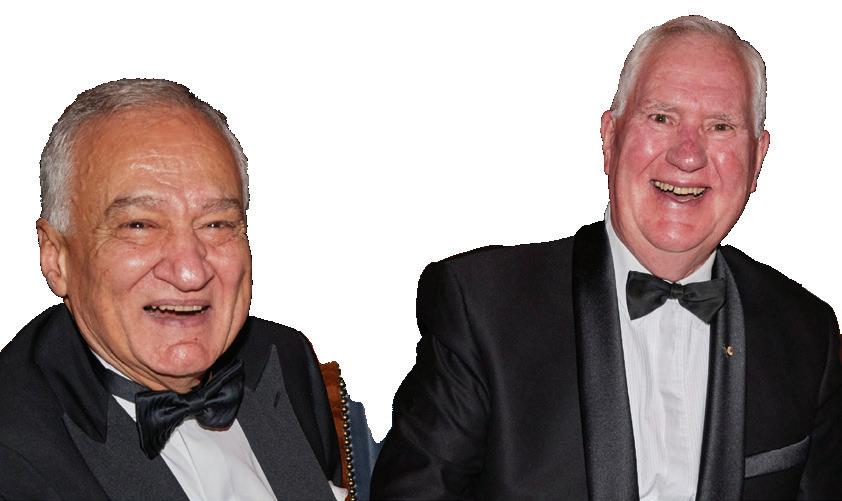
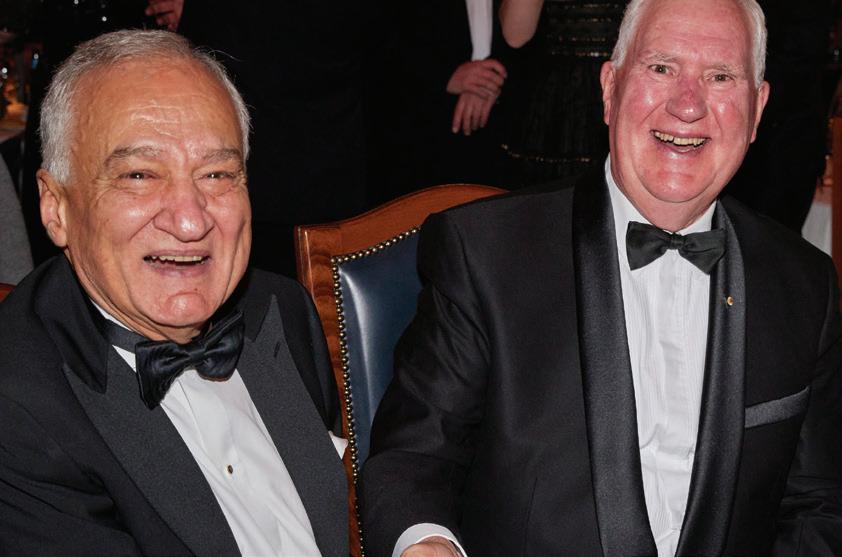
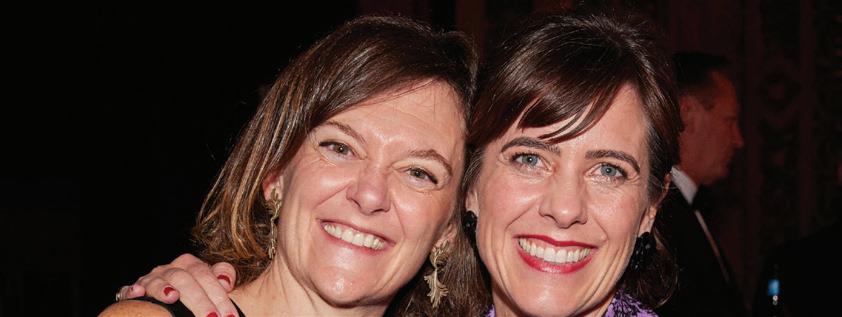
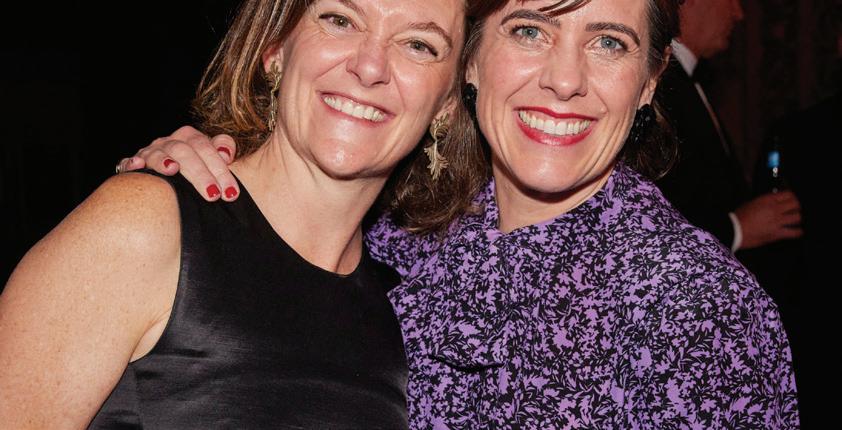
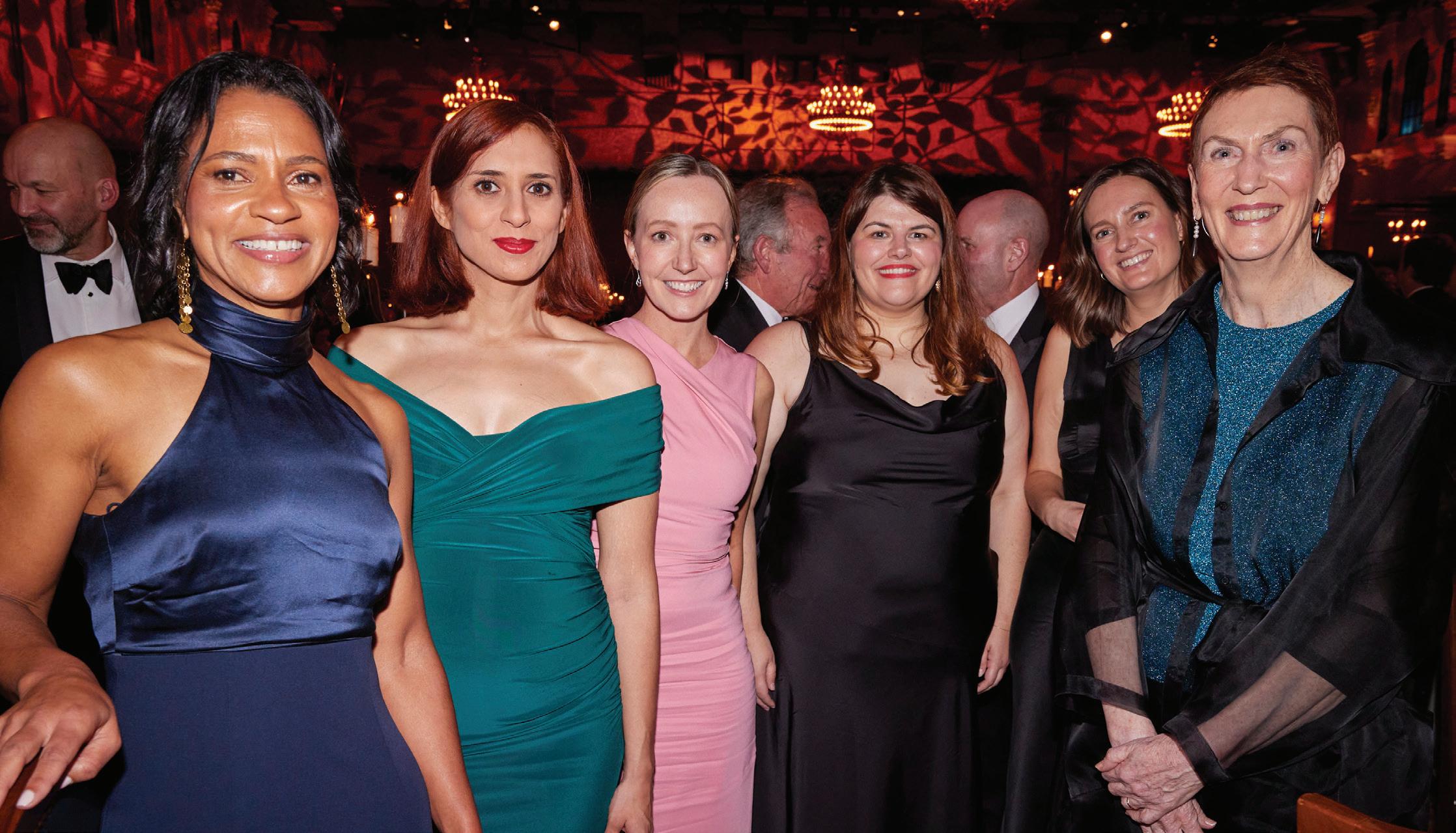
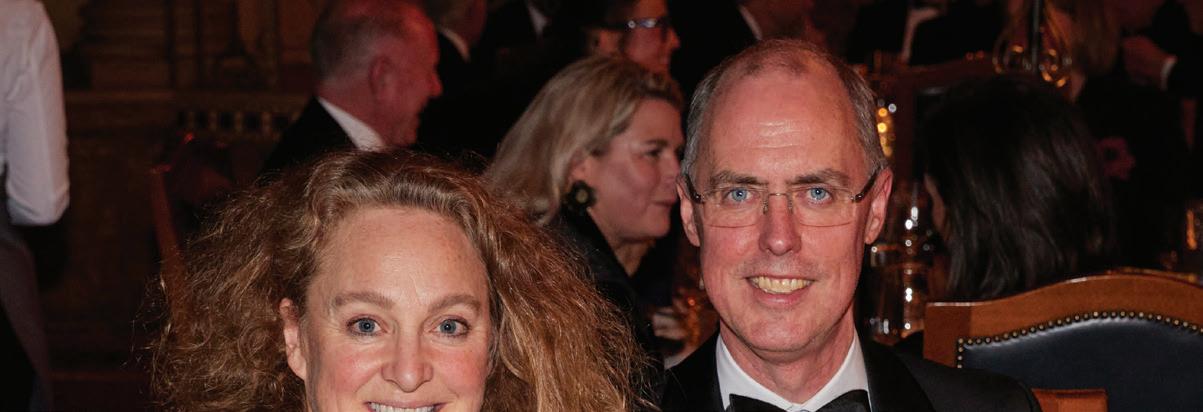
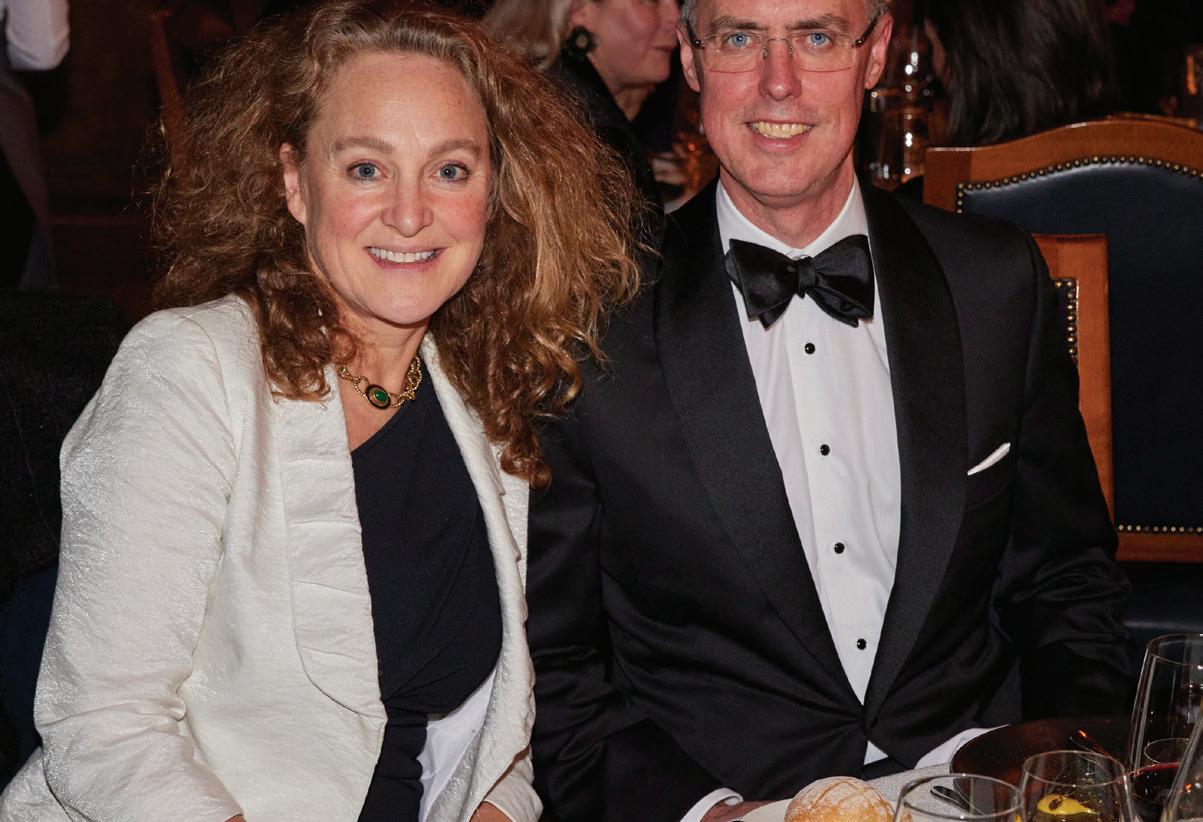
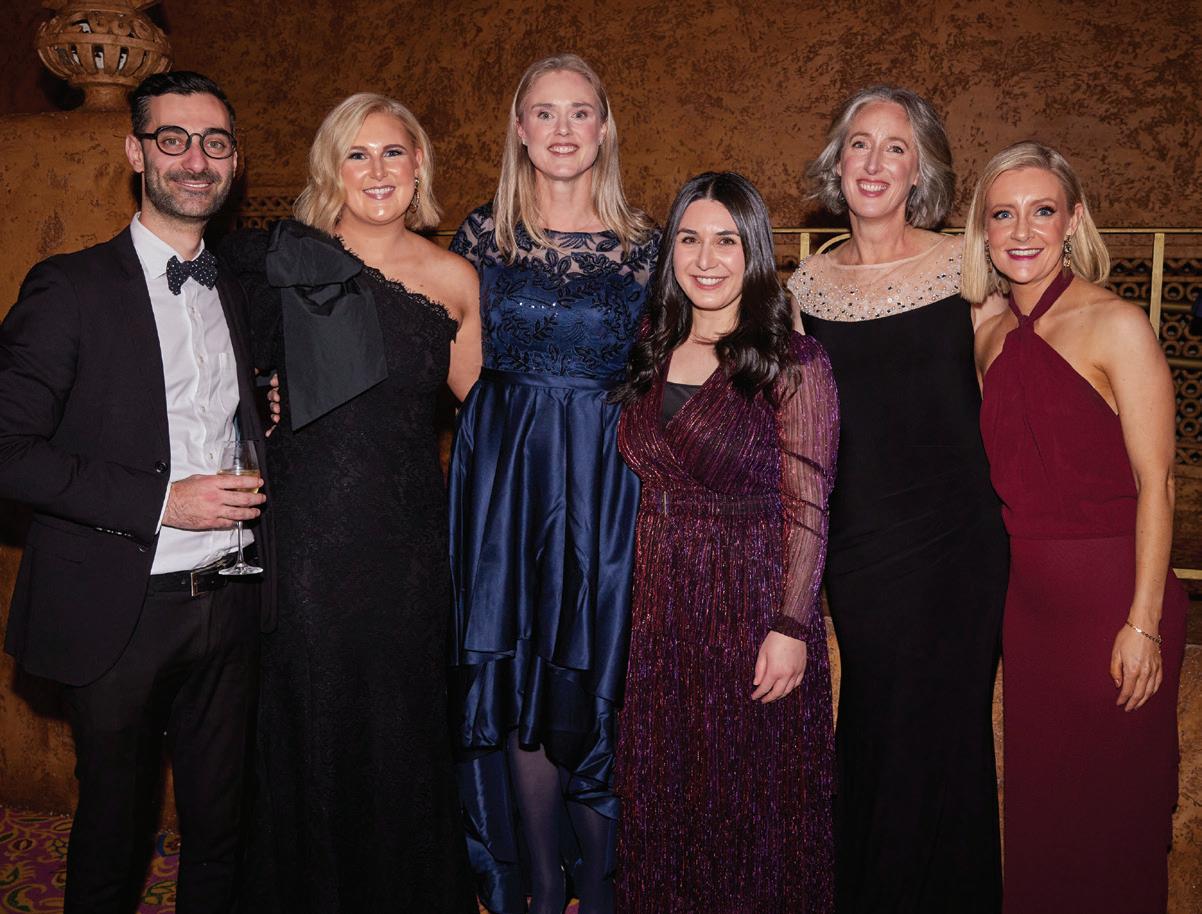
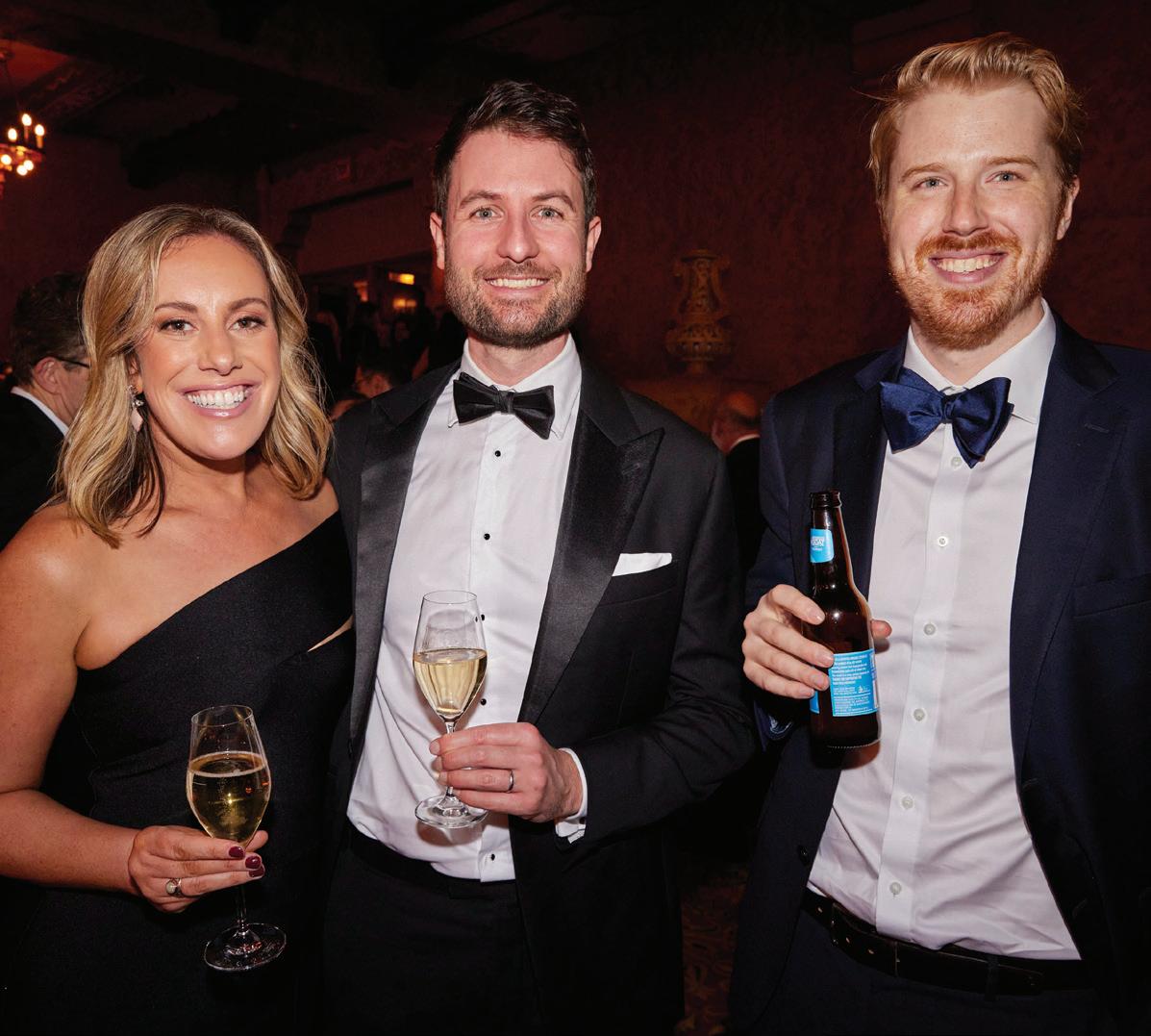
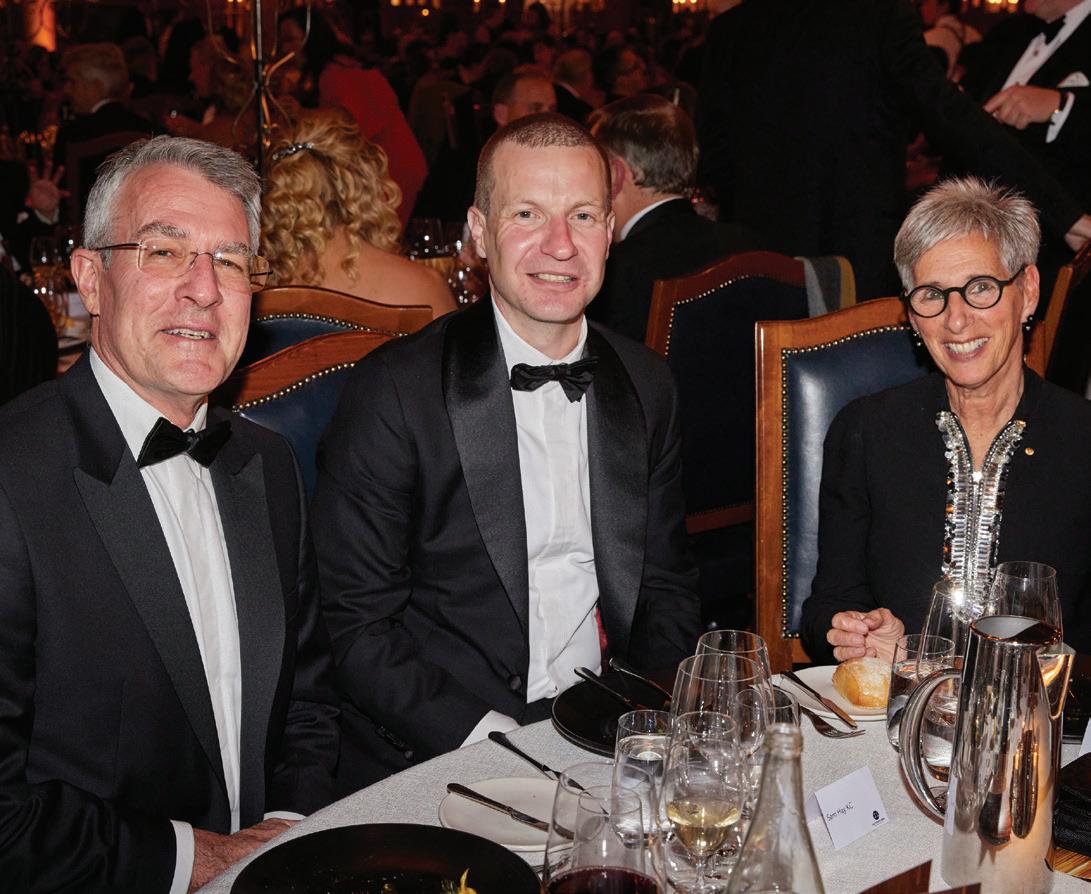
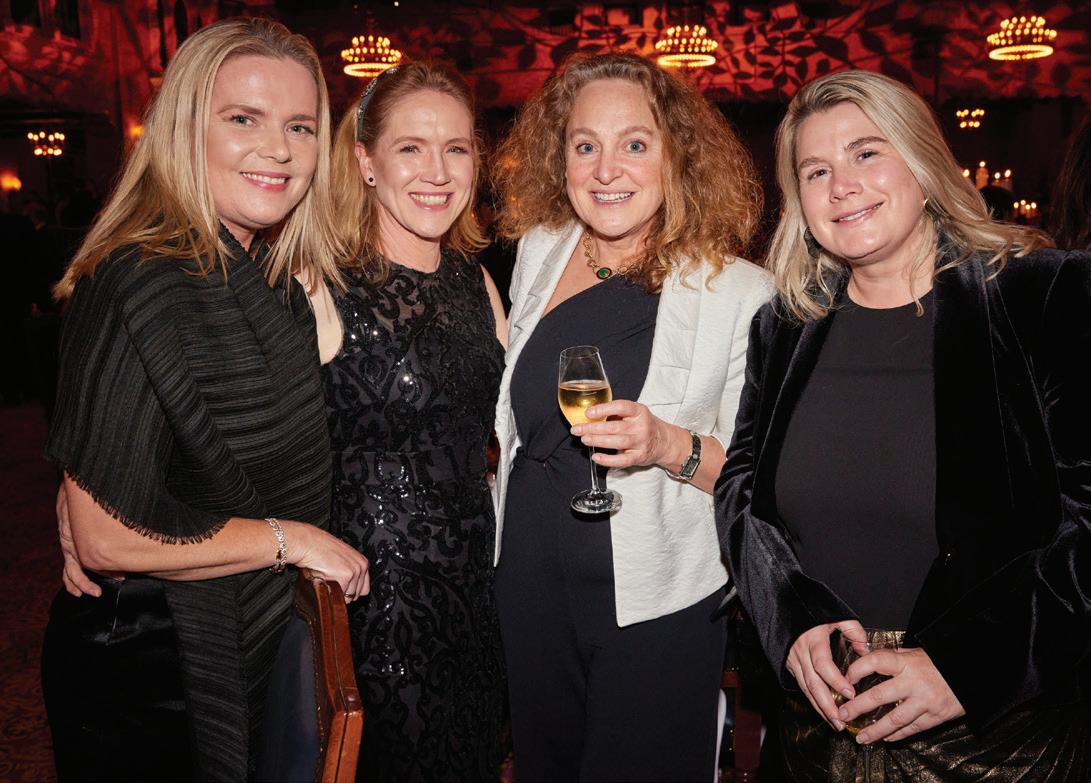

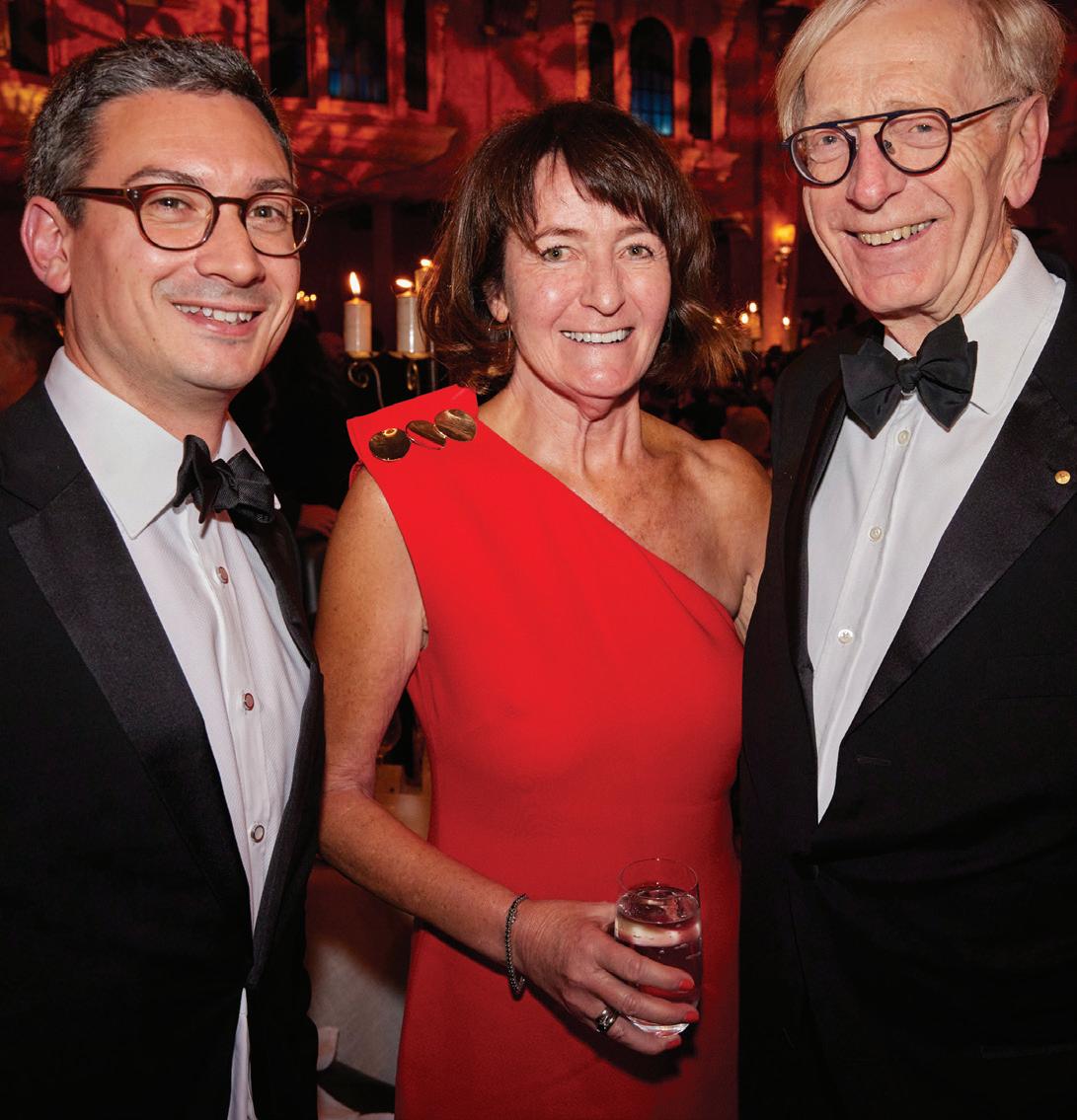

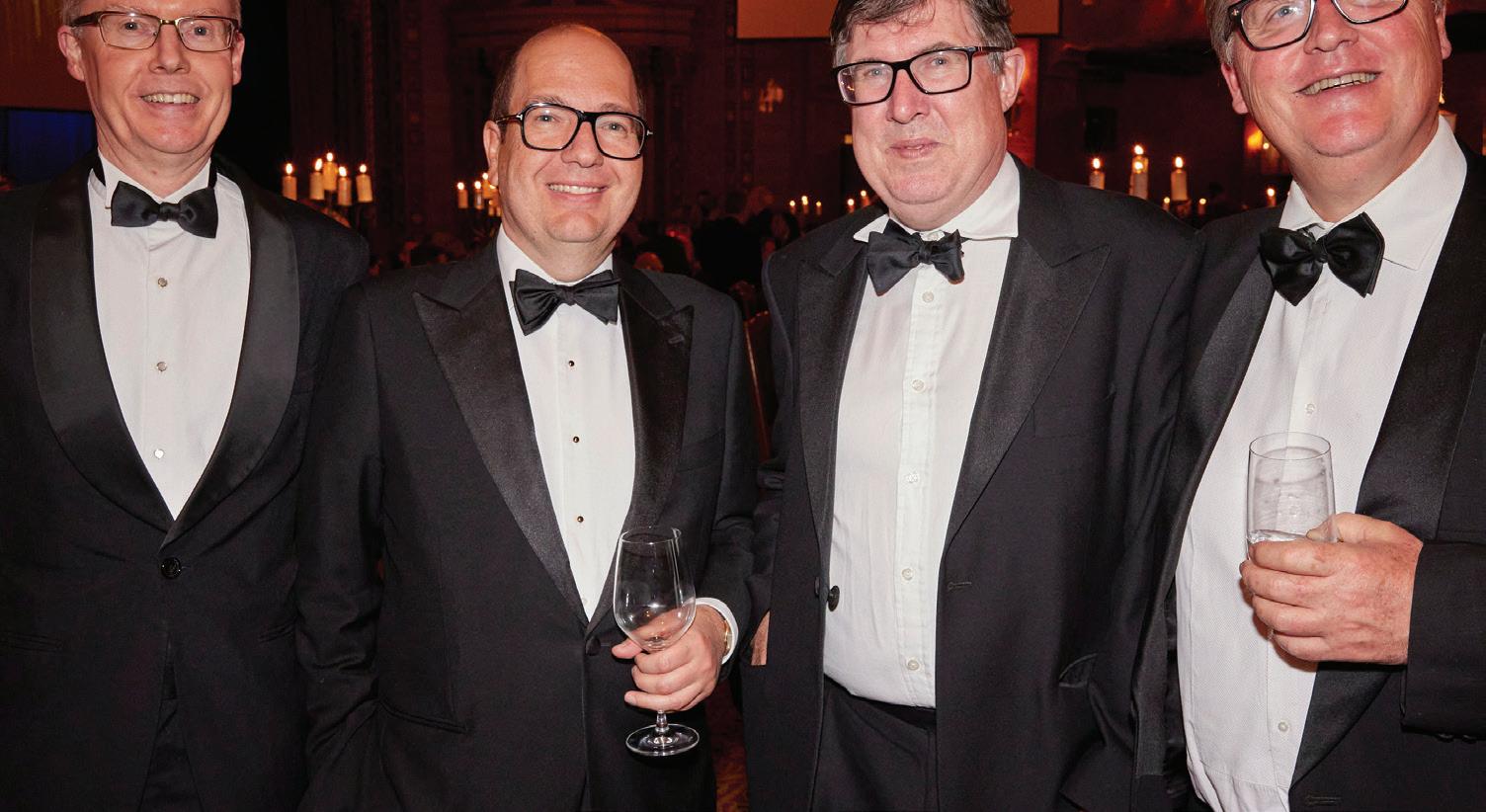
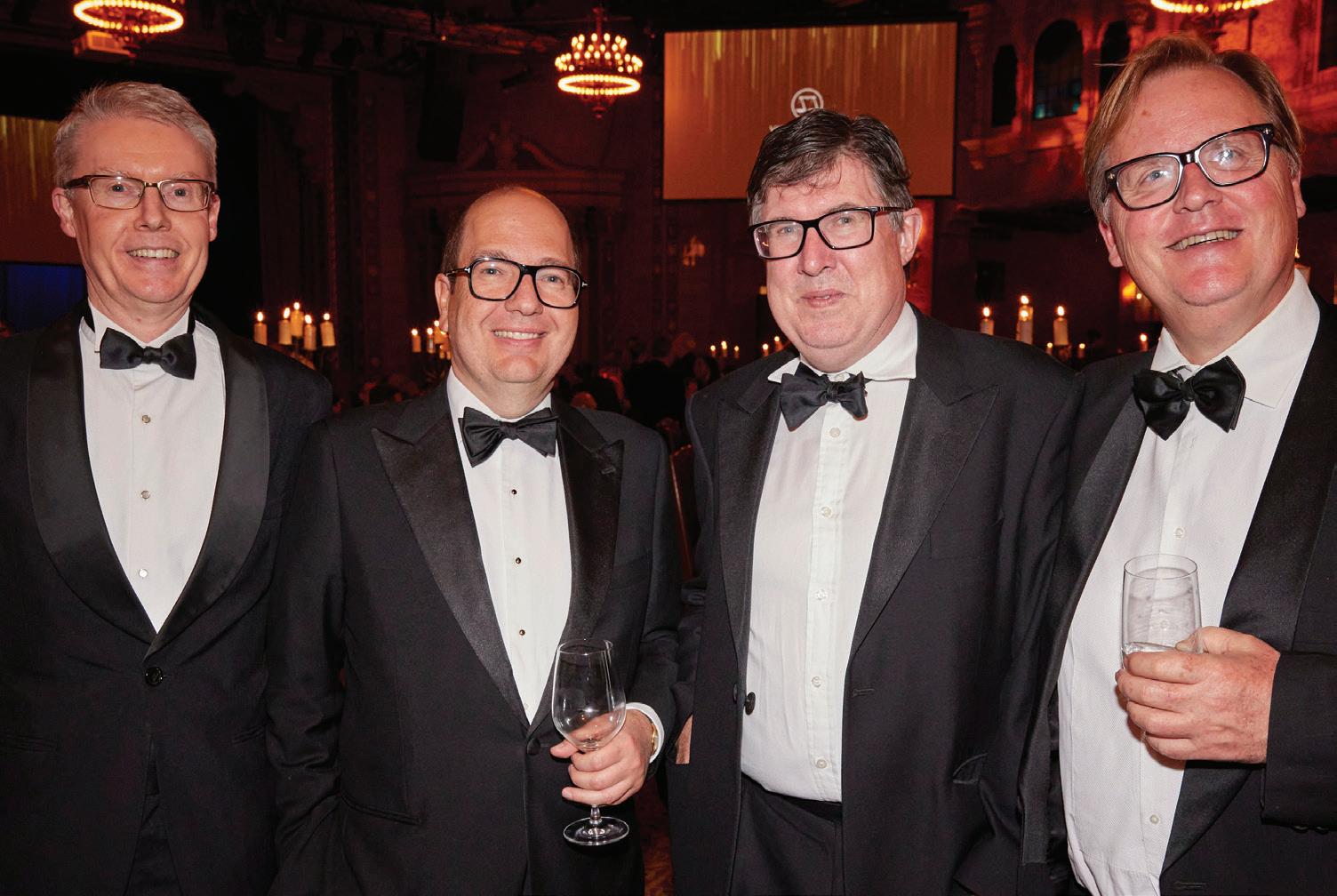
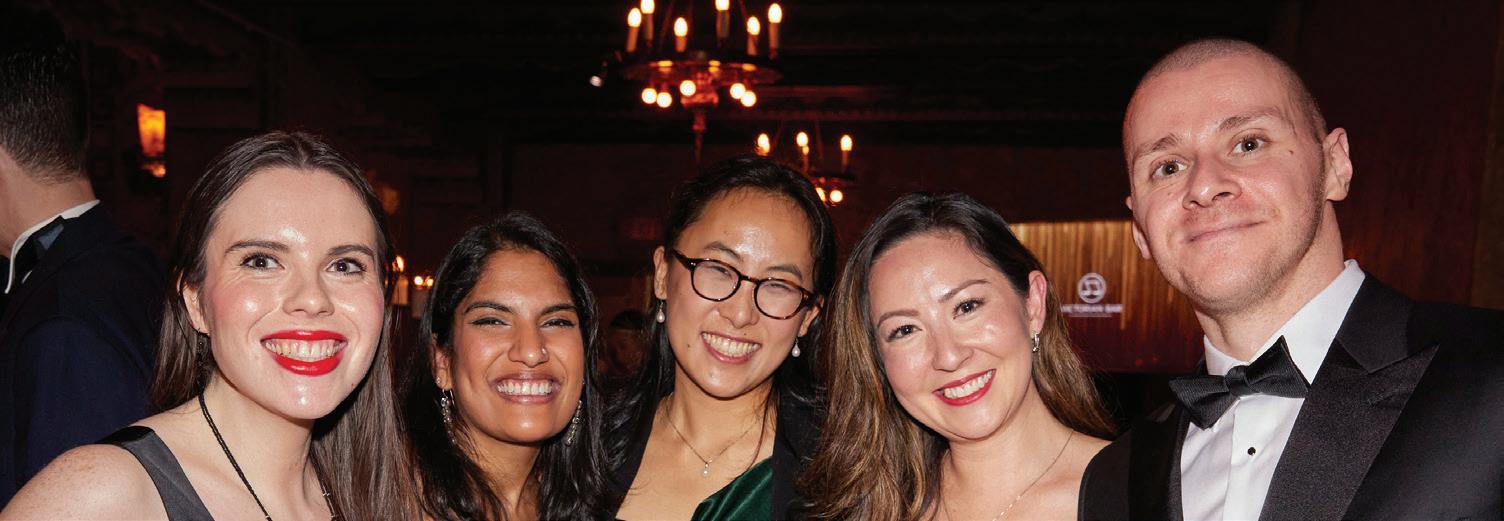
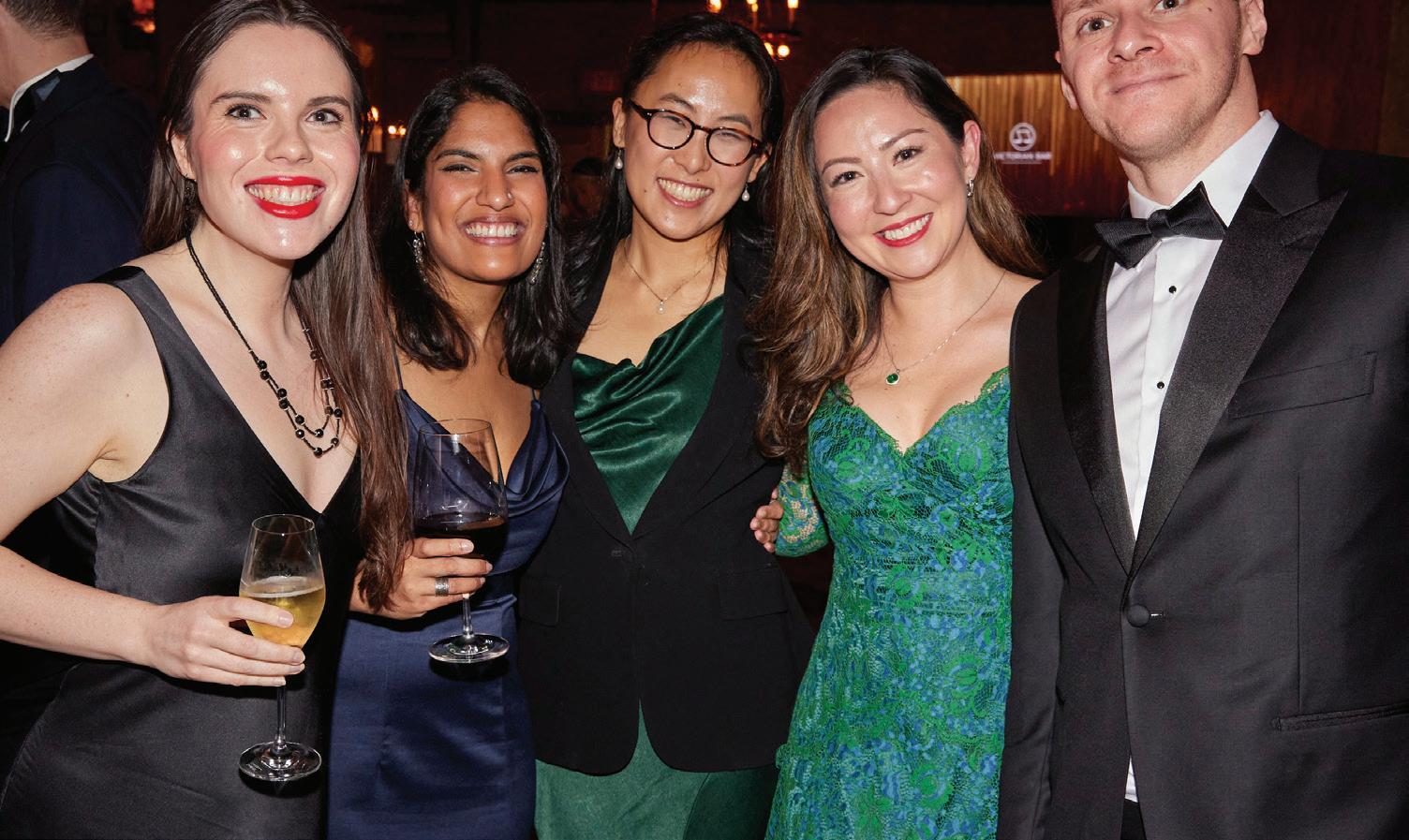
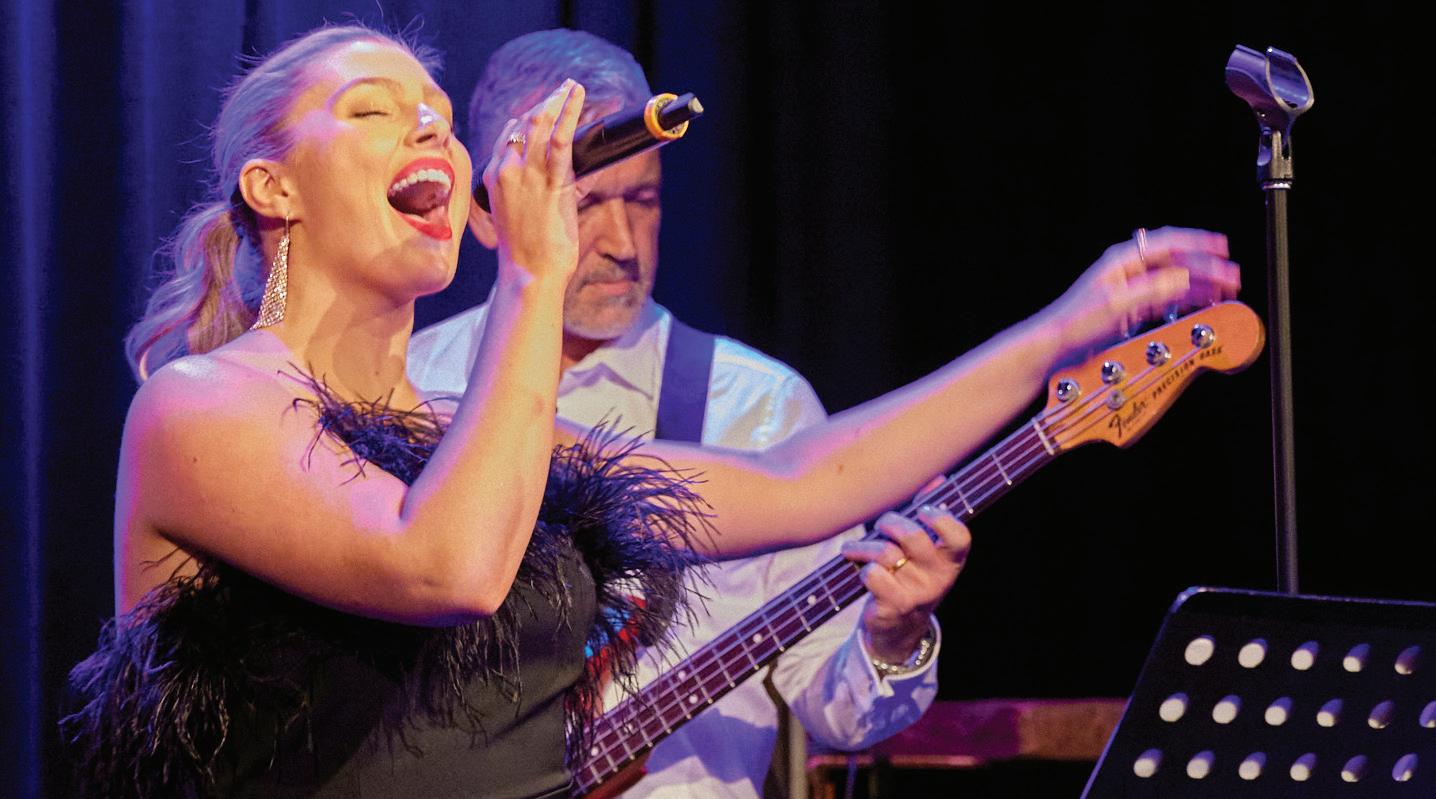
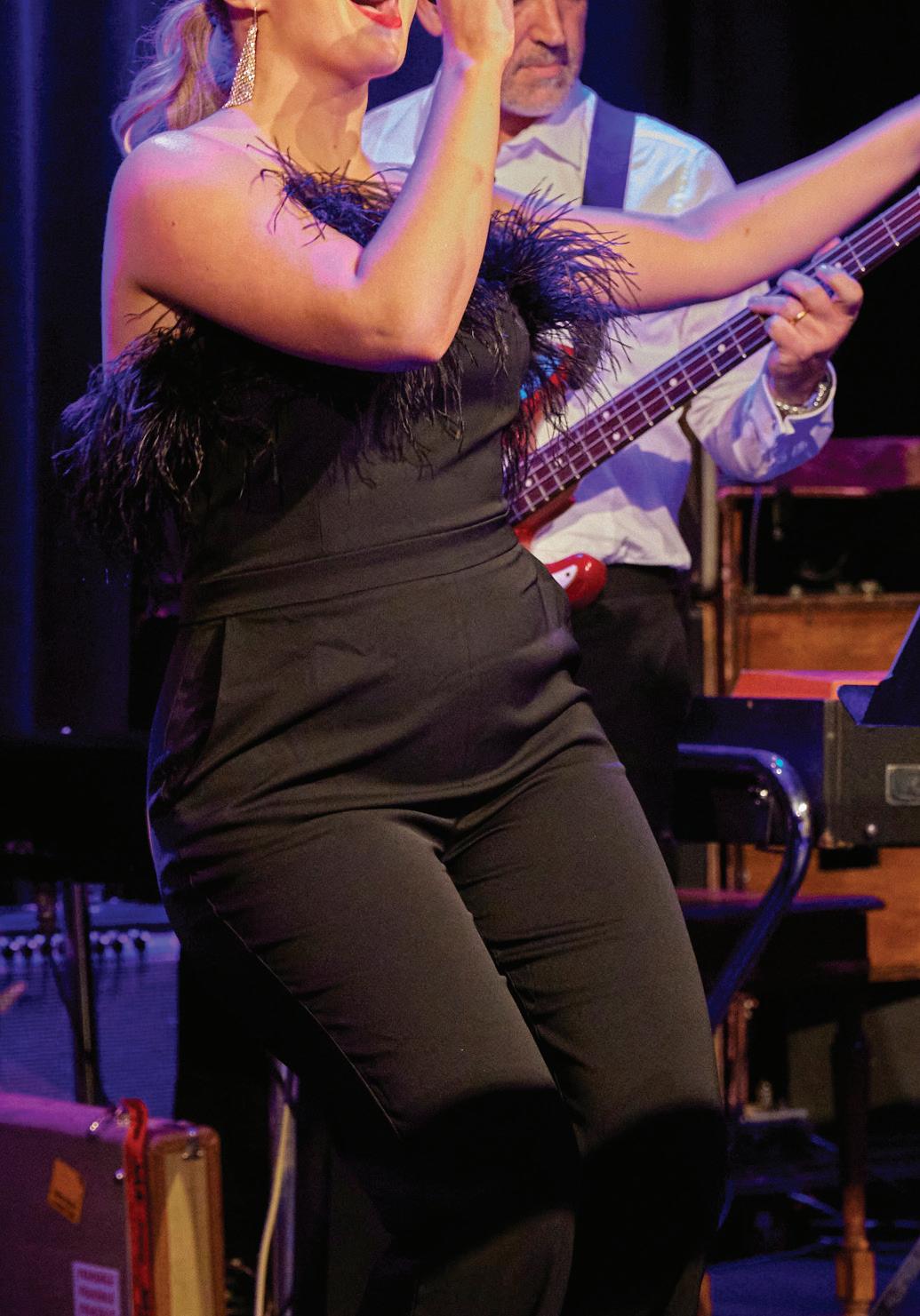
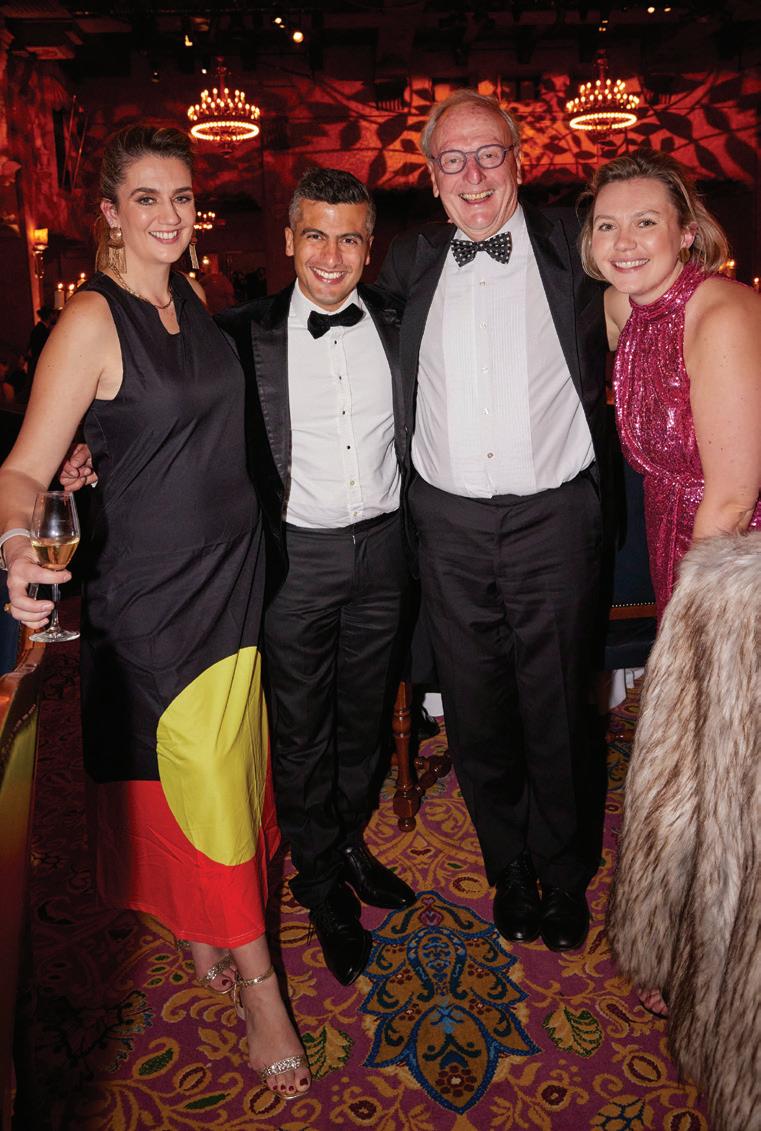
1. James Barber SC, Charles Shaw KC, Joseph Carney, the Hon Justice McNab 2. Jessie Taylor, Rishi Nathwani, Tim Tobin SC, Anastasia Smietanka 3. Fiona McLeod AO SC, Dominic Toomey SC, Gabrielle Bashir SC 4. Susanna Locke, Monika Pekevska, Coroner Paul Lawrie 5. Annabelle Ballard, Shakti Nambiar, Bernice Chen, Tara Hooper, Chris Kaias 6. Premela Thiagarajan, Gabi Crafti, Marita Foley SC 7. Oliver ScoullarGreig, Michelle Button, Lachlan Molesworth, Andrea Skinner 8. Georgia Caine 9. Chris Brodrick, Ed Heerey KC, Peter Wallis KC, Georgia Caine 10. Karina Popova, Merys Williams, Richard Stanley, Kathy Karadimas, Katharine Gladman, Abhi Mukherjee, David Seeman, Raph Ajzensztat, Christine Boyle, Anastasia Smietanka
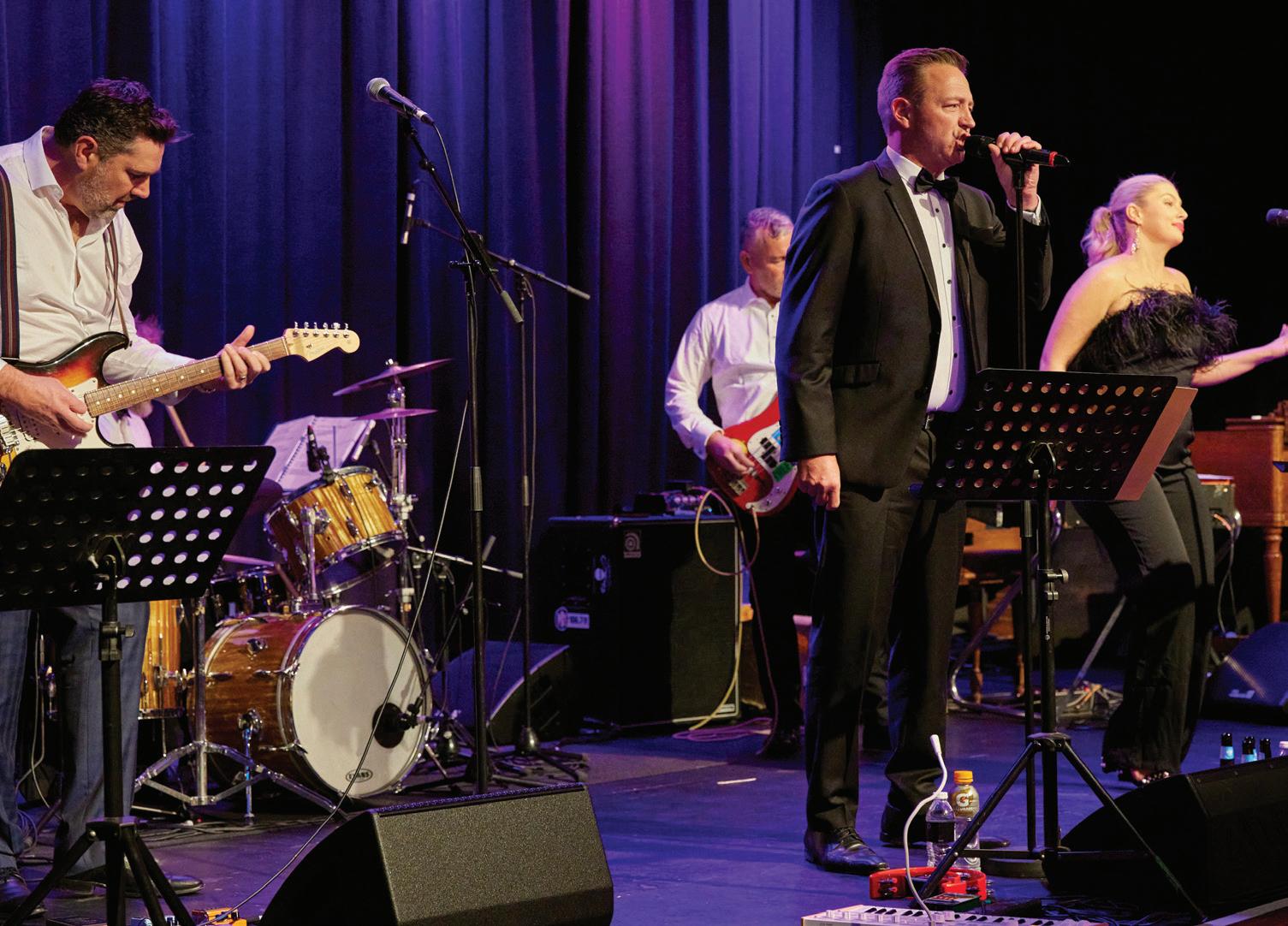

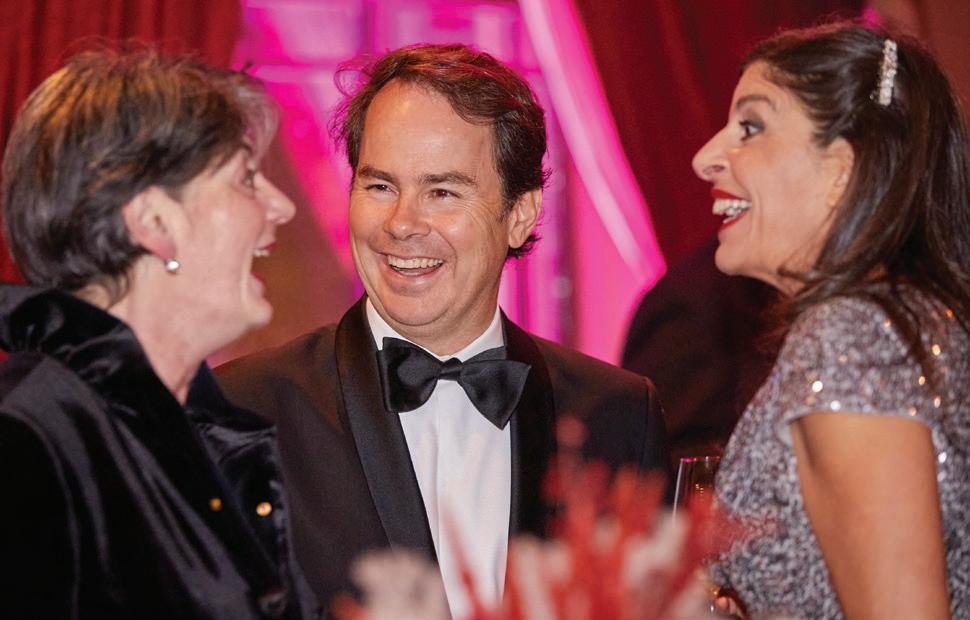

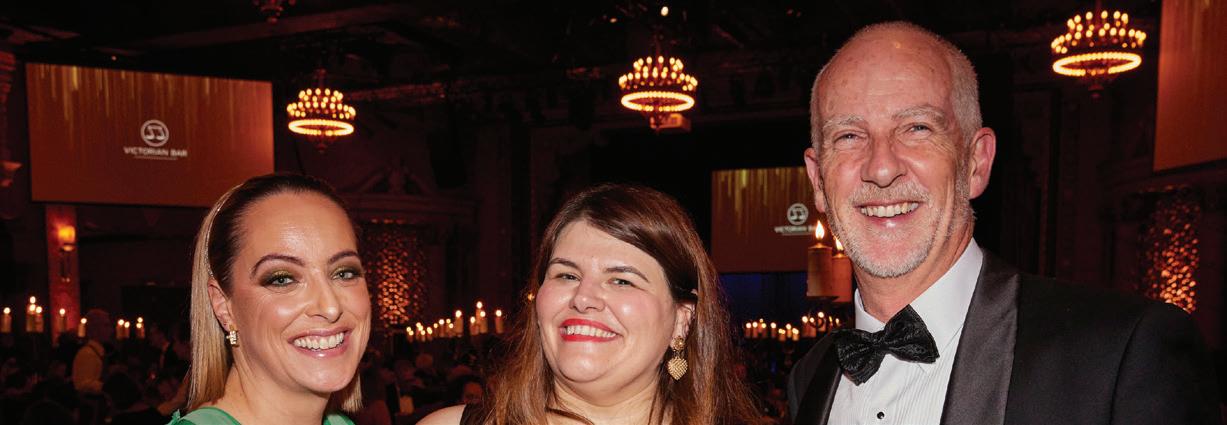

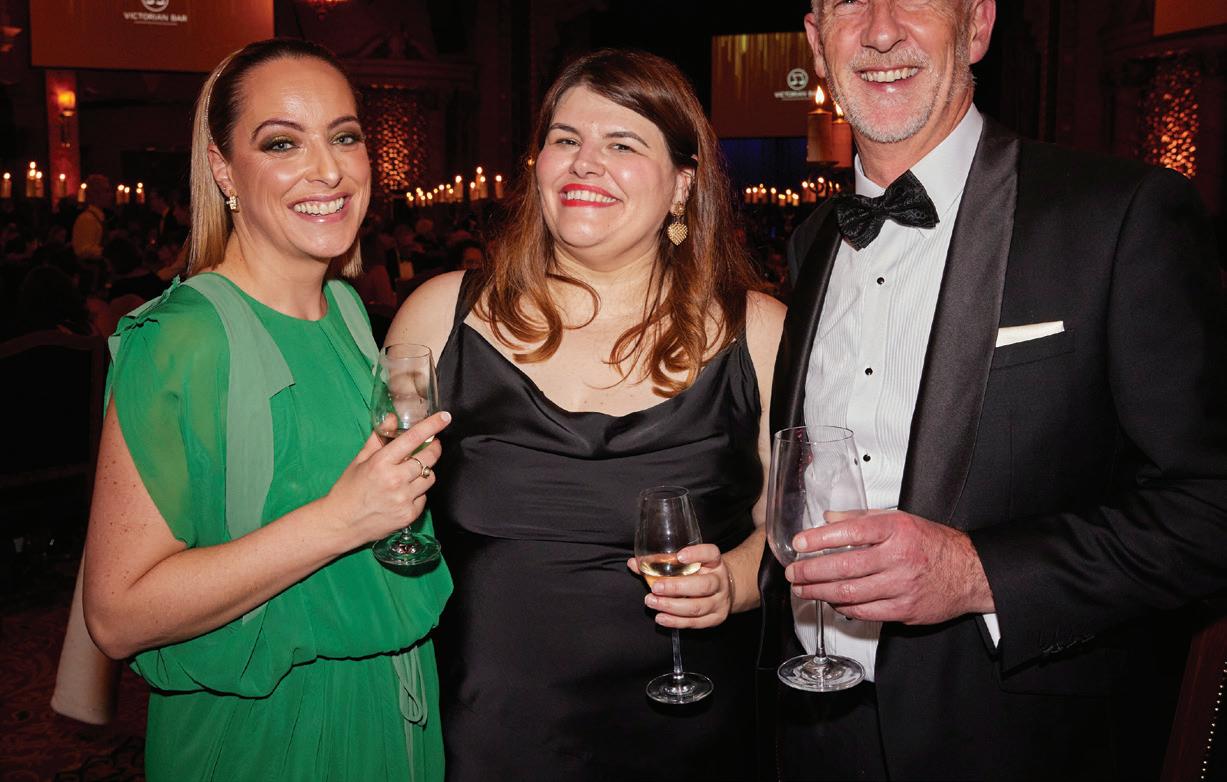
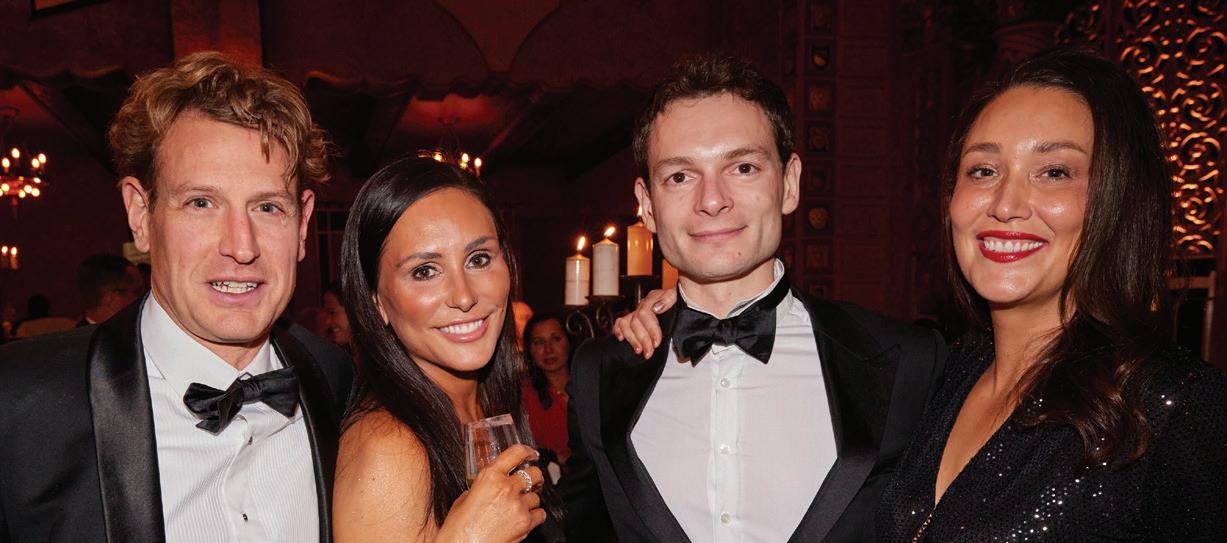
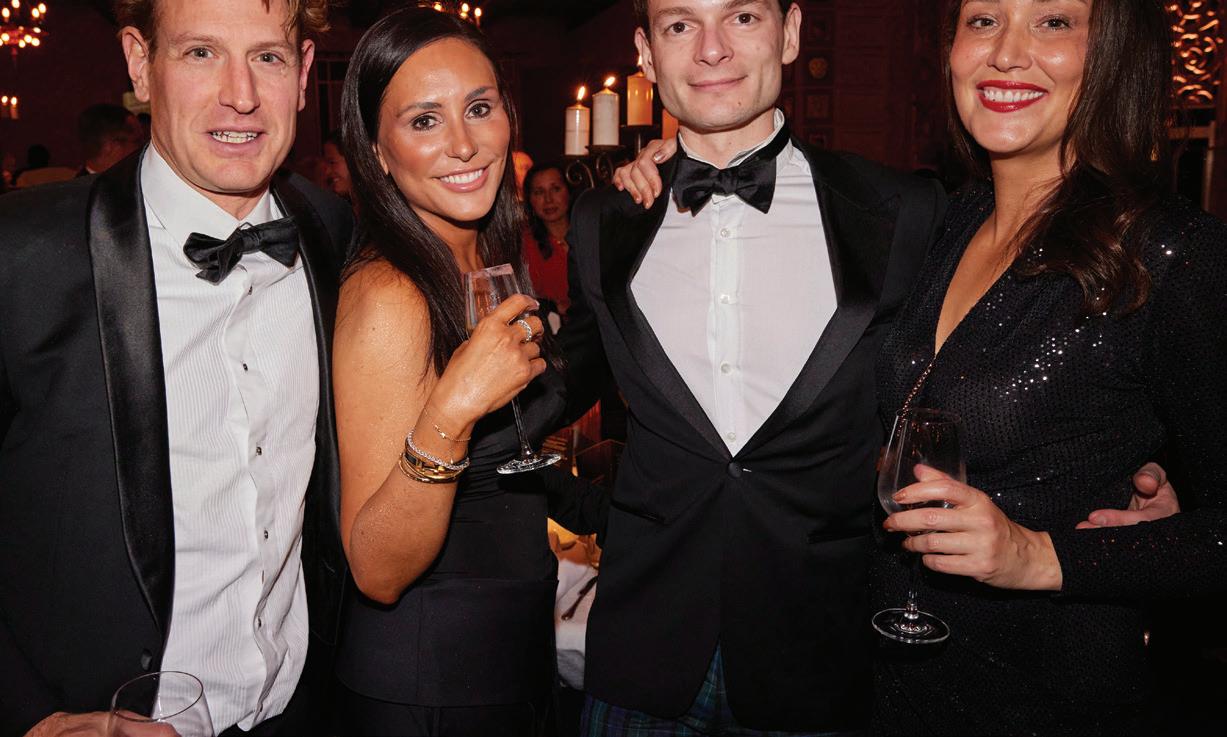
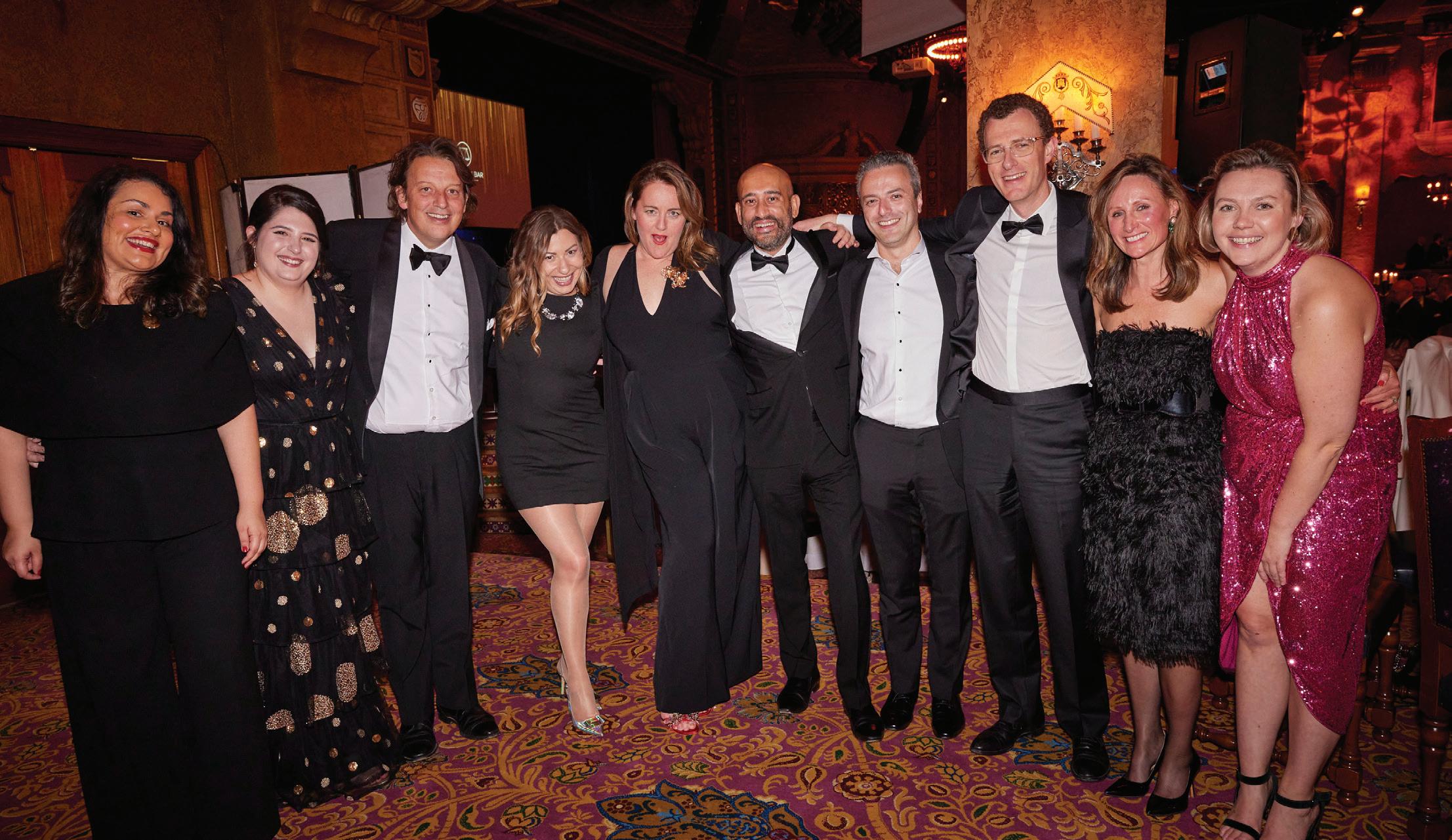
A Proposed Law: to alter the Constitution to recognise the First Peoples of Australia by establishing an Aboriginal and Torres Strait Islander Voice. Do you approve this proposed alteration?

Chapter IX Recognition of Aboriginal and Torres Strait Islander Peoples
129 Aboriginal and Torres Strait Islander Voice
In recognition of Aboriginal and Torres Strait Islander peoples as the First Peoples of Australia:
1. There shall be a body, to be called the Aboriginal and Torres Strait Islander Voice;
2. The Aboriginal and Torres Strait Islander Voice may make representations to the Parliament and the Executive Government of the Commonwealth on matters relating to Aboriginal and Torres Strait Islander peoples;
3. The Parliament shall, subject to this Constitution, have power to make laws with respect to matters relating to the Aboriginal and Torres Strait Islander Voice, including its composition, functions, powers and procedures.
Australia is on the cusp of potentially amending its Constitution for the first time in 50 years to enshrine an Aboriginal and Torres Strait Islander Voice. We understand that other contributions to this edition of the Bar News are looking in detail at the substance of the proposed amendment. In our contribution, we want to focus on the very idea of constitutional change—what it means for the people of a nation to collectively decide to change their founding document. In doing so we will focus on two ideas—the Constitution as ‘compromise’ and the Constitution as ‘blueprint for the good life’. We hope that our contribution will go some way to responding to the diametrically opposed concerns that the proposed amendment either does too much or too little. Before we do so, however, it is helpful to remember how we got here.
With public debate raging ahead of the upcoming referendum, and in all of the noise and commentary feeding into the daily news cycle, it is easy to forget that this proposal has been in the making for more than one year, or one decade. It is the product of over a century of advocacy by First Nations peoples.
While much of this advocacy is likely undocumented, we do know that as early as 1925 the Australian Aboriginal Progressive Association was calling for direct Aboriginal representation in Parliament and the control of Aboriginal affairs under a Board of Management comprised of Aboriginal people. We also know of William Cooper’s petition to King George V in the early 1930s calling for Aboriginal people to have representation in Parliament. And we know of the Aboriginal Progressive Association in 1938 again advocating for an Advisory Board to the federal Department of Aboriginal Affairs, which Board was to be made up of at least half Aboriginal members. Then of course we have the 1967 referendum and the well documented push for the current constitutional change from the early 2010s, through the Uluru statement in 2017 to now.
It is perhaps inevitable that, through this century-long push for constitutional change, there have been compromises, by First Nations peoples and by others. We were reminded that the current proposal is a compromise by Senator Patrick Dodson at a lecture given to the Bar last year. He said, “It’s a very, very generous offer. Some of our people think
this is too little.” The Voice proposal is not everything for everyone. The long process by which the proposal has been conceived, rejected, refined and ultimately put to the people has been the subject of repeated compromises. Those who wanted a non-discrimination clause enacted in the Constitution have had to accept a more modest proposal. Those who wanted only a change to the preamble have had to accept a more ambitious proposal. Not everyone will agree. But that is the point. All constitution-making is compromise. One of the architects of the Australian Constitution wrote of those drafting it: “they were not only guided by a clear practical sense, but were animated by a spirit of reasonable compromise”.1 However the fact that our Constitution is the product of compromise is not its weakness but its strength—and that is true of the currently proposed amendment. It is by the accommodation of different views that we can come together as a nation.
Most importantly, even when it is the product of compromise, constitutionmaking and constitutional change draws the blueprint for the national trajectory. In the words of Martha Minow, former dean of Harvard Law School, a constitution should be “the blueprint for the good life”.2 The presently proposed amendment is no exception. As the Commonwealth Solicitor-General opined in a recently released advice, the “proposed s 129 is not just compatible with the system of
representative and responsible government prescribed by the Constitution, but an enhancement of that system”.3 It is an improvement to our blueprint for the good life. Albeit symbolic in some respects, the amendment also carries with it the hopes of all those that support it that it will tangibly improve the lives of First Peoples—and by doing so improve the whole of Australia. In that sense, the amendment confirms our understanding of our founding document as a reflection of our hopes and beliefs in what our country is and should be and how we, as a country, can live the ‘good life’ that Minow referred to.
1 James Bryce, Studies in History and Jurisprudence, vol 1 (Clarendon Press, 1901) 482.
2 Minow, Martha, Speech to 14th Amendment Class, Harvard Law School (2011).
3 Solicitor-General Advice, SG o. 10 of 2023, [21].
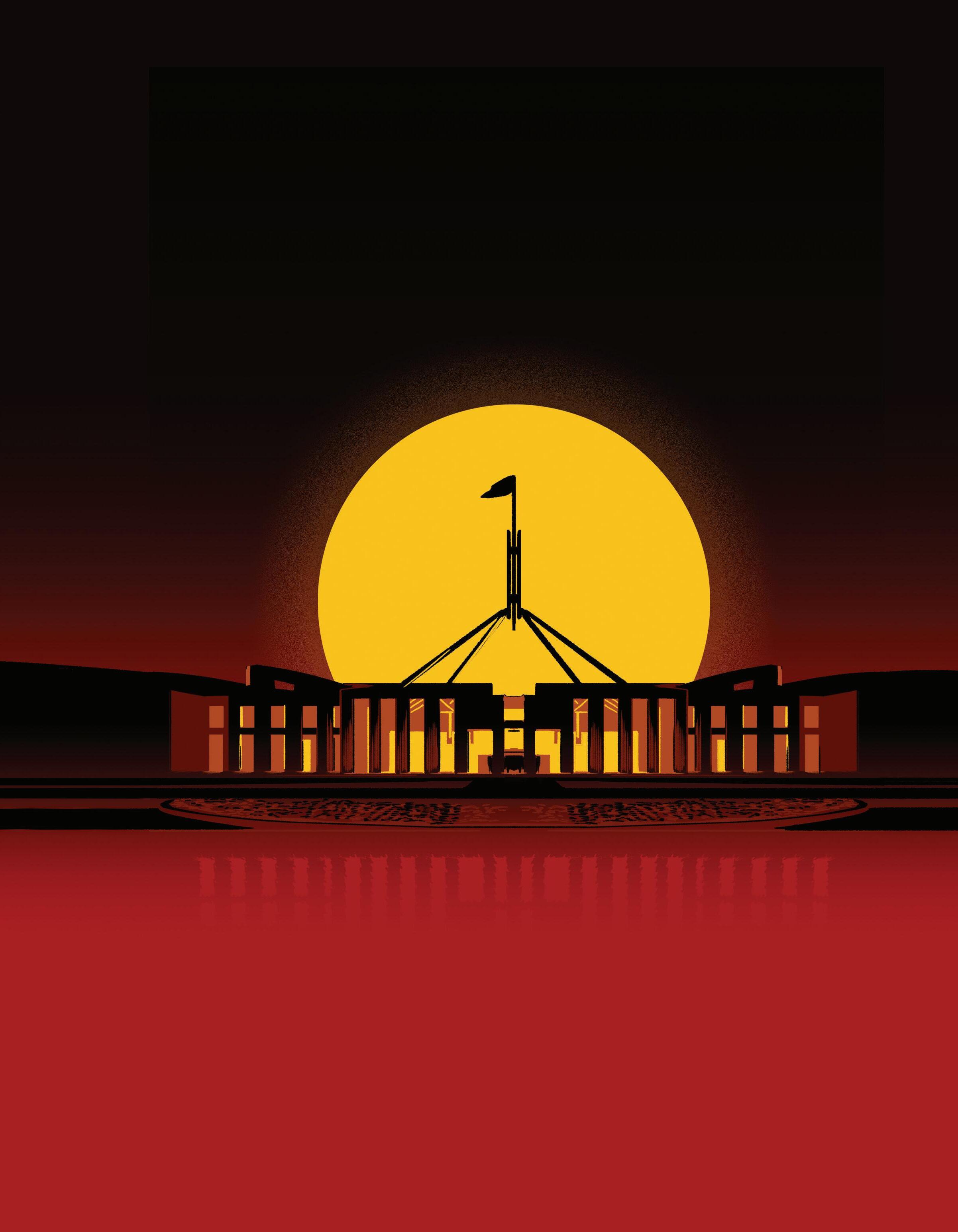
1977 Simultaneous House and Senate elections 1984 Interchange of Commonwealth and State powers
1984 Senate terms
1988 Civil rights and freedoms
Simultaneous House and Senate elections
Retirement age of Federal Judges*
Territory vote in referenda*
Senate casual vacancies*
1988 Local government 1988 Fair elections
1988 Parliamentary terms 1999 Preamble to the Constitution
1999 Establishment of a Republic
Denotes referenda
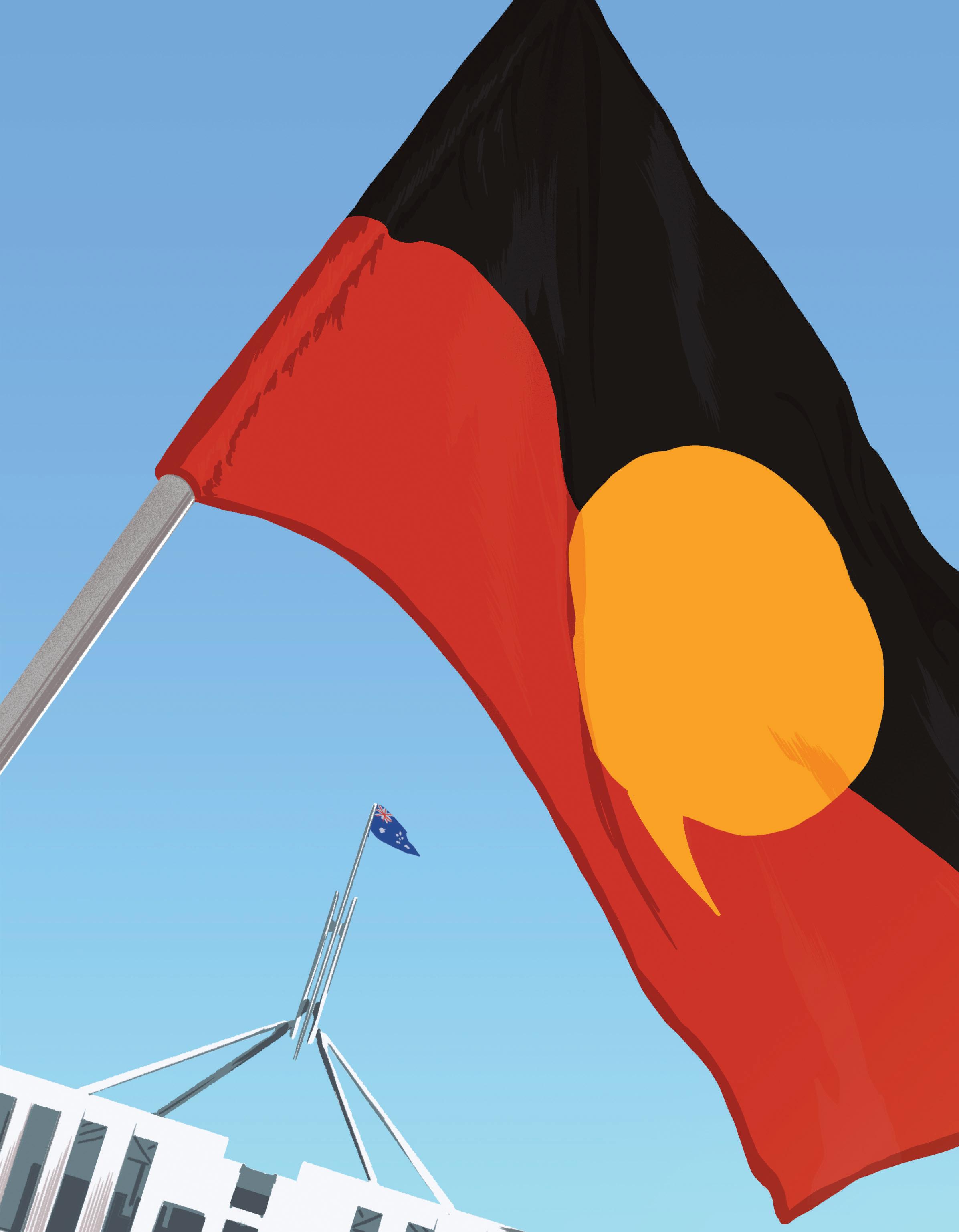

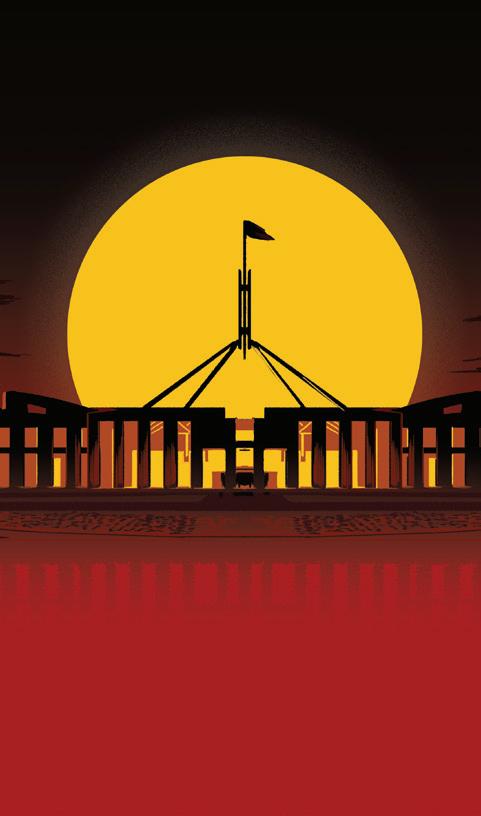
KEN HAYNE
Later this year we will vote on whether to approve a law “to alter the Constitution to recognise the First Peoples of Australia by establishing an Aboriginal and Torres Strait Islander Voice”. Approval requires a double majority—a majority of the electors in a majority of States, and a majority of all the electors voting. The text of the proposed alteration is short and simple. It would form a new chapter in the Constitution (Chapter IX, entitled “Recognition of Aboriginal and Torres Strait Island Peoples”) and would comprise a new section—section 129.
The words of section 129, like the Uluru Statement from the Heart, are the product of long, detailed and careful thought and discussion.
Are there reasons to fear the proposal?
My answer is an unequivocal “No”.
I put the question as I do—are there reasons to fear the proposal—because so much of what has been said against it has been an appeal to fear.
The proposed amendment responds to the Uluru Statement from the Heart. All of us should read the Statement. It was the product of long and detailed consultation with Aboriginal and Torres Strait Islander peoples. Its opening paragraphs put the proposed amendment in its proper context. They read:
Our Aboriginal and Torres Strait Islander tribes were the first sovereign Nations of the Australian continent and its adjacent islands and possessed it under our own laws and customs. This our ancestors did, according to the reckoning of our culture, from the Creation, according to the common law from ‘time immemorial’, and according to science more than 60,000 years ago.
This sovereignty is a spiritual notion: the ancestral tie between the land, or ‘mother nature’, and the Aboriginal and Torres Strait Islander peoples who were born therefrom, remain attached thereto, and must one day return thither to be united


with our ancestors. This link is the basis of the ownership of the soil, or better, of sovereignty. It has never been ceded or extinguished and co-exists with the sovereignty of the Crown.
How could it be otherwise? That peoples possessed a land for sixty millennia and this sacred link disappears from world history in merely the last two hundred years?
Until the 1967 Referendum, the only references in the Constitution to the Indigenous peoples of this country were references of exclusion. Section 127 (repealed in 1967) said that “In reckoning the numbers of the people of the Commonwealth, or of a State or other part of the Commonwealth, aboriginal natives shall not be counted”. And s 51(xxvi) giving the Parliament legislative power to make laws with respect to “The people of any race… for whom it is deemed necessary to make special laws” was expressly qualified by the phrase “other than the aboriginal race in any State”. This phrase was deleted in 1967.
What is now proposed will recognise Aboriginal and Torres Strait Islander Peoples as “the First Peoples of Australia”. Thus, the proposed amendment will expressly acknowledge that Aboriginal and Torres Strait Islander Peoples lived in this land long before European settlement.
This recognition and acknowledgement is rooted in the common law of Australia rejecting the doctrine of terra nullius and holding, in Mabo (No 2) v Queensland (1992) 175 CLR 1, that this land was not a “legal desert” when European settlers came in 1778; this land was possessed by peoples who acknowledged and observed their traditional laws and traditional customs. Those laws and customs were not extinguished (and native title interests in land were not extinguished) by the British Crown’s assertion of sovereignty.
Settlers took possession of this land, and extended their occupation
of it, without the consent of the Indigenous inhabitants. As Brennan J rightly said in Mabo, “Their dispossession underwrote the development of the nation”. It is these legal and historical facts that underpin recognition of the First Peoples in our Constitution.
The Constitution is our basic law. It sets out the principles of how our federal system of government works. All Australians “own” the Constitution. If the proposed amendment is made, our Constitution will better reflect that ALL Australians own the Constitution and will better reflect the history of this land. And providing for the Voice looks to the future, not the past.
What then are the fears that have been raised?
Most are fears of unintended consequences. Many are expressed as fear of what the courts or lawyers will do. And as each fear has been shown to be false, a new and different fear has been expressed.
First it was said that the Voice would be a third chamber of the Parliament. It is not. It is a voice TO Parliament. It is not a voice IN Parliament. The text of the amendment shows that the proposition is false.
Then it was said that the Voice could veto government action. It cannot. Nothing in the text of the proposal supports the proposition. The powers of Parliament and the Executive are wholly unaffected by the proposed amendment. Saying the Voice could veto government action is false.
Next it was said, “we need more details”. Details of what?
Clause 3 of the proposal makes clear that it will be the Parliament that decides the details about how the Voice is set up and how its representations are dealt with by the Parliament and the Executive. And this is how it should be. The Constitution sets out principles, not machinery. Machinery can and should change as times change
and it is Parliament that will make and change that machinery, not the referendum. The call for “more details” is disingenuous and irrelevant. It is asking for details of what the Parliament will do in the future.
Then focus shifted to the phrase in clause 2—“representations … on matters relating to Aboriginal and Torres Strait Islander peoples”. How wide was the power? Would the Voice be able to make representations about defence policy or monetary policy and so on?
The High Court has often said that legislative powers are not to be given a meaning “narrowed by an apprehension of extreme examples and distorting possibilities”. Some, probably all, of the examples given in questions about the width of the power are extreme examples and distorting possibilities.
There are two practical answers to these particular appeals to fear. First, why would the Voice waste its political and social capital by making representations on matters of the kind described in these questions? The examples being given are cases that will not arise. Second, even if the Voice were to make representations on such matters, what would follow? The ordinary business of government will go on without interruption. Either what is said is persuasive or it is not. If it is persuasive, so be it; if it is not, it will be ignored.
Focussing on the outer limits of the power to make representations is nothing more than a baseless appeal to fear.
It is baseless because the unstated premise for arguments about the breadth of the power to make representations is (and always has been) that the Voice making representations will interfere with the ordinary and efficient working of government. The premise is false.
The power is a power to make representations. The word “representations” and the phrase

If the proposed amendment is made, our Constitution will better reflect that ALL Australians own the Constitution and will better reflect the history of this land.
“may make representations” are carefully chosen. They mean what they say. The proposed provisions impose no obligation on Parliament or the Executive to consult with the Voice. They impose no obligation on Parliament or the Executive to ask for representations. They impose no obligation to adopt or defer to the views expressed.
Could there be litigation about what the Parliament does or does not do in response to a representation by the Voice? No. The courts have always refused to enter into the intramural affairs of Parliament. It will be for Parliament (and ONLY Parliament) to decide how it will respond (if at all) to any representation.
What about representations to the Executive?
It has been said that we should foresee a decade of litigation. I do not agree.
If a court were to hold, that in the exercise of some statutory power, an officer of the Commonwealth (or other executive decision maker) was legally bound to take account of a representation by the Voice and that the decision maker had ignored the representation, a plaintiff with standing may be able to obtain judicial review of the decision. But three points have to be made.
First, Parliament may make laws with respect to matters relating to the Voice, including laws about what are the consequences of the Voice making a representation.
Second, who would have standing to seek judicial review?
Third, if a case for judicial review is made out, the best that the plaintiff can obtain would be an order quashing the decision and requiring the decisionmaker to decide again according to law. The court would not
exercise the power and the Executive, though bound to consider what the Voice had said would still have to reach its own conclusion.
But there is a more fundamental point which we must keep at the forefront of consideration. Any judicial review of Executive decisions would be no more than an ordinary application of the rule of law.
The rule of law defines the society in which we live. As a society we cannot be afraid of the rule of law. We must embrace it fully.
As lawyers we are bound to explain to any who ask us about these matters how the law operates. Adopt, if you will, what Brennan J said in Attorney-General (NSW) v Quin (1990) 170 CLR 1, 35-36: “The duty and jurisdiction of the court to review administrative action do not go beyond the declaration and enforcing of the law which determines the limits and governs the exercise of the repository’s power”.
How can we, why should we, fear the courts enforcing the law determining the limits and governing the exercise of public power?
What we cannot and must not do as lawyers is say, “The courts are coming! Be afraid. Be very afraid”. Yet that is all that those predicting years of litigation are saying.
Finally, it is necessary to deal with a point which only now begins to emerge—the argument of “equality”. It is said that the proposal will give “special rights to indigenous people”; it is “introducing racial distinctions in the Constitution”.
The notion of “equality” that is embraced by this argument is one of “identical” or “undifferentiated” treatment. That has never been the measure of equal treatment under the law. The law treats like cases alike but different cases differently.
The argument of “equality” says: Ignore history and the manifold disadvantages inflicted and entrenched by history and, regardless of disadvantage, treat everyone the same. Likewise, the argument appealing to “race” or “colour” treats 60,000 years or more of occupation of this land as irrelevant while silently invoking the horrors of twentieth century Europe.
No matter how the argument is expressed it is false. We cannot ignore history; we cannot ignore disadvantage or how and why it has come about. Treat everyone the same and you amplify and entrench disadvantage even further.
The proposed amendment takes no right or privilege away from any member of the Australian community. It does not alter in any way the powers of the Parliament or the Executive. It responds to the observed and undeniable fact that for more than 200 years settlers have been telling Aboriginal and Torres Strait Island peoples what is “best” for them. And that simply has not worked. We are still trying to close the gaps. We still see appalling rates of incarceration, family violence and dysfunction, and continuing health issues. We see time and time again what those who made the Uluru Statement said is “the torment of our powerlessness”.
This is why the Uluru Statement said that:
We seek constitutional reforms to empower our people and take a rightful place in our own country.
When we have power over our destiny our children will flourish. They will walk in two worlds and their culture will be a gift to their country.
We call for the establishment of a First Nations Voice enshrined in the Constitution.
We must answer that call. Rejecting it would inflict immeasurable damage on this body politic that would endure for generations.
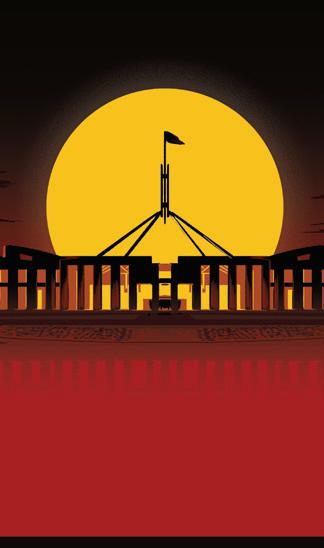
EXPLORING THE VOICE
GAVIN SILBERT
Later this year, Australians will be asked to vote on a proposal to alter the Constitution to include a new chapter, Chapter IX, entitled "Recognition of Aboriginal and Torres Strait Islander Peoples".
The proposal is to enshrine in the Constitution a body to be known as the Voice, which will have the power to make representations, on matters relating to Aboriginal and Torres Strait Islander peoples, to those bodies in which the Constitution vests the legislative and executive powers of the Commonwealth: respectively, the Parliament (comprising the Governor-General as the Crown’s representative, the Senate and the House of Representatives) and the Executive Government (comprising the Governor-General, acting on the advice of the Federal Executive Council (the Cabinet)).
Before considering the merits of proposed Chapter IX, it is necessary to consider its apparent scope and implications.
On one view, the power of the Voice to make representations to the legislative and executive organs of the Commonwealth government might be one which is merely exercisable in the abstract, as in the case, for example, of an annual address to each of the Parliament and the Executive Government on how their conduct is or might be affecting Aboriginal and Torres Strait Islander peoples.
However, that seems unlikely. It seems unlikely because such a construction would scarcely distinguish the proposed constitutional body from any other person in our society who is free to make representations to either the Parliament or the Executive Government, and so seek to influence the exercise by one or other of those bodies of their respective functions. It also seems unlikely because it would tend to suggest that the provisions of proposed section 129 are to be given little to no operative meaning, at least beyond that which is already implicit in our system of representative democracy, and so would offend that canon of construction which commands that the words employed in a statutory provision are presumed to have meaning and effect, at least where there is an alternative


construction available which would do just that.
The alternative construction is that, by necessary corollary of the power granted to the Voice to make representations in the terms expressed in proposed section 129, the Parliament and the Executive Government will be required, in the exercise of the powers vested in them pursuant to Chapters I and II of the Constitution, to consult with the Voice on matters relating to Aboriginal and Torres Strait Islander peoples.
Further, for the provisions of section 129 to have any material effect, and because the Constitution establishes the Parliament and Executive Government for the express purpose of exercising the legislative and executive powers of the Commonwealth, it would appear that such consultation with the Voice must logically occur in advance of the exercise of legislative or executive power.
Moreover, for the same reasons, proposed section 129 must arguably carry with it an implied grant that the Parliament or the Executive Government, as the case may be, will supply such information and relevant materials to the Voice as to the proposed exercise of its powers as will permit the Voice to make informed representations to it on such matters.
Conceptually, therefore, the proposal is to condition the exercise of the Commonwealth’s legislative and executive powers, insofar as they concern matters relating to Aboriginal and Torres Strait Islanders, with an obligation to consult with and provide relevant materials to the Voice ahead of the exercise of those powers. In so doing, the proposal confers on that group rights that are not available to other Australians. As far as the Constitution
As far as the Constitution is concerned, that is a novel situation; no other body or individual commands such a right or power over the prospective exercise of such sovereign functions.
is concerned, that is a novel situation; no other body or individual commands such a right or power over the prospective exercise of such sovereign functions.
What then is the justification for affording this body with such a right or power? The answer to that question is supplied by the preamble to the proposed provision, in that it is to be conferred “[i]n recognition of Aboriginal and Torres Strait Islander peoples as the First Peoples of Australia”. That is to say, the right of the Voice to be consulted on any exercise of legislative or executive power concerning matters relating to Aboriginal or Torres Strait Islander peoples is to be conferred in recognition of such peoples’ status as the First Peoples of Australia.
The preamble, coupled with the use of the term “representations” in proposed section 129(2), thus gives rise to another implication, which is not necessarily apparent from the express terms of the provision. It is that the Voice must implicitly be constituted by persons appointed to represent the interests of Aboriginal and Torres Strait Islander peoples and, so it would seem, commanding the authority to represent such peoples. Accepting that to be so, the power to make laws with respect to (inter alia) the composition of the Voice under proposed section 129(3), which power itself is expressed as being subject to the Constitution, would appear at least to be limited in this way. Applying by analogy the situation concerning those other constitutional bodies with which the Voice would be concerned, the Parliament and the Executive Government, it is not a stretch to conceive of proposed Chapter IX as mandating that representatives of the Voice be democratically elected
by the Aboriginal and Torres Strait Islander peoples whom the Voice will represent.
Similarly, the power of the Parliament to make laws with respect to the Voice in section 129(3) could not extend to any act which is inconsistent with proposed sections 129(1) and (2), being the sections by which the Voice is to be established and its power to make representations so conferred. Thus, at the risk of stating the obvious, Parliament could not legislate to abolish the Voice or deny it the ability to make representations within the bounds of section 129(2) as ultimately construed.
What then of the role of courts, in which the judicial power of the Commonwealth is vested? They will have the role of determining, in a given controversy, the precise metes and bounds of proposed section 129, and the consequences of a failure by the Parliament or the Executive Government to adhere to that which is held to be guaranteed by proposed Chapter IX of the Constitution, or to the requirements of any legislation validly enacted by Parliament pursuant to the power in proposed section 129(3).
Inevitably, the courts will be called upon to determine the consequences of a failure or alleged failure by the Parliament or the Executive Government to consult with the Voice, or to heed its representations, either in a given case, or because the Parliament seeks to enact legislation purporting to deal with the consequences of such matters.
It is true that the text of proposed Chapter IX, insofar as it confers a power on the Voice to make “representations”, does not readily lend itself to a construction that a failure to heed such representations


It is undemocratic insofar as it imposes a check on the exercise of legislative and executive power which is reserved to a body representing only one group of electors.
would invalidate a particular exercise of legislative or executive power. However, on the construction, advanced above, that proposed Chapter IX conditions the proposed exercise of legislative or executive power, at least on matters relating to Aboriginal and Torres Strait Islander peoples, with an obligation to consult the Voice ahead of the exercise of any such power, then it would appear to be seriously arguable that such a failure to consult might invalidate a given exercise of legislative or executive power.
It is necessary to mention another matter concerning the Judicature. There are established constitutional law principles confirming that courts will refrain from intervention in Parliamentary proceedings and, similarly, from reviewing conduct of the Executive Government save where it involves a question of the limits of a given exercise of power according to law. However, what distinguishes the situation under proposed Chapter IX with those instances in which the courts have traditionally refrained from intervention in the internal affairs of the legislature or the executive, is that proceedings as between the Parliament or the Executive Government on the one hand, and the Voice on the other, will not be internal. This raises the prospect of judicial intervention in proceedings involving the Parliament and the Executive Government, with respect to their dealings with the proposed Voice, of a kind not seen before under our system of representative and responsible government.
proposed amendment
Having thus traversed the potential scope and implications of proposed Chapter IX, the question arises,
what are the reasons to reject it? They are as follows.
First, because affording one racially based group of society the right to be consulted on the exercise of certain legislative or executive powers, to the exclusion of the remainder of society, is liable to be divisive and not productive of social cohesion. It is obviously discriminatory.
The 1967 Referendum removed from the Constitution the discriminatory nature of existing powers in the Constitution which touched and concerned the Aboriginal race specifically. Ironically, having removed the reference to the “Aboriginal race” from section 51(xxvi) it is now proposed to put it back in.
Proposed Chapter IX seeks to undo that structural reform by creating a distinction between those who answer the description of being Aboriginal and Torres Strait Islander and those who do not, and affording each different constitutional rights, in recognition of the former being the First Peoples of Australia. The creation of such a structural divide will do nothing to unite or reconcile the peoples of the Commonwealth of Australia. Rather it is likely to lead to division and resentment.
Secondly, it is undemocratic insofar as it imposes a check on the exercise of legislative and executive power which is reserved to a body representing only one group of electors. Constitutionalising one race as opposed to all races is abhorrent.
In a system of representative democracy, and putting to one side the function of the judiciary, the sole check on those exercising legislative and executive power is the ability to command the support of the electorate.
Proposed Chapter IX distorts that by rendering the legislature and

the executive answerable, albeit in a consultative way, to a body representing only one component of the electorate on certain matters. The implications are twofold. In the first place, one component of the electorate, that represented by the Voice, is afforded disproportionate representation as regards the affairs of the legislature and the executive, which is necessarily undemocratic. In the second place, there is thus created the opportunity, and associated moral hazard, for members of the legislature and the executive to attempt to deflect responsibility for their own conduct by attributing it to processes involving the Voice, again necessarily distorting the democratic process. Harking back to the first point, neither of these outcomes is likely to be productive of unity and social cohesion.
Thirdly, as far as the ability of Aboriginal and Torres Strait Islander peoples to control their own destiny is concerned, the proposal seems both unambitious and potentially erosive of that objective.
Like other members of our society, the destiny of Aboriginal and Torres Strait Islander peoples is and will be shaped by representatives of those peoples taking their rightful place in the existing constitutional institutions in which the power to govern is vested, namely the legislature and the executive.
By creating a proposed constitutional consultative body charged with representing Aboriginal and Torres Strait Islander peoples on matters relating to them, the impression is created that it, and not the legislature or the executive, is the body through which the self-determination of Aboriginal and Torres Strait Islander peoples will be advanced, when legally that is not the case. Our Constitution should not strive for such mediocrity, and should instead reflect the ambition that all members of our society, including Aboriginal and Torres Strait


Islander peoples, will be properly and adequately represented in the institutions in which the power to govern is vested, the Parliament and the Executive.
Fourthly, the proposal is practically unwieldy. In a federation such as Australia, there would seem to be few who would argue that further layers of bureaucracy are what is needed to advance the affairs of all members of our society. Yet that is precisely what the proposal entails, with no obvious or compelling concomitant benefits.
The National Indigenous Aboriginal Agency, numerous other bodies and Aboriginal politicians already provide a significant voice to Parliament.
As noted above, Proposed Chapter IX is likely to create an obligation on the Parliament and the Executive Government, and the various levels of government which courts determine to be emanations of those bodies, to consult with the Voice in advance of the exercise of legislative or executive power, at least insofar as such an exercise of power concerns matters relating to Aboriginal and Torres Strait Islander peoples.
Accepting that, in broad terms, the legislature and the executive are charged with the power to govern the affairs of our society, such a proposal is likely to lead to an obligation to consult being imposed on a wide and presently indeterminate suite of bodies, departments, agencies and individuals, representing the various emanations of the Parliament and the Executive Government, over a potentially limitless range of matters involving the exercise of their respective powers.
Regardless of how courts might ultimately interpret the scope and content of the obligation to consult inherent in proposed Chapter IX, that is a prospect which is likely to lead to great inefficiencies and delay in the day-to-day business of the Commonwealth government.
The corollary of this wide-ranging obligation to consult on the exercise
of legislative and executive power is the need to establish a bureaucracy, in the form of the Voice, which is capable of being representative of the Aboriginal and Torres Strait Islander peoples it is charged to represent, as well as performing, in a practical sense, the consultative function over such a wide range of matters. That entails the commitment of resources to the creation of some electoral process (presumably), the determination of those entitled to participate in such an electoral process, and the staffing and composition of a body capable of carrying out the broad consultative functions so envisaged by proposed Chapter IX. The government has not provided any detail of the way it is intended to operate.
There are responsible arguments both in favour and against the proposed constitutional amendment. All people of goodwill recognise the appalling condition of large sections of the Aboriginal and Torres Strait Islander peoples. The fact that some sections of those communities live in third world conditions is to the everlasting shame of us all. Urgent social and economic intervention is required. The Commonwealth has power under section 51(xxvi) of the Constitution to do whatever is necessary to relieve the situation. That provision provides that the Parliament has power to make laws: "...with respect to the people of any race for whom it is necessary to make special laws”. Legislative action is urgently needed.
The federal government has approached this issue in an arrogant and autocratic way. Instead of holding a constitutional convention to build bipartisan support, which has always been done before a referendum was put to the people, it has unilaterally insisted on a form of words, been resistant to considering constructive suggestions to amend and improve the position, and imposed a six-week parliamentary inquiry to consider submissions. This approach has served to undermine the opportunity
to foster an agreed position from all sides of politics.
There are respected people on both sides of this issue. Father Frank Brennan, a passionate and long-time supporter of the Voice has opposed the words: “…and Executive Government…” in the proposed section 129(ii). He has argued that those words should be replaced with “…Ministers of State…” on the grounds that the existing words are likely to both tie up decisions made by public servants and statutory bodies and make those decisions vulnerable to judicial challenge.
The late David Jackson KC, perhaps the most eminent constitutional lawyer in the country over the last thirty years, opposed the Voice on the basis that section 51(xxvi) gives the Commonwealth parliament ample legislative authority to make the social and economic changes necessary to improve the position of Aboriginal and Torres Strait Islander people without constitutionalising the provision in perpetuity. Respected indigenous leaders such as Warren Mundine and Senator Jacinta Price oppose the provision on well-argued and rational grounds.
Regrettably the debate has now descended at times into disrespectful, boorish and ad hominem attacks on opponents by some proponents of the Voice, with allegations of racism being freely levelled.
Undertaking the task envisaged by proposed Chapter IX would expose Australians to a significant practical toll, which, for the reasons discussed above, is not outweighed by any apparent benefits.
Proposed Chapter IX of the Constitution will not advance the affairs of Australians, whether they meet the description of being Aboriginal and Torres Strait Islander peoples or not. It should be replaced by legislation to improve the social, educational, and economic opportunities for all Aboriginal and Torres Strait Islander peoples. For the reasons outlined above, it ought to be rejected.

DANIEL AGHION AND RABEA KHAN
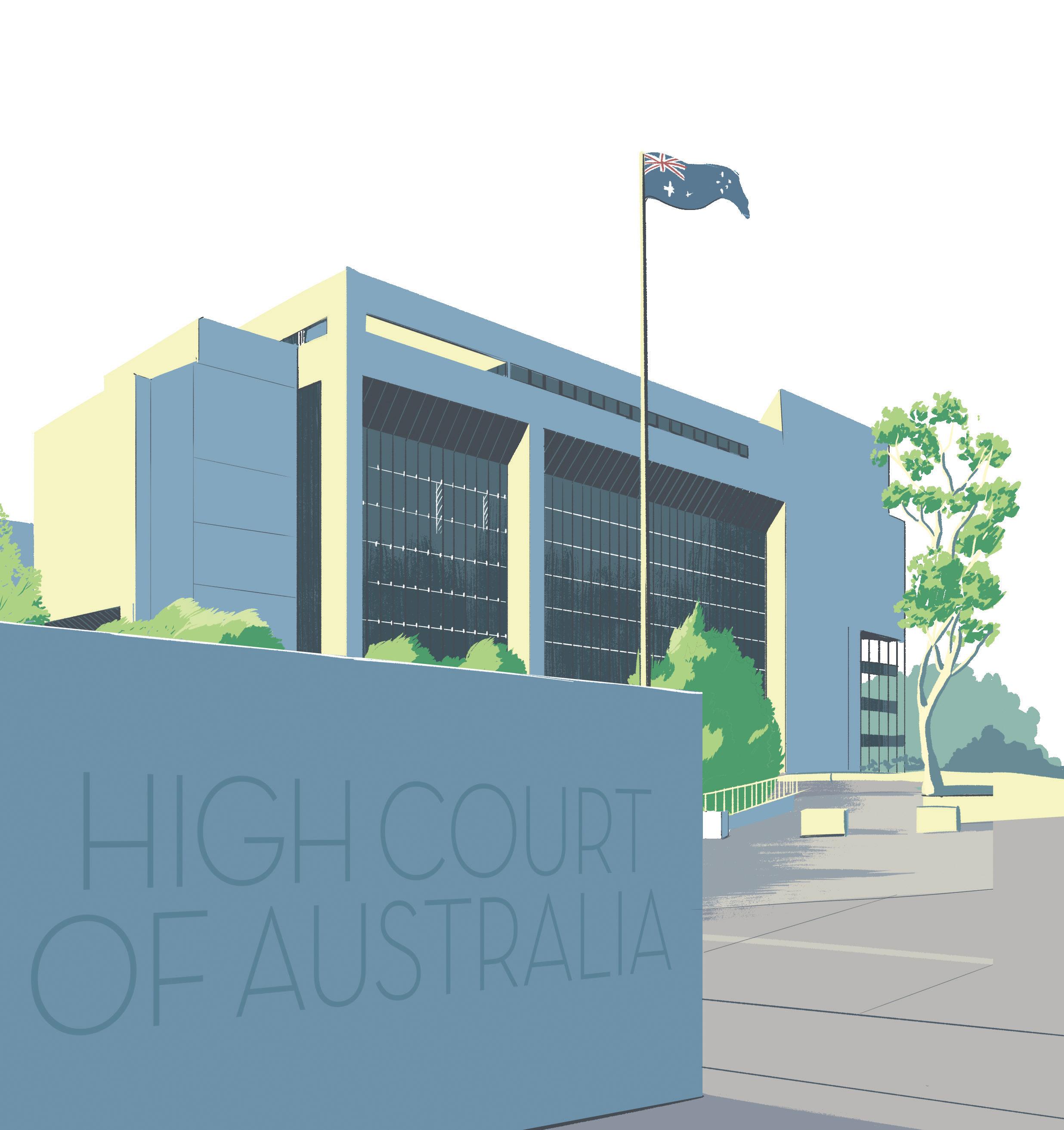
In Davis v Minister for Immigration, Citizenship, Migrant Services and Multicultural Affairs; DCM20 v Secretary of Department of Home Affairs [2023] HCA 10 [176] (12 April 2023), Edelman J wrote:
… any reasonableness requirement for the exercise of an extremely broad non-statutory executive power will usually involve a high threshold. As Steward J rightly points out in his Honour’s reasons in this case, the various reasons given by the officials in relation to Mr Davis’ requests can be characterised as
ungenerous and unsatisfactory. The decisions of the officials in relation to both Mr Davis and DCM20 do not reflect the virtue of exceptional charity and equity—for others, tzedakah or zakah—which is part of the foundations of the grant to the Minister of the liberty and power in
s 351(1). But that lack of virtue may not be sufficient to establish any high threshold of legal unreasonableness in the result if that issue were to arise.
As a result of the extract above, some administrative law practitioners were left scratching their heads. The words “tzedakah” and “zakah” do not appear in any administrative law textbook. Was Justice Edelman propounding some new legal principle? Or was his Honour borrowing a concept from another common law jurisdiction? Neither, as it turns out. His Honour was referring to ancient equitable concepts, well known to adherents of the Jewish and Muslim religions, but perhaps less well known to others.
Tzedakah is derived from the Hebrew root-word “tzedek” which can be translated as “righteousness” or “justice”. In Deuteronomy 16:20 the phrase appears: “tzedek, tzedek, tirdof”. The King James Bible translates it as “that which is altogether just shalt thou follow”. The New International Version translates it as “follow justice and justice alone”. Both of these translations attempt to capture the imperative form “tirdof” of the Hebrew verb “lirdof” (Eng: to chase or pursue). It forms part of an extensive passage where Moses reminds the Jews, still wandering in the desert, of the covenant that they previously made with God at Mount Sinai. That covenant is recorded in the Ten Commandments. But in reminding the Jews of their covenant, Deuteronomy expands the original list of 10 commandments to include additional but unstated obligations. A modern contract lawyer might call them “implied terms”.
Thus, the commandment is “justice, justice, shall you pursue”. As we lawyers know, unless the context indicates otherwise the word “shall” connotes a mandatory obligation.1
The word “tzedakah”, as used by Justice Edelman, is a noun. Over time, it has come to mean “charity”. But it is important to
recognise that, according to its root, it is not restricted to the act of giving. Nor is it voluntary.
“Tzedakah” is therefore a personal obligation to achieve justice for others.
The linguistic meaning of the Arabic word, “Zakah” or “Zakat”, is “to purify”, “to grow” or “to increase.” In an Islamic legal context, “zakah” is the obligatory distribution of money from the wealthy to the poor on an annual basis. The obligation is specific—it requires every able Muslim to donate annually exactly 2.5 per cent of their wealth to the socially and economically disadvantaged.
Zakah is one of the “Five Pillars of Islam”. The Prophet Muhammad was reported to have said that Islam is built upon five pillars: the declaration of faith, prayer, zakah, Hajj (pilgrimage) and fasting.2
Verse 60 of the chapter Al-Tawba in the Quran states:
Indeed, “prescribed charitable offerings” are only to be given to the poor and the indigent, and to those who work on administering it, and to those whose hearts are to be reconciled, and to free those in bondage, and to the debt-ridden, and for the cause of God, and to the wayfarer. This is an obligation from God. And God is all-knowing, all-wise.
“Zakah” requires the acceptance of the idea that your wealth does not entirely belong to you. It obligates the distribution of a person’s wealth in a manner that alleviates the struggles of others and ultimately, strives to eliminate inequality. When the linguistic and legal meanings of “zakah” are considered together, it can be inferred that the act of giving charity leads to a purification of the spiritual heart whilst also facilitating its growth.
While “zakah” refers to the specific obligatory act of giving charity, voluntary acts of charity are called “sadaqah.” Like the Hebrew “tzedakah,” the Arabic “sadaqah”
also means “righteousness.” The concept of “sadaqah” is not limited to the distribution of wealth, but encompasses any act that is committed with the intention of bettering the state of others— even a smile can be “sadaqah”.
As Justice Edelman notes, the practice of both “zakah” and “sadaqah” in the Islamic tradition is to strive for justice and equity with generosity.
Justice Edelman explained his use of the terms by adopting the English words “the virtue of exceptional charity and equity”. This recalls the notion of Christian virtue expounded by Thomas Aquinas: “the habit of charity extends not only to the love of God, but also to the love of our neighbour”.3
His Honour was therefore referring to a religious duty—in Christian, Jewish and Muslim faith—to treat each other equitably, righteously, and with love. His Honour explained that the failure of such a duty does not establish legal unreasonableness in the result. In other words, the doctrine of legal unreasonableness remains unchanged.4
The Davis decision was handed down two days after Easter Monday 2023. This year Easter, Passover and Ramadan all coincided—an accident of the calendar that occurs only once every 30 years. We cannot help but think that his Honour was acutely aware of this temporal event, and took the opportunity to remind us all of the duty to treat each other with charity and equity—to show each other “tzedakah” and “zakah”. And, as his Honour correctly identified, to do so is an act of virtue.
1 Section 45, Interpretation of Legislation Act 1984 (Vic)
2 Sahih al Bukhari 8, Sahih Muslim 16.
3 Summa Theologica: The object of charity, (II-II, Q.25)
4 Associated Provincial Picture Houses Ltd v Wednesbury Corporation [1948] 1 KB 223.


NICK GADD
Does the law concerning the definition of recklessness need to change? Opinions differ widely, the Victorian Law Reform Commission (VLRC) has found.
The VLRC has been asked by the Attorney-General to review the use of recklessness in relation to offences against the person. It is considering whether the Crimes Act 1958 should be amended to include a definition of recklessness, and, if so, which definition. Recklessness is not consistently defined in Victorian legislation and in most cases takes its meaning from the common law. A key question for the VLRC to consider is whether there is a gap in the law in Victoria, meaning that some culpable behaviour is avoiding criminal punishment. The Victorian legal community has
expressed strong and diverging views on this question.
In 1995 the Court of Appeal affirmed in R v Campbell1 that an accused is reckless if they know that a particular harmful consequence will probably result from their action but they continue regardless. This definition now applies to all offences against the person in the Crimes Act that include recklessness as an element, such as causing serious injury recklessly.
In New South Wales the “foresight of probable harm” test applies only to murder. For other offences against the person involving recklessness, the accused need only have foreseen the possibility that harm would occur for recklessness to be established. In 2021, a minority of the High Court said that, except for murder, foresight of the possibility of harm is the correct test for recklessness.2 However, the majority held that the foresight of probable

harm test “should stand [in Victoria] unless addressed by the legislature”.3
The majority noted that the test has been used in Victoria for decades and concluded it was not the High Court’s role to substitute a different test.
Submissions to the inquiry closed in March, and since then the Commission has been conducting consultations with key organisations including the Office of Public Prosecutions (OPP), Victoria Police, the Criminal Bar Association (CBA), Victoria Legal Aid, the Law Institute of Victoria, the courts and others.
According to some stakeholders, particularly the OPP and Victoria Police, the current law is inadequate. The OPP submission cited the hypothetical situation of person A who becomes aggressive under the influence of alcohol and strikes person B, causing B to fall and hit their head on the floor, resulting in traumatic brain injury. The OPP is of the view that a charge of recklessly
According to some stakeholders, particularly the OPP and Victoria Police, the current law is inadequate.
causing serious injury would be appropriate. However, it would be open to person A to argue that while they were aware they would probably cause an injury to person B, they were not aware of the probability that it would cause a serious injury. In the OPP’s view, in this circumstance it would be extremely difficult for the prosecution to make out a charge of recklessly causing serious injury.
Thus, the OPP argued that the current definition means that cases are sometimes resolved, or discontinued, “in a way that means legal culpability does not always reflect moral culpability.”
Victoria Police also argued in favour of change, submitting that it is difficult to prove foresight of probable harm under the current definition, which causes undesirable results in practice. Victoria Police provided the example of DPP v Saurini, 4 in which a police officer was seriously injured when they were struck by a vehicle driven by the accused, who was later charged with recklessly exposing an emergency worker to risk by driving. The accused said that he did not know he had struck an emergency worker, and was acquitted of the charge, though he was convicted of the charge of negligently causing serious injury.
The CBA put an opposing view in its submission, arguing that cases like the hypothetical one described by the OPP often do in fact result in convictions for recklessly causing serious injury. It said that the conduct described could be prosecuted as alternative charges, such as intentionally causing injury, which carry a maximum penalty of 10 years imprisonment. The CBA’s view is that “if the possibility test were applied then the reach of the offence
of recklessly causing serious injury would be oppressively wide.”
According to the CBA, the current test:
has the benefit of having operated satisfactorily for many years, without any genuine suggestion that the definition has resulted in persons escaping the reach of the criminal law … in circumstances which would be generally considered unjust or inappropriate.
The concerns of the CBA have been echoed by Liberty Victoria. The case for no change has also been made by organisations including Victoria Legal Aid and the Law Institute of Victoria, which considers the current definition to be “appropriate and fit for purpose”. These and other submissions take the view that there is insufficient evidence of a problem and no compelling case for reform. They argue that changing the definition would dramatically broaden the net of culpability for many offences and may lead to more incarceration and longer sentences.
The VLRC will weigh up the views expressed in submissions and consultations before delivering its recommendations to the Attorney-General early next year. For more details on this inquiry, including all the public submissions, visit lawreform.vic.gov.au.
1 [1997] 2 VR 585.
2 Director of Public Prosecutions Reference No 1 of 2019 [2021] HCA 26; 392 ALR 413 (Kiefel CJ, Keane and Gleeson JJ).
3 Director of Public Prosecutions Reference No 1 of 2019 [2021] HCA 26; 392 ALR 413.
4 [2022] VCC 1054.
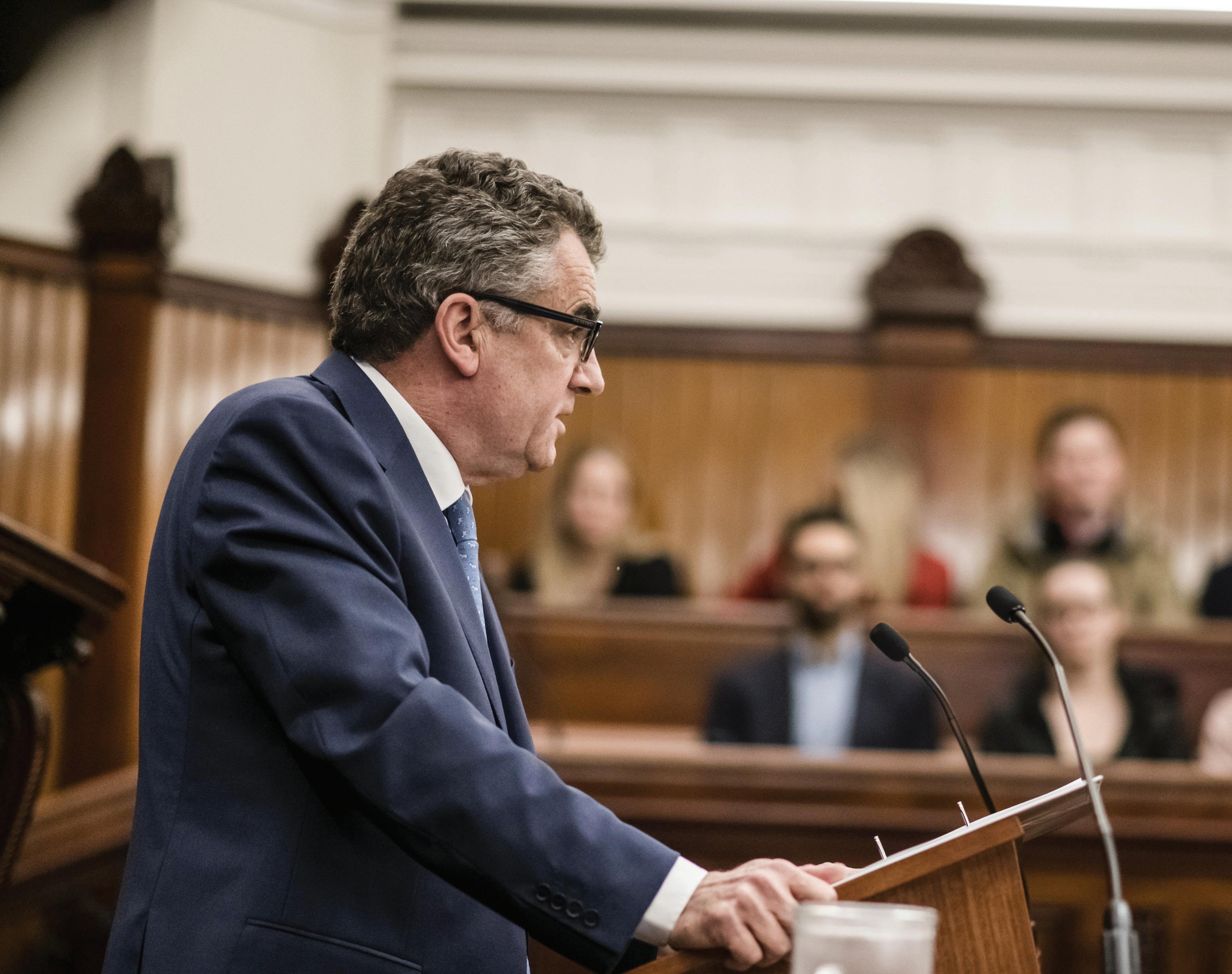
MAREE NORTON AND EMMA POOLE
“An adventure.” That is how the Hon Chris Maxwell AC, retired President of the Court of Appeal, describes both his experience on the court and the next phase of his life.
Victorian Bar News recently interviewed Chris (as he prefers to be called) about his time at the court and, prior to that, the Bar. During our conversation, the words that recurred were “excitement”, “stimulating”, “unexpected” and “opportunity”.
Reflecting on his 17 years as an appellate judge, Chris referred in particular to the pleasures of collaborative work, and the choices that lawyers, and particularly barristers, can make about how to approach a life in the law.
Justice Maxwell joined the Court of Appeal as President on 18 July 2005, following the Hon John Winneke QC. He had signed the Bar Roll in 1984 and taken silk in 1998. Before joining the court his Honour had served as President of Liberty Victoria, and spent seven years as a member of the Victorian Legal Aid Commission.
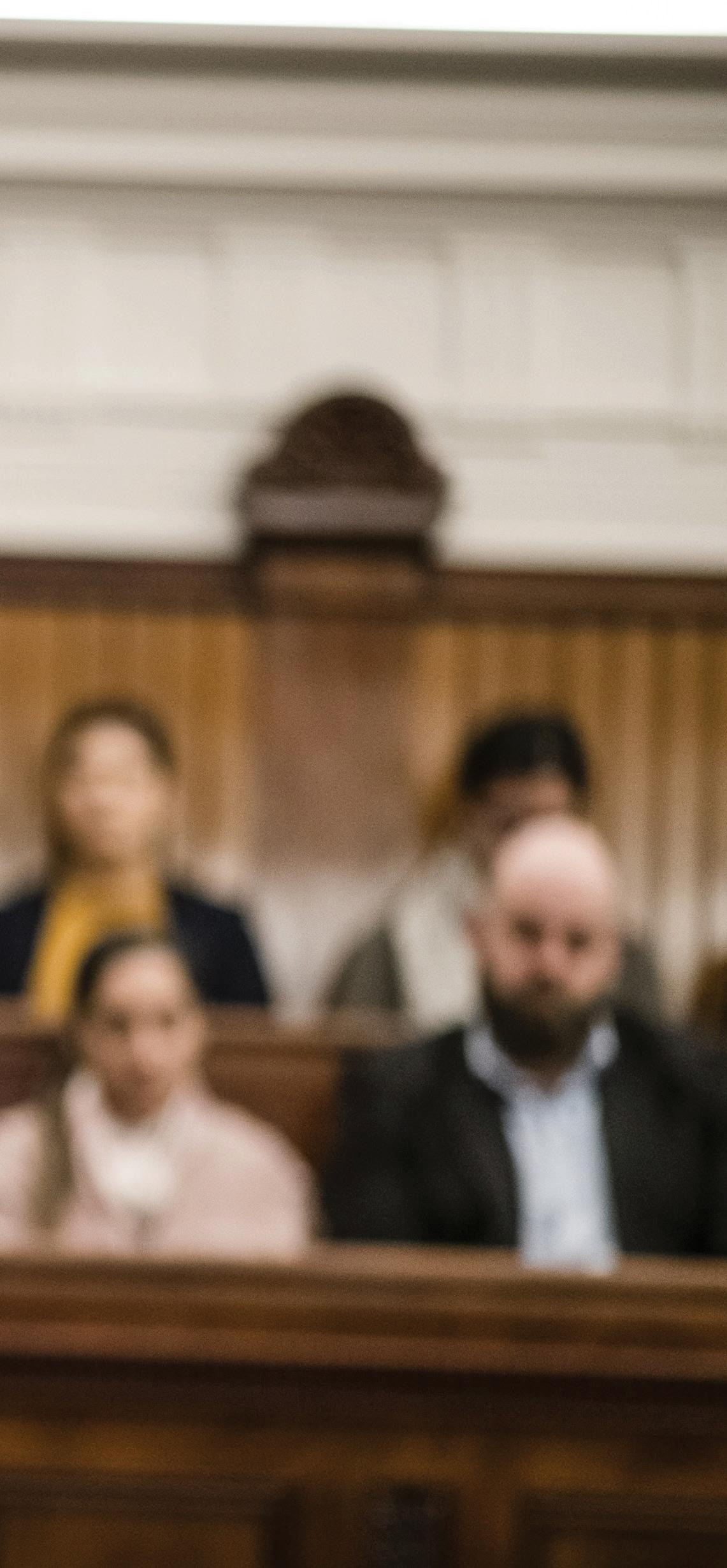
In his retirement speech ‘The Quietest Branch’, delivered at a farewell sitting on 22 June 2022, Justice Maxwell said that his “greatest thrill” had been “to discover the richness and diversity of the justice system and to experience the joy of participation in it”. He acknowledged “the dedicated efforts of people across the justice system” to maintain a level of service to the hundreds or thousands of Victorians who have some form of contact with courts and tribunals every day. He went on: “The more our fellow citizens understand what extraordinary work is going on every day, the greater will be their sense of security and well-being.”
The more our fellow citizens understand what extraordinary work is going on every day, the greater will be their sense of security and well-being.
Describing Victoria’s criminal justice system as being of “unflinching integrity”, Justice Maxwell instanced the high standard of the work done every day in sentencing courts, the “skill and compassion” with which magistrates deal with their busy lists, and “the unheralded work of judges, juries and practitioners in jury trials”.
In discussion with Bar News, Chris said he had realised early on that appellate judges have the opportunity—and the responsibility— to contribute to improving the justice system. “We are, after all, uniquely placed to see what works and what does not”.
As examples, he referred to the reforms in relation to jury directions and forensic evidence. Reform to jury directions, now consolidated in the Jury Directions Act 2015, resulted from collaboration between the Supreme Court and the Department of Justice, with sustained contributions over almost a decade from judges, the Office of Public Prosecutions, the Criminal Bar Association, Victoria Legal Aid and legal academics.
At his farewell, Justice Maxwell said that the result of this collaborative process was “the system working at its best… shorter trials, simpler directions, fewer appeals, fewer retrials and... happier trial judges.” He added, “We are lucky to have leaders in the Victorian system who, when you suggest a working group to try and solve a problem, will step up without hesitation”.
Justice Maxwell also spoke of the pleasures of collaborative work in a collegiate court. In four out of five cases, he noted, the judgment of the Court of Appeal is a joint judgment. He said, “It is an amalgam, a bringing together of the experience and knowledge of the individual judges, a collaboration in pursuit of justice”.
In a speech to an appellate judges’ conference last year, Justice Maxwell summed up his time as an appellate judge in three words: “surprised by joy”. He spoke of discovering a “wholly new curiosity about law and about adjudication” and acquiring “a new appreciation of the roles which judges are called on to play”. He had not anticipated the intellectual excitement of engaging with counsel and with his fellow judges, exploring arguments: “The way argument would lead from one thing to another, the excitement of the thinking, the writing, the analysis, the drawing of threads together in the judgment writing process”.
At his farewell, Justice Maxwell said that he had come to recognise that judging has “a crucial moral dimension”, for example, when dealing with explicitly moral concepts like ‘unconscionability’ and ‘moral culpability’. In 2014, he joined forces with a philosopher and a legal philosopher to create an interdisciplinary subject at Melbourne Law School called ‘Philosophical Foundations of Law’ which aims to develop in students both a high-level understanding of how legal rules embody and reflect important philosophical notions, and philosophical rigour in the students’ own thinking about legal questions.
As he said in our interview:
So much of our substantive law rests on philosophical foundations about responsibility, autonomy, agency, relationships between the citizen and the state, the limits on one’s civic responsibility to someone else for the effects of one’s conduct.
In a recent article for the Melbourne University Law Review, Justice Maxwell and Professor Matthew Harding explored the role of moral reasoning in the application of the concept of ‘unconscionability’. In
discussion with Bar News, Chris talked of the practical implications of this issue for lawyers, and particularly barristers, in cases where unconscionability is raised as an issue and the judge is required to make a moral judgment.
He noted the complex and nuanced debate concerning whether a lawyer has any role as moral counsellor when giving legal advice. The argument in the joint article is that a provision like s. 21 of the Australian Consumer Law, which prohibits unconscionable conduct, requires lawyers to discuss with their clients the morality of the relevant conduct. This is not because the lawyer approves or disapproves of the conduct but because the court will be required to make a moral judgement about it and consider, for example, whether a transaction should be set aside.
The article also refers to areas of legal ‘indeterminacy’, where there is a gap in the rules, or the law does not dictate the answer, or where general terms like ‘reasonableness’ have to be applied. Here the judge’s decision will involve considering what the just outcome would look like. “So there is moral reasoning going on, implicitly at least”, Chris says, which means that in these cases barristers must consider what sort of reasoning to deploy to persuade the judge that “justice” favours the outcome they seek.
Asked what advice he would give young barristers, Chris highlights the importance of embracing opportunities, even in new areas. “The law is rich with opportunities and… you can end up doing all sorts of things with your legal skills”. When called on to address newly admitted lawyers at admission ceremonies, he would reflect on the “exciting possibilities” of a career in the law. However, he also acknowledges his experience of self-doubt, particularly in his early years at the Bar.
In his first two years, Chris was
often in the Magistrates’ Court, making pleas in mitigation (“I was good at those, because there were no disputes of fact. I would go back to my mentor and he would say— did you get another bond? That was the highlight of my first two years—that I got another bond.”). The turning point, he recalls, was an early appearance in the Supreme Court. He was making submissions to Justice Hedigan and he recalls the judge looking at him and saying, “Mr Maxwell, I’m finding this quite helpful”:
My recollection is that there was a real note of surprise in his voice. And I was surprised myself, I can tell you! It was the first time when the skills I thought I had—not a bad writer, not a bad oral communicator—seemed to be working. And I thought: “Maybe I can do this”.
Chris’s message to those who face early disappointments or setbacks is, “Don’t be deterred, it gets better. With every day, your competence and your sense of your own capability will grow.” As he says: “Be open to opportunities, find where your strengths are, develop your strengths and then unexpected things happen.”
The importance of lawyers, and particularly barristers, recognising their capacity and responsibility to make a difference has been another of Justice Maxwell’s key themes. A good example of this has been his leadership in relation to gender diversity.
For him, the critical impetus to action was an invitation from then Equal Opportunity Commissioner, Kate Jenkins, in 2015 to join Male Champions of Change, an initiative by which men in senior positions were encouraged to step up and support women’s efforts to bring about change. As the Commissioner had asked him to work with the legal profession, Justice Maxwell created Advocates for Change, which enabled groups from the profession—
solicitors and barristers—to get together and discuss how to advance gender equality and eliminate sexual harassment in the profession.
Drawing attention to the inspiring degree of engagement by everyone— senior men, senior women, junior men, junior women—he recalls that participants seized the opportunity to think and talk about how they deal with gender issues: “and then participated with such goodwill and candour and courage. There was a real consensus that we need to do better, we can do better.”
Chris is cautiously optimistic about future progress in this area, due to “signs of progress in each of the key areas on which real change depends—awareness, engagement and leadership”. He says that, amongst lawyers, “there is a unity of purpose, an impatience with the current state of affairs and an eagerness to find solutions, which is inspirational”. And he points to the strong public positions taken by the High Court and the Supreme Court on sexual harassment by judicial officers.
Chris says: “Yes, I wish that change were happening faster. But the fact is that we’ve now got 40 per cent women on the Supreme Court and a third of Court of Appeal judges are female—that’s dramatic progress given that the first female judge was appointed to the court in 1996”.
The future is now Chris’s focus. He has enjoyed the different and unexpected opportunities that have come to him since his retirement.
He highlights his experience visiting Port Moresby in November 2022 as part of a VicBar advocacy training team, and his work with law schools, the Judicial College and the Judicial Commission.
In keeping with the enjoyment of collaborative work and intellectual curiosity that have characterised his life so far, he adds: “The next phase is an adventure. Unwritten. You just don’t know what’s coming next.”

KRISTINE HANSCOMBE
The recent determination by the Coroner's Court regarding the death of Ms Veronica Nelson, a First Nations prisoner, resonated with me. I am confident that it will have resonated with many members of the Bar for similar reasons. The topic continues to merit reflection.
It resonated because over 20 years ago, I appeared as counsel at the inquest into the death of the first prisoner to die after what is now the Dame Phyllis Frost Centre had been privatised. I shall call her Ms X. I represented her partner. Ms X was not indigenous, but she did have two other marginalising attributes: she was grossly obese, and she was intellectually disabled. She was also a severe asthmatic, which was known to the Corrections department, the prison operator, and the private medical services provider at the time she was imprisoned.
Initially the whole enquiry had been scheduled to take two hours. By the time it was finished, and the relevant witnesses had been called and examined, the oral evidence had taken over five days. Most of the documents that were finally produced were brought to light in the course of that process. These facts cast some light on the importance which this death had initially been accorded, and the amount of relevant evidence which was finally exposed.
The post-mortem determined that Ms X had died of a severe asthmatic event. The call logs of the intercom system showed that this had happened while she repeatedly, and unsuccessfully, tried to get help.
As with Ms Nelson, Ms X’s only means of getting help was the use of the intercom. And as with Ms Nelson,
she was repeatedly told to be quiet, and her pleas were ignored.
The recordings of the calls showed that in the last hours of Ms X’s life, she became incomprehensible and largely inaudible, pretty plainly because she couldn’t breathe. Once that was perceived by the call taker, the intercom was not answered at all. When I asked the call supervisor why not, his answer was to the effect, “well what’s the point if she doesn’t speak?”. And when I asked him what was the arrangement for a prisoner who couldn’t talk, he said that they’d never thought of that.
So, we were left then, and again now, more than two decades later, to contemplate the horror of a lonely death, pleading for help, locked up in the world’s most liveable city.
The private operator of the prison made promises to lift its game. So did the private medical services provider. The Coroner made an extensive set of recommendations to stop such pointless and preventable deaths from occurring again. I do not know how many of those recommendations were ever implemented, nor how many of the promises were kept.
I do know that since then, the state has taken over the operation of the prison, and that the medical services provider at the time of Ms X’s death was not involved in Ms Nelson’s. And we all know that such deaths continue. What will it take for imprisoned people to be safe in their cells, to be secure in knowing that help will come when they need it? And, in particular, what will it take for First Nations and other marginalised people to have that security?
Again and again it is said that a society should be judged by how it treats its most vulnerable; again and again we fail that test.
Ranitha Gnanarajah is a Sri Lankan lawyer who completed the Victorian Bar readers’ course in October 2018.
Shortly after Ranitha signed the Roll of Overseas Counsel, she was given a fond farewell by her fellow readers as she left Melbourne to continue her important work in Sri Lanka, where she advocates for victims of enforced disappearances and prisoners detained without charge.
Ranitha was recently honoured at the White House as one of very few women from around the world to have received the US State Department’s International Women of Courage Award. The award recognises women who have demonstrated exceptional courage, strength and leadership in advocating for peace, justice, human rights, gender equity and equality, and the empowerment of women and girls. Ranitha was named as a recipient of the award in 2021, at the height of the pandemic. On International Women’s Day, 8 March 2023, Ranitha was finally presented with her award in-person by First Lady Jill Biden and Secretary of State Antony J Blinken.
Ranitha says she was happy and excited to receive the award, but notes, “It was not an honour for me only; it is an honour for all human rights defenders who are fighting for justice and accountability [for] war related crimes.” She dedicated the award to “all my fellow colleagues who are travelling with me in this journey”.
In nominating Ranitha for the award, Alaina Teplitz (the US Ambassador to Sri Lanka until 2021) said:
Ms Gnanarajah is a lawyer who fights on behalf of Sri Lanka’s most vulnerable populations, including families affected by enforced disappearances, survivors of gender-based violence, and religious and ethnic minorities. She’s dedicated
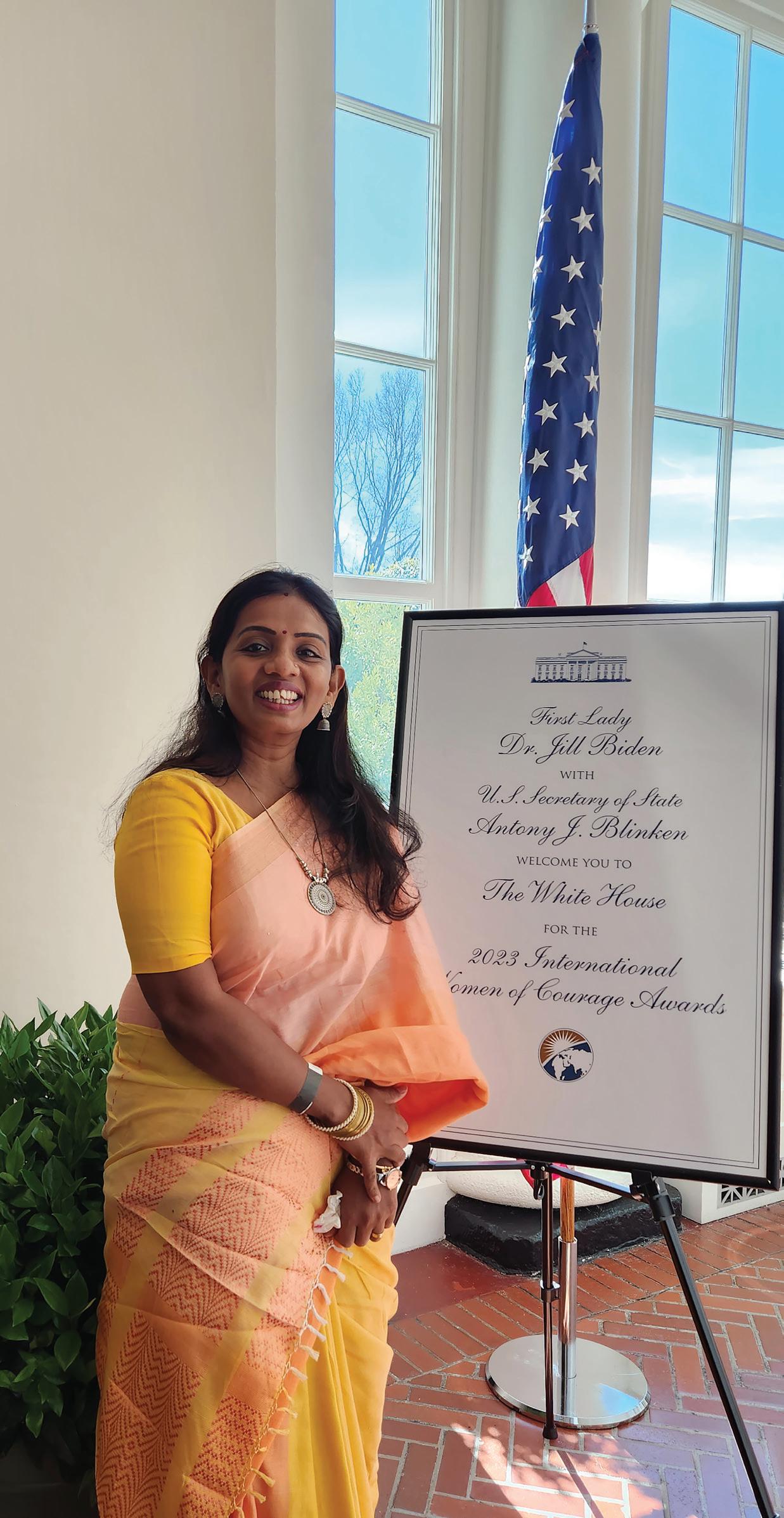
her life to the pursuit of justice, often at considerable personal risk. Some of her most impressive work involves advocacy for families of the disappeared, and for prisoners arrested under Sri Lanka’s Prevention of Terrorism Act who are often detained for years without charges.
Ms Gnanarajah has also worked tirelessly to build the capacity of grassroots organisations that advocate for women’s equal rights to land and property and to stand against gender-based violence. Among her many accomplishments, I am most inspired by her leadership
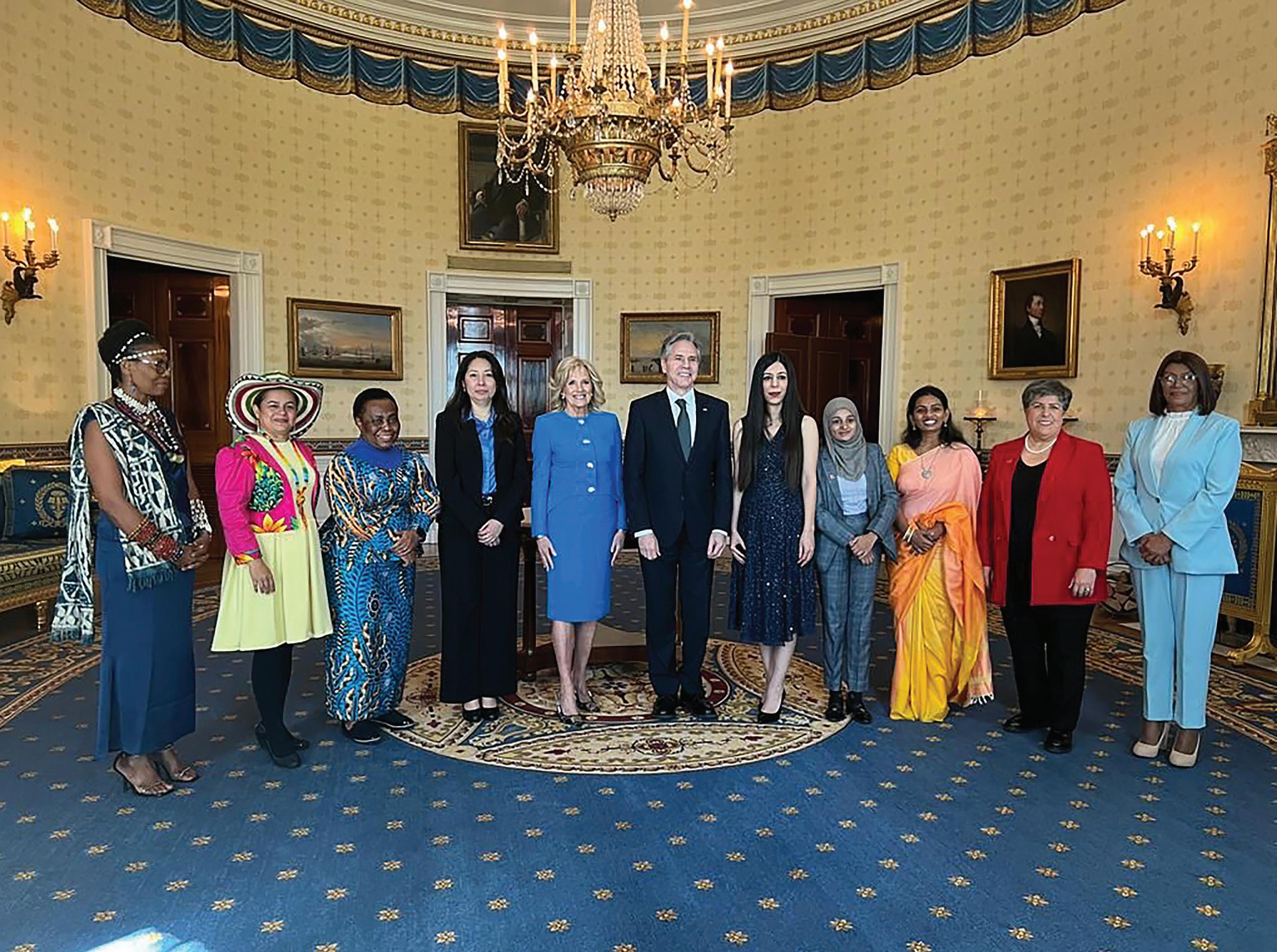
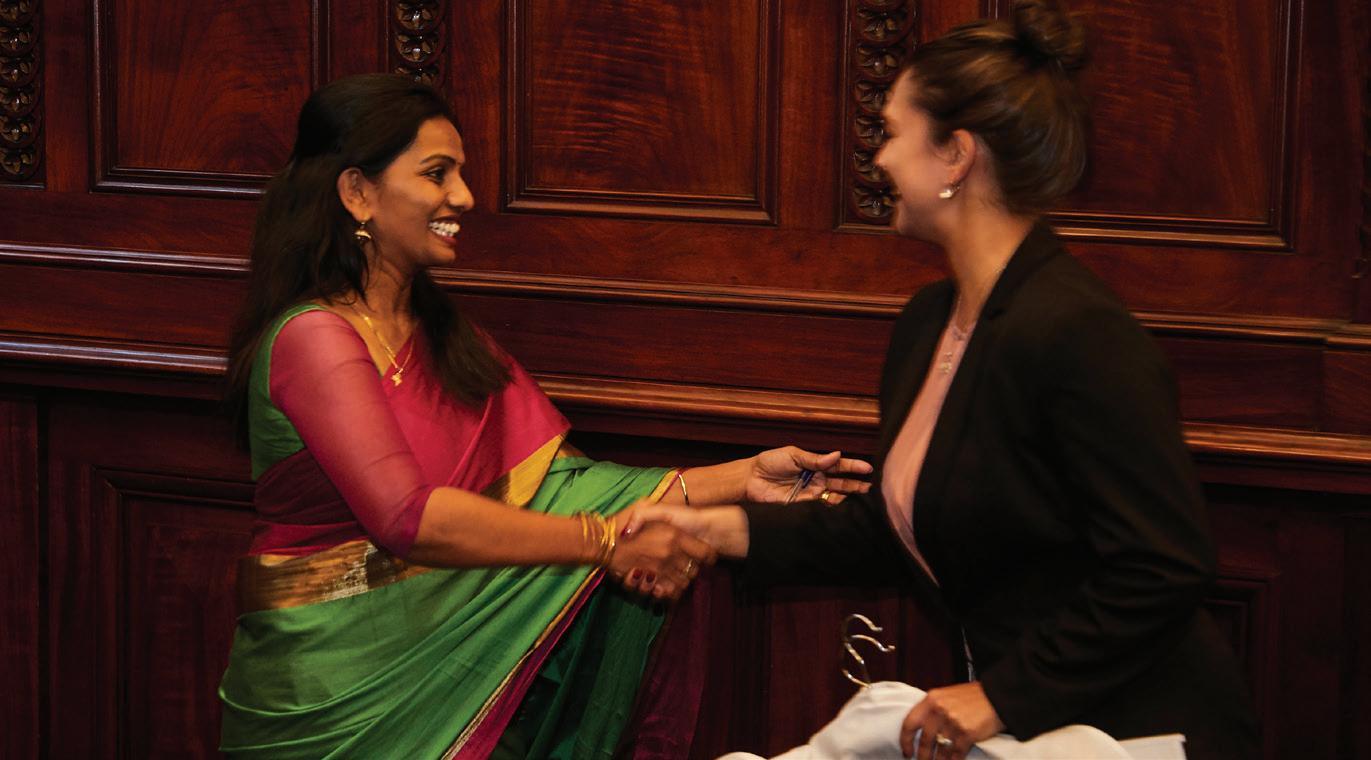
and advocacy for a victim-centred approach for inquiries into enforced disappearances stemming from Sri Lanka’s 30-year civil war.
A tireless advocate for women, Ms Gnanarajah’s important domestic violence research identified deficiencies at police stations that impeded women’s ability to seek protection from abuse and
harassment. Her representation of survivors in court and her leadership of awareness campaigns to educate women about their rights resulted in increased access to women’s shelters, counselling services, and medical care for domestic violence survivors across the country.
Ms Gnanarajah has helped the most vulnerable people avail themselves
“It was not an honour for me only; it is an honour for all human rights defenders who are fighting for justice and accountability for war related crimes.”
of their rights and in doing so is a model of courage in Sri Lanka and around the world.
It is an honour to count Ranitha as a member of our close-knit readers group and we are delighted to celebrate her achievement and share this news with the broader Bar.
Congratulations, Ranitha, from your fellow readers!
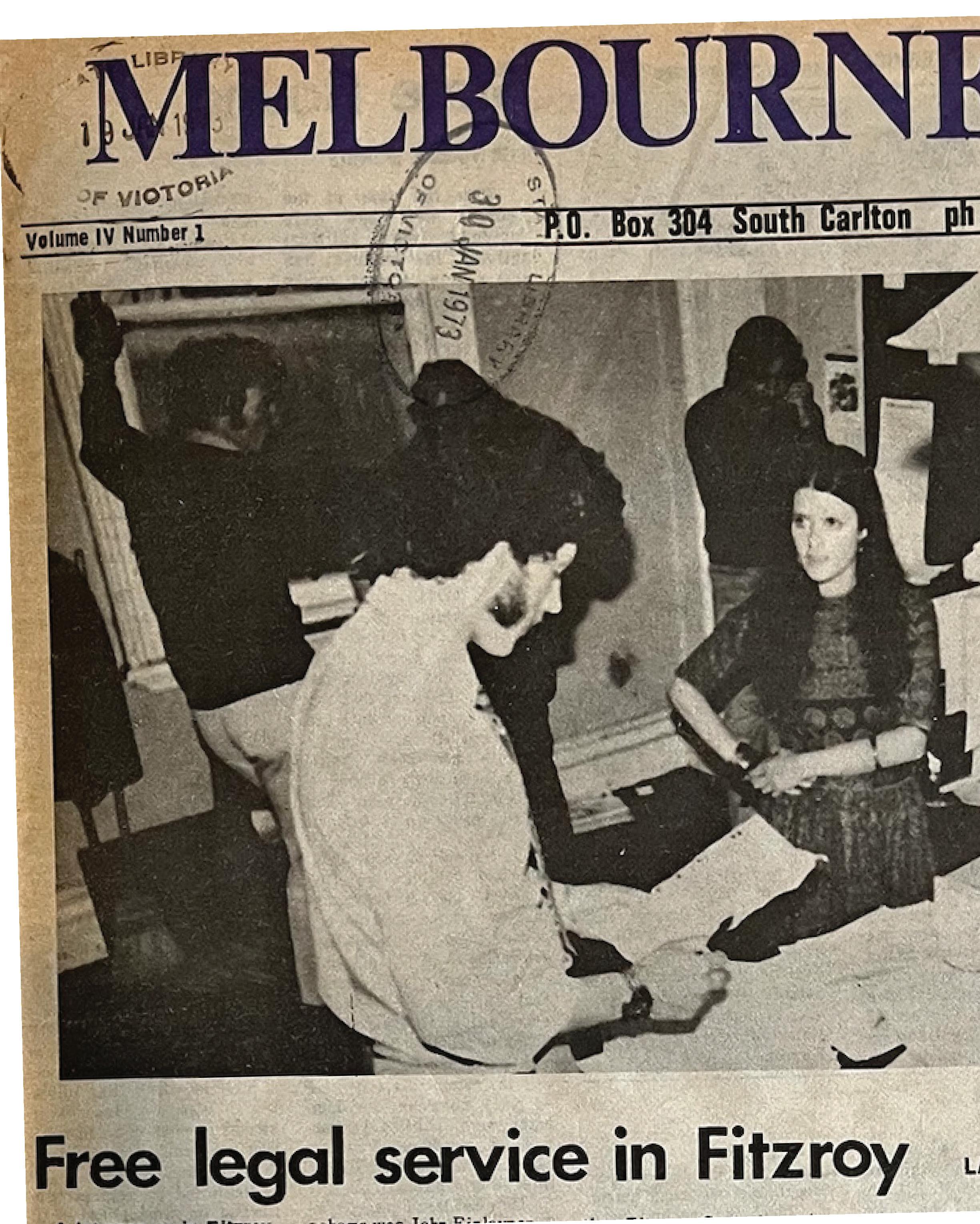
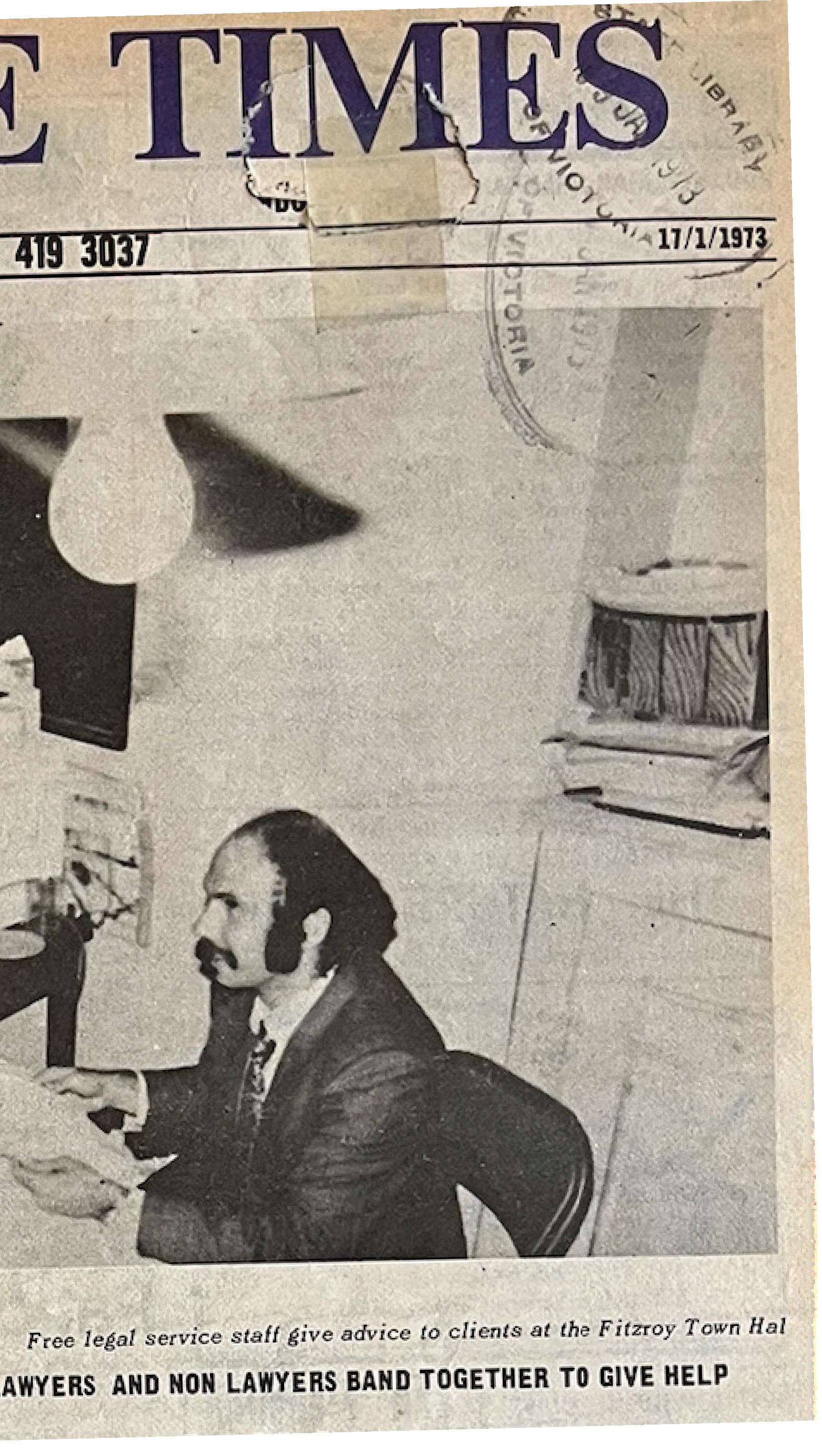
BENJAMIN LINDNER
Two lawyers, sporting mutton chop sideburns and a philanthropic bent, were depicted on the front page of the Melbourne Times on 17 January 1973. The accompanying article reported on the birth of Australia’s first free community legal service it was a novel social phenomenon that had just opened for business in the basement of the Fitzroy Town Hall.
They were heady times. Edward Gough Whitlam had just led the Labor Party out of the wilderness, winning the federal election on 2 December 1972. By then, John Finlayson, a youth worker1 with radical ideas, passionate about having his clients receive legal advice and representation in court, was already sourcing lawyers and others to realise his simple vision, expressed in the sub-title of the Melbourne Times article: “Lawyers and non lawyers band together to give help”
“Finno” (aka John Finlayson) initially canvassed the idea of a free legal service with Michael O’Brien, then an articled clerk, and Lou Hill, who was completing his law degree.2 He also joined with a kindred spirit in Peter Faris, a barrister. Meanwhile, a “Free Store” which stocked clothes and other commodities, all of which were given, free, to those in need was operating out of 42 Smith Street, Collingwood. Remy van de Wiel, then a city solicitor, dispensed free legal advice from the back of the Free Store throughout 1972.3 The free community legal service experiment had not been effectively initiated before in Australia, and certainly not on the scale envisaged by
Finno and his new legal associates. It was the Age of Aquarius. As Whitlam proclaimed on the larger political stage, “It’s Time”.4
John Finlayson wanted the Fitzroy Council to employ a solicitor full time to assist young people for whom he spent so much time giving character evidence in court. He hoped that, eventually, all legal costs would be borne not by the local council but by the Commonwealth government.5 His vision bore fruit within six months when The Age reported:
The Attorney-General (Senator Murphy) yesterday announced that an immediate grant of $2,000 would be paid to the Legal Service for Fitzroy, to assist in its operation for the next few months. Senator Murphy said he considered the scheme was worthy of support as a pilot project in demonstrating “the unperceived needs of poor people and in supplementing the various legal aid services already existing in the states and territories.”
The Attorney-General said, “officers from his department would consult with the people operating the service when a clear pattern had been established to decide whether centres could be set up on a similar basis throughout Australia.”6
That initial grant came after six months of frenetic activity in laying the foundations of the Fitzroy Legal Service (FLS). Finlayson, Michael O’Brien, Lou Hill, Peter Faris and Remy van de Wiel were all fomenting similar ideas about establishing a free legal service. They were not interested in setting up a mere referral service but in arranging for representation and advice from practising lawyers.7 Lawyers, social workers and other non-lawyers were contacted to come aboard. Then, on 13 December 1972, a mere 11 days after Whitlam’s ascension to the office of PM, a meeting was held in the Fitzroy Town Hall attracting some 80 participants.8 Despite premonitions of gloom and doom from the cautious, the service
swung into action only five days later on 18 December 1972.9
John Finlayson’s office, located in the basement of the Fitzroy Town Hall, was entered from Condell Street. The first step towards free legal advice required a steep descent by five bluestone steps into the room, affectionately known as “the dungeon”. Its crowded ambiance is not properly captured in the Melbourne Times photo.10 Importantly, the Fitzroy Council provided the dungeon/office with a telephone, as well as the first client, who was said to have been supplied by the Mayor, Billy Peterson.
By mid-January 1973, the free legal service was open every night except Sunday, from 5.30pm until 11pm, thus enabling people to discuss their problems without needing to take time off work. About 60 people (both lawyers and non-lawyers) participated in the service by this time, with at least one lawyer and non-lawyer rostered each night. In its first weeks, it was reported that:
The service has dealt with a wide range of problems including crime, divorce and maintenance, how to get social welfare benefits and what to do about dishonest car dealers.
In many cases the problem can be dealt with on the spot.11
The multicultural clientele was recognised from the very outset. A leaflet had been prepared in nine languages for distribution, advertising the free legal service in the Fitzroy area, and interpreters were organised.
Well before Attorney-General Murphy put his hand in the Commonwealth pocket to assist in funding the service, it started off with a budget of $500 constituted by “loans”.12 It is unclear whether those loans were ever repaid! However, in addition to the Attorney-General’s funding, the service had, by then, received three other donations: $300 from the Council for Civil Liberties, 20 jars of coffee from
a client, and one gross of ball point pens from Parker Pens Australia.13 Peter Faris had personally spoken to the Attorney-General who told him, “you’re doing a fine job down there”.14 That’s how FLS secured $2,000 from the Commonwealth government within seven months of a federal election.
By June 1973, there had been three general meetings to establish the prerequisites of a pro bono legal service delivery organisation. It had to be more than a daily roster for six days per week. The first general meeting was “well attended, useless in terms of actually solving problems but useful in the sense that it gave everyone a chance to yell at each other.”15 The meeting, however, did end on a constructive note, with the decision to elect a “central committee” and to establish a number of work groups.
The second general meeting established the general format of the structure of the service for ratification.
The third was totally unlike any other. It boasted a chairperson. It was quiet. It was orderly. A central committee was elected for a three-month period only. It consisted of “Don Opie, Chris Bishop, Mike Saleeba, Mick O’Brien, Geoff Eames, Ellen Hayman, Felicity Faris, Vivienne Altman16, Vince Ruis, John Zakharov. The ex officio members were the three co-ordinators, Phil Molan, Peter Faris and Remi [sic] van de Wiel.”17 Of the 11 work groups established, Peter Faris had charge of “Files and File Supervision”, Geoff Eames had “Means Test and Limitations” and Remy van de Wiel had “Resources”
As for Phil Molan, he had just sold his practice and, in July 1973, commenced work as the first solicitor to run the Aboriginal Legal Service, then located in Gertrude Street, Fitzroy.18 He continued to be involved with the FLS, although Geoff Eames co-ordinated for him in July/August 1973.
It did not take long for the pilot project to spawn children. Five other free legal service s were operating by mid-1973. Springvale was said to be “booming”, open Tuesdays and Fridays, 6.30pm –10.30pm with Neil Rees and Phil Slade at the helm. St. Kilda’s service was “operating”. Broadmeadows had “problems with lawyers but operating”, Prahran had premises ready “but problem with no lawyers” and, in Sunshine, a meeting had been held to discuss setting up the service. 19
The next general meeting of FLS was on 11 July 1973 with discussion to be on three topics, namely:
1. Anything anyone wants to discuss.
2. The setting up of a trust and passing of a constitution to enable us to accept money and be registered as a charity.
3. Possible election of a selection
1 Employed as Community Youth Worker by the Fitzroy Community Youth Centre.
2 Correspondence with John Finlayson, 17 January 2023.
3 J.Chesterman, “Law and the New Left—A History of the Fitzroy Legal Service, 1972–1994”, PhD Thesis, Department of History, University of Melbourne, 1995, pp.54-55.
4 For a thorough historical analysis, available online, see J.Chesterman, “Law and the New Left—A History of the Fitzroy Legal Service, 1972–1994”, PhD Thesis, Department of History, University of Melbourne, 1995.
5 Melbourne Times, Volume IV Number 1, 17.01.1973, p.1.
6 The Age, Saturday, 30 June 1973, p.3
7 Melbourne Times, op.cit.
8 Apart from all those mentioned in this paragraph, others included Peter Hollingworth (Director, Brotherhood of St. Laurence), Brian Howe (Director, Fitzroy Ecumenical Centre), Ron Westlake (Fitzroy Residents Association), Eileen Wheeler, (Mayor of Fitzroy), Eilish Cooke (social worker), John Knowles (social work student) and 13 young people who had applied to the Victorian Legal Aid Committee for legal assistance but been rejected.
9 The Melbourne Times article provides the dates of the first public meeting and the opening of the service. However, John Finlayson (correspondence, January, 2023) and John Chesterman
committee to appoint full-time day staff as a result of the grant”.20
Furthermore, because FLS had received the donations mentioned above, it was deemed necessary to appoint a treasurer at the next meeting.
The newsletter of June 1973 finished off with the following note, a symbol of the dedication (by an anonymous typist) shown by so many, lawyers and non-lawyers alike, now spanning five decades: “It is now 2.30am which accounts for the many typing mistakes in this newsletter.”
As for the lawyers depicted in the Melbourne Times story on 17 January 1973, the one on the left is Remy van de Wiel KC21 (signed Bar Roll, 5 April 1973) and the one seated is Stephen Lindner22 (signed Bar Roll, 24 November 1988). Both have since, in conferences, discarded the tie.
(“Twenty Years of Fitzroy Legal Service—A look back and a look forward”, (1992) 17 Alternative Law Journal 257) both assert that the first public meeting was on Thursday 14 December 1972, and the opening date of the service was Tuesday 19 December 1972. However, see J. Chesterman, “Law and the New Left—A History of the Fitzroy Legal Service, 1972–1994”, PhD Thesis, Department of History, University of Melbourne, 1995, pp.3031. He agrees the first public meeting was on Thursday 14 December 1972 but claims that the service first opened on Monday 18 December 1972. Finno now tells me (email 18.01.2023) it was supposed to open on the 18th but Faris had a brief that day, so it opened the next evening. I will leave it to others to XXN Finno about his prior inconsistent statement to Chesterman. More food for debate as to the true roots of FLS.
10 Ibid. [Author’s Note: The dungeon was “a dingy little office, where not even one stingy ray of sunshine struggles feebly down between the houses tall”, borrowing an insight from AB “Banjo” Paterson]
11 Melbourne Times, Volume IV Number 1, 17.01.1973, p.2.
12 Ibid.p.2.
13 Newsletter, Fitzroy Legal Service, June 1973, p.1.
14 Ibid., p.1.
15 Ibid., p.2.
Finally, the pro bono model that the Victorian Bar supports today arguably has its ideological roots in the machinations of those visionaries in 1972 and 1973.23
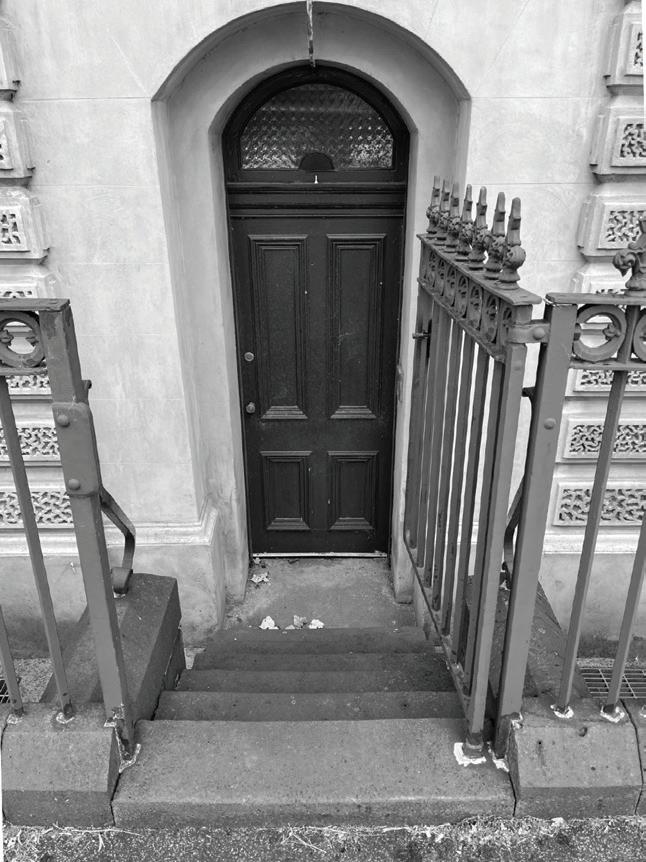
16 Vivienne is the woman, a non-lawyer, depicted on the front page of the Melbourne Times, 17.01.1973, p.1.
17 Newsletter, Fitzroy Legal Service, June 1973, p.2.
18 Melbourne Times, Volume 5 Number 6, 8/8/1973, p.1, ‘Legal Aid for Aborigines’.
19 Newsletter, Fitzroy Legal Service, June 1973, p.4.
20 Ibid [My emphasis, the first mention of a constitution for FLS thereby establishing its permanence].
21 Date of Admission: 3 March 1969.
22 Date of Admission: 3 August 1970; returned from travelling the overland hippy trail for two years in October 1972. In 1973, as legal officer with the Australian Legal Aid Office, he was among the first lawyers to see clients in their Sunshine office and, subsequently, in their Geelong office, before practising as a partner in Ellinghaus, Weill and Lindner until 1988. In 1973 Stephen would also drive a non-lawyer volunteer to the dungeon—I was a Year 12 student then.
23 Clearly, ALL of the 60 people that were rostered in the first days of FLS have not been named in this article. Many will cry foul over their omission. The author apologises in advance to all those who have been omitted by name—you were on the right side of history and can take immense pride in your collective legacy.
Bar Roll No 2806
ustice Riordan, who retired from the Supreme Court in December 2022, made a considerable contribution to the administration of justice in this state: as a solicitor, a barrister, a long serving member of Bar Council, and as a judge.
After graduating, his Honour commenced work at the family firm, Riordans, in Shepparton. He soon became a partner of that firm. He did much appearance work as a solicitor—and enjoyed it. As a result, in 1992 he moved with the family (his wife Jane and six children under 12) to Melbourne and joined the Bar.
As a barrister, his Honour had a broad practice and was very successful. This success was due to his hard work, intellect, and unfailing confidence. His Honour was always willing to take on difficult cases at short notice. In addition, he has an ability to remain calm in the midst of a storm and to focus on the real issues in dispute. He also has an innate common sense and easy manner. All these qualities endeared him to judges, colleagues, solicitors and clients.
As a result, apart from his successful practice as a barrister, his Honour was much in demand as a mediator. He excelled at getting litigants to make sensible compromises. In addition to all this work, he served on Bar Council for more than 12 consecutive years, including as chairman from 2007 to 2008.
After 40 years working in the law, his Honour was appointed a judge of the Supreme Court in 2015. He originally sat in the Common Law division and was made principal judge of the Commercial Court in 2017, following the appointment of Justice Kim Hargrave to the Court of Appeal.
Judicial office did not change his Honour; his many fine qualities and broad experience were evident in his work at the court. He was calm and had a practical, unstuffy manner as a judge. He encouraged the parties and their lawyers to identify and address the key issues in dispute in the most economic way. His reasons focused on the key issues and his conclusions were simply expressed. Notwithstanding his additional obligations as principal judge of the Commercial Court and as judge in charge of the Arbitration List, he continued to work hard and take on hard cases at short notice.
In his time at the Supreme Court, Peter displayed the ability to take on a number of different and varied tasks—and to perform them well and efficiently. As a result, he was a much-valued member of the Supreme Court.
JUDGE DAVID BROOKES
Bar Roll No 1511
In December 2022 John Eric Middleton’s commission as a judge of the Federal Court of Australia expired after sixteenand-a-half years of distinguished service to the court and the people of Australia. John has now embarked on a new chapter of his career, having taken a position as a senior advisor at DLA Piper.
His Honour’s curriculum vitae is festooned with accomplishments: first-class degrees from the Universities of Melbourne and Oxford, an associateship in the High Court to Sir Ninian Stephen, silk at age 38, Chairman of the Bar and service as a member of many committees associated with the legal profession and other charitable and educational bodies, including the University of Melbourne and Camberwell Grammar.
His Honour is rightly recognised as a leading Australian jurist. It is beyond the scope of this tribute to give an adequate account of his Honour’s career as a barrister and a judge. It is enough to repeat the words of Allsop CJ who described Middleton J in his farewell address as “a peerless commercial lawyer”. The Chief Justice’s description of his Honour as “peerless” is apt in many respects. He has been, and continues to be, a peerless mentor for countless barristers and solicitors over the course of a generation, now leading into the next. His Honour is a natural and generous teacher and mentor, and though not visible, he has been an important mentor to many judges of the Federal Court.
His Honour has embarked on the next stage of his career in a new role at DLA Piper. It is not surprising that he has chosen a role which will enable him to continue to encourage
and mentor younger lawyers and to deploy his knowledge and experience for the benefit of litigants and the administration of justice.
John also has the peerless ability to take the matter before him seriously, applying his acute analysis to the real questions, without allowing the gravity of the questions to detract from his good-natured manner of addressing them. John has a rare ability to maintain an appearance of light-heartedness however grave or consequential the circumstances. His unique talent as a judge was to disarm even the most bitter adversaries with his genuine empathy and charm, while impeccably adjudicating their dispute. This talent inspired confidence amongst those who appeared before him, whether they won or lost.
Any person who has had even a passing encounter with John Eric Middleton will have observed that he smiles nearly all the time, and laughs loudly. On his Honour’s appointment to the Federal Court, the Bar News 2006 Spring issue described his Honour’s welcome as “more … of a social gathering in celebration rather than a formal sitting of the Full Federal Court”. There is only one serious side to John Eric Middleton, and that is, he is seriously good at what he does—all of it. On behalf of the Victorian Bar I thank his Honour for his service as a Justice of the Federal Court.
PAUL ANASTASSIOU KC
Bar Roll No 1754
On 7 June 2022, the County Court held a ceremonial sitting to farewell Judge Phillip Coish, His Honour was admitted to practise in April 1982, signed the Bar Roll in November of that year and, whilst in the midst of a very active career at the Bar, was appointed to the County Court on
10 September 2002. He served as a judge of the County Court for nearly 20 years.
His Honour read with Boris Kayser, a noted criminal advocate, and initially practised in criminal law. This experience laid a sound foundation for his Honour’s later return to the criminal jurisdiction as a judge. His Honour however went on to develop a busy trial and appellate practice in accident compensation and common law claims. His Honour’s calm manner, sense of humour, efficiency and perceptiveness was popular with both solicitors and clients. Counsel of first choice for many solicitors, particularly in contentious areas of accident compensation practice, his Honour served for many years as secretary to both the Accident Compensation Bar Association and the Australian Plaintiff Lawyers Association.
Judge Coish enjoyed a reputation as a hardworking and diligent member of the Bench. He was a clear thinker, efficient, fair, and courteous to those appearing before him. When the situation permitted, his wit and dry sense of humour would emerge. His Honour was able to identify speedily and succinctly the issues of a case and encouraged those appearing before him to do so as well. His Honour also displayed a willingness to take on and manage the more difficult and complex cases.
Unusually in this era of lengthy written judgments, his Honour frequently was able to deliver judgments ex tempore, allowing litigants to know the outcome of their disputes in a timely manner.
From the commencement of his appointment, Judge Coish was keen to expand beyond hearing personal injury matters and sat in both civil and criminal jurisdictions. His Honour enjoyed great success as a trial judge in managing civil and criminal jury trials. A measure of his success was that his judgments and rulings were seldom challenged or disturbed on appeal (see for
example The Queen v Dickman [2017] HCA 24).
Away from the law, his Honour is an impassioned Collingwood supporter. A former enthusiasm for long distance road cycling has been replaced more recently with horse riding. His Honour has also been fortunate to have enjoyed the fruits of part ownership of several
Osuccessful racehorses, and with his wife, Cathy, is now an enthusiastic equestrian. Together they are realising their retirement plans to live on their recently acquired Peninsula property in order to pursue their equestrian interests and enjoy a country lifestyle.
NEIL RATTRAY
Bar Roll No 1425
n 1 March 2023, after 14 years of service on the Bench, Judge James (Jim) Parrish was farewelled from the County Court. As a reflection of the high esteem in which Jim was held, his farewell was attended by a large cross-section of the Criminal Bar, the Personal Injuries Bar, and numerous solicitors who had briefed him as a barrister.
After graduating with Arts and Law degrees from Monash University, and completing his articles at Coltman Wyatt & Anderson, in 1978 his Honour was called to the Bar, where he remained for over 30 years. He was appointed as senior counsel in 2003.
His Honour’s areas of expertise were personal injury matters, workers compensation and common law claims. His Honour enjoyed circuit work in Morwell, Ballarat, Geelong and, especially, Mildura, where he enjoyed the hospitality of Stefano de Pieri at the Grand Hotel. In his later years at the Bar, Jim was a very sought-after appellate advocate. In many ways his career at the Bar probably reflected his time as an amateur footballer, in that he could play over numerous positions on the ground and play them well! Whilst holding down his busy practice as a barrister, Jim spent time as president of the Compensation Bar Association and president of the Victoria Club. In latter years he was also chair of the Forensic Leave Panel.
In 2009, his Honour was appointed to the County Court, where he
sat in both the criminal and civil jurisdictions. He was universally regarded as a kind, polite and insightful judge. In particular, junior barristers and litigants were shown patience and respect while in Jim’s court.
Jim and his wife, Prue, have always been very keen travellers and it is assumed that his “retirement” will give him time to see those parts of the world that have not yet experienced Jim’s exuberance for wining and dining. Jim is no doubt looking forward to having more time to follow his beloved Melbourne Football Club and to spend time with his grandchildren. Their gain will be the County Court’s loss. Congratulations on a wonderful career in the law.
JULIA FREDERICO
Bar Roll No 2331
On 7 April 2023 Chief Justice Debra Mortimer was sworn in as the fifth Chief Justice of the Federal Court of Australia—the second member of the Victorian Bar, and first woman, to hold the role. On
that day, her Honour became part of another exclusive club, joining Crowded House, Phar Lap and the pavlova as products of New Zealand that Australia has shamelessly appropriated.
Chief Justice Mortimer was welcomed to the Federal Court just over 10 years ago, having been a member of the Victorian Bar since 1989, and a silk from 2003. Her Honour’s exploits as a pre-eminent member of our Bar were canvassed on that occasion: the late-night injunctions to turn airplanes around mid-flight, the overnight drives to Canberra, the fierce and legendary pro bono practice.
But the adventures did not cease with judicial appointment. Her Honour has managed to bring maximum possible swashbuckling to the task of judging: helicoptering over Tasmanian wilderness, walking barefoot across rugged coastline, sailing through shark infested waters as she heard and determined cases across the country.
Lest I descend into frivolities, let me take a moment to reflect upon the changed and the unchanged aspects of Chief Justice Mortimer’s approach to the law over the past 10 years.
Legal rigour that centres on the human: Most notable throughout her Honour’s career has been the absolute rigour that she has consistently brought to the practice of the law. Her acumen and clarity of thought is legendary. But the thing that truly singles her Honour out, is that such rigour and clarity has never obscured the people and communities at the centre of each case.
Take for example her Honour’s consideration of race discrimination claims on Palm Island. In the midst of the factual and legal complexity of the case—thousands of pages of transcript and hundreds of exhibits—her Honour paused in her judgment to notice the lush quiet of the island, the houses and gardens of its inhabitants, children’s toys in the driveway. This will not surprise those who know the Chief
Justice. Over her Honour’s decade as a judge, she has been committed to the care of many children whose parents, for whatever reason, have not been able to care for them. Those children have brought considerable joy and chaos to her life. Professor Cheryl Saunders recalls one occasion when her Honour was teaching law students about the importance of statutory construction while carrying a sleeping three-month old.
Her Honour’s focus on community can perhaps be seen most clearly in her significant contribution to the native title work of the court. Like many predecessors, her Honour is on-country, where possible. On one notable occasion, while walking with traditional owners along a remote coast, the embarrassed guides said that the terrain ahead was not suitable for her Honour’s shoes. To the considerable shock of all present, her Honour happily continued barefoot.
Her Honour has always been able to marry the dignity, seriousness, and importance of the work of the court with empathy and mutual respect for all who come before it. Most of all, she has worked to ensure that the court is accessible and comprehensible for all.
Energy and drive: Another continuity between her Honour’s time at the Bar and on the Bench is a prodigious work ethic. As a judge, her Honour’s pace never slackened, as she steadfastly considered and managed the cases before her. Colleagues have described her as a “force of nature” and her efforts as “beyond human”.
That drive contributed to the conclusion of a native title claim concerning disputed boundaries that had been ongoing for centuries, and then for 28 years in the court. The lawyers and claimants saw her Honour as the driving force behind the conclusion of these long-running and difficult proceedings. Her Honour’s dedication and respect for community even extended to eating nearly raw kangaroo proffered by a
traditional owner—despite decades of vegetarianism.
The Federal Court: The court was established in 1976. It was a court of high standing from the very beginning, in large part because of the calibre of the original appointees—including Sir William Deane and, of course, Sir Gerard Brennan. Sir Gerard was famously proud of her Honour, once his associate. It is fitting that she should now lead the court that he helped mould.
In reflecting upon the creation of the Federal Court, Sir Gerard once recalled that the original estimate was that a court of federal jurisdiction would involve only four judges: an estimate that rivals IBM’s calculation that the world market for personal computers would be five.
Today, the Federal Court is a key institution that ensures that the rule of law prevails. It is a court of varied and significant jurisdictions—all of them capable of fundamentally affecting lives in profound ways. Her Honour’s history as a barrister and as a judge should give the community great confidence that, under her stewardship, the court will never lose sight of that critically important fact.
That doesn’t mean there will not be changes…I am told that one of her Honour’s former juniors accidentally addressed her as “Debbie” in court. Horrified, the barrister immediately followed with “I mean, Your Highness”. Apparently, her Honour did not contradict her, and one is left to wonder if it could catch on.
Whatever changes the new Chief Justice brings to the court, let us hope that the practitioners appearing before it will seek to reflect the work ethic, and human-centricity that her Honour has modelled as a barrister and as a judge.
Her Honour remains a figure of inspiration to those she has taught and led, myself included, and for that she has our gratitude. We look forward to her Honour’s
leadership of the Federal Court and wish her a long and honourable career as Chief Justice.
ELIZABETH BENNETT SC
Bar Roll No 3428
At her welcome ceremony, Judge Magee put all counsel on notice that they were expected to play well in the sandpit. I have rarely seen her Honour’s equanimity disturbed. When I have observed such a rare event, it was usually related to the inability of those with whom she was at cross-purposes to play nicely.
I first met her Honour when we both moved to the then newly renovated 13th floor of Owen Dixon Chambers. The number of renovations that have occurred since then would indicate that was a long time ago. Our rooms were where the old Essoign Club had been and many of us frequented the “new” Essoign regularly.
Her Honour has great pride in her family and in her Irish heritage—her husband Pat, son Aidan, and her large family of brothers and sisters. They in turn provide, and have always provided, enormous support for her. She also has a formidable work ethic. For many years her days started at 4.45am with the drive to the city, a 6am gym session, then breakfast at the Essoign, before a full day in court applying that formidable work ethic.
Her Honour was a solicitor for 16 years, including 10 years as a partner in the insurance and financial services division of Phillips Fox. Early in her legal career she took to personal injuries work as a duck to water, and that interest continued as her career developed.
Her Honour had a strong personal injuries defendant practice when I met her. After she took silk, her practice broadened to include an increased amount of plaintiff work and significant inquest matters. Following the Bourke Street tragedy, her Honour led the team that acted pro bono for the families of the victims at the inquest, for which she was awarded the Bar’s Pro Bono Team Excellence Award in 2021. Before taking silk, her Honour had three readers: Leisa Glass, Andrew Newman and Peter Hamilton.
Mentors of her Honour’s calibre are not readily accessible or replaceable. Whether appearing solo, led, or leading, she was always thoroughly prepared. When leading, her role included teaching her juniors as well as preparing the case. Her Honour also engaged deeply with her instructors, forming close relationships, and helping to nurture their careers. Her chambers were regularly visited by other counsel and instructing solicitors seeking
advice. One of her Honour’s regular juniors has commented that they were always astonished by her ability to rapidly consider, from every possible angle, any new development in a case: firstly in terms of obligations to the Court, then in terms of ramifications for the case overall.
Her Honour and I served on Bar Council together, during which time she accepted the difficult role of chairing the Counsel Committee, a little known but crucial committee that is responsible for considering and making recommendations to the Bar Council about practising certificate matters. It needed someone with thoroughness, integrity, fairness and kindness; her Honour was perfect for the role.
Judge Magee is an exceptional appointment to the County Court. Her appointment is a source of great pride for her family and friends, and a significant and positive contribution to the administration of justice in this state.
SUSAN GATFORD
Bar Roll No 3714
Judge Kelly signed the Bar Roll in 2004, reading with John Constable. Constable recalls his reader arriving at the Bar as a fully formed advocate— someone to whom he could teach little in general, and nothing of criminal law.
As a solicitor, Judge Kelly spent a number of years working in regional and remote areas around Australia. In particular, four or so years spent in Broome at the Aboriginal Legal Service of WA profoundly influenced his Honour, both personally and professionally.
Following a brief detour in areas such as personal injury at Maurice Blackburn, in 2000 his Honour packed up the family and headed for Alice Springs and the Central Australian Lands Council, before returning to criminal legal practice
with the Northern Territory Legal Aid Commission.
At the Lands Council, he had the rare privilege of acting for the Uluru brothers of Mutitjulu, Traditional Owners of the iconic rock bearing their name, as the Commonwealth renegotiated the terms of a lease over their traditional lands.
The busy Alice Springs office of Legal Aid had a very strong practice of solicitor-advocacy and, from 2001 until 2004, Judge Kelly appeared in many trials throughout the Northern Territory. Indeed, it was here that he first appeared for an accused in a murder trial, as junior to a South Australian silk.
After joining the Victorian Bar in 2004, Judge Kelly’s commitment to the representation of indigenous people continued unabated. His Honour defended Aboriginal people
accused of homicide in many jurisdictions. And, despite an acute and enduring allergy to committees, he served on the Bar’s Indigenous Justice Committee. No inquiries have been made for the purposes of this article about how regularly he turned up for committee meetings.
Dominic Brunello, now of Robertson O’Gorman solicitors in Brisbane, recalls that when he joined the Aboriginal Legal Service in Broome in 2008, a decade after Judge Kelly’s departure, his Honour’s stellar reputation for compassionate engagement with Indigenous clients and rigorous legal defence work still loomed large.
His Honour was briefed by Dominic as counsel to help the Aboriginal Legal Service deal with the enormous number of legal matters arising from the Howard government’s authoritarian “intervention” in Indigenous communities. This work saw his Honour regularly travelling across the continent to defend Indigenous people facing serious criminal charges. The fees were paltry, and the travel and working conditions onerous.
Little if any recognition—certainly on the east coast—has been given to this important and long-running work undertaken by several criminal defence counsel, including Judge Kelly.
Many of the cases his Honour ran tested the interpretation and application of what was then the newly introduced Criminal Investigation Act in Western Australia. Some of the resultant case law now constitutes mandatory minimum protections of the legal rights of people accused of crimes in Western Australia.
Friends and colleagues describe his Honour as an effortless wit, comic, and wordsmith; an able mimic and born advocate. He is said to be the ideal ‘phone-a-friend’ quiz show back-up if one’s special subject is the history and anthropology of post-punk indie music since 1975. Or Mark Smith and The Fall. Or Countdown.
They also speak of his Honour’s steadfast loyalty and compassion toward friends facing tough times, a kindness derived in part from personal experience. Of his appointment, one says, “In more than 30 years in the law, I’ve never known someone better fitted to the role of judge.”
Judge Kelly is interested in everything. He is repeatedly and surprisingly knowledgeable about the most arcane and diverse of topics—from neglected Australian women writers of fiction in the inter-war years, to contemporary international cage-fighting,
and the iconography of Russian prison tattoos.
His Honour’s literary bent has been much remarked upon. He always has a novel on the go, and an elephantine memory allows him to recall what he has read, be it fiction or case law.
Judge Kelly is sorely missed by those who had the honour and pleasure of working with him in one capacity or another. All acknowledge his Honour as a truly worthy appointment to the court and wish him well.
JOHN McPHERSON
morning to work on the horse and cart milk run. This instilled in him the ambition to become a farmer.
His parents sent the boys to Brighton Grammar School.
He left at the end of Year 11 to go to work and ended up sorting mail, which seemed a long way from the farmyard. A teacher encouraged him to return to school, so he finished off his Year 12 studies the next year and was accepted into Monash University Law School.
Like many students, he survived by working in various jobs to see him through to obtaining his law degree. He was admitted in 1975. He signed the Bar Roll not long afterwards and read with Tony Hooper, a somewhat enigmatic character who had chambers next to my master when I was reading.
His Honour Magistrate David Langton
Her Honour Magistrate Belinda Franjic
Her Honour Magistrate Megan Casey
His Honour Magistrate Malcolm Thomas
His Honour Magistrate Andrew Sim
His Honour Magistrate Jarrod Williams
The Honourable James Leslie Allsop AC KC
The Honourable Pamela Mary Tate AM KC
Dr David Hope Denton AM RFD KC
Mr Samuel Louis Tatarka OAM
The Honourable Justice Emilios John Kyrou AO
Her Honour Judge Kate Isabella Hawkins AM
Titshall KC
Bar Roll No 1210
Malcolm Titshall, affectionally known as “Aussie Mal”, died too soon. He was only 73. Pancreatic cancer will do that.
It was in his DNA to be fiercely competitive—I witnessed that in court and on the golf course; and,
again, in his courageous fight for life. Mal was one of four children, having a brother and two sisters. He and his brother shared a bungalow in the back yard. Unbeknownst to his parents, young schoolboy
Titshall first earned pocket money by sneaking out in the early hours of the
By this stage he had married Joanne (always, to my knowledge, called Jo). Had Mal survived a few more months they would have celebrated their 49th wedding anniversary. Together they raised three children—Michael, Ben and Kate. At Mal’s memorial service on 25 November last year, they gave a warm and colourful account of their father’s life story, telling the congregation of numerous adventures that he put his family through, all to the joyous recollection of the family being and doing things together. It was warts and all. Michael told us:
Dad then went to the Bar and became a barrister, which was the perfect occupation for him as he liked nothing more than an argument with a good opponent. We certainly witnessed this at the dinner table where we were often told we had to give a yes or no answer in our discussions with him. Mal had a wide circle of friends, some of whom he had known from school days and numerous others collected along the way. Some were lawyers, but not a lot; I think it is fair to say that jurisprudence was not his first love. Instead, he was drawn to people who shared his passion for
sailing, surfing, swimming, skiing, golfing, football and long lunches and dinner parties.
Having been raised within a stone’s throw of the beach, it was natural for Mal to take to water sports. He was a longstanding member of the Brighton Yacht Club and was skilled at sailing, mostly in Port Phillip Bay or Bass Strait, but also having a go in overseas races. And there was the time when Mal decided it would be a treat to sail along the Turkish coastline with Jo and the kids. Of course, Mal was captain as he could bring experience to the job of allotting tasks to the crew. Unfortunately, the crew were not interested in hoisting the sails so, to avoid a Bligh incident, he decided to motor around the Mediterranean instead.
He and Jo purchased a house at Anglesea and, every Christmas, the holidays were spent there. The family thrived on surfing and swimming. Always competitive, Mal swam in the Pier to Pub races and, no matter how bitter the early mornings of a Melbourne winter, he would be there at the Brighton baths with the Icebergers group.
As the children became somewhat older they began to take an interest in skiing. And so did Mal. He took the family to the slopes of New Zealand and Canada and purchased a lodge at Falls Creek. Every day would involve a full day of skiing until it came time to open a nice red as the sun was sinking.
Apparently, he played over a hundred games of football for Old Brighton, regularly cycled and played numerous rounds of golf at the Anglesea, Royal Melbourne, and Victoria Golf Clubs. Listening, at the memorial service, to the description of all the activities into which he enthusiastically threw himself was enough to bring on exhaustion.
Those who knew Mal only professionally, as his opponent in court or as his junior or instructing solicitor, caught merely a glimpse of the whole person, for when he was
working as a barrister he was often intense and demanding.
Those of us who had the benefit of sharing chambers with Mal in Henry Winneke Chambers got to see him when he was relaxed. At ease, Mal was quite a different person—he was very good company with a beer in his hand after court; at lunch or at dinner he was even better.
Mal’s practice consisted for the most part in personal injury work. He regularly appeared in jury cases and some of the more challenging cases, such as his brief for Esso in the litigation following the Longford gas explosion in 1998. For many years he ran the Wangaratta circuit for plaintiffs, briefed by his good friend Peter Lenne. They were a formidable team. For defendant work, he was one of the first silks that the Transport Accident Commission and the Victorian Workcover Authority, as well as other insurers, would call upon to run difficult cases.
He had a worthy reputation as a thorough and skilful cross-examiner. Mal would see it as his task to disassemble any witness who did not support his case. He would use various tactics. Watching him in court, it reminded me of a barrister standing under a tall tree trying to get a bird down from a high branch. There is more than one way to get a bird down from a tree. Mal’s first approach was to be smooth, like two friends having a pleasant conversation. Get the bird to relax and gain confidence that it was in no danger at all. Sometimes that worked so that the bird would figuratively fly down and come to rest on Mal’s finger, trusting that it would come to no harm. No harm was done provided the bird gave Mal the answers he wanted. However, if that tactic was not working and the bird was not cooperating, then it was off to the tool-shed to get the chainsaw. Whichever method he employed, Mal was a very effective cross-examiner. Although he was always a tough opponent in court, Mal was and had an unchallenged reputation for being
fair and honest in his dealings with the barrister opposed. He did not take kindly to those barristers who transgressed and was a member of the ethics committee for nine years.
In many, many discussions I had with Mal over the years he talked of his love of family, which came to include eight grandchildren. They mellowed him. With those young grandchildren there was no need to be uncompromising.
The news of his diagnosis, 20 months before his death, was a bolt out of the blue. Throughout the treatment regime he remained cheerful and was still cycling and playing golf within a month of his demise.
Vale, Malcolm Robert Titshall. You will be missed by so many.
TERRY CASEY KC
Bar Roll No 3347
Elizabeth Brophy was one of four siblings born into a sheep farming family. She spent her early life in Willaura, about 30 kilometres south of Ararat, where she developed a lifelong affinity with nature and the outdoors. Having previously worked as a social worker and community advocate, Elizabeth was admitted to practise as a solicitor on 3 May 1982 and signed the Bar Roll on 18 November 1999.
Elizabeth was a well-organised and calm barrister, with an outstanding knowledge of elder law and its associated legislation. She was the first to know of and share developments in her specialised field.
Elizabeth also maintained a keen interest in alternative dispute resolution and gained expertise in the regulation of health and medical care. She appeared and advised in the Royal Commission into Aged Care Quality and Safety; the Guardianship List at VCAT; inquests into aged care, health, and mental health; and cases concerning medical
decision making for children and adults, and aged care and health legislation. She served as a Member of the Victorian Bar’s dispute resolution committee and, later, the Alternative Dispute Resolution Committee. She became a nationally accredited mediator in 2008.
In addition to successfully building and maintaining a busy practice in her chosen field, Elizabeth completed her Doctor of Philosophy at the University of Melbourne Law School. Her area of study was the regulation of health services, health practitioners and complementary medicines, and the legal obligations of medical practitioners when incorporating integrative medicine and complementary and alternative medicine into conventional practice.
In her academic pursuits, Elizabeth was awarded the Medico-Legal Society of Victoria Academic Prize in 2002 and the Harold Luntz Thesis Prize in 2008. She generated numerous publications in her fields of expertise and regularly presented at international, national, and state conferences and seminars in the areas of elder law, mediation and the law related to integrative and complementary medicine.
Elizabeth was held in the highest esteem by those that she appeared before, was opposed to, and represented, and she will be sadly missed by all. She has variously been described by her colleagues as having an encyclopaedic knowledge in her chosen field; a truly great exemplar of the best qualities of a member of our Bar; and a shining example of the benefits of collegiality. Her former clients recount the huge difference that she made to their lives and those of their family members.
Elizabeth was immensely proud of and deeply loved by her family, including her two surviving brothers, their partners, her nieces and nephews, and their children. Those closest to her will remember her always as stoic, fiercely independent, and amazingly optimistic. Her
strength of mind was phenomenal and her outlook on the world enriched those around her.
VBN
Bar Roll No 877
Kingsley was admitted to the Bar in 1969 and practised almost exclusively in family law and commercial law. He achieved the rare distinction of being in practice for more than 50 years.
Kingsley had three readers: Patricia Hudson, Maurice Gland and Angela Lee, and was always available to give advice and guidance to younger practitioners in his areas of practice.
He had two children: Sheldon and Carolyn and two grandchildren, who were a source of ongoing pride and delight to him.
Kingsley was also a man who contributed very substantially in a number of respects: to his own local community and to the Scouting movement—where he achieved high distinction in his own right as well as being an essential and contributing member of its administration for many years— and in pro bono matters.
He was also a member of various committees, including the Court Procedures Reform Committee, the Crime Practice Committee, the Juries Practice Committee, and the Causes Practice Committee.
He was essentially a quiet and self-effacing man with an extensive knowledge of the areas in which he practised.
For many years, Kingsley ran the Family Court moot segment of the Bar readers’ course with real ability.
On one occasion, two misguided readers stole his registry stamp, to facilitate an argument for an adjournment on the basis that there were no filed documents to which the court could refer. Kingsley simply smiled benignly and kept the miscreants on their feet for two hours discussing
inherent jurisdiction and the various discretions available under the Family Law Act
He later observed that he had “thoroughly enjoyed himself, and that he was confident that the offenders had learned a great deal more law than they had ever wished to”.
Kingsley was an able and well-prepared advocate, who enjoyed the respect of both his colleagues and the judges before whom he appeared.
The recognition conferred upon him by the award of an OAM was richly justified.
Bar Roll No 2598
The Hon Robert ‘Bob’ Ellicott AC KC passed away on 31 October 2022. He was 95.
Bob Ellicott was born in Moree, NSW in 1927, the son of a wool classer. He attended Fort Street High School in Sydney’s Inner West, travelling down from Moree to board on a veranda in nearby Summer Hill during school terms.
After finishing school, Bob studied at the University of Sydney, graduating with First Class Honours in his Bachelor of Laws, and with a Bachelor of Arts.
He served articles of clerkship with Henry Davis York. He was called to the NSW Bar in 1950 and was appointed senior counsel in 1964. He signed the Victorian Bar Roll on 12 March 1991. He was involved in numerous landmark decisions as a barrister, including as the Commonwealth SolicitorGeneral from 1969 to 1973. Bob was appointed as a judge of the Federal Court in 1981. He returned to private practice in 1983. He had a broad practice across the gamut of public and commercial law, and in international law.
Outside of the law, he had a life-long interest in politics and community causes. He won the
seat of Wentworth in Sydney’s Eastern Suburbs in the 1974 Federal Election. As AttorneyGeneral he was a central figure in establishing the Federal Court, and in the implementation of significant legislative reforms. In his role as a local member, he was also influential in the establishment of the Inner City Legal Centre in Sydney.
As Minister for Home Affairs (later for Home Affairs and for the Environment) he made a substantial contribution to Australian cultural and sporting life. Bob was a key figure in the establishment of the AIS and ArtBank, and in the introduction of tax concessions to promote the development of the Australian film industry.
Bob played an important role in sports law and administration, including as a judge of the Court of Arbitration for Sport, a member of the IAAF Arbitration Panel, and as the patron of Gymnastics Australia. In 2016, he was inducted into the Sport Australia Hall of Fame for his contribution to sports administration. He was devoted to community service throughout his life. He will be remembered by his family and all those who knew him as a fundamentally decent human being, always willing to hear the other side, and to help those in need. Bob could not have achieved as he did without the love and support of his wife of more than 70 years, Colleen “Mary” Ellicott, who he had missed so dearly since she passed away in 2020.
VBN
Bar Roll No 944
Brendan Murphy was born to Reg and Maggie Murphy on 19 August 1942, and died on 26 December 2022, aged 80 years. Brendan was raised in South Melbourne and later Middle Park (before it was trendy). He was the youngest of six siblings. Maree, Pat, Julie, and Kevin all pre-deceased
him. Sadly, Brian, the last remaining Murphy died on 25 April 2023.
Brendan was educated at Parade College, East Melbourne and was awarded a Commonwealth Scholarship that enabled him to complete his Bachelor of Laws at the University of Melbourne. He was admitted as solicitor in 1967 and was called to the Victorian Bar in March 1971, taking silk on 23 November 1999.
Brendan made a significant contribution to the life of the Bar. He served on the Bar Council during the 1980s and again during the 2000s, and on the counsel committee, the ethics committee, and the clerking committee. He was also chairman of the Victorian Firearms Consultative Committee. Brendan taught in the readers’ course from its inception and also lectured at the Victoria Police prosecutor’s course and the Victoria Police detective training school.
In 1998, while still a junior, Brendan was an inaugural inductee as a Legend of the Victorian Bar. Last year, he was honoured by having his portrait, by artist Julius Killerby, hung in the Peter O’Callaghan QC Gallery in Owen Dixon Chambers East. It is extraordinary to think that Brendan practised for nearly 25 years as an acknowledged legend in his profession.
Brendan was described as a fearless advocate who never deviated from his duty to the court, his client or his obligations as a member of the Victorian Bar. Many remember Brendan’s meticulous preparation for a client conference or hearing. He displayed a warm and reassuring manner with clients in conference, but equally, was direct in his advice to them as to their prospects of success in their case.
During his formative time at the Bar, Brendan spent years doing backto-back heavy-duty criminal trials, often with Joe Gullaci and Graeme Hicks acting for co-defendants. The three of them became almost telepathic and Brendan valued
enormously the bond they created. It allowed him to practise his profession with the assurance that people he trusted would guide him if he needed it. Brendan used this model to support others throughout his career and often said that he regarded the Bar as his family.
Brendan was renowned as a cross-examiner. He was regarded as one of the finest the Bar has ever seen. To see him in action was marvellous. He had endless patience, energy and resolve for the task, and his enjoyment in performing was palpable. Many of Brendan’s juniors referred to him as a terrorist in the courtroom, due to his incredible ability to ‘hijack’ proceedings and stand his ground in the face of resistance from a tribunal attempting to constrain or restrict his defence of a client, and his absolute self-confidence in doing so. Brendan trusted his juniors to do the necessary work, and was willing to give them a chance to collaborate with him and to work as an equal member of a team.
After 40 years at the Bar, in 2012 Brendan was appointed Victoria’s first Principal Public Interest Monitor. The role perfectly fitted Brendan’s reputation for independence, integrity and dedication to individuals’ rights. Brendan’s renowned eye for detail and his scrupulous integrity made him well-suited to the task of setting up and running the office of Public Interest Monitor to ensure warrants relating to terrorism, phone tapping, surveillance devices and coercive powers investigations were lawfully obtained.
In 2018, Brendan returned to his great professional love, the Victorian Bar. Unfortunately, COVID and Brendan’s well-known lack of computer skills combined to curtail his ability to continue working at his previous pace.
Brendan was generous with his time, always ready to talk to any of his colleagues. A walk through Owen Dixon Chambers or along William
Street was interminable for him. He moved from one conversation to the next, extracting every bit of information about the latest rumours and scandals at the Bar and starting his own rumours while he was at it. He really loved all the madness of the characters at the Bar. He would say that everything is funny if it is not happening to you.
Away from the Bar, Brendan and his wife Marianne established a fine reputation for breeding stud Holstein Friesians on their dairy farm in West Gippsland. They enjoyed outstanding results showing cattle at country shows throughout Victoria and, in particular, at the Royal Melbourne Show between 1986 to 1990.
A dedicated family man, Brendan was a much loved, and loving husband to Marianne, beloved father to Ben (a member of the Bar), Emily and Jason, and adored Pa to his 11 grandchildren. Family photos were always on display in Brendan’s chambers and he was never short of a story about the achievements of his children and grandchildren.
Retirement was never a consideration, and Brendan died as he lived, a member of the Victorian Bar for over 50 years.
JUSTIN O’BRYAN AND JANINE GLEESON
Bar Roll No 2379
This is a very personal account of Tony—he was always Tony to his friends and colleagues.
I met Tony when I took office space on the second floor of Equity Chambers in about 1995 as a selfemployed solicitor of some four years’ standing, but having had a long work history in public administration beforehand. It appears that I am now the sole current member of the Bar with a close connection to Tony and his VicBar practice.
The occupants of the second floor of Equity Chambers at the time of my arrival were an eclectic group of individual barristers, plus one
solicitor, Ms Michele Nancarrow (who preceded me in coming to the Bar). Tony’s sole area of practice at this stage of his career was insolvency.
Tony had signed the Bar Roll in May of 1989. This was a landmark in his employment history, which had commenced when he left school without matriculating, and started work either immediately or soon after, proceeding to complete his matriculation studies part-time. I gather that Tony had not enjoyed his secondary education experience.
On matriculating, Tony applied to the University of Melbourne to study medicine, and was accepted, but decided in his first year that he wasn’t suited to that particular discipline. On checking out his options, he realised that studying law was the most appropriate.
Tony completed his law degree part time, while working in the Commonwealth Public Service. He served articles with Arthur McSwiney of Wangaratta (now MGR Solicitors), and worked there as a solicitor for a short time before joining the Commonwealth Solicitor’s Office. Over a period of around 20 years, Tony held roles as a prosecutor, a Registrar in the Trade Practices Tribunal, an acting prosecutor for the Northern Territory and, eventually, as a Registrar of the Federal Court and Registrar in Bankruptcy.
Following his 10 years as Registrar in Bankruptcy, Tony took chambers in what I recall as the Commonwealth Government building on the corner of William and Little Bourke Streets, before ensconcing himself on the second floor of “Equity”, as we denizens used to call it. Tony occupied a room with a window onto Bourke Street. His room also had a connecting door to the room of (now retired) Denis MacDonald, who practised in commercial law.
Cordial relationships with the other people on the second floor were the order of the day when people bumped
into each other, but there was a particularly close working relationship between Tony and Denis which meant that they often discussed cases and would not infrequently meet for coffee after court.
After one Friday evening, when our colleague, Richard Brear, had organised drinks in chambers for a charitable fundraising event, Tony said to Denis, “we should do it again”. And so, Friday evening drinks became established, with everyone on the floor, and guests by invitation, being eligible to attend. These events took place mainly in Tony’s room, sometimes with the door into Denis’ room being opened as well. Topics of lively discussion included law, politics and social issues. Occasionally, prominent legal personalities were discussed.
Anyone who knew Tony would agree that he did not say very much, but listened a lot. He enjoyed listening to Bar gossip, but rarely added to it. On anything to do with people he knew through his work, he kept his counsel. Only on rare occasions, on the basis of “never to be repeated”, would he refer to the quirks and foibles of some of the judicial personages he had engaged with over the years. I enjoyed these little titbits of information.
By the time the year 2000 rolled around, I had decided that I wanted to go to the Bar. Tony was the obvious person for me to ask to be my mentor. He responded with alacrity, the only condition being that I did not occupy space in his room. That was fine with me, as I continued to rent my room.
My readership consisted of discussions over coffee with Tony about the cases I was to be involved in, or cases I had undertaken. These discussions were supplemented by information gleaned from other members of counsel attending drinks on Friday evenings.
On other occasions, I would intrude on Tony’s work time, which he would usually set aside, or if unable to do so, would ask me to come back later.
We discussed insolvency, and he took me to court when I was not otherwise engaged, to “show me the ropes”. It was always clear, though, that my ultimate area of practice was not likely to be in his area of greatest expertise. Beyond my formal readership with Tony, he remained ready to assist me in working through and discussing the intricacies of cases I was dealing with, offering helpful insights and critiquing my analyses. I remain very grateful for the assistance he provided in developing my practice.
Tony always impressed me as a person of great diligence and assiduity. He was totally meticulous in every aspect of his practice— from perusing documents, drafting documents, and double or triple checking compliance with important dates and filings. He ensured he was always up to date with developments in both bankruptcy and insolvency law. He treated his responsibilities to his clients with the utmost gravity.
Tony died leaving two children, Billy and Alicia, and four grandchildren. I recall the pleasure he experienced when sharing the details of his engagement with them.
I remember Tony as a gregarious, though far from extroverted, person; austere in habit, but kind and generous to his friends; self-effacing in respect of his skills and abilities, while, in fact, being an exemplar of his profession.
MAUREEN DALY
Ellen-Nora Connors (n
Bar Roll No 3249
Ellen-Nora Connors passed away on 8 February 2023. She is survived by her husband, Dr Terry Connors, and her five children, James, Dermot (Bar Roll No 3011), Nora-Louise, Rohan and Grania.
Educated at Genazzano College, Ellen-Nora studied law at Melbourne University, graduating in 1963. Her father, a senior solicitor in the Federal Attorney-General’s Department, had guided her career into the law, together with her brother, Alexander Whitehouse, who was also admitted as a solicitor in Victoria.
Ellen-Nora did her articles at Maddock Lonie & Chisholm. She was admitted to practise in 1964, with a young barrister, James Gobbo (later Sir James Gobbo QC) moving her admission, along with Davern Wright QC. She practised in Essendon as a solicitor in her own name for 24 years. At the age of 58, having retired as a solicitor, she decided to come to the Bar and signed the Bar Roll in 1998.
Ellen-Nora enjoyed practising at the Bar for 12 years until 2010. She practised mainly in the Children’s Court and in family and criminal law, and made many happy friendships and memories along the way. During that time she and her son, Dermot Connors of our Bar, moved the admission of her daughter, Grania Connors. Ellen-Nora was also due to move the admission of her other daughter, Nora-Louise Mason, however COVID restrictions caused the cancellation of the admission ceremony.
Deepest sympathies are extended to Ellen-Nora’s friends and family.
VBN
Bar Roll No 778
Raymond Johnstone passed away in late 2022, aged 85. After studying law at the University of Melbourne, Raymond was admitted to practise in 1960. He was called to the Bar in November 1965 and read with John Read (later a judge of the County Court). He had
two readers of his own, Trevor Rosen and Erica Bennet.
Raymond contributed to the Bar by serving on a range of standing committees, including in relation to civil law reform (1975–6), Supreme Court practice and procedure (1978–9), and administrative law (1992–3). He was also a Bar News contributor, penning letters to the editors on the topics of unpaid fees (Summer 1978) and negotiation techniques (Summer 1984), as well as pieces on the Supreme Court Commercial List (Spring 1987) and mediation opportunities (Summer 1996). He practised as a barrister until 2000.
VBN
Bar Roll No 3548
Stanley Isaiah passed away at home on Tuesday, 8 November 2022, following a long illness. He was 52.
Stanley graduated from Monash University in 1998, having been conferred a Bachelor of Laws and a Bachelor of Arts. He was admitted in 2000 and came to the Bar in 2002, reading with Cameron Macaulay (now Justice Macaulay of the Supreme Court).
Stanley was a fine advocate with a passion for justice and the rule of law. His friends and colleagues at the Bar and on the bench will miss his engaging conversations, good humour, and devotion to friendship and the law.
He was a devoted family man, and an accomplished surfer. Remarkably, Stanley’s son Asher attended a year 12 chemistry exam on the day his father died. Asher told the Geelong Advertiser, “(the exam) was something I was motivated to do, and my dad wanted me to do (it). He always said ‘if I drop dead, plough through and try your best’”. In death as in life.
VBN

JULIAN BURNSIDE
At the outset, I should apologise: this piece is largely about grammar, rather than words. So, if the curiosities of grammar are not to your taste, you should read other parts of the Bar News (the ads are incredibly fascinating) and skip this piece.
According to David Crystal in The English Language (1988), pages 1–11, 300 million people speak English as at 1988. He says that at the time of Queen Elizabeth I (1558–1603) the number was 5–7 million. In 1988, during the reign of Queen Elizabeth II (1952–2022) he says that had grown to 250 million. But by the time of her death (2022) this would have increased by 58 per cent, given the increase in the world’s population. That suggests a figure of 394 million. Wikipedia has a different figure— two billion:
The English-speaking world includes over 2 billion people globally who speak the English language as of the 2000s, making English the largest language by number of speakers, and the third largest language by number of native speakers. The regions where English is natively spoken by the majority of the population, due to cultural connections to England, are termed “the Anglosphere”. Speakers of English are called Anglophones.
England and the Scottish Lowlands, countries of the United Kingdom, are the birthplace of the English language, and the modern form of the language has been spread around the world since the 17th century, first by the worldwide influence of England and later the United Kingdom, and then by that of the United States. Through all types of printed and electronic media of these countries, English has become the leading language of international discourse and the lingua franca in many regions and professional contexts such as science, navigation and law.
Crystal makes it clear that not all the people he refers to are native English speakers. Some can speak just enough English to let them do their job: there are parts of the world where landing a plane (or taking off), or docking a ship, can only be done in English. So much is clear from the last sentence in the excerpt from Wikipedia.
But why English?
English has a long history. Its secrets, and its place in the family of languages, were first revealed by an English judge (Sir William Jones) in India. It comes from the Indo-European language which first emerged about 4000 years ago. The Indo-European languages include about 20 languages currently spoken
in Europe, and Sanskrit, Urdu and Hindi (in the North and East of India), Farsi (Iran) and Hittite (Turkey), as well as ancient Greek and Latin. But given that Latin has not been spoken (except for religious and teaching purposes) for about 1000 years, it is surprising that Latin was not chosen as the language in which navigation etc was conducted. In fact, for anyone who is speaking outside their native language, Latin— or ancient Greek—would seem to be a much better choice.
As most of us remember from the time we learned English at school, English is full of traps. For example, what is the proper pronunciation of ough, and is it necessary to pronounce the final two consonants? Which of these is the correct guide to proper pronunciation: through (oo), ought (aw), tough (uff), trough (off), thorough (o–but OED gives the pronunciation as θʌrə), or oughwhere (o)?
And what of this entry in the OED: “ough 1900 Blackw. Mag. Oct. 481/2 The ‘ough’ ‘ough’ of the field-guns breaks upon the ear”. I’ll leave it to you to decide how it’s pronounced. Leave aside whether the gh is to be pronounced, what of the spelling of the following words: daughter, night, might, bough, cough, rough, through?
Other spelling oddities include: How to pronounce th, hard or soft? (Compare thin and thine.)
And how to pronounce f hard or soft? (Compare of and if.)
What form of plurals does f take?
Scarf / scarfs or scarves (either, according to the OED).
Knife / knives
Roof / roofs or rooves (Johnson, 1785, regarded rooves as obsolete, although Webster prefers rooves).
Wharf / wharfs or wharves (either, according to the OED).
And what of these confusions?
Bark and clerk
Aisle and while and either Gnaw and nor. Ache and bake
Which and witch
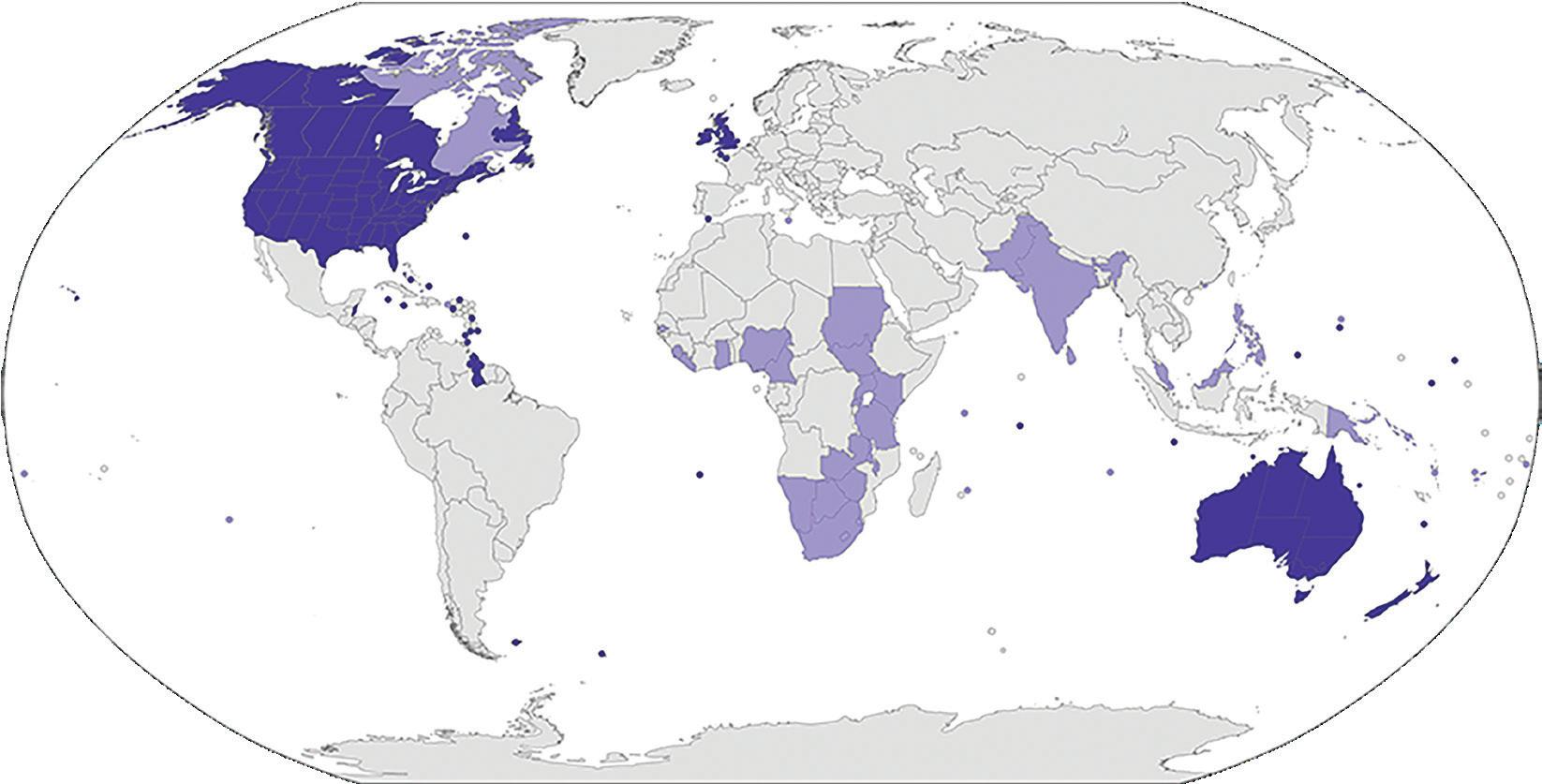
Gesture and geyser. Know and no
Sake and sake (Japanese drink).
I am sure that people who read this will have many other examples. So, why would two billion people struggle through that lot?
One answer to that question might be the pleasure associated with reading Modern English Usage by Henry Watson Fowler (MEU, 1926). The full title of the book is a Dictionary of Modern English Usage by HW Fowler. It is dedicated to his brother Francis George Fowler, “who shared with me the planning of this book but did not live to share the writing”.
In the essay of dedication, the author makes very clear that the book would have been much better if his brother had survived WWI. Instead, in 1918, he died of tuberculosis which he had caught as a member of the British Expeditionary Force. He, together with HW Fowler, had written The King’s English (published in 1906).
The first edition of MEU contains a list of general articles. Subsequent editions do not contain that list. A further edition was published in 1968, revised by Sir Ernest Gowers. A third edition was published in 1996, edited by RW Burchfield. Finally, a fourth edition was published in 2015, edited by Jeremy Butterfield and noted as “Fowler for the 21st century”. The best thing which can be said about the subsequent editions is that, by their existence, they indorse the merits of the first edition. I doubt
that there is any decent library worth the name which does not have a copy of Fowler’s Modern English Usage
The simple need to read Fowler is a sufficient justification for learning English. It is a better and wittier book than The King’s English, as a comparison of the list of articles in MEU and the List of Contents in The King’s English shows. The King’s English is essentially on English grammar, but MEU is very far from that: see, for example, the article on “Split Infinitives”, at page 558 of the first edition. It begins like this:
The English-speaking world may be divided into
(1) those who neither know nor care what a split infinitive is;
(2) those who do not know, but care very much;
(3) those who know & condemn;
(4) those who know & approve; (5) those who know & distinguish.
1. Those who neither know nor care are the vast majority & are a happy folk, to be envied by most of the minority classes; ‘to really understand‘ comes readier to their lips and pens than ‘really to understand’, they see no reason why they should not say it (small blame to them, seeing that reasons are not their critics’ strong point, & they do say it, to the discomfort of some among us, but not to their own…)
After detailed discussion of the other four categories, it ends like this:
States where English or an English-based creole is the native language of the majority
States where English is an official language, but not the most used language
After this inconclusive discussion, in which, however, the author’s opinion has been allowed to appear with indecent plainness, readers may like to settle for themselves whether, in the following sentence, ‘either to secure’ followed by ‘to resign’, or ‘to either secure’ followed by ‘resign’ should have been preferred—an issue in which the meaning and convention are pitted against each other…
It is difficult to imagine that HW Fowler would have condemned “to boldly go” and would have preferred “to go boldly”. I’m not confident that the same could be said about FG Fowler. In The King’s English the following sentence appears at page 329: “The split infinitive is an ugly thing, as will be seen from our examples below; but it is one among several hundred ugly things, and the novice should not allow it to occupy his mind exclusively.”
I’m not sure that Frank Fowler had the same sense of humour as his brother. That said, I never met either of them—they both died years before I was born—so I have no idea.
Still, if you have the time and inclination, I recommend MEU ahead of The King’s English. I strongly recommend the first edition of MEU—you should be able to find a copy at a good second-hand bookshop. One way to check on the quality of the second-hand bookshop is to ring them and ask, simply, “Do you have a first edition of Fowler?” If they don’t understand the question, they have already answered it.
PETER GRAY
Any discussion among barristers about kinds of questions is most likely to involve the distinction between leading and non-leading questions. This is obviously because that distinction, dictated by the rules of evidence, is crucial to the process of examining witnesses in court. In evidence in chief, if counsel asks a leading question, the result can be detrimental to the credibility of the evidence. Even if the opponent objects successfully, the witness’ answer to the rephrased question will be tainted by the fact that the original question contained a hint as to the answer desired.
We are used to the definition of a leading question as one that suggests the desired answer. Even so, that definition can be quite hard to apply. Take a question like was he carrying a knife when he entered the room? If we already know that the person had a knife at some stage, so that the question is only designed to find out whether he carried it into the room or picked it up once in the room, the question is probably unobjectionable. Without that kind of information, the question might well be leading. Much depends on context.
time? The answerer might say just yes or no or might add information like yes, about half a metre from it, or no, on the other side of the room. It is also possible that the answerer could just provide that information as the answer, instead of answering yes or no
An alternative question is also closed. Was the bus green or blue? invites the answerer to choose one colour or the other. Of course, the answerer could say it was yellow, avoiding the specificity sought.
An open question invites the answerer to choose the kind of information to give, as well as choosing the information itself: please tell us everything you can remember about that day? seeks a full, and probably long, account. The answerer is not restricted to a chronological factual account. The answer might start at the end, then tell the story in flashbacks, or focus on a series of themes and build the detail for each theme. It might include not just what the answerer saw, but also what they perceived with the other senses.

Thinking more broadly about questions can be valuable. Barristers ask a lot of questions in a lot of situations. We spend much of our lives interviewing clients to obtain instructions or interviewing potential witnesses. It is useful to understand what different kinds of questions there are and what effects they might have on the exchange of information.
A closed question seeks a specific answer, or a particular kind of answer. The most common closed question is the yes/no question, designed to constrain the answerer to accept or reject the proposition. Of course, the answerer might provide more than is requested. Consider the question were you standing near the window at the
The distinction between open and closed questions is not a sharp one. It is more of a spectrum. Questions can be more or less open. Linguists generally acknowledge that the more open the questions, and the more willing the questioner is to listen and not interrupt with closed questions, the more information will be provided and the more reliable that information will be. The more closed the questions, the more the answerer will be influenced by the form of the questions to provide restricted information, or information that the questioner is seen to want.
Usually, we are much better off knowing the full story. I have often seen counsel obviously surprised by an answer from their own client in evidence in chief. I suspect that time was short and counsel did not ask the right questions in conference to find out the startling fact. Knowing the full story will better equip you to meet whatever the other side will say. Even things that appear irrelevant in conference can become very important as the trial proceeds. Instead of rushing, asking a series of specific, closed questions, take the time to listen to the client’s story. Ask the most open questions you can.
These questions are a good illustration of the spectrum nature of the open/closed distinction.
To the extent that they seek specific kinds of information, they are closed, but they are very much more open than yes/no or alternative questions.
Wh questions are those that begin with wh words: where did the incident happen? when did it happen? why were you there? who else was there? what did they/you do? how did it happen? We often use them because we want specificity in reply. We see them as saving time compared with more open questions, which might give us more information that we might regard as of little use.
It is worth noting that we sometimes extrapose the wh word in a question, to express doubt, incredulity or criticism: you went where? you were with who(m)? you did what?
Barristers are very familiar with tagged questions, although we might not call them by that name. Most questions in cross-examination belong in this category. A tagged question is a statement with an interrogative tag attached. The most common tag is didn’t you? The tag is a coercive device, designed to ensure that the answerer gives the desired answer. Cross-examiners use a lot of yes/no tagged questions, mostly looking for the answer yes The tag is usually in the past tense: didn’t you? weren’t you? hadn’t you? We do sometimes use a present tense tag, however, don’t we? Also, the tag is usually expressed negatively: he was carrying a knife, wasn’t he? A positive tag can be used sometimes without changing the sense of the question: he was carrying a knife, was he? The negative tag seems to have more coercive power, however. The positive tag sometimes conveys scepticism or derision: she was chasing after you, was she?
We are very used to the interrogative form of a question, in which an auxiliary verb precedes the subject, followed by a verb, then the rest of the predicate: did you see that one? are you reading this book? have you been shopping yet? We also understand that the normal form of a statement can be used as a question: you found everything as you expected? When we read it, the question mark (?) makes clear that the statement is a question. When we hear it, we usually rely on the upward inflection at the end of the statement to signify that it is a question. In the last few decades, this has become a less reliable sign as the habit of ending every sentence with an upward inflection has become prevalent.
Was the knife in his left hand or his right hand? contains the presupposition that the person was carrying a knife, unless that fact has already been established. The difficulty posed by a question containing a presupposition is illustrated by the traditional unanswerable question: have you stopped beating your wife yet? The problem with this kind of question is that a witness might be, or feel, unable to expose or refute the presupposition. It would be unfair to assume that an attempt to answer the question is necessarily an acceptance of the presupposition.
Especially in politics, a question can be asked to make an accusation: for how long have you been hiding this information from us? Whatever the answer (eg, I only found out this morning), the accusation will remain.
Rhetorical questions do not seek an answer. They make a statement or
a comment: why would anyone do a thing like that? that really did you a lot of good, didn’t it?
Asking a question that confuses the witness is not a good strategy. Even if you think you have got the answer that suits you, a judge will give it no weight if the witness could have been merely confused, and a jury might be confused as well. I identify two kinds of confusing questions.
The first is embedded questions: do you remember when you told the court that Mary asked you was John present at the scene? There are three propositions in this question: the witness does (or does not) remember telling the court; Mary did (or did not) ask the witness; John was (or was not) at the scene. The answer might simply reflect the witness’ focus on the third proposition rather than on the first, which is the one the questioner is asking about. Embedded questions are particularly confusing for vulnerable witnesses, especially children. It is better to make each proposition the subject of a separate question.
The second is the so-called reverse question: you’re not asking this court to believe that you had nothing to do with the discussions, are you? The double negative, coupled with the positive tag, make this question all but incomprehensible. Whatever the answer, it would be dangerous to rely on it.
Take care when composing your questions, whether in conference or in court. For an example of the trouble counsel got into in cross-examination, look at the extracts from the transcript of the trial that the High Court relied on in a promissory estoppel case. The very open question what does “not necessarily” mean? allowed the witness to say exactly what she meant by it, and to win the case in the end.

ED HEEREY
Take this quick test:
1. Without overthinking it, list your three all-time fave (ATF) albums.
2. Look up their release dates on Spotify or Wikipedia.
3. Check how old you were.
Taking this test myself, I realised that my three ATF albums1 all came out when I was 19 years old. There were countless classic albums of all sorts released before and after that time. Why do those particular albums from that brief period still occupy such premium mental real estate, over three decades later? I’m currently minding my uncle’s extensive vinyl collection, which similarly has a
heavy focus on the corresponding part of his life (late ‘60s).
Are he and I alone, or does this apply to you? Can we explain this as mere nostalgia, or does it reflect a certain stage of psychological development between childhood and adulthood where musical preferences get hardwired?
Anyhoo, the context for these prognostications is the modern musical reality of having everything available, immediately, all of the time. An abundance of choice creates decisional paralysis. The default response is to go back to the ATFs again and again.
But what if we are missing out on a whole new world of music happening right around us? And (perhaps more
pressing) what if we are driving our co-habitants spare by listening to the same old songs over and over?
In case any of you are suffering similar dilemmas, here is an update on some current artists well worth checking out. I hope there is something in here for all tastes.
From: Yirrkala, NT
Style: Indigenous surf rock with a funk twist
Try these tracks: “Milkumana”, “Malk Mirri Wayin”, “Hey Wanhaka”
King Stingray have exploded onto the Australian music scene in the last few years. Get up to speed and search YouTube for “Milkumana”, filmed at the band’s home in Yirrkala at the far north-eastern tip of Arnhem Land, in Yolŋu country. Then search for the “King Stingray cover Coldplay ‘Yellow’ for Like A Version” to hear them play that song way better than Coldplay ever did.
King Stingray are quite literally the musical descendants of Yothu Yindi. Lead singer Yirrŋa Yunupiŋu is a nephew of Yothu Yindi’s lead singer, the late Mandawuy Yunupiŋu, and lead guitarist, Roy Kellaway, is the son of Yothu Yindi’s bass player, Stuart Kellaway.
Apart from Yothu Yindi, the tiny community of Yirrkala (population 809, 2016 Census) has produced a remarkable number of influential figures. April this year saw the sad passing of former chair of the Northern Land Council and Australian of the Year, Galarrwuy Yunupiŋu. Other notable Yirrkala locals include former ATSIC chair Gatjil Djerrkura OAM, dancer Kathy Balngayngu Marika (artistin-residence of Bangarra Dance Theatre) and internationally acclaimed painters Nonggirrnga Marawili, Nyapanyapa Yunupiŋu and Banduk Marika.2
Yirrkala is also famous for the 1963 Yirrkala Bark Petitions signed by representatives of 13 local clans which remain on permanent display at Parliament House in Canberra, asserting ownership of their land and protesting the Commonwealth Government’s granting of mining rights to Nabalco on that land. The Yirrkala people challenged the mine’s approval in the Supreme Court of the Northern Territory in Milirrpum v Nabalco Pty Ltd. 3 Although that case was unsuccessful in stopping the mine, it established the first judicial recognition of pre-existing Aboriginal law which paved the way for further challenges eventually resulting in the High Court’s recognition of native title in Mabo v Queensland, 4 and the passing of the Native Title Act in 1993. Right now, there is an ongoing claim by the Gamatj Clan of the Yolŋu people seeking recognition of non-exclusive native title rights for their land, including the right to access, take and use resources such as underground minerals. 5
Amongst this heady mix of culture and politics, Yirrŋa Yunupiŋu and Roy Kellaway were childhood friends growing up together in Yirrkala playing music with their family members, including backing roles with Yothu Yindi from time to time.
In 2020, Yunupiŋu and Kellaway were joined by guitarist/didgeridoo player Dimathaya Burarrwanga and
bass player Campbell Messer to form King Stingray.
In October 2020 they released their debut single “Hey Wanhaka”, followed up in January 2021 by “Get Me Out”, which tells the story of a family member of the band getting lost in Melbourne while on tour with Yothu Yindi. The band explained: “She had no phone, [and] Yolŋu style, she navigated her way back to us miraculously and we now laugh about it.” In 2021 they were joined by Lewis Stiles on drums and Yimila Gurruwiwi on didgeridoo.
In August 2021, King Stingray released “Milkumana”, an immediately catchy track blending didgeridoo with funk bass and metal guitar. The song was awarded 2022 Song of the Year in the National Indigenous Music Awards.
In April 2022, King Stingray played support for Midnight Oil’s “final ever”6 show in Sydney at the end of their Resist Tour. In August 2022 King Stingray released their debut, selftitled album and won the “Michael Gudinski Breakthrough Artist” award at that year’s ARIA Music Awards
King Stingray are touring the nation in June-July, including the Forum Theatre in Melbourne on Saturday 1 July.

From: Huntington Beach, California Style: Aggressive elevator soul (self-description)
Try these tracks: “Over the Hill”, “Loretta”, “Holy Hell”
I can’t remember how I stumbled across “Over the Hill” but it is definitely the freshest track I have heard this year. Again, get a head start and look up the film clip on YouTube (search Ginger Root–“Over the Hill”) to get a taste of this ‘80s retro So-Cal Manga vibe, with a healthy sprinkling of Philly Soul and Herbie Hancock.
The driving force behind Ginger Root7 is 20-something singersongwriter Cameron Lew, who performs all recorded instruments and is joined for live shows by his old high school friends, Matt Carney and Dylan Hovis, on drums and bass.
Lew began attracting attention in 2017, releasing a weekly YouTube series called “Toaster Music” where he filmed himself performing cover versions inside his 2004 Honda Element, parked outside his school. These weirdly compelling videos show him recording vocals, guitar, keyboard, bass, and drums in different parts of the car (ducking under the roof to squeeze the whole drumkit inside), then mixing it on his laptop via the car stereo. Get a taste on YouTube with his cover of Britney Spears’ “Toxic”.
Ginger Root has released three albums, Spotlight People (2017), Mahjohng Room (2018) and Rikki (2020). In September 2022, Ginger Root released the EP Nisemono, featuring the tracks “Loneliness”, “Holy Hell” and “Over The Hill”. The film clips for all tracks on Nisemono weave an elaborate story set in 1983, where Ginger Root is asked to write and produce music for an up-and-coming Japanese pop idol, Kimiko Takeguchi. Right before Kimiko’s American debut on a latenight show, she quits, leaving her manager in a shambles. She makes the last-minute decision to have Ginger Root perform in Kimiko’s place, since he knows all the songs. Lights, cameras, action!
I am not aware of any plans for Ginger Root to tour our way, but keep an eye out.

From: Canberra
Style: Punk rock, grunge, power pop
Try these tracks: “AHHHH!”, “Girl Sports”
Is this not the best band name we have heard for ages? The name alone was enough for me to give them a listen, and they did not disappoint. Punk rock is like pizza. The ingredients are simple and well known, but when it’s done right it never gets old. Key ingredients are youth, attitude and a big middle finger ready to call out bullshit, and TJJT have all of that in spades. I might be showing my age, but something about them channels two grand dames of Aus rock, Chrissie Amphlett8 (Divinyls) and Adalita Srsen (Magic Dirt).
The band formed when all four members (Neve van Boxsel drums, Jaida Stephenson bass, Anna Ryan vocals/guitar and Scarlett McKahey guitar/vocals) were 15-year-olds in
year 10 together in Canberra. They released their first single “We’re All Henry” while still at school in 2017. In 2019 they released “I Like That You Like That” and “See You in a Bit” and were named as a Triple J Unearthed featured artist.
By this time they had crafted a tight, punchy, brooding sound and enjoyed their first headlining national tour playing major festivals including Groovin’ the Moo, the Laneway Festival and the Falls Festival before the pandemic ground all live music to a halt in March 2020.
In February 2022 they released the single “Miss Your Birthday”, cowritten by Alex Lahey (see below) and later that year they released their five-track EP titled (dripping with irony) Pretty Good for A Girl Band, featuring the anthemic “AHHHH!” and “Girl Sports”.
As we go to print, TJJT have just finished another national tour and are embarking on their first tour of the UK and Europe.

From: Melbourne
Style: “Relaxed yet upbeat indie rock” (self description)
Try these tracks: “On My Way”, “Wes Anderson”
A quick shout-out to Melbourne’s own Alex Lahey.
Lahey is a multi-instrumentalist and singer, but her greatest talent is song writing. She weaves candid, relatable stories into beautifully structured indie rock songs, replete with catchy hooks, which have become instant hits across all demographics in my household. There is something deeply endearing and convincing about the chorus of 2017’s “Wes Anderson” (a love song not addressed to the film-maker but to a particular fan of his films): “You’re on my mind and you’re all mine, you’re the best night’s sleep I’ve ever had.” I’m showing my age again, but she reminds me of indie queens of the early 90s like Juliana Hatfield and Liz Phair.
In 2021, her track “On My Way” was featured in the soundtrack of the Netflix/Sony animation The Mitchells vs. the Machines. In May 2023 Lahey released her latest album, The Answer is Always Yes The lead track “Good Time”, as she explains, captures the public mood she encountered on finally emerging from lockdown: “Everyone is a bit f-ed up but they think they’re okay. Especially when they’re out of their houses today. Forgotten how to talk, but never shut up. I want a good
time, not a long time, let’s get the hell out, c’mon.”
As I write, Lahey is working her way through an extended tour of the UK and US.
A year ago this column featured King Gizzard and the Lizard Wizard, celebrating the achievement of their 20th studio album. Twelve months later, the boys from East Brunswick have recorded four more albums. Changes features “Gondii” and “Short Change,” which pick up where they left off on Butterfly 3000, while “Astroturf”, “Change” and “Hate Dancing” riff on a jazzy funk vibe. Laminated Denim comprises two improvised 15-minute jam sessions. Ice, Death, Planets, Lungs, Mushrooms And Lava has seven tracks full of trippy sci-fi themed whimsy. The latest album PetroDragonic Apocalypse, was announced in May 2023 but not released in time for me to review it within the deadline set by your diligent editors. According to the band’s Twitter account it’s “heavy AF”.
I had the pleasure of seeing KGLW perform live earlier this year and I hope many readers did also. As we go to print, the band is on another tour of North America culminating at the Hollywood Bowl on 21 June. On 22 July they will play at Splendour in the Grass at Byron Bay (hopefully not a rained-out muddy disaster like last year) before they head off to Europe for more summer festivals.
Now For Something Completely Different:9 my 16-year-old son and his mates have recently introduced me to the unique world of Japanese Math Rock a crazy world of indie-prog-rock fusion. These cool cats epitomise their nation’s embrace of gratuitous excessive detail and complexity (why use one alphabet when you can use three, one of which is not even really an “alphabet”?). Music nerds will delight in trying to work out the ever-changing time signatures (which seem to be the source of the “Math Rock” moniker). There is a handy playlist on Spotify titled “MATH ROCK CLASSICS”. Check out the band JYOCHO for a perfect example of the genre, complete with flutes and female vocals floating over complex guitar and intricate but occasionally explosive bass and drums. Comments welcome at edheerey@vicbar. com.au. Enjoy!
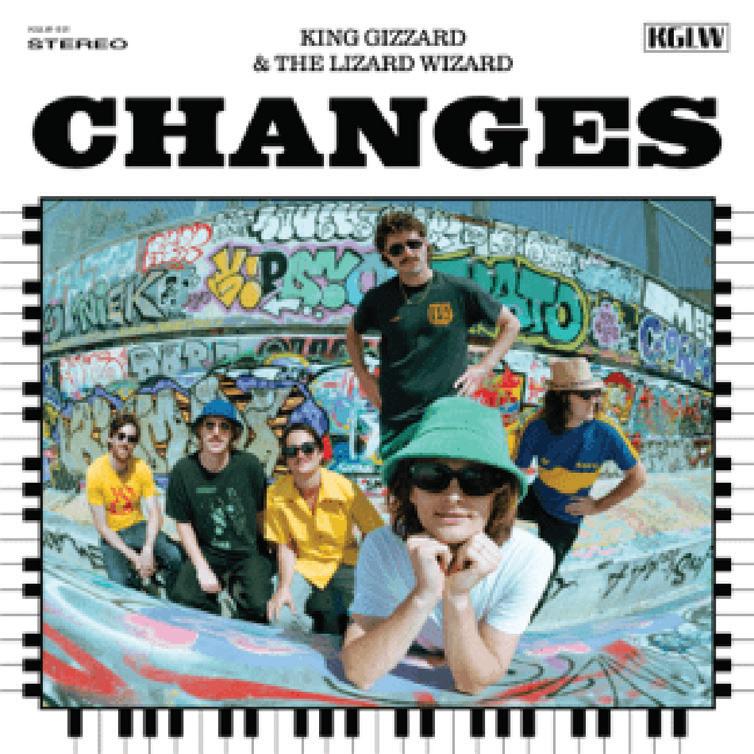
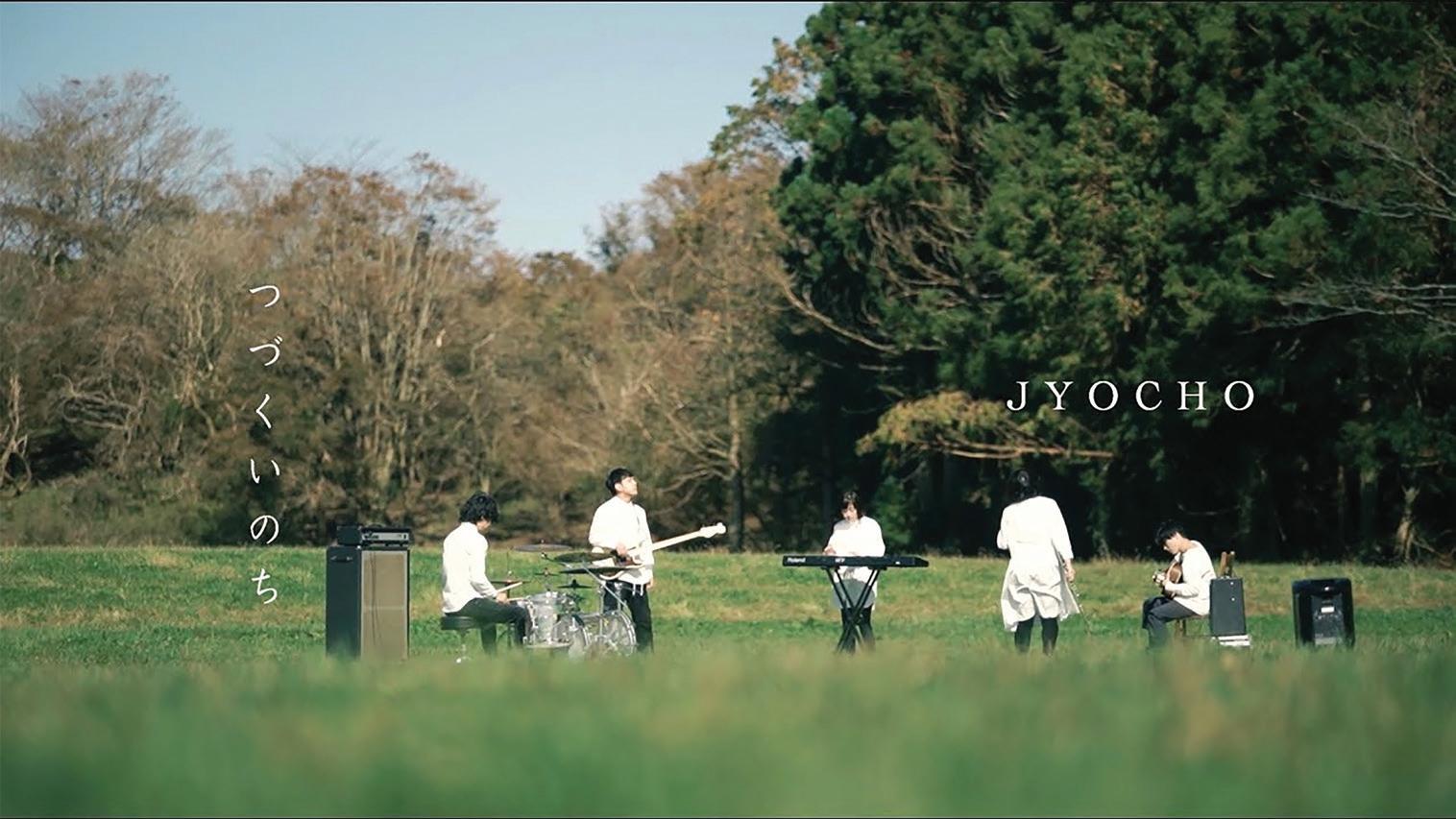
1 If anyone cares: Doolittle by Pixies (1989), The La’s (self titled, 1990) and Three Feet High and Rising by De La Soul (1989), the last of which has only this year become available on Spotify, after decades of copyright wrangling over the many diverse samples used. Contrary to the overarching theme of this article, 34 years later no hip hop album has bettered that one.
2 Banduk Marika was one of the three plaintiffs who sued successfully for infringement of their copyright by the unauthorised sale of carpets in Milpurrurru & Ors v Indofurn Pty Ltd (1994) 54 FCR 240, represented by Colin Golvan AM KC of our Bar.
3 (1971) 17 FLR 141. The Yirrkala people were represented by Edward Woodward QC of our Bar, later Woodward J of the Federal Court.
4 (1992) 175 CLR 1.
5 On 22 May 2023, the Full Federal Court handed down a judgment answering a number of preliminary questions in favour of the claimants and remitting the case to the Federal Court for further determination: see Yunupingu on behalf of the Gumatj Clan or Estate Group v Commonwealth of Australia [2023] FCAFC 75 (Mortimer CJ, Moshinsky and Banks-Smith JJ).
6 In 2019 I attended what was also supposed to be Midnight Oil’s “final ever” show, in Sydney. Hopefully John Farnham will recover from recent health issues to join Midnight Oil for their next “final ever” show. Retirement is overrated.
7 If Ginger Root were an Aussie band you might think the name was deliberately provocative or at least ironic. It seems that Mr Lew is blissfully unaware of any such issues, and explains the name came from a live Vulfpeck performance of “It Gets Funkier,” at which frontman Jack Stratton chanted “uh, uh ginger root”.
8 Next time you are up the top end of Little Bourke near Spring Street, look out for Amphlett Lane which has a permanent tribute featuring her trade mark school uniform stage costume and her favourite dogs.
9 Thank you, Monty Python.
VBN EDITORS
Walking along Gertrude Street towards Marion Wine Bar at lunchtime on a Friday tells you a lot about how Fitzroy has changed.
The street has had a varied history. At times, it has been known as a violent and destitute place. The long-closed Squizzy Taylor’s Hotel was, apparently, a fine place for a beer and a fist fight. On the other hand, the street has also been the home to important social developments, such as the Aboriginal Health Service which was founded there in the early 1970s.
Hospitality has long been part of the scene. There have been landmark pubs—the Rob Roy (now the Workers Club), the Champion Hotel (now a fairly dull post office) and the Builders Arms Hotel (now with smart food and carpet that isn’t sticky like it used to be). The Watson family, more recently of Jimmy Watson’s fame, themselves had a wine bar on the street in the early 20th century, although it sounded a little bleak:

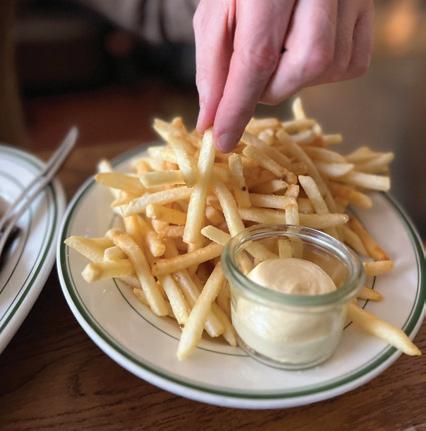
Both Marion’s interiors and the food it serves are fresh takes on classics. The combination is deft: a restaurant which feels comfortable enough to be your regular but special enough to be the place you go when you sign the Bar Roll or lose your practising certificate. It is refined but not fussy, original but not gimmicky, and thoughtful but not confronting.
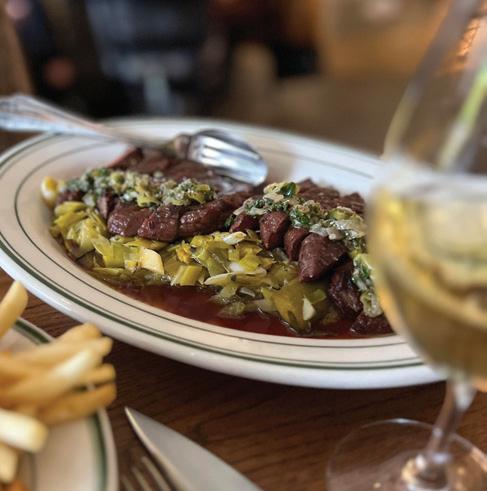
It had a terrible reputation, and was a well-known haunt for prostitutes.
The interior, which was divided into curtained cubicles, was dirty and dark.1
Now, the story of the street is different. It is a procession of galleries, restaurants, bars, cafes and ritzy clothing stores. It is a bustling place, with a strong sense of Melbourne’s past (the Exhibition Building sits at the end of the street), but also with the feeling of a modern, international city.
The editors of the Bar News had lunch at Marion to mark the closing stages of the preparation of this edition (and to fill the vacant restaurant review column).
From start to finish, it was delightful.
Before coming to the food, it is the staff that we choose to compliment: smiling, engaged and warm. Unlike the insouciant service which has become quite common in Melbourne, Marion’s staff remind you of the pleasure of eating in a well-run restaurant.
The starter of garlicky flat bread with fromage blanc has not changed in years, and for good reason—like a phone call from your favourite instructors about a new brief, it feels like the beginning of something wonderful. From there, kingfish crudo with a salty sour yuzu dressing, followed by shiny roast beetroots with smoked labneh, gave your beloved editors the protein and electrolytes they needed to continue their late-night proofing. Mussels on toast with green sauce and saffron aioli may not appeal to all, with strong flavours and diverse textures, but we scarfed them down. O’Connor beef, cooked over coals and served with braised leaks, fries and salad, was our reassuring main course. Chocolate and hazelnut puddings (dark and oozy) brought things to a close.
The wine list is, as you would expect, very fine and we enjoyed meandering through it.
Ultimately, Marion is a success because it makes you want to come back. It is the sort of restaurant that, paradoxically, feels both fresh and unchanging.
1 Jimmy Watson’s Wine Bar (G Poliness, 1989), p 26.
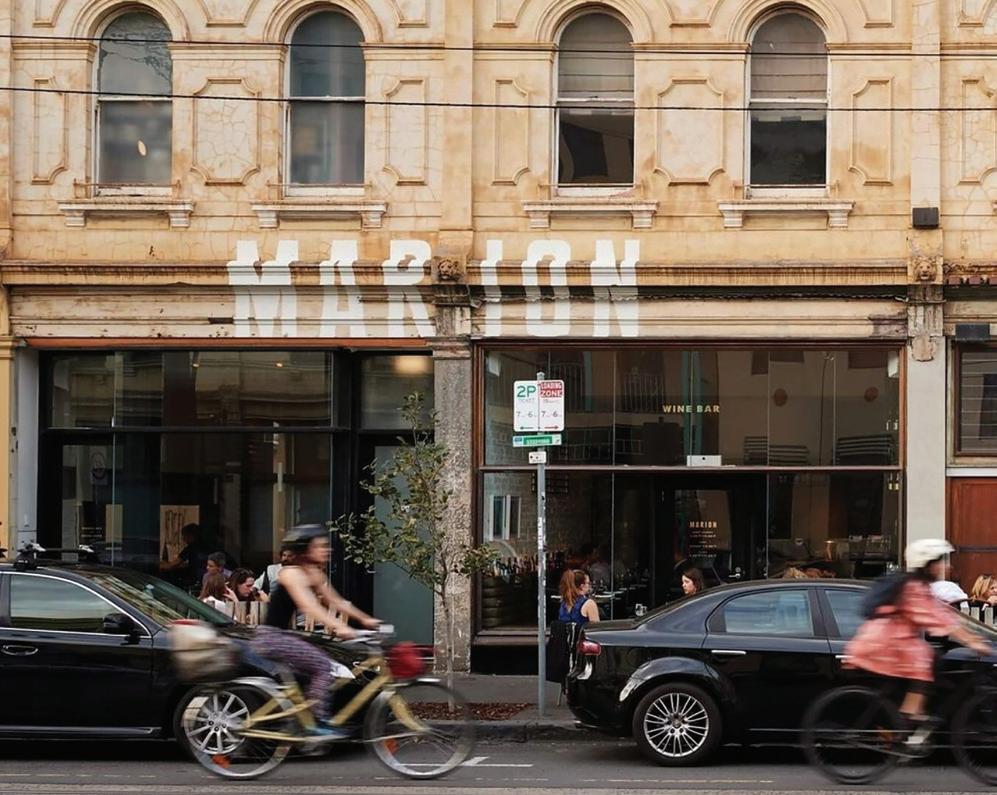

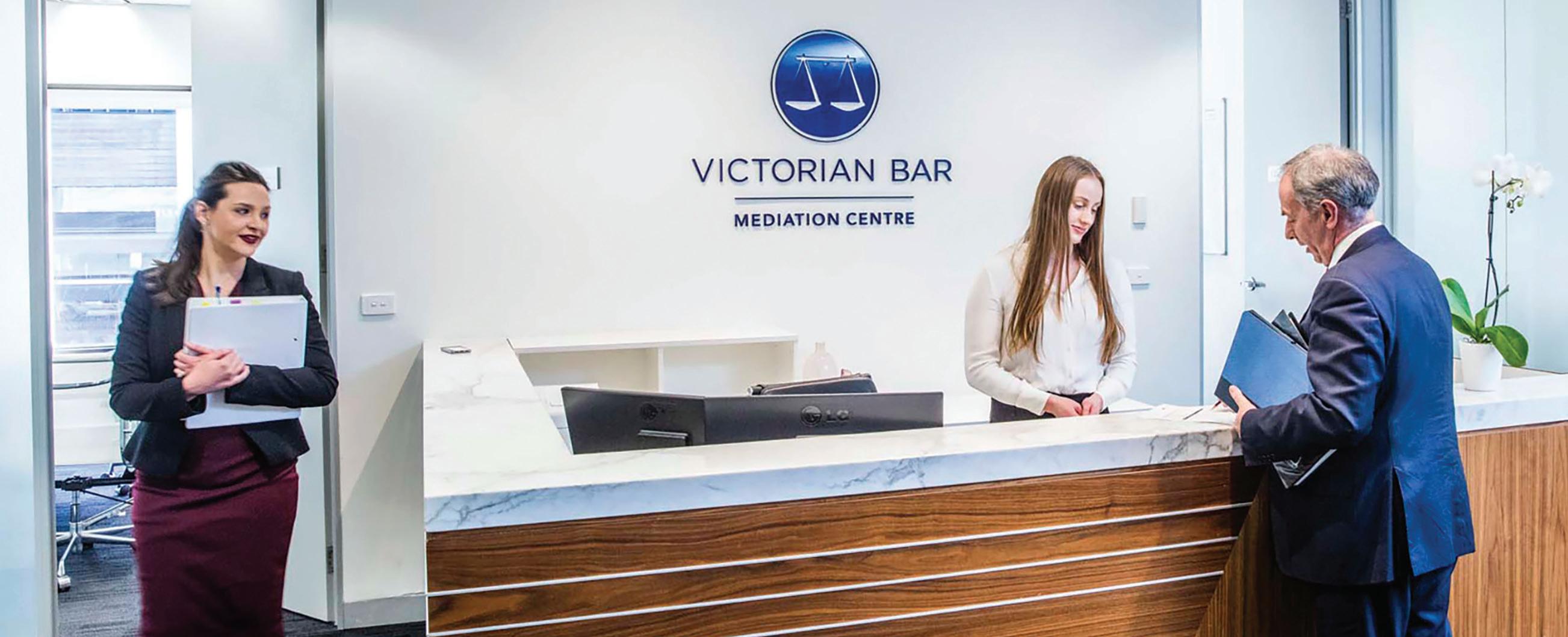

Purpose-built mediation and conference rooms in the heart of Melbourne’s legal precinct.
The Victorian Bar knows how important the mediation process is. We’ve put our experience and knowledge into creating the right space to support parties through mediation.


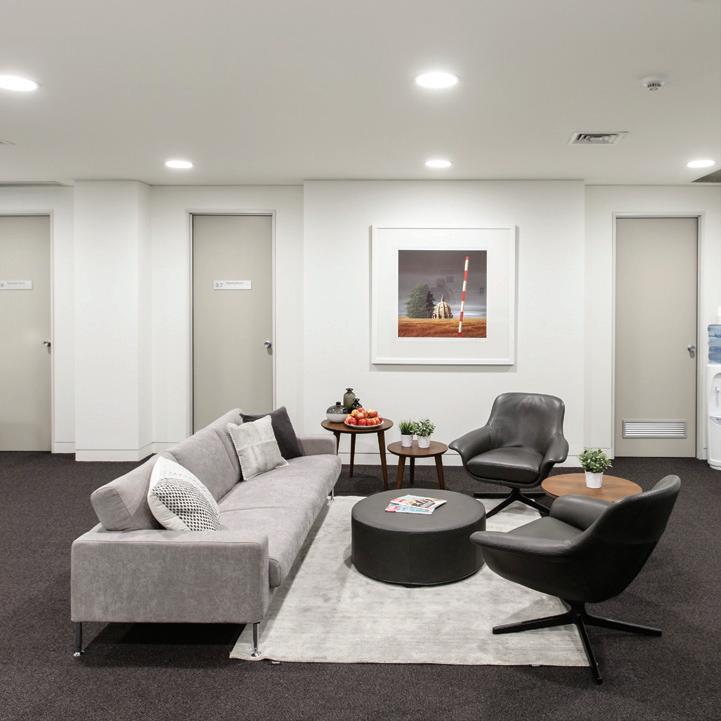
• Modern neutral decor with abundant natural light
• Business room and printing facilities
• Reception and administration services
• Fully equipped kitchen with tea & coffee making facilities
• After hours operation available
• Video and teleconferencing facilities
• Central location within Melbourne’s legal and business precinct
• Secure free Wi-Fi
